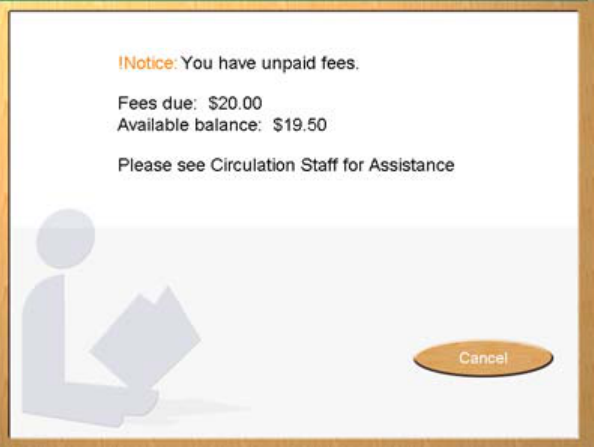Checkpoint Systems FISOCKS RFID SYSTEM User Manual ILS 3 0
Checkpoint Systems Inc RFID SYSTEM ILS 3 0
USERS MANUAL 3

Intelligent Library System
. . . . .
. . . . . . . . . . . . . . . . . . . . . . . . . . . . . . . . . . .
Open Plus (ILS) 3.0
User Guide
ISO 15693
P/N 7216425

ii
Intelligent Library System Open Plus 3.0 (ILS) User Guide
Copyright © 3/21/06 by Checkpoint Systems Inc.
Released March 21, 2006.
Published by:
Checkpoint Systems Inc.
101 Wolf Drive
Thorofare, NJ 08086
1st Edition - August -2005
Part number: 7216425
For use with Checkpoint’s Intelligent Library System Open Plus Version 3.0.
Checkpoint, Circulation Circuit, Intelligent Library System Open Plus are registered trademarks of
Checkpoint Systems, Inc.
All rights reserved. Information in this document is subject to change without notice. Companies,
names and data used in examples herein are fictitious unless otherwise noted. No part of the
contents of this book may be reproduced or transmitted in any form or by any means without the
written permission of the publisher.
Portions of this software is licensed under the GPL license (see license.txt in your installation
directory). In compliance of Section 3 of the GPL terms, contact your Checkpoint Representative
for a source distribution.
Other product and company names herein may be trademarks of their respective owners.
Windows and Windows 2000 © Microsoft, Inc., Redmond, Wash.
Other products © or ® their respective manufacturers or copyright holders.
Document Conventions
Caution: This is a Caution or Warning icon. When it appears, the corresponding text indicates a cautionary
statement by which you must abide.
Note: This is a Note icon. When it appears, the corresponding text indicates a helpful note or tip when
using the feature.
The following usage conventions are used throughout the Intelligent Library System User
Manual.
Button Name - This describes a button or selection on the screen. For example, the
<DONE> button is represented in this document as Done.
Key Name - This describes a keystroke on a keyboard. For example Ctrl represents the
Control key on a keyboard.

iii
Important Information to our Users in North America
FCC Regulatory Compliance Statement
Checkpoint Systems, Inc., offers Radio Frequency Identification Products that have been FCC certified or
verified to 47 CFR Part 15 Subparts B/C and/or 47 CFR Part 18. Appropriately, one of the following labels
will apply to the approval:
NOTE
: This equipment has been tested and found to comply with the limits for a class A digital device,
pursuant to Part 15 of the FCC Rules. These limits are designed to provide reasonable protection against
harmful interference when the equipment is operated in a commercial environment. This equipment
generates, uses, and can radiate interference to radio communications. Operation of this equipment in a
residential area is likely to cause harmful interference in which case the user will be required to correct the
interference at his own expense.
- OR -
This device complies with Part 15 of the FCC Rules. Operation is subject to the following two
conditions: (1) including this device may not cause harmful interference, and (2) this device must
accept any interference received, including interference that may cause undesired operation, which
may include intermittent decreases in detection and/or intermittent increases in alarm activity.
- OR -
NOTE: This equipment has been tested and found to comply with the limits for a miscellaneous type
ISM device, pursuant to Part 18 of the FCC Rules. This equipment generates, uses, and can radiate
radio frequency energy and, if not installed and used in accordance with the instruction manual, may
cause harmful interference to radio communications. However, there is no guarantee that interference
will not occur in a particular installation. If this equipment does cause harmful interference to radio
communications reception, which can be determined by turning the equipment off and on, please
contact Checkpoint Systems, Inc., at 1 (800) 257-5540 for further assistance.
Equipment Safety Compliance Statement
Checkpoint Systems Radio Frequency Identification products have been designed to be safe during normal
use and, where applicable, certain components of the system or accessory sub-assemblies have been
certified, listed or recognized in accordance with
one or more
of the following Safety standards: UL 1012,
UL 1037, UL 1310, UL 60950-1, CSA C22.2 No. 205, CSA C22.2 No. 220, CSA C22.2 No. 223, CSA
C22.2 No. 60950-1. Additional approvals may be pending.
WARNING:
Changes or modifications to Checkpoint’s Radio Frequency Identification (RFID)
equipment not expressly approved by the party responsible for assuring compliance could void the user’s
authority to operate the equipment in a safe or otherwise regulatory compliant manner.

iv
Important Information to our Users in Europe
CE Compliance Statement
Where applicable, Checkpoint Systems, Inc., offers certain Radio Frequency Identification (RFID) products
that have CE Declarations of Conformity according to R&TTE Directive 99/5/EC.
System Electromagnetic Compatibility (EMC), has been tested and notified through Spectrum Management
Authorities using laboratories, whereby, conformity is declared by voluntarily accepted European
Telecommunications Standards Institute (ETSI) standards EN 301489-3 and EN 300330-2.
NOTE: Certain Radio Frequency Identification (RFID) equipment have been tested and found to conform
with the CE emission and immunity requirement in Europe. This equipment generates, uses, and can radiate
radio frequency energy and, if not installed and used in accordance with the instruction manual, may cause
harmful interference to radio communications. Under unusual circumstances, interference from external
sources may degrade the system performance, which may include intermittent decreases in detection and/or
intermittent increases in alarm activity. However, there is no guarantee that interference will not occur in a
particular installation. If this equipment experiences frequent interference from external sources or does
cause harmful interference to radio communications reception, which can be determined by turning the
equipment off and on, please contact a Checkpoint Systems representative for further assistance.
Equipment Safety Compliance Statement
Checkpoint Systems Radio Frequency Identification products have been designed to be safe during normal
use and, where applicable, certain components of the system or accessory sub-assemblies have been
declared safe according
to the European Low Voltage Directive (LVD) by being certified, listed, or
recognized in accordance with one or more
of the following European safety standards; EN 60950, EN
50364, EN 60742. Additional approvals may be pending.
WARNING:
Changes or modifications to Checkpoint’s Radio Frequency Identification equipment not
expressly approved by the party responsible for assuring compliance could void the user’s authority to
operate the equipment in a safe or otherwise regulatory compliant manner.

v
Introduction..............................................................................................................................................1-1
Library Network Topology . . . . . . . . . . . . . . . . . . . . . . . . . . . . . . . . . . . . . . . . . . . . . . . . . . . . . . . . . . .1-3
Single Branch . . . . . . . . . . . . . . . . . . . . . . . . . . . . . . . . . . . . . . . . . . . . . . . . . . . . . . . . . . . . . . . . . . . . . . . . . . 1-3
Single Server, Multi-Branch Architecture . . . . . . . . . . . . . . . . . . . . . . . . . . . . . . . . . . . . . . . . . . . . . . . . . . . . . 1-4
Peer-to-Peer Communication . . . . . . . . . . . . . . . . . . . . . . . . . . . . . . . . . . . . . . . . . . . . . . . . . . . . . . . . . . . . . . 1-4
Document Overview . . . . . . . . . . . . . . . . . . . . . . . . . . . . . . . . . . . . . . . . . . . . . . . . . . . . . . . . . . . . . . .1-5
Intended Audience . . . . . . . . . . . . . . . . . . . . . . . . . . . . . . . . . . . . . . . . . . . . . . . . . . . . . . . . . . . . . . . . . . . . . . 1-5
System Overview . . . . . . . . . . . . . . . . . . . . . . . . . . . . . . . . . . . . . . . . . . . . . . . . . . . . . . . . . . . . . . . . .1-6
How RF Query Tags . . . . . . . . . . . . . . . . . . . . . . . . . . . . . . . . . . . . . . . . . . . . . . . . . . . . . . . . . . . . . . . . . . 1-6
How ILS Maintains the Library’s Collection Database . . . . . . . . . . . . . . . . . . . . . . . . . . . . . . . . . . . . . . . . . . . 1-6
Patron Checkout and Check-In . . . . . . . . . . . . . . . . . . . . . . . . . . . . . . . . . . . . . . . . . . . . . . . . . . . . . . . . . . 1-7
Staff Checkout and Check-In . . . . . . . . . . . . . . . . . . . . . . . . . . . . . . . . . . . . . . . . . . . . . . . . . . . . . . . . . . . . 1-7
Book Return Check-In . . . . . . . . . . . . . . . . . . . . . . . . . . . . . . . . . . . . . . . . . . . . . . . . . . . . . . . . . . . . . . . . . 1-7
Inventory Collection . . . . . . . . . . . . . . . . . . . . . . . . . . . . . . . . . . . . . . . . . . . . . . . . . . . . . . . . . . . . . . . . . . . 1-9
Exit Monitoring . . . . . . . . . . . . . . . . . . . . . . . . . . . . . . . . . . . . . . . . . . . . . . . . . . . . . . . . . . . . . . . . . . . . . 1-10
Programming Tags . . . . . . . . . . . . . . . . . . . . . . . . . . . . . . . . . . . . . . . . . . . . . . . . . . . . . . . . . . . . . . . . . . 1-10
Off-line Processing . . . . . . . . . . . . . . . . . . . . . . . . . . . . . . . . . . . . . . . . . . . . . . . . . . . . . . . . . . . . . . . . . . 1-10
Components . . . . . . . . . . . . . . . . . . . . . . . . . . . . . . . . . . . . . . . . . . . . . . . . . . . . . . . . . . . . . . . . . . . .1-11
RFID Tag . . . . . . . . . . . . . . . . . . . . . . . . . . . . . . . . . . . . . . . . . . . . . . . . . . . . . . . . . . . . . . . . . . . . . . . . . . . . .1-11
ILS Intelligent Sensor . . . . . . . . . . . . . . . . . . . . . . . . . . . . . . . . . . . . . . . . . . . . . . . . . . . . . . . . . . . . . . . . . . . 1-12
Local Security Controller . . . . . . . . . . . . . . . . . . . . . . . . . . . . . . . . . . . . . . . . . . . . . . . . . . . . . . . . . . . . . . . . 1-12
Staff Station Reader . . . . . . . . . . . . . . . . . . . . . . . . . . . . . . . . . . . . . . . . . . . . . . . . . . . . . . . . . . . . . . . . . . . . 1-13
Patron Self-Checkout Station II . . . . . . . . . . . . . . . . . . . . . . . . . . . . . . . . . . . . . . . . . . . . . . . . . . . . . . . . . . . 1-13
Portable Inventory Reader . . . . . . . . . . . . . . . . . . . . . . . . . . . . . . . . . . . . . . . . . . . . . . . . . . . . . . . . . . . . . . . 1-14
Intelligent Library Controller . . . . . . . . . . . . . . . . . . . . . . . . . . . . . . . . . . . . . . . . . . . . . . . . . . . . . . . . . . . . . . 1-15
Exception Ticket Printer . . . . . . . . . . . . . . . . . . . . . . . . . . . . . . . . . . . . . . . . . . . . . . . . . . . . . . . . . . . . . . . . . 1-15
CheckVIEW . . . . . . . . . . . . . . . . . . . . . . . . . . . . . . . . . . . . . . . . . . . . . . . . . . . . . . . . . . . . . . . . . . . . . . . . . . 1-16
ILS Remote Monitor . . . . . . . . . . . . . . . . . . . . . . . . . . . . . . . . . . . . . . . . . . . . . . . . . . . . . . . . . . . . . . . . . . . . 1-16
Tag Programming Station . . . . . . . . . . . . . . . . . . . . . . . . . . . . . . . . . . . . . . . . . . . . . . . . . . . . . . . . . . . . . . . . 1-16
CheckPASS . . . . . . . . . . . . . . . . . . . . . . . . . . . . . . . . . . . . . . . . . . . . . . . . . . . . . . . . . . . . . . . . . . . . . . . . . . 1-17
Application Server...................................................................................................................................2-1
Check System Status . . . . . . . . . . . . . . . . . . . . . . . . . . . . . . . . . . . . . . . . . . . . . . . . . . . . . . . . . . . . . .2-2
Self-Checkout Station Status . . . . . . . . . . . . . . . . . . . . . . . . . . . . . . . . . . . . . . . . . . . . . . . . . . . . . . . . . . . . . . 2-2
Host Status . . . . . . . . . . . . . . . . . . . . . . . . . . . . . . . . . . . . . . . . . . . . . . . . . . . . . . . . . . . . . . . . . . . . . . . . . . . . 2-4
Interrogator Status . . . . . . . . . . . . . . . . . . . . . . . . . . . . . . . . . . . . . . . . . . . . . . . . . . . . . . . . . . . . . . . . . . . . . . 2-4
This section cannot be hidden from view. . . . . . . . . . . . . . . . . . . . . . . . . . . . . . . . . . . . . . . . . . . . . . . . . . . 2-5
Edit Interrogator . . . . . . . . . . . . . . . . . . . . . . . . . . . . . . . . . . . . . . . . . . . . . . . . . . . . . . . . . . . . . . . . . . . . . 2-5
Exit Alarms . . . . . . . . . . . . . . . . . . . . . . . . . . . . . . . . . . . . . . . . . . . . . . . . . . . . . . . . . . . . . . . . . . . . . . . . . . . . 2-6
Scheduling Checkout Cache Synchronization and Host Reconnections . . . . . . . . . . . . . . . . . . . . . . .2-6
T
ABLE
OF
C
ONTENTS
vi
Synchronizing the Checkout Cache . . . . . . . . . . . . . . . . . . . . . . . . . . . . . . . . . . . . . . . . . . . . . . . . . . .2-8
Downloading Inventory from the Portable Reader . . . . . . . . . . . . . . . . . . . . . . . . . . . . . . . . . . . . . . .2-10
Generating Reports . . . . . . . . . . . . . . . . . . . . . . . . . . . . . . . . . . . . . . . . . . . . . . . . . . . . . . . . . . . . . .2-11
Specifying a Time Period for Any Report . . . . . . . . . . . . . . . . . . . . . . . . . . . . . . . . . . . . . . . . . . . . . . . . . 2-12
Checkout Discrepancy Report . . . . . . . . . . . . . . . . . . . . . . . . . . . . . . . . . . . . . . . . . . . . . . . . . . . . . . . . . . . . 2-14
Patron Discrepancy Report . . . . . . . . . . . . . . . . . . . . . . . . . . . . . . . . . . . . . . . . . . . . . . . . . . . . . . . . . . . . . . 2-15
Generic Reports . . . . . . . . . . . . . . . . . . . . . . . . . . . . . . . . . . . . . . . . . . . . . . . . . . . . . . . . . . . . . . . . . . . . . . . 2-18
Exit Alarm Report . . . . . . . . . . . . . . . . . . . . . . . . . . . . . . . . . . . . . . . . . . . . . . . . . . . . . . . . . . . . . . . . . . . . . . 2-21
Check In Report . . . . . . . . . . . . . . . . . . . . . . . . . . . . . . . . . . . . . . . . . . . . . . . . . . . . . . . . . . . . . . . . . . . . . . . 2-23
Working with the Bridge Interface . . . . . . . . . . . . . . . . . . . . . . . . . . . . . . . . . . . . . . . . . . . . . . . . . . .2-25
Changing the Op Mode of a Staff Station Reader . . . . . . . . . . . . . . . . . . . . . . . . . . . . . . . . . . . . . . . . . . . . . 2-25
Creating Staff Station Reader Groups . . . . . . . . . . . . . . . . . . . . . . . . . . . . . . . . . . . . . . . . . . . . . . . . . . . . . . 2-25
Changing the Op Mode of Multiple Staff Station Readers . . . . . . . . . . . . . . . . . . . . . . . . . . . . . . . . . . . . . . . 2-26
Maintenance . . . . . . . . . . . . . . . . . . . . . . . . . . . . . . . . . . . . . . . . . . . . . . . . . . . . . . . . . . . . . . . . . . . .2-26
Display System Information . . . . . . . . . . . . . . . . . . . . . . . . . . . . . . . . . . . . . . . . . . . . . . . . . . . . . . . .2-27
Patron Self-Checkout Station.................................................................................................................3-1
Overview . . . . . . . . . . . . . . . . . . . . . . . . . . . . . . . . . . . . . . . . . . . . . . . . . . . . . . . . . . . . . . . . . . . . . . .3-1
Beginning a Self-Checkout Station Session . . . . . . . . . . . . . . . . . . . . . . . . . . . . . . . . . . . . . . . . . . . . .3-2
Presenting a Patron ID Card, Step 1 . . . . . . . . . . . . . . . . . . . . . . . . . . . . . . . . . . . . . . . . . . . . . . . . . .3-3
Scanning Items for Checkout, Step 2 . . . . . . . . . . . . . . . . . . . . . . . . . . . . . . . . . . . . . . . . . . . . . . . . . .3-5
Viewing Items that Could Not be Checked Out . . . . . . . . . . . . . . . . . . . . . . . . . . . . . . . . . . . . . . . . . . . . . . . . 3-7
Finishing Checkout, Step 3 . . . . . . . . . . . . . . . . . . . . . . . . . . . . . . . . . . . . . . . . . . . . . . . . . . . . . . . . .3-8
Loading Roll Paper . . . . . . . . . . . . . . . . . . . . . . . . . . . . . . . . . . . . . . . . . . . . . . . . . . . . . . . . . . . . . . . .3-8
Powering On the Self-Checkout Station . . . . . . . . . . . . . . . . . . . . . . . . . . . . . . . . . . . . . . . . . . . . . . . . . . . . . 3-10
Powering Off the Self-Checkout Station . . . . . . . . . . . . . . . . . . . . . . . . . . . . . . . . . . . . . . . . . . . . . . . . . . . . . .3-11
Portable Inventory Reader......................................................................................................................4-1
Overview . . . . . . . . . . . . . . . . . . . . . . . . . . . . . . . . . . . . . . . . . . . . . . . . . . . . . . . . . . . . . . . . . . . . . . .4-1
Inventory Wand LED Indicators . . . . . . . . . . . . . . . . . . . . . . . . . . . . . . . . . . . . . . . . . . . . . . . . . . . . . . . . . . . . 4-2
Charging the Inventory Wand Battery . . . . . . . . . . . . . . . . . . . . . . . . . . . . . . . . . . . . . . . . . . . . . . . . .4-3
Maintaining the Portable Data Terminal . . . . . . . . . . . . . . . . . . . . . . . . . . . . . . . . . . . . . . . . . . . . . . . .4-4
Charging the Portable Data Terminal . . . . . . . . . . . . . . . . . . . . . . . . . . . . . . . . . . . . . . . . . . . . . . . . . . . . . . . . 4-4
Using the Serial Charging Cable to charge the battery . . . . . . . . . . . . . . . . . . . . . . . . . . . . . . . . . . . . . . . . 4-4
Using the Universal Cable Cup to charge the battery . . . . . . . . . . . . . . . . . . . . . . . . . . . . . . . . . . . . . . . . . 4-5
Powering On and Off the Portable Data Terminal . . . . . . . . . . . . . . . . . . . . . . . . . . . . . . . . . . . . . . . . . . . . . . 4-6
Using the Portable Data Terminal . . . . . . . . . . . . . . . . . . . . . . . . . . . . . . . . . . . . . . . . . . . . . . . . . . . . .4-7
Turning On/Off Backlight . . . . . . . . . . . . . . . . . . . . . . . . . . . . . . . . . . . . . . . . . . . . . . . . . . . . . . . . . . . . . . . . . 4-7
Checking the Status of the Batteries . . . . . . . . . . . . . . . . . . . . . . . . . . . . . . . . . . . . . . . . . . . . . . . . . . . . . . . . 4-7
Performing a Reset . . . . . . . . . . . . . . . . . . . . . . . . . . . . . . . . . . . . . . . . . . . . . . . . . . . . . . . . . . . . . . . . . . . . 4-10
Performing a Soft Reset . . . . . . . . . . . . . . . . . . . . . . . . . . . . . . . . . . . . . . . . . . . . . . . . . . . . . . . . . . . . . . 4-10
Performing a Hard Reset . . . . . . . . . . . . . . . . . . . . . . . . . . . . . . . . . . . . . . . . . . . . . . . . . . . . . . . . . . . . . 4-10
vii
Collecting Inventory Data . . . . . . . . . . . . . . . . . . . . . . . . . . . . . . . . . . . . . . . . . . . . . . . . . . . . . . . . . .4-12
Transferring Inventory Data . . . . . . . . . . . . . . . . . . . . . . . . . . . . . . . . . . . . . . . . . . . . . . . . . . . . . . . .4-16
Searching the Inventory . . . . . . . . . . . . . . . . . . . . . . . . . . . . . . . . . . . . . . . . . . . . . . . . . . . . . . . . . . .4-17
Preparing an Item Search List File . . . . . . . . . . . . . . . . . . . . . . . . . . . . . . . . . . . . . . . . . . . . . . . . . . . . . . . . . 4-17
Transferring the Search List File . . . . . . . . . . . . . . . . . . . . . . . . . . . . . . . . . . . . . . . . . . . . . . . . . . . . . . . . 4-18
Importing the Search List File . . . . . . . . . . . . . . . . . . . . . . . . . . . . . . . . . . . . . . . . . . . . . . . . . . . . . . . . . . 4-19
Scanning for Inventory . . . . . . . . . . . . . . . . . . . . . . . . . . . . . . . . . . . . . . . . . . . . . . . . . . . . . . . . . . . . . . . 4-22
Conducting Shelf Order Search . . . . . . . . . . . . . . . . . . . . . . . . . . . . . . . . . . . . . . . . . . . . . . . . . . . . .4-25
Selecting or Creating a Shelf Order Search File . . . . . . . . . . . . . . . . . . . . . . . . . . . . . . . . . . . . . . . . . . . . 4-25
Transferring the Shelf Order File . . . . . . . . . . . . . . . . . . . . . . . . . . . . . . . . . . . . . . . . . . . . . . . . . . . . . . . . 4-25
Importing Shelf Order File . . . . . . . . . . . . . . . . . . . . . . . . . . . . . . . . . . . . . . . . . . . . . . . . . . . . . . . . . . . . . 4-26
Shelf Order Search Window . . . . . . . . . . . . . . . . . . . . . . . . . . . . . . . . . . . . . . . . . . . . . . . . . . . . . . . . . . . . . . 4-29
Shelf Order Results . . . . . . . . . . . . . . . . . . . . . . . . . . . . . . . . . . . . . . . . . . . . . . . . . . . . . . . . . . . . . . . . . . . . 4-31
Creating a New Search List . . . . . . . . . . . . . . . . . . . . . . . . . . . . . . . . . . . . . . . . . . . . . . . . . . . . . . . . . . . 4-32
Creating a File from Shelf Order Results . . . . . . . . . . . . . . . . . . . . . . . . . . . . . . . . . . . . . . . . . . . . . . . . . 4-32
Viewing Shelf Order Results . . . . . . . . . . . . . . . . . . . . . . . . . . . . . . . . . . . . . . . . . . . . . . . . . . . . . . . . . . . 4-33
Saving Custom Search Files . . . . . . . . . . . . . . . . . . . . . . . . . . . . . . . . . . . . . . . . . . . . . . . . . . . . . . .4-34
ILS Remote Monitor.................................................................................................................................5-1
Installing Web Site Certificate on a Client Computer . . . . . . . . . . . . . . . . . . . . . . . . . . . . . . . . . . . . . .5-2
Verifying Successful Certificate Installation . . . . . . . . . . . . . . . . . . . . . . . . . . . . . . . . . . . . . . . . . . . . .5-3
Setting Hyperlink on Client’s Computer . . . . . . . . . . . . . . . . . . . . . . . . . . . . . . . . . . . . . . . . . . . . . . . . . . . . . . 5-4
Setting Up and Managing User Accounts . . . . . . . . . . . . . . . . . . . . . . . . . . . . . . . . . . . . . . . . . . . . . .5-5
Adding a User Account . . . . . . . . . . . . . . . . . . . . . . . . . . . . . . . . . . . . . . . . . . . . . . . . . . . . . . . . . . . . . . . . . . 5-5
Modifying a User Account . . . . . . . . . . . . . . . . . . . . . . . . . . . . . . . . . . . . . . . . . . . . . . . . . . . . . . . . . . . . . . . . 5-6
Removing a User Account . . . . . . . . . . . . . . . . . . . . . . . . . . . . . . . . . . . . . . . . . . . . . . . . . . . . . . . . . . . . . . . . 5-7
Unlocking a Locked Account . . . . . . . . . . . . . . . . . . . . . . . . . . . . . . . . . . . . . . . . . . . . . . . . . . . . . . . . . . . . . . 5-7
Using ILS Remote Monitor . . . . . . . . . . . . . . . . . . . . . . . . . . . . . . . . . . . . . . . . . . . . . . . . . . . . . . . . . .5-8
Launching ILS Remote Monitor in a Single Server, Multi-Branch Environment . . . . . . . . . . . . . . . . . . . . . . . . 5-8
Using ILS Remote Monitor in a Peer-to-Peer Environment . . . . . . . . . . . . . . . . . . . . . . . . . . . . . . . . . . . . . . . 5-9
Changing Branch Views . . . . . . . . . . . . . . . . . . . . . . . . . . . . . . . . . . . . . . . . . . . . . . . . . . . . . . . . . . . . . . . . . . 5-9
Viewing Status . . . . . . . . . . . . . . . . . . . . . . . . . . . . . . . . . . . . . . . . . . . . . . . . . . . . . . . . . . . . . . . . . . . . . . . . 5-10
Viewing and Printing Reports . . . . . . . . . . . . . . . . . . . . . . . . . . . . . . . . . . . . . . . . . . . . . . . . . . . . . . . . . . . . . .5-11
Uploading Portable Inventory Reader inventory files . . . . . . . . . . . . . . . . . . . . . . . . . . . . . . . . . . . . . . . . . . . 5-12
Logging out . . . . . . . . . . . . . . . . . . . . . . . . . . . . . . . . . . . . . . . . . . . . . . . . . . . . . . . . . . . . . . . . . . . . . . . . . . 5-12
Exception Ticket Printer .........................................................................................................................6-1
Introduction . . . . . . . . . . . . . . . . . . . . . . . . . . . . . . . . . . . . . . . . . . . . . . . . . . . . . . . . . . . . . . . . . . . . .6-1
Printer Layout . . . . . . . . . . . . . . . . . . . . . . . . . . . . . . . . . . . . . . . . . . . . . . . . . . . . . . . . . . . . . . . . . . . .6-2
Control Panel . . . . . . . . . . . . . . . . . . . . . . . . . . . . . . . . . . . . . . . . . . . . . . . . . . . . . . . . . . . . . . . . . . . . . . . . . . 6-3
Using the Exception Ticket Printer . . . . . . . . . . . . . . . . . . . . . . . . . . . . . . . . . . . . . . . . . . . . . . . . . . . .6-3
Setting the Printer’s Cut Type . . . . . . . . . . . . . . . . . . . . . . . . . . . . . . . . . . . . . . . . . . . . . . . . . . . . . . .6-4
viii
Inserting Paper . . . . . . . . . . . . . . . . . . . . . . . . . . . . . . . . . . . . . . . . . . . . . . . . . . . . . . . . . . . . . . . . . . .6-5
Running a Self-Test . . . . . . . . . . . . . . . . . . . . . . . . . . . . . . . . . . . . . . . . . . . . . . . . . . . . . . . . . . . . . . .6-6
Installing the Cover . . . . . . . . . . . . . . . . . . . . . . . . . . . . . . . . . . . . . . . . . . . . . . . . . . . . . . . . . . . . . . . .6-6
Installing a Power Switch Cover . . . . . . . . . . . . . . . . . . . . . . . . . . . . . . . . . . . . . . . . . . . . . . . . . . . . . . . . . . . . 6-6
Installing a Connector Cover . . . . . . . . . . . . . . . . . . . . . . . . . . . . . . . . . . . . . . . . . . . . . . . . . . . . . . . . . . . . . . 6-6
Error Codes . . . . . . . . . . . . . . . . . . . . . . . . . . . . . . . . . . . . . . . . . . . . . . . . . . . . . . . . . . . . . . . . . . . . .6-7
Troubleshooting . . . . . . . . . . . . . . . . . . . . . . . . . . . . . . . . . . . . . . . . . . . . . . . . . . . . . . . . . . . . . . . . . .6-8
Removing Jammed Paper . . . . . . . . . . . . . . . . . . . . . . . . . . . . . . . . . . . . . . . . . . . . . . . . . . . . . . . . . . . . . . . . 6-8
Removing an Autocutter Jam . . . . . . . . . . . . . . . . . . . . . . . . . . . . . . . . . . . . . . . . . . . . . . . . . . . . . . . . . . . 6-8
Cleaning the Print Head . . . . . . . . . . . . . . . . . . . . . . . . . . . . . . . . . . . . . . . . . . . . . . . . . . . . . . . . . . . .6-9
Specifications . . . . . . . . . . . . . . . . . . . . . . . . . . . . . . . . . . . . . . . . . . . . . . . . . . . . . . . . . . . . . . . . . . . .6-9
CheckVIEW...............................................................................................................................................7-1
Staff Computer Requirements . . . . . . . . . . . . . . . . . . . . . . . . . . . . . . . . . . . . . . . . . . . . . . . . . . . . . . . . . . . . . 7-2
Using CheckVIEW in Monitor Mode . . . . . . . . . . . . . . . . . . . . . . . . . . . . . . . . . . . . . . . . . . . . . . . . . . .7-3
Using CheckVIEW in Host Mode . . . . . . . . . . . . . . . . . . . . . . . . . . . . . . . . . . . . . . . . . . . . . . . . . . . . .7-4
Adding/Removing Self-Checkout Stations to CheckVIEW . . . . . . . . . . . . . . . . . . . . . . . . . . . . . . . . . . . . . 7-4
Reinstalling Missing Files . . . . . . . . . . . . . . . . . . . . . . . . . . . . . . . . . . . . . . . . . . . . . . . . . . . . . . . . . . . . . . 7-6
Uninstalling CheckVIEW . . . . . . . . . . . . . . . . . . . . . . . . . . . . . . . . . . . . . . . . . . . . . . . . . . . . . . . . . . . . . . . 7-6
Using CheckVIEW to Shut Down a Self-Checkout Station . . . . . . . . . . . . . . . . . . . . . . . . . . . . . . . . . . . . . 7-6
Affixing Tags ............................................................................................................................................8-1
Types of tags . . . . . . . . . . . . . . . . . . . . . . . . . . . . . . . . . . . . . . . . . . . . . . . . . . . . . . . . . . . . . . . . . . . .8-1
Applying Tags to Books . . . . . . . . . . . . . . . . . . . . . . . . . . . . . . . . . . . . . . . . . . . . . . . . . . . . . . . . . . . .8-2
Applying Tags to Video Cassettes . . . . . . . . . . . . . . . . . . . . . . . . . . . . . . . . . . . . . . . . . . . . . . . . . . . .8-4
Applying tags to CDs and DVDs . . . . . . . . . . . . . . . . . . . . . . . . . . . . . . . . . . . . . . . . . . . . . . . . . . . . .8-5
To place barcode labels on CDs . . . . . . . . . . . . . . . . . . . . . . . . . . . . . . . . . . . . . . . . . . . . . . . . . . . . . . . . . 8-5
To place tags on Jewel Case CD cases . . . . . . . . . . . . . . . . . . . . . . . . . . . . . . . . . . . . . . . . . . . . . . . . . . . 8-5
To place content tags on CDs and DVDs . . . . . . . . . . . . . . . . . . . . . . . . . . . . . . . . . . . . . . . . . . . . . . . . . . 8-6
To place tags on DiscMate DVD cases . . . . . . . . . . . . . . . . . . . . . . . . . . . . . . . . . . . . . . . . . . . . . . . . . . . . 8-7
To place tags on DiscMate CD cases: . . . . . . . . . . . . . . . . . . . . . . . . . . . . . . . . . . . . . . . . . . . . . . . . . . . . . 8-8
Applying Tags to Audio Material . . . . . . . . . . . . . . . . . . . . . . . . . . . . . . . . . . . . . . . . . . . . . . . . . . . . . .8-9
To place tags on Audio Cases with Tapes on both inside sections: . . . . . . . . . . . . . . . . . . . . . . . . . . . . . . 8-9
Applying Tags to Kits . . . . . . . . . . . . . . . . . . . . . . . . . . . . . . . . . . . . . . . . . . . . . . . . . . . . . . . . . . . . . .8-9
Using Tag Programming Station ...........................................................................................................9-1
Overview . . . . . . . . . . . . . . . . . . . . . . . . . . . . . . . . . . . . . . . . . . . . . . . . . . . . . . . . . . . . . . . . . . . . . . .9-1
How it works . . . . . . . . . . . . . . . . . . . . . . . . . . . . . . . . . . . . . . . . . . . . . . . . . . . . . . . . . . . . . . . . . . . . . . . . . . . 9-2
Programming Procedure . . . . . . . . . . . . . . . . . . . . . . . . . . . . . . . . . . . . . . . . . . . . . . . . . . . . . . . . . . .9-3
New Material . . . . . . . . . . . . . . . . . . . . . . . . . . . . . . . . . . . . . . . . . . . . . . . . . . . . . . . . . . . . . . . . . . . . . . . . . . 9-3
ix
Using DiscMate......................................................................................................................................10-1
Overview . . . . . . . . . . . . . . . . . . . . . . . . . . . . . . . . . . . . . . . . . . . . . . . . . . . . . . . . . . . . . . . . . . . . . .10-1
LEDs on the Intelligent Unlocking Station . . . . . . . . . . . . . . . . . . . . . . . . . . . . . . . . . . . . . . . . . . . . . . . . . . . 10-2
Using the Standard Unlocking Station . . . . . . . . . . . . . . . . . . . . . . . . . . . . . . . . . . . . . . . . . . . . . . . . . . . . . . 10-2
Using the Intelligent Unlocking Station . . . . . . . . . . . . . . . . . . . . . . . . . . . . . . . . . . . . . . . . . . . . . . . . . . . . . . 10-3
Intelligent Unlocking Station Case Insertion Diagram . . . . . . . . . . . . . . . . . . . . . . . . . . . . . . . . . . . . . . . . 10-4
Linking Procedure . . . . . . . . . . . . . . . . . . . . . . . . . . . . . . . . . . . . . . . . . . . . . . . . . . . . . . . . . . . . . . .10-5
Configuring Hardware to Link Media . . . . . . . . . . . . . . . . . . . . . . . . . . . . . . . . . . . . . . . . . . . . . . . . . . . . . . . 10-5
Circuit Linking Hardware Diagram . . . . . . . . . . . . . . . . . . . . . . . . . . . . . . . . . . . . . . . . . . . . . . . . . . . . . . . 10-6
Linking Electronic Media with Confirmation . . . . . . . . . . . . . . . . . . . . . . . . . . . . . . . . . . . . . . . . . . . . . . . . . . 10-7
Linking Electronic Media Continuously . . . . . . . . . . . . . . . . . . . . . . . . . . . . . . . . . . . . . . . . . . . . . . . . . . . . . 10-8
Removing Linked Media . . . . . . . . . . . . . . . . . . . . . . . . . . . . . . . . . . . . . . . . . . . . . . . . . . . . . . . . . . . . . . . . 10-10
DVD Linking Reports . . . . . . . . . . . . . . . . . . . . . . . . . . . . . . . . . . . . . . . . . . . . . . . . . . . . . . . . . . . .10-11
Accessing and Printing Linking Reports . . . . . . . . . . . . . . . . . . . . . . . . . . . . . . . . . . . . . . . . . . . . . . . . . . . . .10-11
Type of Reports . . . . . . . . . . . . . . . . . . . . . . . . . . . . . . . . . . . . . . . . . . . . . . . . . . . . . . . . . . . . . . . . . . . . . . 10-12
Linking Summary Report . . . . . . . . . . . . . . . . . . . . . . . . . . . . . . . . . . . . . . . . . . . . . . . . . . . . . . . . . . . . . 10-12
Check-out Detail Report . . . . . . . . . . . . . . . . . . . . . . . . . . . . . . . . . . . . . . . . . . . . . . . . . . . . . . . . . . . . . 10-13
Staff Check-In Exception Report . . . . . . . . . . . . . . . . . . . . . . . . . . . . . . . . . . . . . . . . . . . . . . . . . . . . . . . 10-13
Drop Box Exception Report . . . . . . . . . . . . . . . . . . . . . . . . . . . . . . . . . . . . . . . . . . . . . . . . . . . . . . . . . . . 10-13
CheckPASS ............................................................................................................................................11-1
Using CheckPASS . . . . . . . . . . . . . . . . . . . . . . . . . . . . . . . . . . . . . . . . . . . . . . . . . . . . . . . . . . . . . . .11-2
Troubleshooting Guide.........................................................................................................................12-1
Contact Technical Support . . . . . . . . . . . . . . . . . . . . . . . . . . . . . . . . . . . . . . . . . . . . . . . . . . . . . . . . .12-1
Self-Checkout Station Scenarios . . . . . . . . . . . . . . . . . . . . . . . . . . . . . . . . . . . . . . . . . . . . . . . . . . . .12-1
Valid Patron ID Not Recognized . . . . . . . . . . . . . . . . . . . . . . . . . . . . . . . . . . . . . . . . . . . . . . . . . . . . . . . . 12-1
Nothing Happens After an Item is Scanned . . . . . . . . . . . . . . . . . . . . . . . . . . . . . . . . . . . . . . . . . . . . . . . 12-2
Graphics Display Incorrectly or Not at All . . . . . . . . . . . . . . . . . . . . . . . . . . . . . . . . . . . . . . . . . . . . . . . . . 12-2
Printer Does Not Print . . . . . . . . . . . . . . . . . . . . . . . . . . . . . . . . . . . . . . . . . . . . . . . . . . . . . . . . . . . . . . . . 12-2
Printer Status of Unknown . . . . . . . . . . . . . . . . . . . . . . . . . . . . . . . . . . . . . . . . . . . . . . . . . . . . . . . . . . . . . 12-3
Touch Screen Does Not Respond . . . . . . . . . . . . . . . . . . . . . . . . . . . . . . . . . . . . . . . . . . . . . . . . . . . . . . . 12-3
Self-Checkout Station Fails to Start . . . . . . . . . . . . . . . . . . . . . . . . . . . . . . . . . . . . . . . . . . . . . . . . . . . . . . 12-4
Application Server Scenarios . . . . . . . . . . . . . . . . . . . . . . . . . . . . . . . . . . . . . . . . . . . . . . . . . . . . . . .12-4
Self-Checkout Station Not Displaying . . . . . . . . . . . . . . . . . . . . . . . . . . . . . . . . . . . . . . . . . . . . . . . . . . . . 12-4
Trouble Printing a Report . . . . . . . . . . . . . . . . . . . . . . . . . . . . . . . . . . . . . . . . . . . . . . . . . . . . . . . . . . . . . 12-4
Error Message Displays when Running a Report . . . . . . . . . . . . . . . . . . . . . . . . . . . . . . . . . . . . . . . . . . . 12-5
Exit Alarms Do Not Occur . . . . . . . . . . . . . . . . . . . . . . . . . . . . . . . . . . . . . . . . . . . . . . . . . . . . . . . . . . . . . 12-5
Host Status Incorrectly Reports Offline . . . . . . . . . . . . . . . . . . . . . . . . . . . . . . . . . . . . . . . . . . . . . . . . . . . 12-5
Exit Interrogator Scenarios . . . . . . . . . . . . . . . . . . . . . . . . . . . . . . . . . . . . . . . . . . . . . . . . . . . . . . . . .12-5
Exit Alarms Do Not Occur . . . . . . . . . . . . . . . . . . . . . . . . . . . . . . . . . . . . . . . . . . . . . . . . . . . . . . . . . . . . . 12-5
No Sound Occurs for an Exit Alarm . . . . . . . . . . . . . . . . . . . . . . . . . . . . . . . . . . . . . . . . . . . . . . . . . . . . . 12-6
Incorrect Exit Alarm . . . . . . . . . . . . . . . . . . . . . . . . . . . . . . . . . . . . . . . . . . . . . . . . . . . . . . . . . . . . . . . . . . 12-6
x
Staff Station Reader Scenarios . . . . . . . . . . . . . . . . . . . . . . . . . . . . . . . . . . . . . . . . . . . . . . . . . . . . .12-6
Valid Circuit Not Recognized . . . . . . . . . . . . . . . . . . . . . . . . . . . . . . . . . . . . . . . . . . . . . . . . . . . . . . . . . . . 12-6
Scanned Item Does Not Display on Monitor . . . . . . . . . . . . . . . . . . . . . . . . . . . . . . . . . . . . . . . . . . . . . . . 12-7
Recovery Procedures . . . . . . . . . . . . . . . . . . . . . . . . . . . . . . . . . . . . . . . . . . . . . . . . . . . . . . . . . . . . .12-8
Restarting the Self-Checkout Station . . . . . . . . . . . . . . . . . . . . . . . . . . . . . . . . . . . . . . . . . . . . . . . . . . . . 12-8
Restarting the Complete System . . . . . . . . . . . . . . . . . . . . . . . . . . . . . . . . . . . . . . . . . . . . . . . . . . . . . . . . 12-8
Restarting the Intelligent Library Controller program . . . . . . . . . . . . . . . . . . . . . . . . . . . . . . . . . . . . . . . . . 12-8
CheckVIEW Troubleshooting . . . . . . . . . . . . . . . . . . . . . . . . . . . . . . . . . . . . . . . . . . . . . . . . . . . . . . .12-9
Solution 1 - IP Address used on Staff computer . . . . . . . . . . . . . . . . . . . . . . . . . . . . . . . . . . . . . . . . . . . . 12-9
Solution 2 - Correct default settings on Self-Checkout Station . . . . . . . . . . . . . . . . . . . . . . . . . . . . . . . . . 12-9
System Connection Diagram . . . . . . . . . . . . . . . . . . . . . . . . . . . . . . . . . . . . . . . . . . . . . . . . . . . . . .12-11
System Maintenance.............................................................................................................................13-1
Intelligent Library Controller System Maintenance . . . . . . . . . . . . . . . . . . . . . . . . . . . . . . . . . . . . . . .13-1
Transaction Database Maintenance . . . . . . . . . . . . . . . . . . . . . . . . . . . . . . . . . . . . . . . . . . . . . . . . . . . . . . . 13-2
Synchronize Offline Transactions . . . . . . . . . . . . . . . . . . . . . . . . . . . . . . . . . . . . . . . . . . . . . . . . . . . . . . . 13-3
Backup Transaction Database . . . . . . . . . . . . . . . . . . . . . . . . . . . . . . . . . . . . . . . . . . . . . . . . . . . . . . . . . 13-4
Purge the Transaction Database . . . . . . . . . . . . . . . . . . . . . . . . . . . . . . . . . . . . . . . . . . . . . . . . . . . . . . . . 13-5
Compact the Transaction Database . . . . . . . . . . . . . . . . . . . . . . . . . . . . . . . . . . . . . . . . . . . . . . . . . . . . . 13-7
Reboot the Application Server . . . . . . . . . . . . . . . . . . . . . . . . . . . . . . . . . . . . . . . . . . . . . . . . . . . . . . . . . 13-8
Backup the Application Server . . . . . . . . . . . . . . . . . . . . . . . . . . . . . . . . . . . . . . . . . . . . . . . . . . . . . . . . . . . .13-11
Backup . . . . . . . . . . . . . . . . . . . . . . . . . . . . . . . . . . . . . . . . . . . . . . . . . . . . . . . . . . . . . . . . . . . . . . . . . . .13-11
Restore . . . . . . . . . . . . . . . . . . . . . . . . . . . . . . . . . . . . . . . . . . . . . . . . . . . . . . . . . . . . . . . . . . . . . . . . . . 13-12
Load Paper into Patron Self-Checkout Station Printer . . . . . . . . . . . . . . . . . . . . . . . . . . . . . . . . . . .13-13
Safety Warnings . . . . . . . . . . . . . . . . . . . . . . . . . . . . . . . . . . . . . . . . . . . . . . . . . . . . . . . . . . . . . . . .13-15
Specifications . . . . . . . . . . . . . . . . . . . . . . . . . . . . . . . . . . . . . . . . . . . . . . . . . . . . . . . . . . . . . . . . . .13-16
Mechanical . . . . . . . . . . . . . . . . . . . . . . . . . . . . . . . . . . . . . . . . . . . . . . . . . . . . . . . . . . . . . . . . . . . . . . . . . . 13-16
Electrical . . . . . . . . . . . . . . . . . . . . . . . . . . . . . . . . . . . . . . . . . . . . . . . . . . . . . . . . . . . . . . . . . . . . . . . . . . . 13-16
Interfaces . . . . . . . . . . . . . . . . . . . . . . . . . . . . . . . . . . . . . . . . . . . . . . . . . . . . . . . . . . . . . . . . . . . . . . . . . . . 13-16
Peripherals . . . . . . . . . . . . . . . . . . . . . . . . . . . . . . . . . . . . . . . . . . . . . . . . . . . . . . . . . . . . . . . . . . . . . . . . . . 13-16
Environmental . . . . . . . . . . . . . . . . . . . . . . . . . . . . . . . . . . . . . . . . . . . . . . . . . . . . . . . . . . . . . . . . . . . . . . . 13-16

Introduction: 1-1
CHAPTER
C
HAPTER
0
I
NTRODUCTION
The Intelligent Library System Open Plus 3.0 (ILS) is an integrated security tracking and
database system that maintains a library’s collection using Radio Frequency Identification
(RFID) to wirelessly coordinate the subscription status of library materials. This protects
collections, streamlines operations, and improves patron service. When using ILS,
libraries reduce losses, enhance staff productivity, increase circulation flow, and improve
patron satisfaction. ILS operates in conjunction with the library’s Library Management
System (LMS) or Automated Circulation System (ACS).
ILS includes the following components:
•RFID tag
• Patron Identification Card
• Intelligent Sensor
• Patron Self-Checkout Station
• Staff Station Reader
• Intelligent Library Controller (Application Server)
• Portable Inventory Reader (optional)
• Exception Ticket Printer (optional)
• ILS Remote Monitor (optional)
• CheckVIEW (optional)
• CheckPASS (optional)
• Tag Programming Station (optional)
• DiscMate (optional)
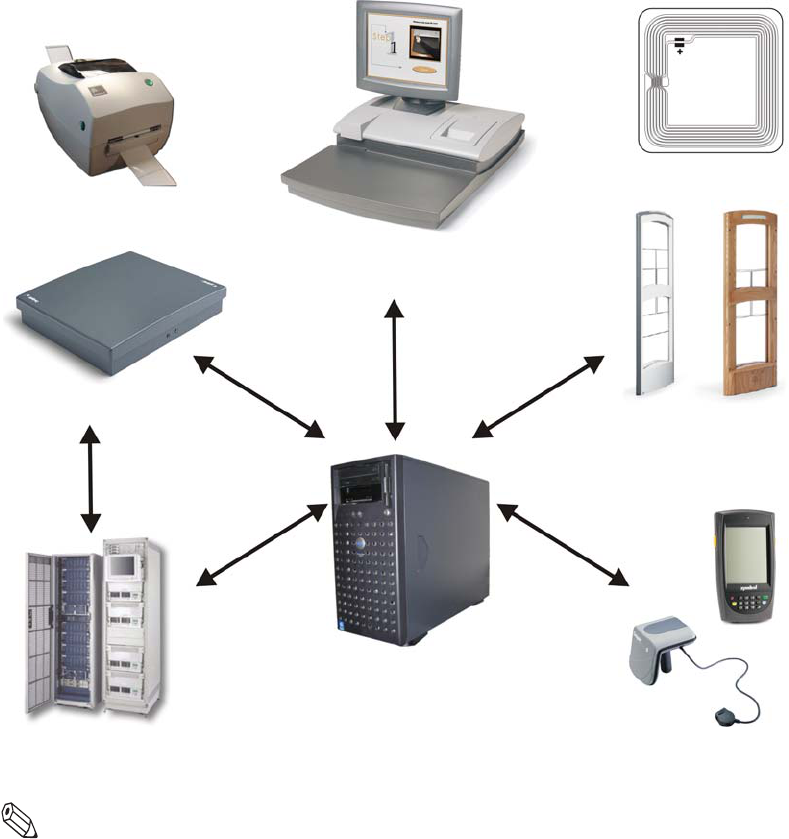
1-2 ILS 2.5 User Guide
The following configuration illustrates an example of the ILS components and
connections in a typical ILS setup.
Figure 1.1
Sample Intelligent Library System Components
Note: Your specific ILS configuration may not include one or more of the components shown.
Tag Programming Station
RFID ISO Tag
Intelligent Sensors
Staff Station Reader
Portable Reader
Intelligent Library Controller
Library Management
System
Self-Checkout Station
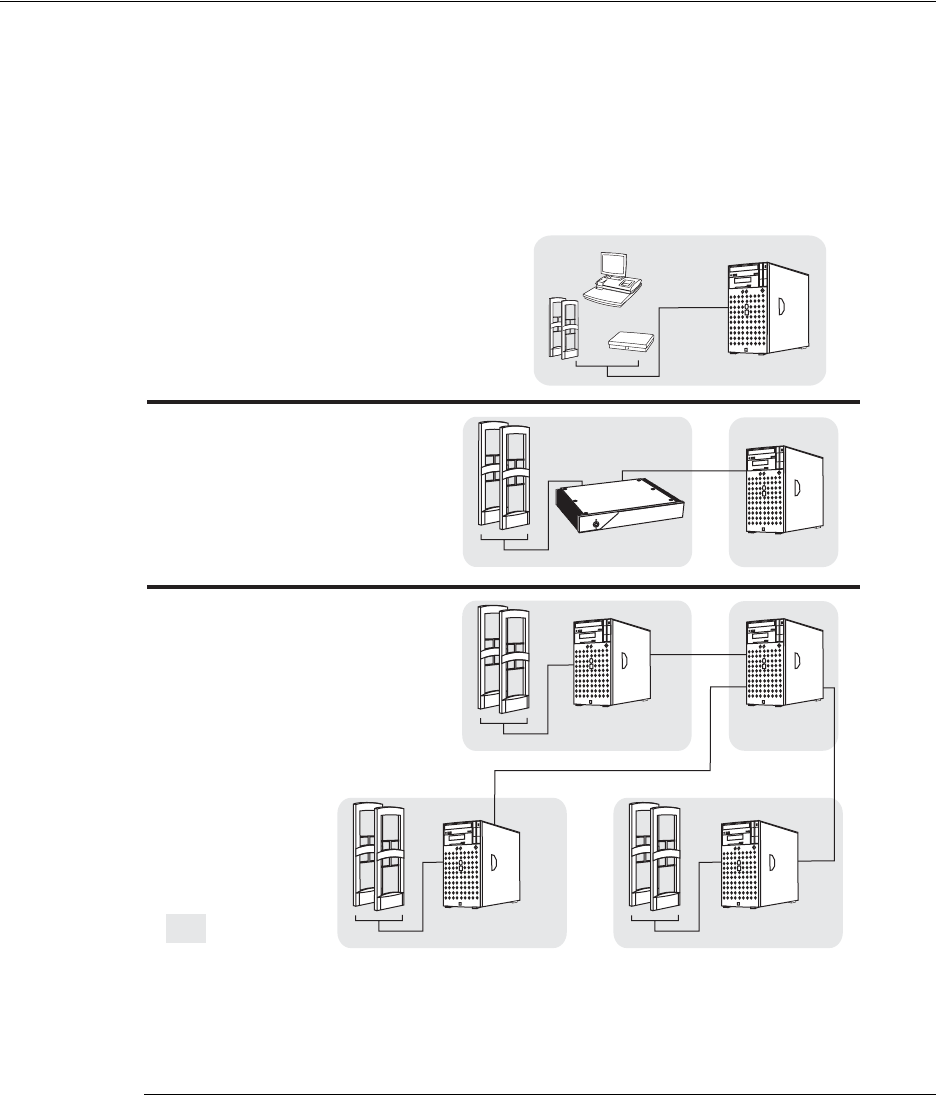
Introduction: Library Network Topology 1-3
Library Network Topology
In addition to supporting the Single Branch topology, ILS Version 3.0 supports the
following library topologies:
•“Single Branch”
•“Single Server, Multi-Branch Architecture”
•“Peer-to-Peer Communication”
Figure 1.2 depicts the library network topologies supported by ILS Version 3.0.
Figure 1.2
Library Network Topologies Supported by ILS Version 2.5
Single Branch
The Single Branch scenario represents the current implementation of ILS, where one
Application Server controls all of the components within a single branch library.
Application Server
Local Security
Controller
= branch
Single Branch
Single Server,
Multi-Branch
Peer-to-Peer
Main BranchPeer Branch
Main Branch
Peer Branch Peer Branch

1-4 ILS 2.5 User Guide
Single Server, Multi-Branch Architecture
New with this release, ILS Version 3.0 enables a single server to manage the circulation of
not only its only branch but multiple remote branches as well, granting the administrator
greater power and ease to manage the entire system. In this scenario, Local Security
Controllers are used to assist the Application Server.
The Local Security Controller (LSC) is a combination hardware and software solution for
a multi-branch ILS deployment. The LSC assists the Intelligent Library Controller in
maintaining the response speed of Exit Interrogators, managing the connection between
the Exit Interrogators at the branch and the remote Application Server to provide
maximum caching performance. The LSC also enables the intelligent sensors to operate
(with limitations) if the main server is down. This scenario is normally used with libraries
containing up to 20 branches.
Peer-to-Peer Communication
New with this release is the ability to run a library’s security and inventory management
system from any ILS Server. This enables a granular redundant system that is crash
resistant because each node can run the entire system, as well as, holding a complete copy
of the checkout cache database at any time.
The main Application Server communicates to each node (peer server) the latest
circulation database in a configurable matter of time (from seconds to hours or even
daily); meaning circulation records are nearly always up to date. This means that exit gates
(intelligent sensors) are updated throughout the day at every branch. This allows a patron
to walk to another branch (for example on a college campus) and their library material will
respond with the correct check-in or checkout status. This scenario is normally used for
libraries containing more than 20 branches.

Introduction: Document Overview 1-5
Document Overview
This manual provides a general overview of the ILS technology and illustrates the use and
operation of each component.
This manual has been designed for the librarian and administrator and contains all the
information necessary to take full advantage of the system capabilities. The Intelligent
Library System enhances your library experience because of the system's inherent ease of
use and efficiency.
This manual is organized into chapters, with each chapter describing a system peripheral,
such as the Self-Checkout Station. Each peripheral is designed with a specific system role
in mind. For example, patrons typically use the Self-Checkout Station, while Library staff
use the Portable Inventory Reader. Read the sections that apply to your role for ILS
system operation.
This manual is divided into the following chapters that cover system peripherals and
important ILS tasks.
• Introduction (See page 1-1)
• Application Server (See page 2-1)
• Self-Checkout Station (See page 3-1)
• Portable Reader (See page 4-1)
• ILS Remote Monitor (See page 5-1)
• CheckVIEW (See page 7-1)
• Exception Ticket Printer (See page 6-1)
• CheckPASS (See page 11-1)
• Tagging procedures (See page 8-1)
• Troubleshooting Guide (See page 12-1)
• System Maintenance Guide (See page 13-1)
Intended Audience
This document is intended for library staff and administrators as well as Checkpoint
Systems field service staff. The library staff includes librarians, support staff, and
temporary staff. The Field Service staff is comprised of the Checkpoint installers and
technical support personnel. These audiences need to understand the basic functions,
operations, and procedures related to the ILS.
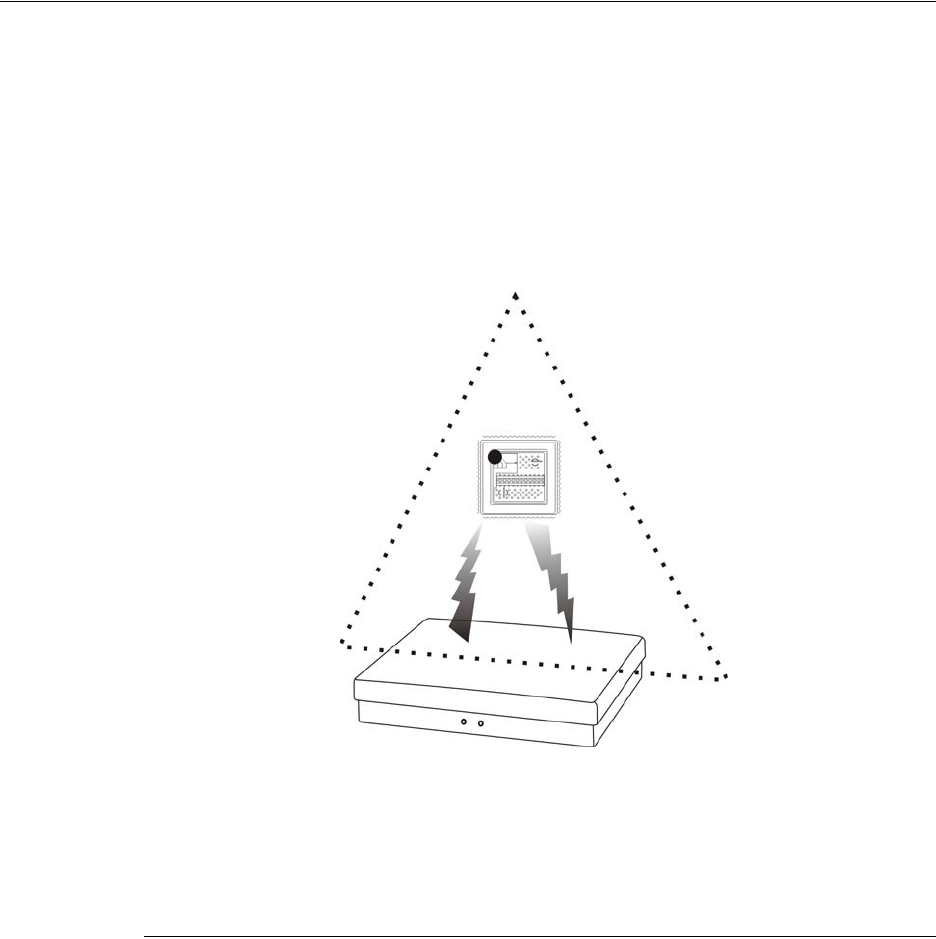
1-6 ILS 2.5 User Guide
System Overview
The following sections describe how the Intelligent Library System Open Plus interacts
with a library’s circulation system to maintain its collection.
How RF Query Tags
The Intelligent Library components - Self-Checkout Station, Intelligent Sensor, Staff
Station Reader, and Portable Reader - all use a Radio Frequency (RF) antenna and
transceiver system (interrogator) which detects and reads the RFID tags. Communications
occur when an interrogator’s radio field is triggered by a tag passing through it. When
energized, the tag presents the programmed item-specific information to the interrogator
for further processing.
Figure 1.3
RFID Tag is interrogated
The data, routed by the Intelligent Library Controller, is compared to the Library
Management System (LMS) database, in order to identify the checkout status of an item.
How ILS Maintains the Library’s Collection Database
The Intelligent Library Controller is the communications gateway between the ILS
subsystems and the library’s Library Management System (LMS) so that the check-in,
self-checkout, inventory management, and security activities can all be accomplished.
All library materials including books, CD/DVD materials, videotapes, and cassettes are
tagged with a permanent RFID tag. This tag contains information that uniquely identifies
the item within the library circulation database. Patron cards identify patrons when the
card is scanned at the Self-Checkout Station. The card stores coded information unique to
the individual patron that identifies the user to the Library Management System. The
patron can then be validated as eligible or ineligible to use the library checkout privilege.
Sample Interrogator
(Staff Station Reader)
RFID Tag
101AU.....
??????........
Radio Field
Introduction: System Overview 1-7
Patron Checkout and Check-In
Patrons use Self-Checkout Stations to checkout library materials. Self-Checkout Stations
include a patron card reader, an RFID tag, a touch screen monitor, and a printer in one
compact unit. This provides the patron with library transaction capability without any
librarian assistance. A patron scans the RFID Patron Card and library materials,
identifying the patron and linking the library materials to the individual through a
communications session with the Library Management System via the Intelligent Library
Controller.
When the patron checks out materials, the patron and checked out item information is
stored in both the LMS and ILS databases, allowing ILS to operate in both on- and off-line
modes. When materials are checked out from a Self-Checkout Station, the ILS asks the to
the patron to checkout items from the LMS. If privileges are granted then a checkout
request to the LMS is generated for each item.
If the patron is checking in library materials, the ILS makes a check-in request to the LMS,
which updates its database and reports the result back to the ILS.
Staff Checkout and Check-In
The library staff typically uses a Staff Station Reader in situations where a patron needs
help from a librarian or when a librarian is checking in or checking out library materials.
The Staff Station Reader interrogates tags and functions the same as current bar code
scanners used in Library Management Systems.
Book Return Check-In
The Staff Station Reader can also be integrated into a book return slot. When library
materials are placed in the book return, the tags on the items are read and sent to the LMS.
The LMS then updates its database and passes back the transaction status to the ILS.
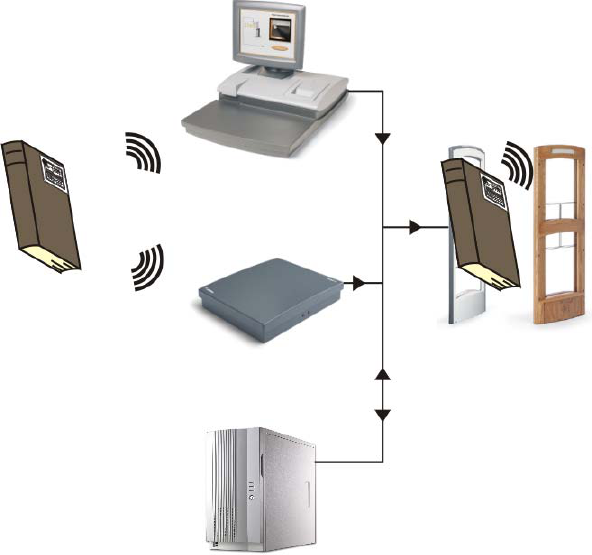
1-8 ILS 2.5 User Guide
Checkout Process
Diagrammed here is how library materials are checked out.
Figure 1.4
Check Out Flow
1The RFID tag, encoded with the necessary information, is wirelessly read by either the
Self-Checkout Station or the Staff Station Reader.
2The Station or Reader communicates with the Intelligent Library Controller which,
after successful verification, communicates back to the Station or Reader that the book
is checked out.
3When exiting the library, the book passes through the Intelligent Sensors which
verifies the status of the book and allows it to exit the library without triggering an
alarm.
Self-Checkout Station
Staff Station Reader
Intelligent Library Controller
Intelligent Sensors
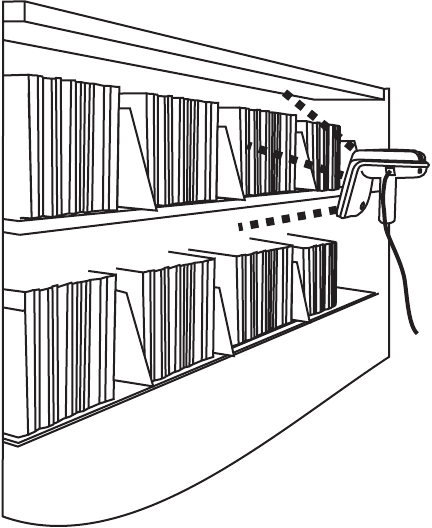
Introduction: System Overview 1-9
Inventory Collection
You can use the Portable Inventory Reader to inventory the library’s contents or to find
individual items. The unit is a battery powered hand-held device that interrogates RFID
tags as you walk by tagged items, when the unit detection head is within a ten-inch
(25 cm) radius.
The Portable Inventory Reader searches for specified items using its search function.
Single or multiple item IDs can be uploaded to the data terminal and when a scanned ID
matches, the user receives an audible alert and the ID is displayed on the data terminal.
Figure 1.5
Portable Inventory Reader Taking Inventory
The Item Identifiers on the tagged articles are read and stored in a Portable Data Terminal
which can be downloaded in real-time to the Intelligent Library Controller using the
wireless data-terminal option or downloaded after the inventory is completed as a batch
file using the standard data terminal. The inventory data is then communicated to the
Library Management System, which compares the information from the Portable
Inventory Reader to item information in the circulation database.
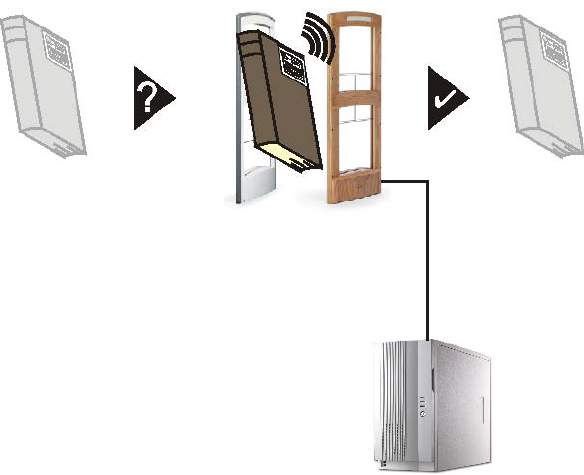
1-10 ILS 2.5 User Guide
Exit Monitoring
The Intelligent Sensor protects exit/entry aisles against unchecked library materials
leaving the secured area by determining whether tagged items have checked (authorized/
no alarm) or unchecked (unauthorized/alarm) events.
Figure 1.6
Exit Monitoring
Programming Tags
The Tag Programming Station enables libraries to read and create their own RFID tags
and print barcode labels. This can also be used to convert library materials with barcodes
to RFID tags programmed with the barcode value. A tag format file (created by
Checkpoint field service staff using the Tag Programming Application) is used to program
the tags in a compatible format. Tags are programmed by printing them with the Tag
Programming Station. See “RFID Tag is interrogated” on page 1-6 for an illustration of
this process.
Off-line Processing
The Off-line Processing feature enables the Intelligent Library Controller and
Self-Checkout Stations to continue operating when disconnected from the library’s
circulation system. While the circulation system is offline, the Intelligent Library
Controller records significant events on the system, which are then reported to the
circulation server when synchronization reoccurs. For example, at the time of
synchronization, the due date is sent to the circulation server.
When Off-line Processing is turned on, the word ON appears next to Off-line Processing.
The feature is turned on or off by Checkpoint field service personnel by setting a table
parameter on the Intelligent Library Controller. If using the Bridge Interface (“ILS
Without an LMS Connection”), Off-line Processing should never be turned on.
Intelligent Library Controller
Intelligent Sensors
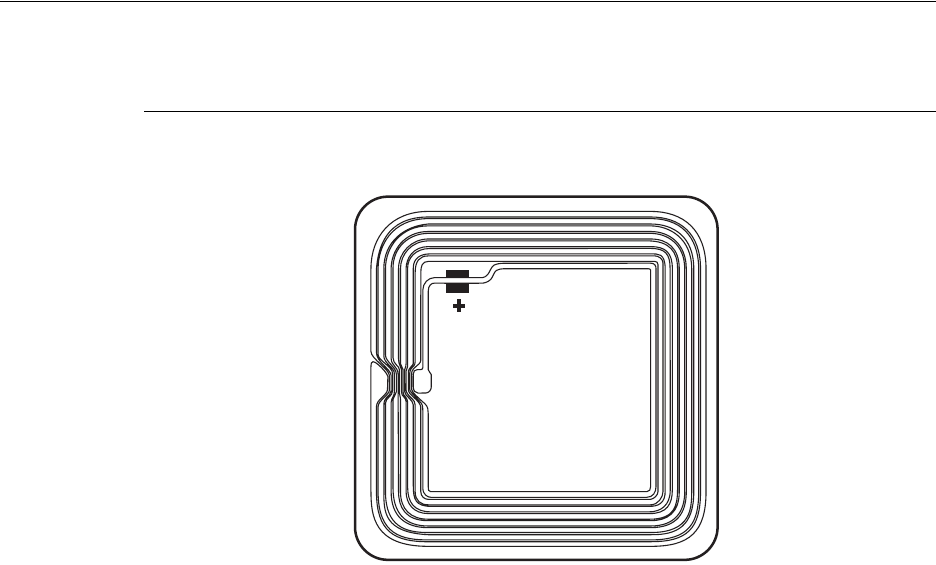
Introduction: Components 1-11
ILS Without an LMS Connection
It is possible for ILS to operate without an active Library Management System (LMS)
interconnection using the ILS Bridge Interface feature. The Bridge Interface feature
allows libraries with non-supported circulation vendors or no circulation systems to use
the security and Staff Station Reader functionality of the ILS.
With the Bridge Interface, the user of the ILS Control program monitors and changes the
operation mode (check-in or checkout) of the Staff Station Readers. A library that is using
the Bridge Interface can use a Staff Station Reader for checkout, but cannot use a
Self-Checkout Station.
Components
The following sections describe in detail each of the ILS system components.
RFID Tag
The RFID tag an advanced RFID integrated circuit bonded to a label which is then
attached to library material.
Figure 1.7
RFID Tag
The tag stores 96 programmable bits of information about an item that can be read on a
single Radio Frequency, 13.56 MHz, up to a distance of 4 feet (1.2 m). The tag allows for
the reading of multiple tags using an anticollision algorithm, as well as error detection and
correction methods.
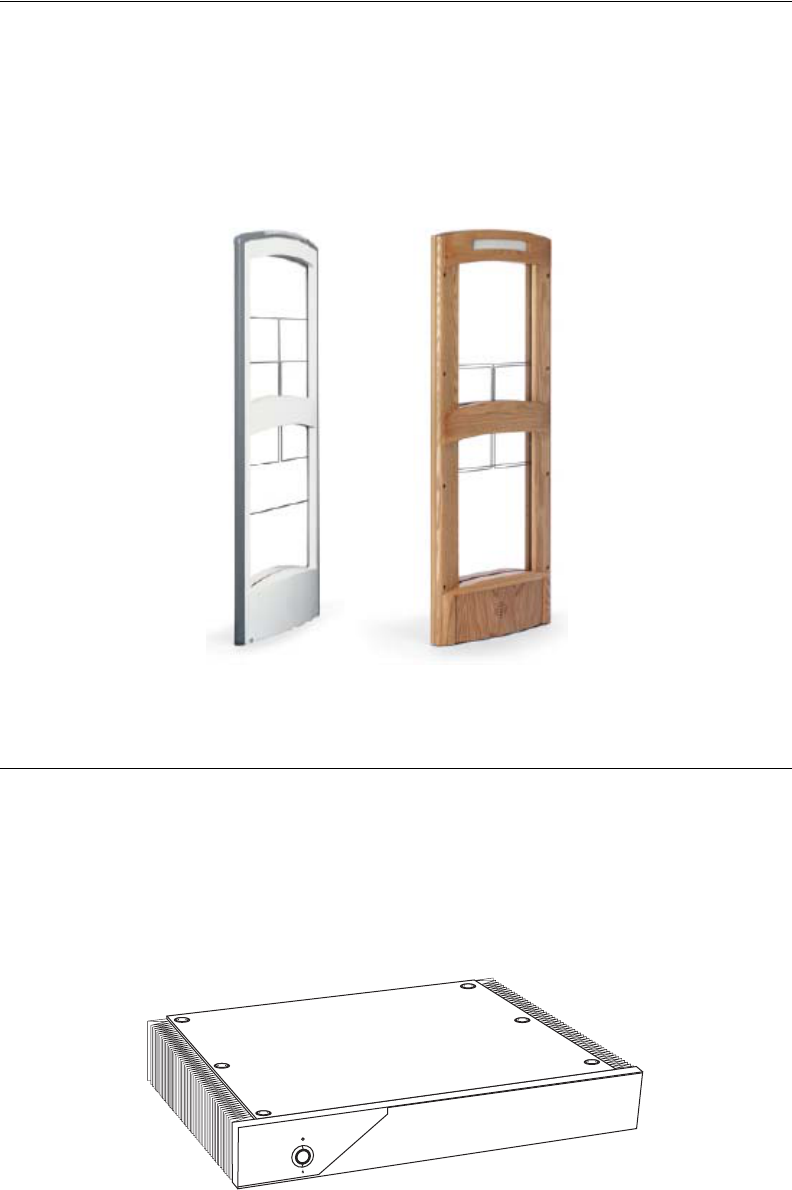
1-12 ILS 2.5 User Guide
ILS Intelligent Sensor
The ILS Open Plus Exit Gate provides security at library exits and corrals by generating a
radio field that gathers tag information from a distance up to 24 inches (61 cm). Two
intelligent sensors form a secure aisle up to 48 inches (122 cm) wide for tag detection
range. Additionally, the sensor communicates back to the Library Management System
via the Intelligent Library Controller in real-time, determining whether an item has been
checked out. If items in the interrogation field are not properly checked out, an alarm
sounds and the book title appears on an exit alarm screen.
Figure 1.8
ILS Intelligent Sensors
Local Security Controller
The Local Security Controller (LSC) is a combination hardware and software solution for
a single server, multi-branch ILS deployment. The LSC assists the Intelligent Library
Controller in maintaining the response speed of Intelligent Sensors (exit gates), managing
the connection between the Exit Interrogators at the branch and the remote Application
Server to provide maximum caching performance. The LSC also enables the exit gates to
operate (with limitations) if the main server is down. This scenario is normally used with
libraries containing up to 20 branches.
Figure 1.9
Local Security Controller
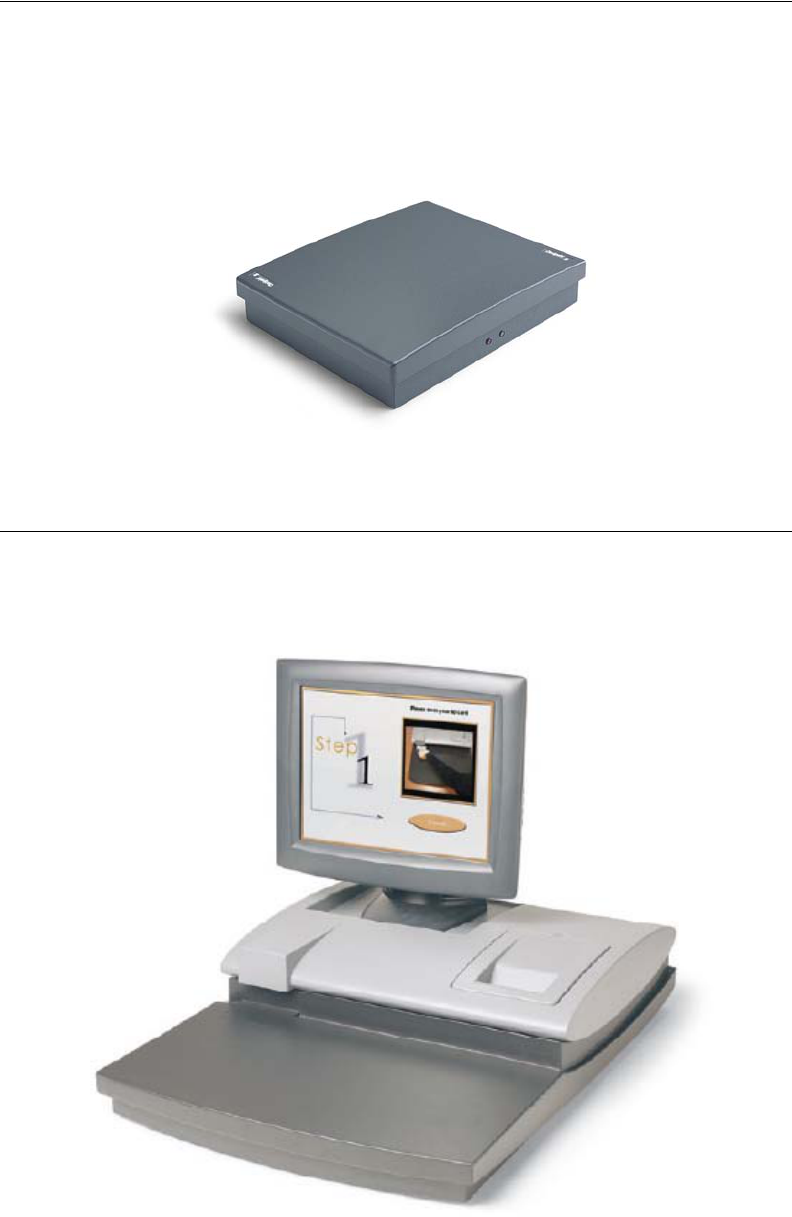
Introduction: Components 1-13
Staff Station Reader
The Staff Station Reader functions as an interface to ILS and circulation activities for
library personnel. The Staff Station Reader reads RFID tags when a book is placed on the
reader at up to 12 inches (30 cm) from the reader in a vertical direction. The Staff Station
Reader communicates through data links with both the Library Management System and
ILS, providing library staff the ability to perform typical functions with both the library
system and RFID tagged items. For example, library staff can find the status of RFID
tagged items that have been processed by ILS.
Figure 1.10
ILS Staff Station Reader
Patron Self-Checkout Station II
The Self-Checkout Station enables a library patron to checkout library materials without
the assistance of the library staff. The system may report messages if there is a problem
conducting the checkout transaction; for example, overdue fines have locked the patron’s
account.
Figure 1.11
ILS Self-Checkout Station

1-14 ILS 2.5 User Guide
The Self-Checkout Station supports multiple languages simultaneously. When
programmed, a language selection screen is presented to the patron to select a language for
the self-checkout transaction.
A typical scenario for a patron to check out a book is as follows.
1A patron arrives at the Self-Checkout Station and selects a language (if using multiple
languages).
2The patron is identified by the system with their patron ID card.
3The system confirms the patron’s eligibility to conduct a transaction through validation
of the patron ID card.
4The patron is led through the transaction process by communication with the system
through a touch screen monitor. The patron checks out items by passing them one at a
time over a short-range wireless interrogator that is located in the Self-Checkout
Station.
aThe short-range interrogator generates a radio field, which activates and
interrogates the tagged item.
bThe interrogated item ID is passed to the Intelligent Library Controller.
cThe Intelligent Library Controller determines the item status and actions that can be
taken via communications with the Library Management System.
dThe Intelligent Library Controller updates the Self-Checkout Station, which notifies
the patron about their transaction status.
5After the patron scans all the items to be checked out, the patron touches Done and
receives a receipt for the transaction, listing all materials checked out and the
respective due dates.
Portable Inventory Reader
The Portable Inventory Reader provides inventory management functions, such as
inventory reconciliation and item search. The device consists of a hand-held, rechargeable
battery operated wand that generates a radio field that scans RFID tagged items. The wand
is attached with cabling to a data terminal, which can be carried in one hand or strapped
onto the wrist, storing information read by the wand. The data stored in the terminal can be
downloaded to the Intelligent Library Controller in real-time either with the standard data
terminal or wirelessly.
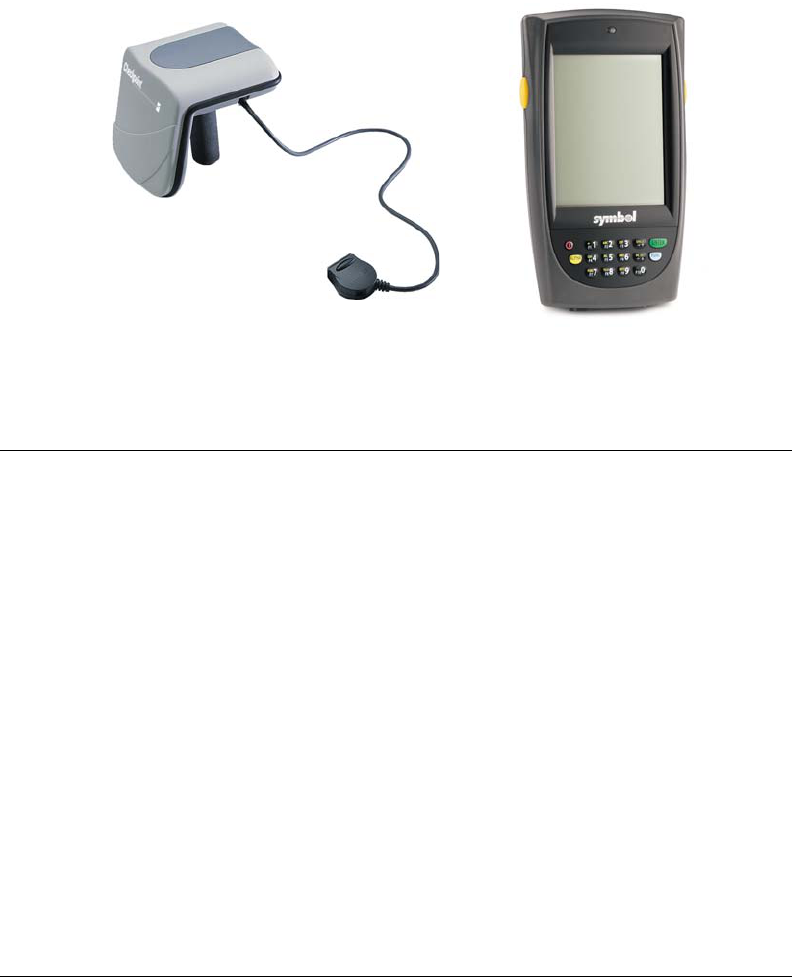
Introduction: Components 1-15
The wand can also be used for item searches and shelf order checking. Item information is
uploaded to the data terminal, allowing you to scan the ID. Once found, an audible alert
sounds and the ID displays.
Figure 1.12
ILS Portable Reader
Intelligent Library Controller
The Intelligent Library Controller software:
• Functions as the communications gateway between the Intelligent Library subsystems
and the Library Management System
• Identifies and configures all peripheral Intelligent Library sub-systems
• Tracks and directs all ILS transactions
The Intelligent Library Controller operates whether the Library Management System is
on-line or off-line. In off-line mode, the server tracks whether an item is being checked
out, checked in, and determines whether tagged items going through secured areas are
authorized. If unauthorized items are detected by the system, the server signals the
Intelligent Sensor (the gates) to alarm. Any transactions that occur independent of the
Library Management System are updated when the ILS system comes back on-line.
The Intelligent Library Controller interfaces to the Library Management System and other
subsystem components using the 3M© protocol (SIP2) over an Ethernet Network Interface
Card (NIC). The Ethernet NIC uses the TCP/IP protocol and session and the physical
cable is 10BaseT.
Exception Ticket Printer
New in ILS Version 3.0 is the option to automatically print a hold receipt for library
material at designated book drops. This means that when library material is returned via a
book drop, if the library material is designated with a hold, a printer automatically prints a
receipt. This frees library staff from having to manually check-in each item for its hold
status. Instead, a staff member just checks the print receipt and then secures the receipt
with the item on hold.
Inventory Wand
Portable Data Terminal

1-16 ILS 2.5 User Guide
One exception ticket printer can service multiple interrogators. This means that a receipt
might print at the exception ticket printer near Drop Box A for a book that is returned at
Drop Box B.
CheckVIEW
New in Version 3.0 is the CheckVIEW utility, enabling library staff to remotely monitor
up to four different Self-Checkout Stations at one time from any computer within the
library. This enables library staff to manage issues such as:
• Patrons who are having difficulty using the touch screen
• Stations that may have hardware or system problems
• Viewing the patrons’ check out list to reconcile any discrepancies concerning
availability
Staff members can use their mouse and keyboard to assist patrons by assuming control of
a specific Self-Checkout Station window to step a patron through a checkout procedure.
ILS Remote Monitor
New in Version 3.0, ILS Remote Monitor is an optional utility that allows library staff
operating in a single server, multi-branch or peer-to-peer environment to view the status of
other branches on the network from any computer on that network. This enables a staff
member to monitor system status, identify a troublesome Self-Checkout Station, print a
pre-run report, or transfer files.
The ILS Remote Monitor works on any computer (with a web browser) that is connected
to the library network.
Tag Programming Station
The Tag Programming Station programs RFID tags, either with the retrospective item
identifier from the existing barcode or when new materials are added to the collection.
This reduces the time it takes to convert a library collection from barcode to RFID tags as
well as add additional materials.
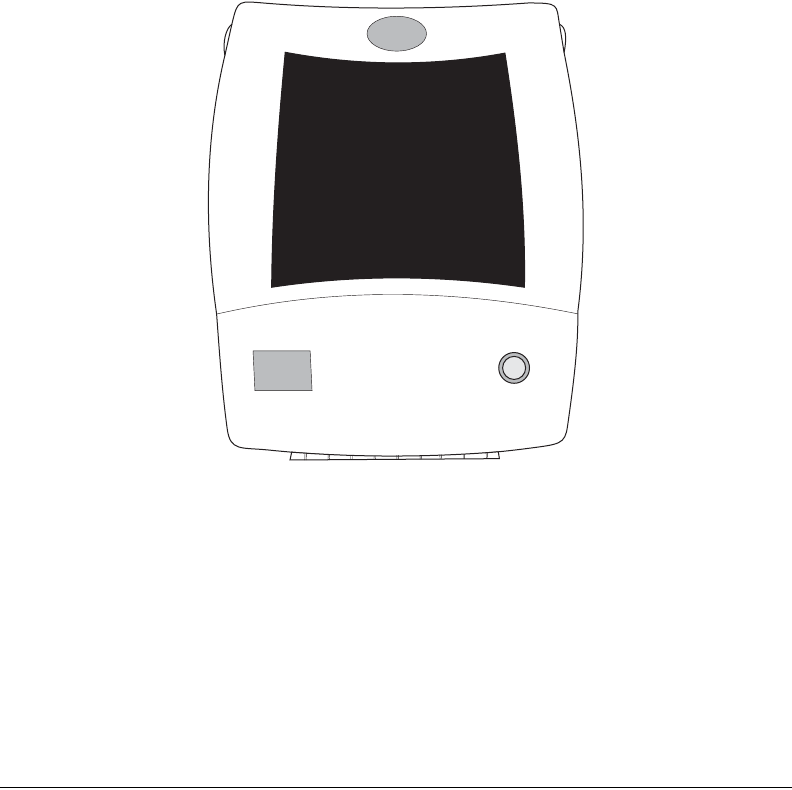
Introduction: Components 1-17
The Tag Programming Station enables the library to easily link new materials into ILS
instead of waiting several weeks for pre-programmed tags.
Figure 1.13
Tag Programming Station
When adding a new item to the collection and programming the RFID tag, the library can
also print a barcode label. In many cases, libraries will continue to support the use of
barcodes in addition to the RFID tags, mainly for compatibility with other branch libraries
still using barcodes.
Using the Tag Programming Application, libraries program the RFID tags by printing
them. Refer to “Affixing Tags” on page 8-1 for instructions on how to attach circuits to
library materials.
CheckPASS
CheckPASS is an optional utility that allows library patrons to pay library fees at a
Self-Checkout Station, without staff assistance. Outside of the ILS product, patrons use a
self-service unit to add cash to their account balances. Within ILS, patrons are reminded of
outstanding library fees when they attempt to check out materials. They can then pay with
the touch of a button at the Self-Checkout Station. Patrons save time and library staff is
freed to perform other tasks.
See “CheckPASS” on page 11-1 for further information.
1-18 ILS 2.5 User Guide
Notes

Application Server: 2-1
CHAPTER
C
HAPTER
0
A
PPLICATION
S
ERVER
The Application Server hardware hosts the Intelligent Library Controller software, which
is the core-processing component of the Intelligent Library System Open Plus. The
Intelligent Library Controller performs many functions, including:
• Storing transactions performed at the Self-Checkout Stations
• Downloading inventory data from the ILS Portable Inventory Reader
• Generating reports
• Connecting to the Library Management System (LMS)
In addition, the Intelligent Library Controller provides a single station for system
configuration and diagnostics. If the LMS becomes unavailable, the Intelligent Library
Controller can support automated checkout functions without the LMS, using a feature
known as Off-Line Processing. Off-Line Processing is a site-specific option, so it may not
be available to you.
This chapter describes the Application Server and its components and how they operate
within the ILS. It also provides information on:
• Checking system, host, interrogator, and exit alarm status (page 2-2)
• Scheduling Checkout Cache Synchronization and Host Reconnections (page 2-6)
• Synchronizing the Checkout Cache (page 2-8)
• Downloading inventory information from the Portable Inventory Reader (page 2-10)
• Generating, saving, and printing reports, including Checkout Discrepancy, Patron
Discrepancy, Exit Alarm, Check-In Exception, and Generic reports (page 2-11)
• Communicating and coordinating data exchange with Local Security Controllers at
remote branches (page 2-25)
• Working in Bridge Mode (page 2-25)
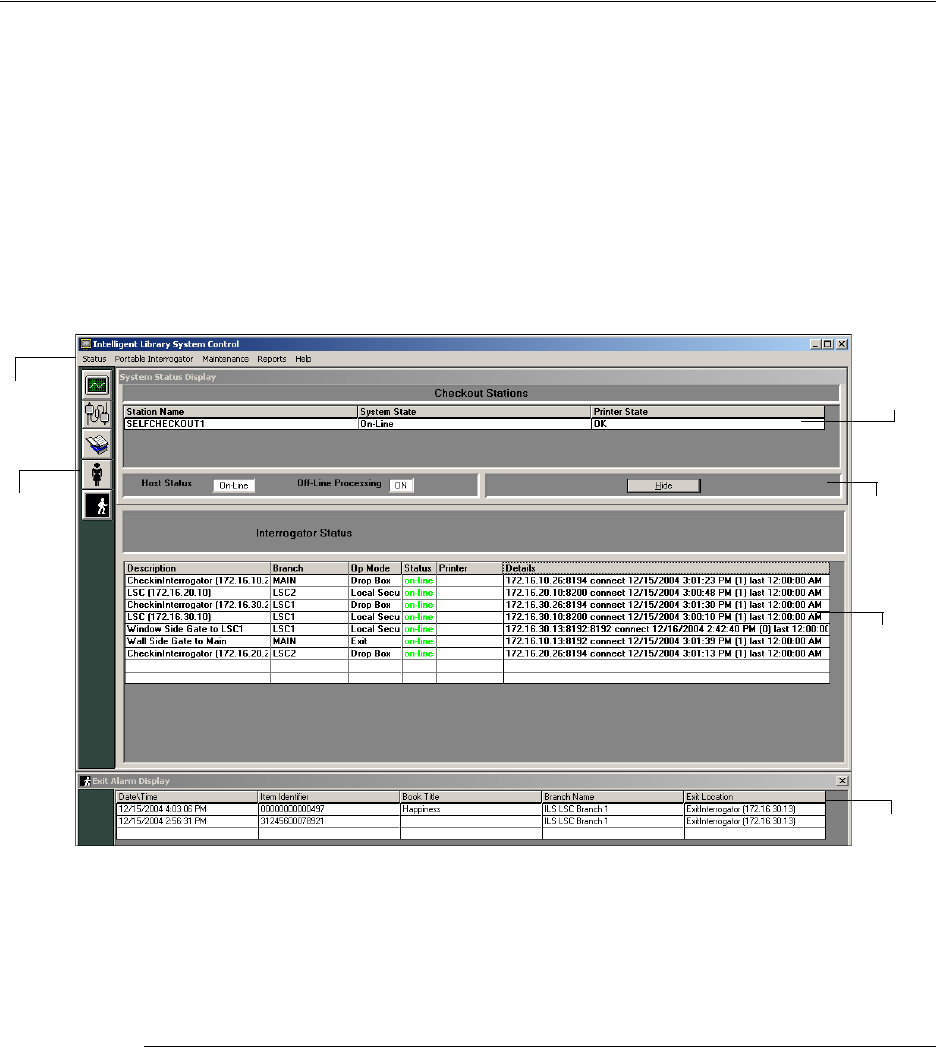
2-2 ILS Open Plus 3.0 Installation Manual
Check System Status
The Intelligent Library Controller provides current information on the status of the ILS
system and ILS Portable Inventory Reader. You also use it to generate reports.
The four main sections of the Intelligent Library Controller window include:
• Self-Checkout Station Status (page 2-2)
• Host Status (page 2-4)
• Interrogator Status (page 2-4)
• Exit Alarms (page 2-6)
With the exception of the Interrogator Status section, these sections can be displayed or
hidden from view.
Figure 2.1
Intelligent Library Controller window
You navigate using the menu bar or the button bar. The button bar provides shortcut
buttons to the most commonly-used features. Use the Hide button to hide or show
individual areas of the window.
Self-Checkout Station Status
The Self-Checkout Station Status section displays information about the operational state
of the Self-Checkout Stations, including:
• Station Name
Displays the name of each Self-Checkout Station.
Button
Bar
Menu
Bar
Self-Check
out Station
Status
Host
Status
Interrogator
Status
Exit Alarms
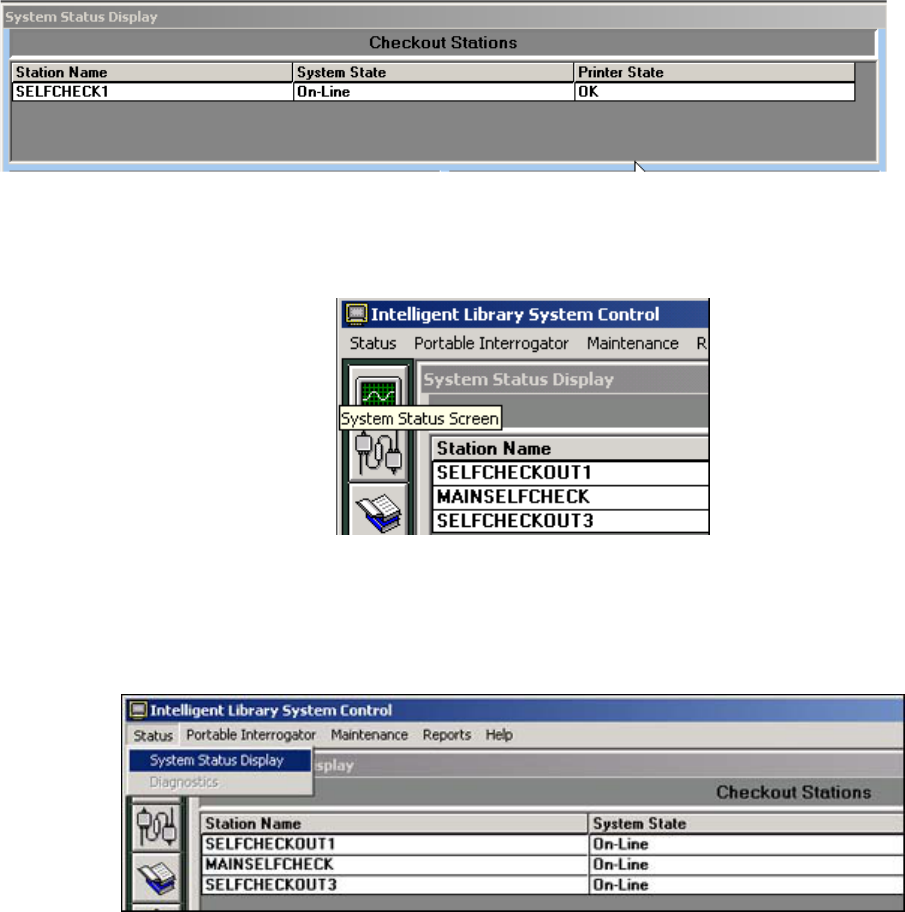
Application Server: Check System Status 2-3
• System State
Identifies whether or not the Self-Checkout Station is connected (on-line) or not
connected (off-line) to the LMS.
• Printer State
Displays messages about the printer, including: OK, out of paper, I/O error, and so on.
These messages are generated by Windows.
Figure 2.2
System Status Section
To display the System Status Section:
Click System Status in the button bar. See Figure 2.3.
Figure 2.3
System Status Button
OR
Select Status > System Status Display in the menu bar. See Figure 2.4.
Figure 2.4
System Status Menu Selection
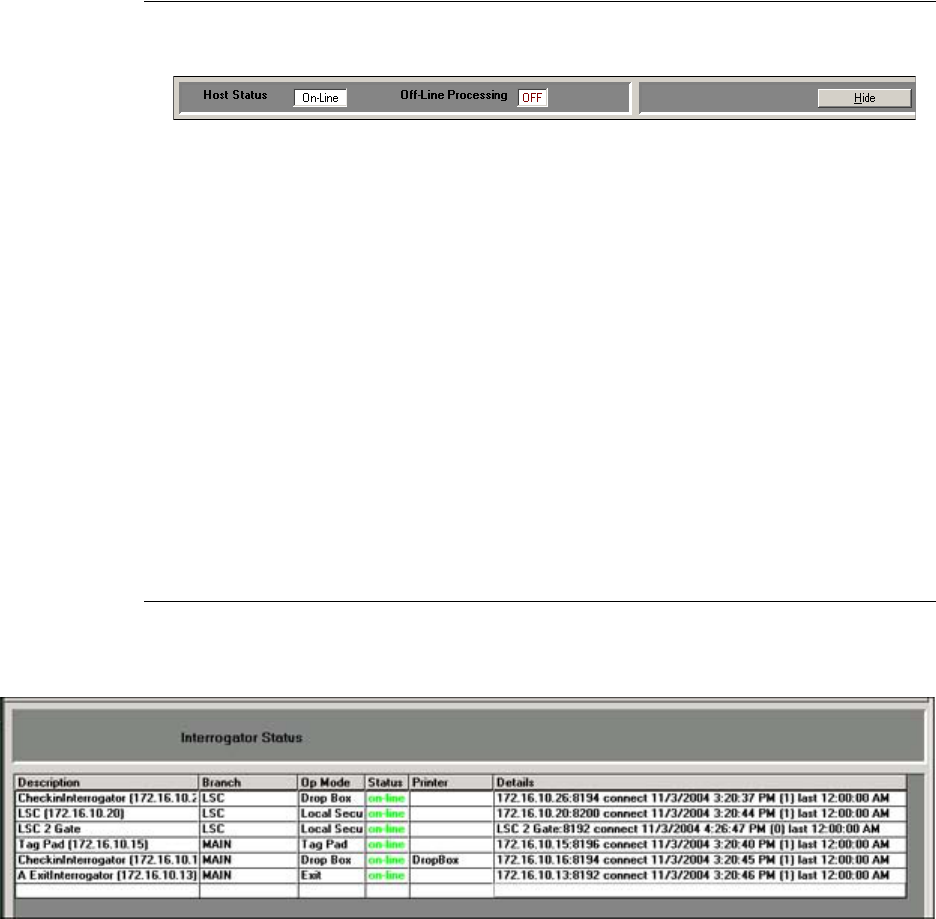
2-4 ILS Open Plus 3.0 Installation Manual
Host Status
The Host Status section notifies you if the host (Library Management System) is on-line or
off-line and whether or not Off-Line Processing is enabled.
Figure 2.5
Host Status Area
The Off-Line Processing feature allows a library to configure the Intelligent Library
Controller and Self-Checkout Stations so they can continue to operate while the LMS is
off-line. While the LMS is off-line, the Intelligent Library Controller records significant
events (such as check-ins and checkouts) and reports them to the LMS later, during cache
synchronization.
Off-Line Processing must be enabled on an Application Server that uses the Bridge
Interface. The Bridge Interface allows libraries with non-supported circulation vendors, or
no LMS at all, to use the ILS security and Staff Station reader features. See “Working with
the Bridge Interface” on page 2-25 for more information.
This feature is optional and may or may not be enabled (allowed) at your site.
• If Off-Line Processing is enabled, the Off-Line Processing status is ON.
• If Off-Line Processing is disabled, the Off-Line Processing status is OFF.
Interrogator Status
The Interrogator Status section shows information about interrogators (Self-Checkout
Stations, Staff Station Readers, and Intelligent Sensor exit gates), including:
Figure 2.6
Interrogator Status Section
• Description
The IP address, port number, and the location of the interrogator.
•Branch
The library branch at which the interrogator resides.
• Op Mode
Used in bridge mode to denote the function of the interrogator, including Check In,
Checkout, Drop Box, or Exit. If your site does not use the Bridge Interface, the Op
Mode denotes the function of the interrogator, including Drop Box, Exit, or Tag Pad.
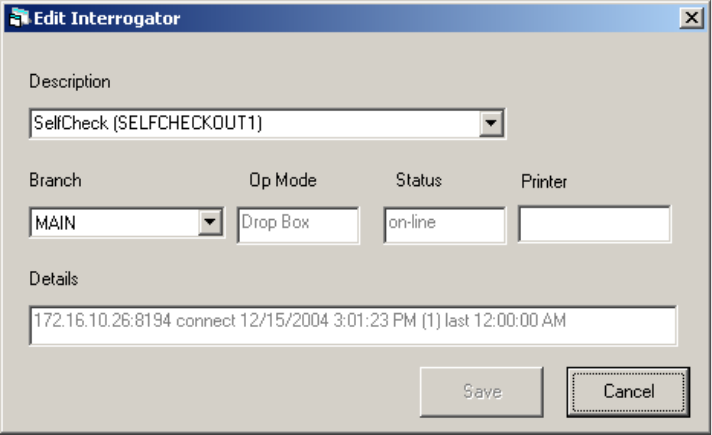
Application Server: Check System Status 2-5
• Status
Operational status of the interrogator (on-line or off-line).
• Details
Shows a history of connections for each interrogator, including IP address, port
number, whether the connection was a connect or disconnect, connection date, and
connection time. The number in parentheses (#) shows how many reconnections were
attempted. (A high number of attempts may indicate network problems.)
This section cannot be hidden from view.
Edit Interrogator
To view or edit the information for an individual interrogator:
1In the Intelligent Library System Control window, select Maintenance > Edit
Interrogators.
2Type the ILS username and password in the ILS Login window. The default
username is ils and the default password is maint. The Edit Interrogator window
displays:
Figure 2.7
Edit Interrogator Window
3If necessary, use the drop-down list boxes to select the desired Interrogator (desc.)
and Branch (Figure 2.7). In the example above, SELFCHECKOUT1 will be assigned
to the Main branch.
4Make the desired modifications, and click Save. For example, you can change the
description of the component in the Description drop-down menu by typing over the
existing description. Click Cancel to clear any changes you do not wish to save.
5Close the Edit Interrogator window by clicking the X.
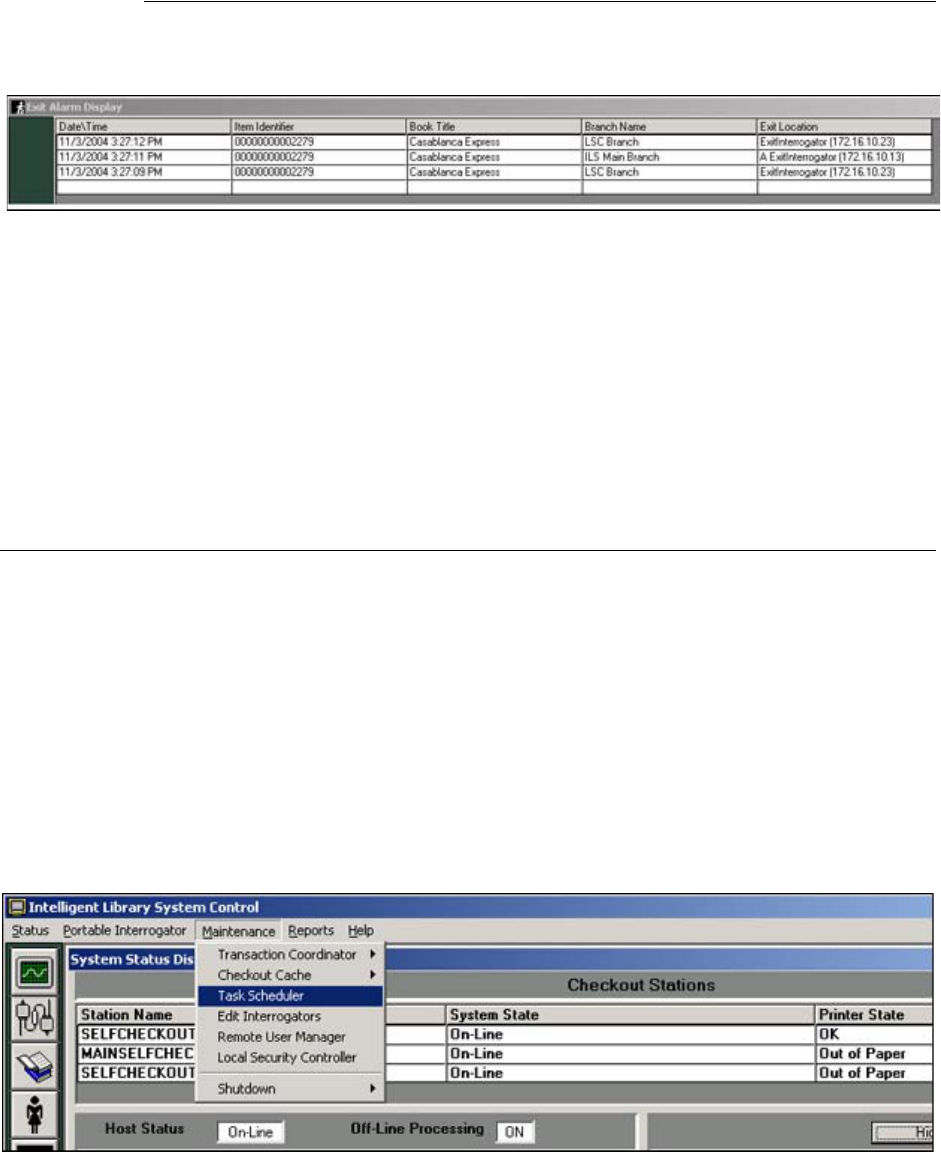
2-6 ILS Open Plus 3.0 Installation Manual
Exit Alarms
The Exit Alarms section displays information about each exit alarm that has occurred,
including:
Figure 2.8
Exit Alarms Section
• Date and time of exception
• Item identifier
• Book Title of the exception
• Branch at which the exception occurred
• Exit location is the exit gate at which the exception occurred
Scheduling Checkout Cache Synchronization and Host
Reconnections
Use Task Scheduler to schedule Checkout Cache Synchronization and Host
Reconnections to execute automatically at the desired time. It is recommended that they
occur once each day, during non-circulation hours.
For an explanation of Checkout Cache Synchronization, see “Synchronizing the Checkout
Cache” on page 2-8. You should schedule this task to occur once each day.
Host reconnection refers to re-establishing the Application Server’s connection with the
Library Management System. Various tasks that the LMS performs (such as backup) can
cause it to close its connection to the Application Server. You should schedule the
reconnection to happen after the LMS performs these types of tasks.
To display the Task Scheduler and schedule the tasks:
Figure 2.9
Task Scheduler Navigation
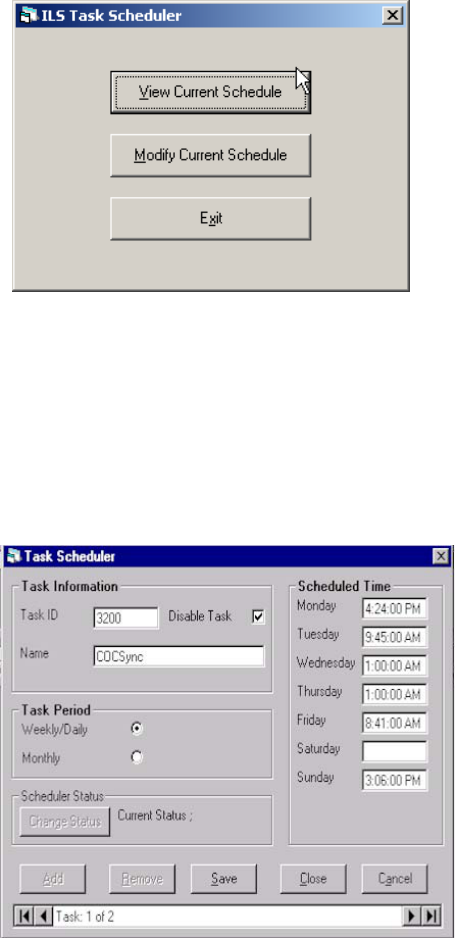
Application Server: Scheduling Checkout Cache Synchronization and Host Reconnections 2-7
1Select Maintenance > Task Scheduler.
Figure 2.10
Task Scheduler Menu
2In the ILS Task Scheduler window, click View Current Schedule or Modify Current
Schedule, depending on which task you want to perform. View Current Schedule does
not allow you to change the schedule.
3Type the ILS username and password in the ILS Login window. The default
username is ils and the default password is maint.
4Click OK to log in to the Task Scheduler. The Task Scheduler window displays:
Figure 2.11
Task Scheduler dialog box (Modify)
5In the ILS Task Scheduler dialog box, enter the following information:
aType a Task ID number. Valid Task ID numbers are:
3200 = Checkout Cache Synchronization
3201 = Host Reconnect
3401 = Transaction Purge (marks for deletion records older than 14 days in
Transaction database)
3402 = Transaction Compact (deletes marked records in Transaction database)
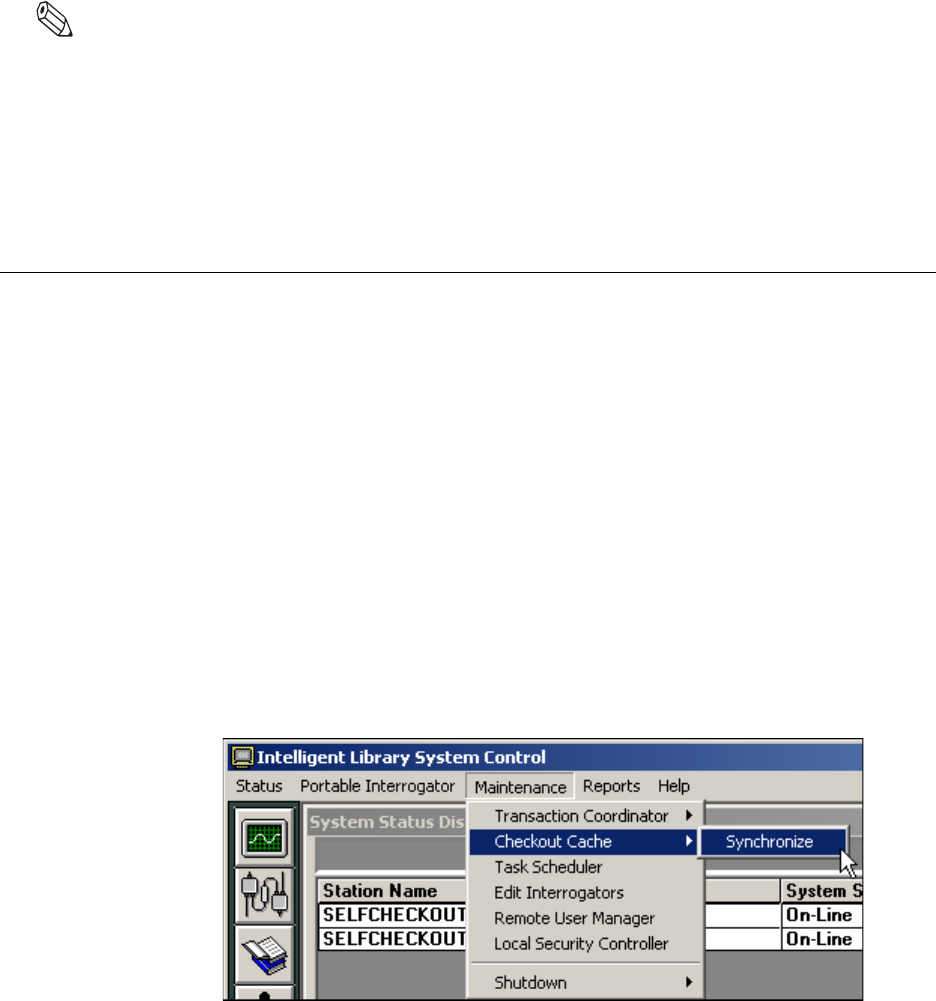
2-8 ILS Open Plus 3.0 Installation Manual
bClick the Disable Task checkbox to override the scheduled time that the task
should run. The task will not run until you clear the checkbox.
cEnter a name for the task.
dSelect whether the task should be run Weekly/Daily or Monthly.
If you select Monthly, enter the day of the month on which the task should run.
eFor each day of the week that you want the task to run, enter a time to start the task.
If you do not want the task to run on a particular day, leave that day’s time field
empty or clear it, as needed.
Note Be sure to schedule Checkout Cache Synchronization to occur soon after the checkout cache file is
transferred from the LMS to the Application Server by the library staff.
You can scroll to different tasks using the arrows at the bottom of the window.
fTo save your changes, click Save, then click Close at the bottom of the dialog box.
To ignore changes, click Cancel.
Synchronizing the Checkout Cache
Under normal conditions, you schedule the Checkout Cache to synchronize automatically.
However, Field Service personnel may ask you to perform this task manually or they may
perform the task themselves.
Checkout cache synchronization works as follows:
1Each night, the library staff generates a list of item identifiers of checked-out material
from the LMS. The library staff transfers this checkout cache file to the C:\inetpub\
ftproot directory on the Application Server.
2Checkout Cache Synchronization should be scheduled to occur after the checkout
cache file is transferred to the Application Server.
3When the Checkout Cache synchronizes, the Application Server deletes its own, older
version of the checkout cache file, and uses the newly transferred file as its new
checkout cache file.
To manually synchronize the Checkout Cache:
1If have not already done, transfer the latest checkout cache file from the LMS to the
Application Server.
Figure 2.12
Synchronize Checkout Cache
2From the menu, select Maintenance > Checkout Cache > Synchronize.
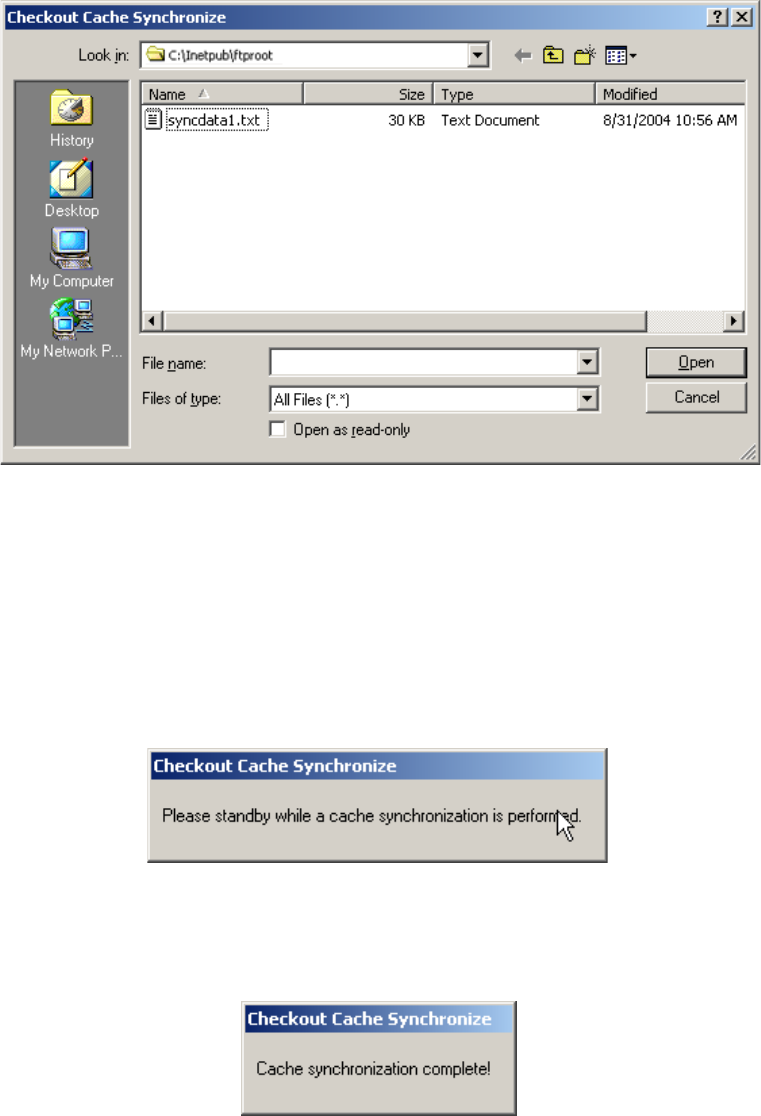
Application Server: Synchronizing the Checkout Cache 2-9
3Type a user name and password in the ILS Login dialog box and click OK. The
default username is ils and the default password is maint. The Checkout Cache
Synchronize window displays.
Figure 2.13
Checkout Cache file location
4In the Checkout Cache Synchronize window, navigate to and select the checkout cache
file (the one that was downloaded from the LMS), usually located at c:\InetPub\
FTPRoot. The name of the file is customizable for each library.
5Click Open to start the synchronization.
When Checkout Synchronization begins, a “cache synchronization in progress”
message displays.
Figure 2.14
Cache synchronization in progress message
A message displays when the process is successfully completed.
Figure 2.15
Cache synchronization complete message
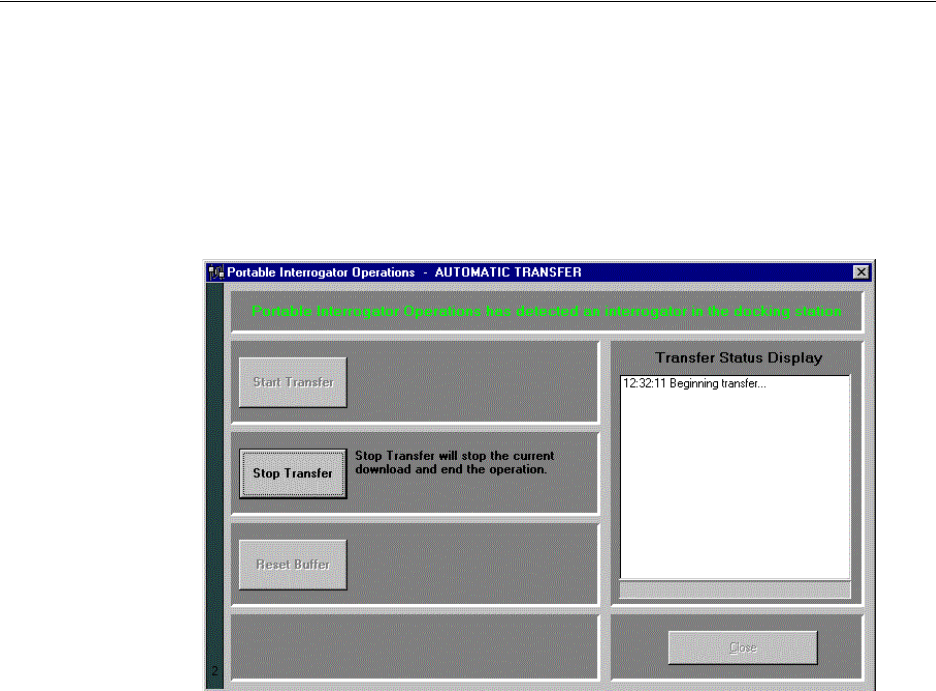
2-10 ILS Open Plus 3.0 Installation Manual
Downloading Inventory from the Portable Reader
Downloading inventory information is a two-step process. First, you download the
information from the Portable Inventory Reader to the Intelligent Library Controller. Then
the Intelligent Library Controller converts the information to the inventory file format
used by the LMS and copies it to a directory from which the LMS accesses it (using FTP).
To download inventory information from the Portable Inventory Reader to the Intelligent
Library Controller:
1Dock the Portable Data Terminal in its docking station. Inventory transfer begins
immediately.
Figure 2.16
Portable Reader Operations Screen - Automatic Transfer
2Once complete, click Close to close the window. The inventory file is now ready to be
uploaded by the LMS.

Application Server: Generating Reports 2-11
Generating Reports
This section describes the ILS reports provided by the Intelligent Library Controller and
gives instructions for generating them. Available reports include:
• Checkout Discrepancy Report
Use this report only if your site allows off-line processing. This report lists off-line
checkout events that were rejected by the LMS after it returned to on-line processing.
See “Checkout Discrepancy Report” on page 2-14.
• Patron Discrepancy Report
Use this report only if your site allows off-line processing. This report lists off-line
patron status events that were rejected by the LMS after it returned to on-line
processing. Before you can successfully generate this report, you must use the Offline
Synchronize function (see “Synchronize Offline Transactions” on page 13-3) to move
off-line transactions into the transaction database. See “Patron Discrepancy Report” on
page 2-15.
• Generic Reports
You specify this report’s parameters to create custom reports. See “Generic Reports”
on page 2-18.
• Exit Alarm Report
This report lists items that caused an alarm at specified exits. See “Exit Alarm Report”
on page 2-21.
• Check In Report
This report lists items that failed to check in or that require special handling. See
“Check In Report” on page 2-23.
After generating a report, you can view or print it. If you generate a report for a specific
branch, you can save, view, or print it; or view later from an ILS Remote Monitor at
another location. You cannot generate Intelligent Library Controller reports when using
ILS Remote Monitor. See “Using ILS Remote Monitor” on page 5-8 for further details.
You can navigate to the most commonly requested reports (Checkout Discrepancy, Patron
Discrepancy, and Exit Alarm) by using the buttons on the button bar, as well as the
Reports menu.
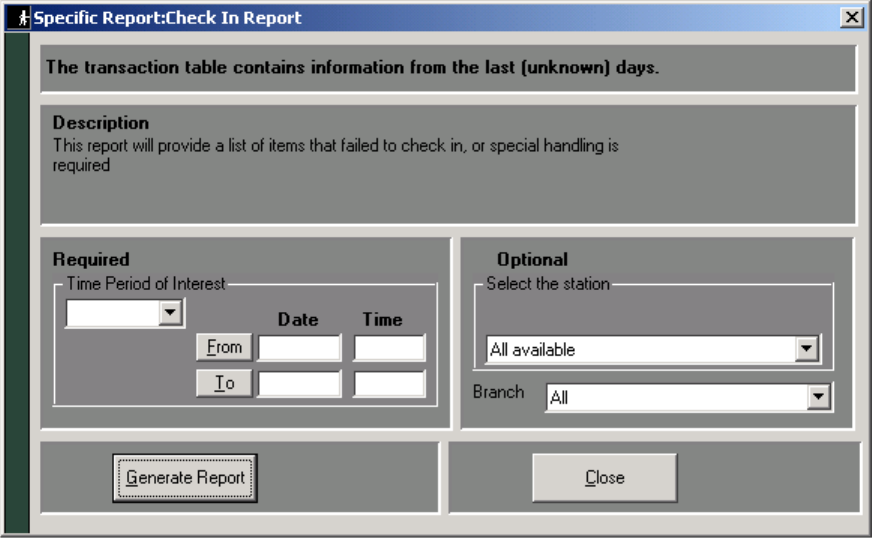
2-12 ILS Open Plus 3.0 Installation Manual
Specifying a Time Period for Any Report
You can specify a time period in one of three ways:
•“Choose a Time Period”
•“Use the Calendar”
•“Enter the From and To information” yourself
Choose a Time Period
1Choose the time period by using the drop-down list labelled Time Period of Interest.
Choices include: Today, Yesterday, This Week, Last Week, This Month, Last Month,
and All Data.
2Enter a From and To time, or leave the fields blank to accept the default times:
From = 12:00:00 A.M.
To = 11:59:59 P.M.
Figure 2.17
Time Period fields
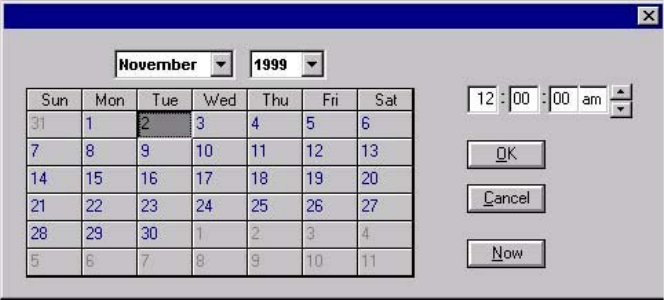
Application Server: Generating Reports 2-13
Use the Calendar
1Click From (or To) to display the calendar form.
Figure 2.18
Calendar
1Select the month and year from the drop-down lists.
2Select the day from the calendar table.
3Specify the time. Enter the time yourself, or select the time by pressing the up-down
arrow buttons at the end of the field. Click Now to use the current time.
4Click OK.
Enter the From and To information
In the From and To fields, enter the date and time yourself. Valid date and time
formats include:
Date: MM/DD/YY or MM/DD/YYYY
Time: HH:MM AM or PM
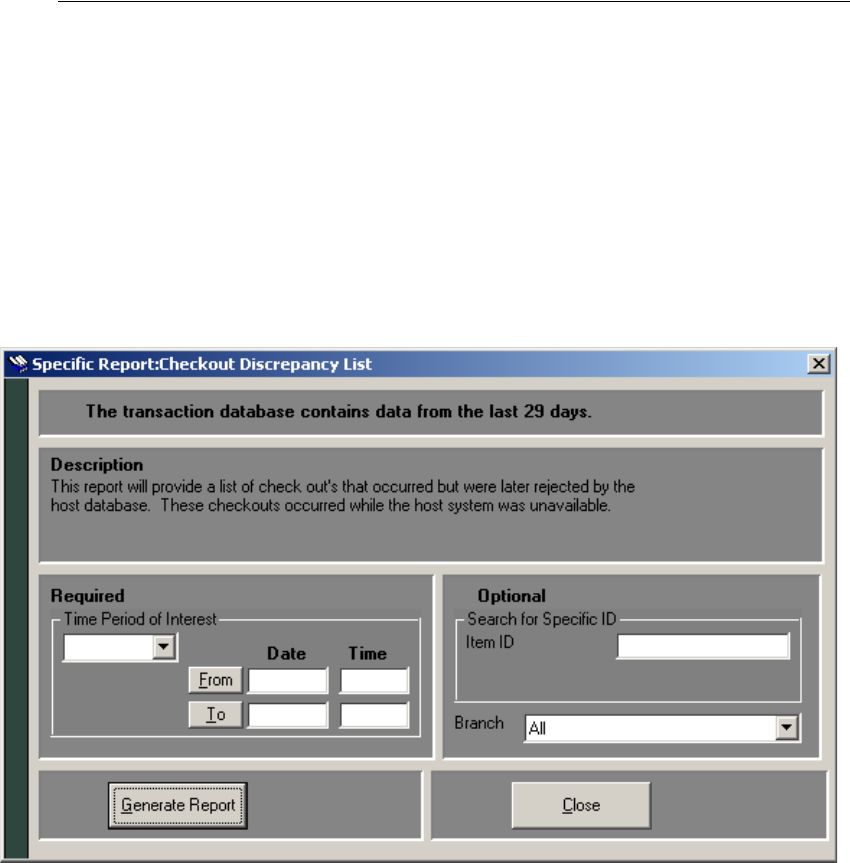
2-14 ILS Open Plus 3.0 Installation Manual
Checkout Discrepancy Report
Use this report only if your site allows off-line processing. This report lists off-line
checkout events that were rejected by the LMS after it returned to on-line processing.
Before you can successfully generate this report, you must use the Offline Synchronize
function (see “Synchronize Offline Transactions” on page 13-3) to move off-line
transactions into the transaction database.
When the LMS returns on-line, use the Offline Synchronize function (see “Synchronize
Offline Transactions” on page 13-3) to move off-line transactions into the transaction
database.
To generate the Checkout Discrepancy Report:
1In the Intelligent Library System Control window, select Reports > Checkout
Discrepancy, or click the Checkout Discrepancy Report button.
Figure 2.19
Checkout Discrepancy List window
2In the Specific Report: Checkout Discrepancy List window, enter the time period for
which to run the report. See “Specifying a Time Period for Any Report” on page 2-12
for details on the different ways to enter time criteria.
3If desired, enter the Item ID of the specific item for which you are searching for which
you are searching.
4If desired, restrict the report to a specific branch by selecting that branch in the Branch
drop-down list box. If selected, you will have the ability to save the report for viewing/
printing in ILS Remote Monitor.
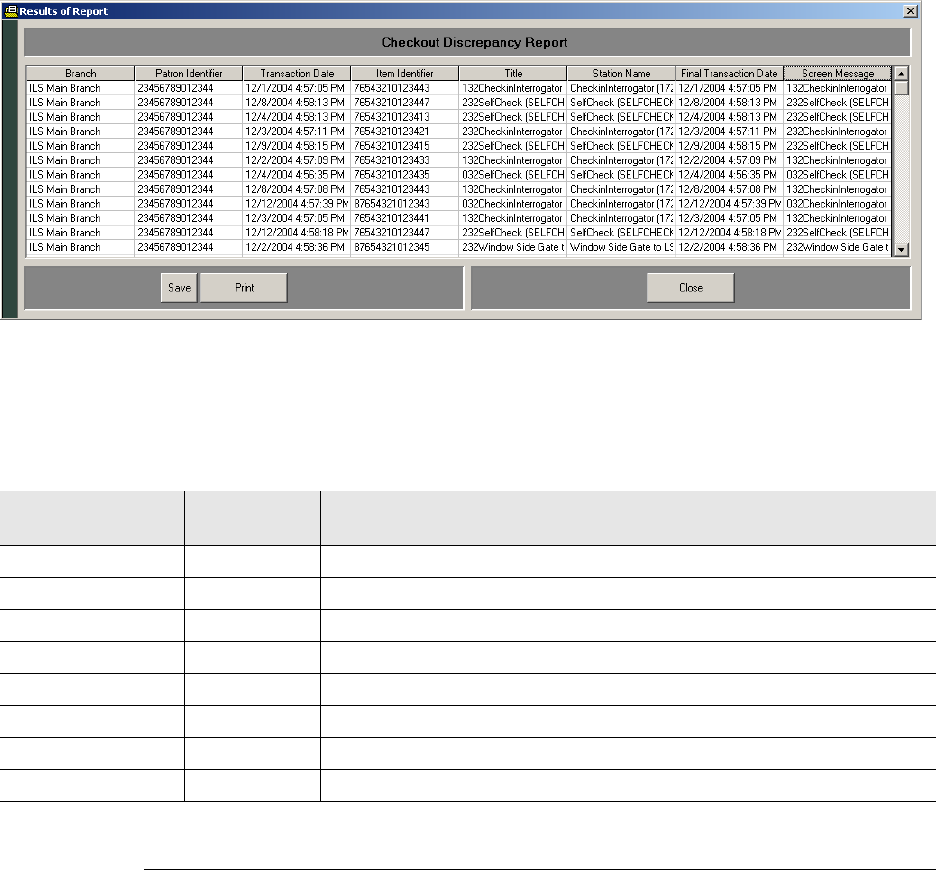
Application Server: Generating Reports 2-15
5Click Generate Report. The report displays.
Figure 2.20
Sample Checkout Discrepancy Report
6Resolve any discrepancies using the Library Management System.
Patron Discrepancy Report
Use this report only if your site allows off-line processing. This report lists off-line patron
status events that were rejected by the LMS after it returned to on-line processing. Before
you can successfully generate this report, you must use the Offline Synchronize function
(see “Synchronize Offline Transactions” on page 13-3) to move off-line transactions into
the transaction database.
To generate the Patron Discrepancy Report:
1When the LMS returns to an on-line state, use the Offline Synchronize function (see
“Synchronize Offline Transactions” on page 13-3) to move off-line transactions into
the transaction database.
The Checkout Discrepancy Report contains the following fields.
Table 2.1
Checkout Discrepancy Report Field Names and Data Description
Field Name Possible
Field Data Data Description
Branch Name of branch The branch at which the discrepancy occurred.
Patron Identifier ID Number The patron ID number in this transaction.
Transaction Date Date/Time Date and time of the transaction.
Item Identifier ID Number The item number in this transaction.
Title Book title Book title.
Station Name Name of Station Station where the transaction occurred.
Final Transaction Date Date/Time The date and time that an off-line incomplete transaction was synchronized.
Screen Message Text Message Message returned from the LMS for this transaction.
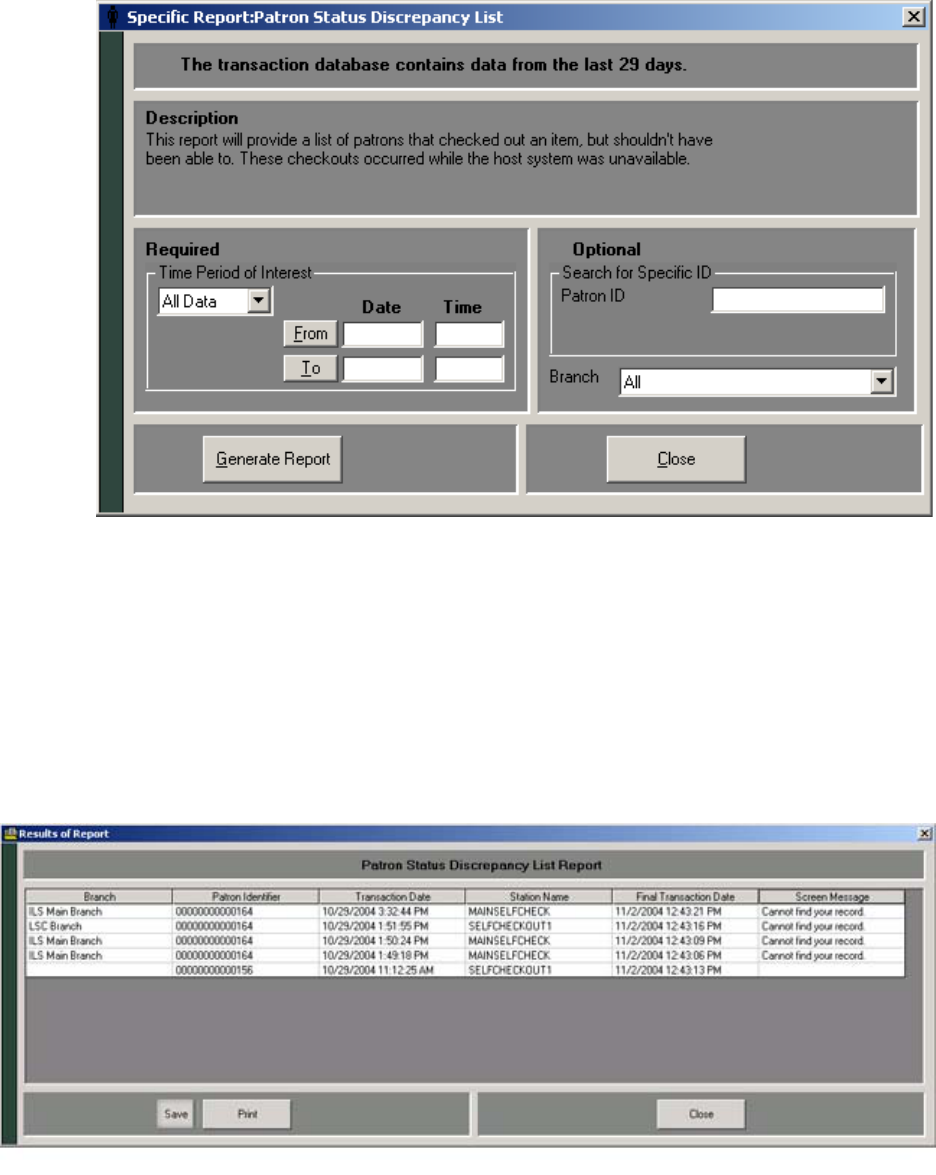
2-16 ILS Open Plus 3.0 Installation Manual
2In the Intelligent Library System Control window, select Reports > Patron Status
Discrepancy, or click the Patron Discrepancy Report button. The Patron Status
Discrepancy window displays:
Figure 2.21
Patron Status Discrepancy List window
3In the Specific Report: Patron Discrepancy List window, enter the time period for
which to run the report. See “Specifying a Time Period for Any Report” on page 2-12
for details on the different ways to enter time criteria.
4If desired, enter the Patron ID for which you are searching.
5If desired, restrict the report to a specific branch by selecting that branch in the Branch
drop-down list box. If selected, you will have the ability to save the report for viewing/
printing in ILS Remote Monitor.
6Click Generate Report. The report displays.
Figure 2.22
Sample Patron Discrepancy Report

Application Server: Generating Reports 2-17
7Resolve any discrepancies using the Library Management System.
The Patron Discrepancy Report contains the following fields.
Table 2.2
Patron Discrepancy Report Field Names and Descriptions
Field Name Possible Field Data Data Description
Branch Name of branch The branch at which the discrepancy occurred.
Patron Identifier ID Number The patron ID number in this transaction.
Transaction Date Date/Time Date and time of the transaction.
Station Name Name of Station Station where the transaction occurred.
Final Transaction Date Date/Time The date and time that an off-line incomplete transaction was synchronized.
Screen Message Text Message Message returned from the LMS for this transaction.
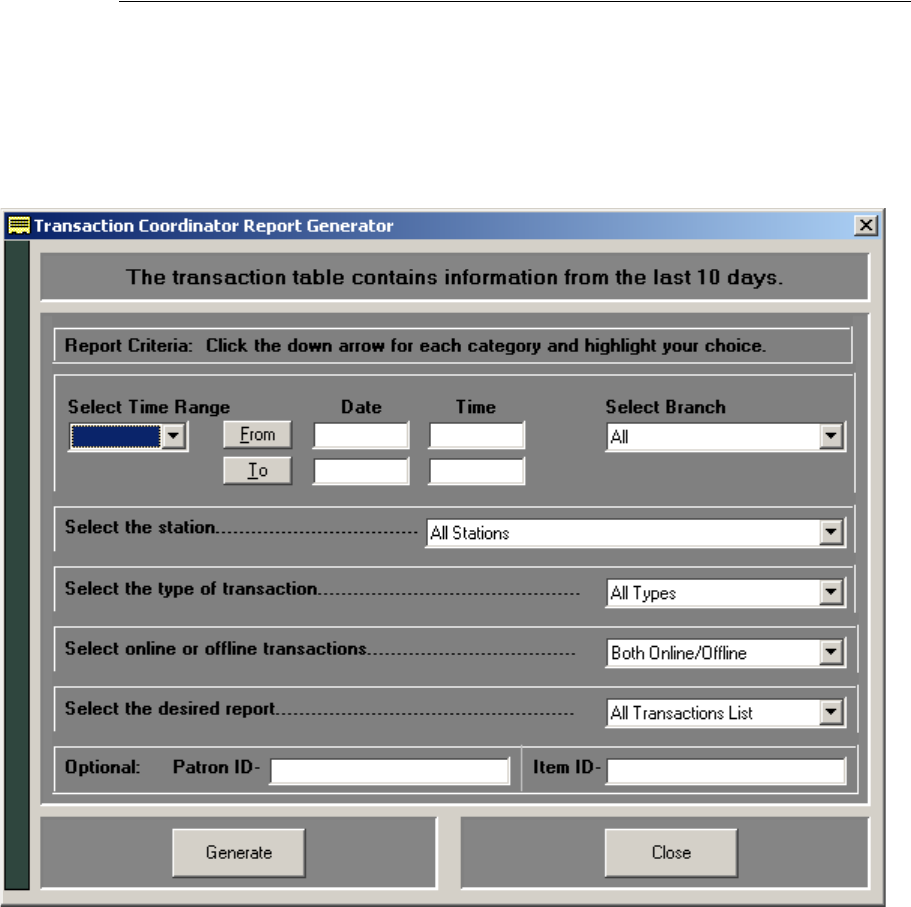
2-18 ILS Open Plus 3.0 Installation Manual
Generic Reports
The Intelligent Library Controller stores all activity, such as patron validation, checkout,
check-in, and exit alarms, as a transaction. You can generate custom reports from these
activities, which list specific transactions and transaction counts.
To generate a Generic Report:
1In the Intelligent Library System Control window, select Reports > Generic Report.
The Generic Report window displays:
Figure 2.23
Generic Report window
2In the Transaction Coordinator Report Generator window, enter the time period for
which to run the report. This is the only required field. See “Specifying a Time Period
for Any Report” on page 2-12 for details on the different ways to enter time criteria.
3In the drop-down lists, select:
aA particular Self-Checkout Station, or keep the default All Stations.
bA particular type of transaction, or keep the default All Types. Choices include:
Check In, Check Out, Patron Status, or Item Information.
cThe type of processing, or keep the default Both Online/Offline.
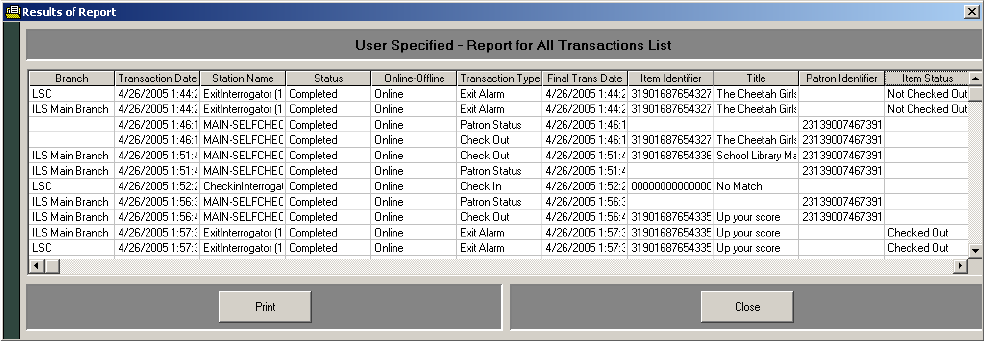
Application Server: Generating Reports 2-19
dThe type of report to generate (list or count), or keep the default All Transactions
List. Choices include: All Transactions Count, Discrepancy Count, Discrepancy
List, Failed Transaction Count, Failed Transaction List, Successful Transaction
Count, and Successful Transaction List.
4If desired, enter the Patron ID for which you are searching.
5If desired, enter the Item ID for which you are searching.
6If desired, restrict the report to a specific branch by selecting that branch in the Branch
drop-down list box. If selected, you will have the ability to save the report for viewing/
printing in ILS Remote Monitor.
7Click Generate. The report displays.
Figure 2.24
Sample Generic Report
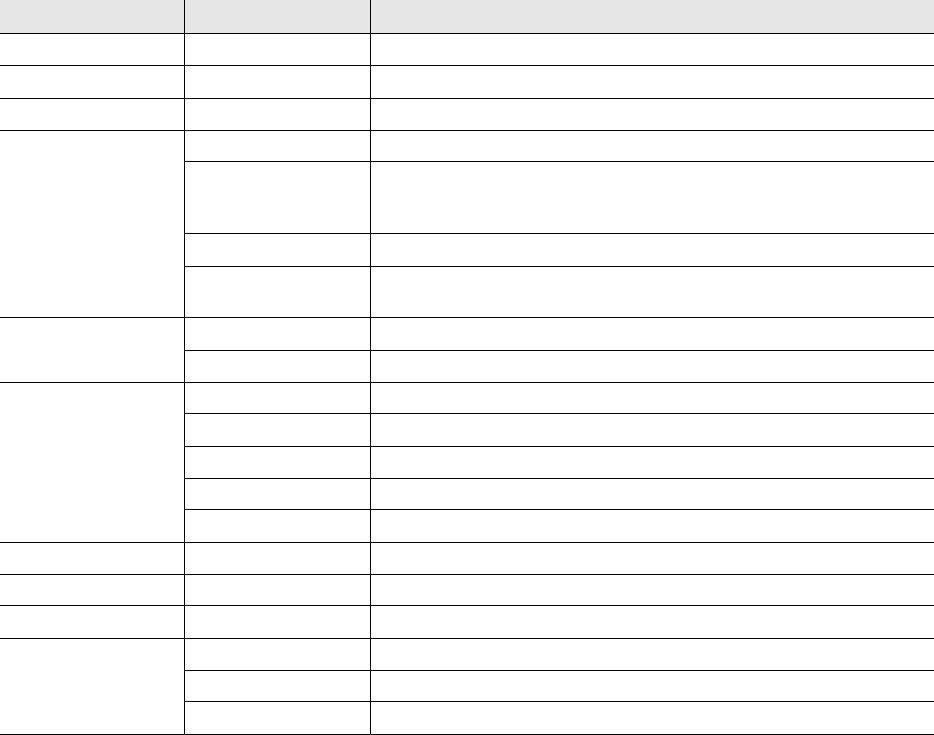
2-20 ILS Open Plus 3.0 Installation Manual
The Generic Report contains the following fields.
8You can view the reports on the screen, print them, or return to the previous screen.
Table 2.3
User Specified - Report for All Transaction List Field Names and Descriptions
Field Name Possible Field Data Data Description
Branch Branch Name of the branch.
Transaction date Date/Time Date and time of the transaction.
Station Name Name of Interrogator Name of the interrogator where the transaction occurred.
Status Completed The transaction was successfully completed on-line.
Offline-Complete The transaction was an off-line incomplete transaction that was
subsequently successfully completed online during off-line
synchronization.
Offline-Incomplete The transaction was not completed on-line.
Discrepancy The transaction was an off-line incomplete transaction that was
subsequently rejected during off-line synchronization.
OffLine-OnLine Offline Transaction completed off-line.
Online Transaction completed on-line to the LMS.
Transaction Type Patron Status Patron scans their ID card at a Patron Self-Checkout Station.
Checkin An item automatically checked in to the LMS.
Checkout An item is scanned at the Patron Self-Checkout Station.
ItemStatus An item is scanned at the circulation desk.
ExitAlarm An item generated an alarm at an exit because it was not checked out.
Final Transaction Date Date/Time The date and time that an off-line incomplete transaction was synchronized.
Item Identifier ID Number The item number in this transaction.
Patron Identifier ID Number The patron ID numbers in this transaction.
Item Status Checked Out The item is checked out.
Checked In The item is checked in.
Status Unavailable The item’s status is unknown.
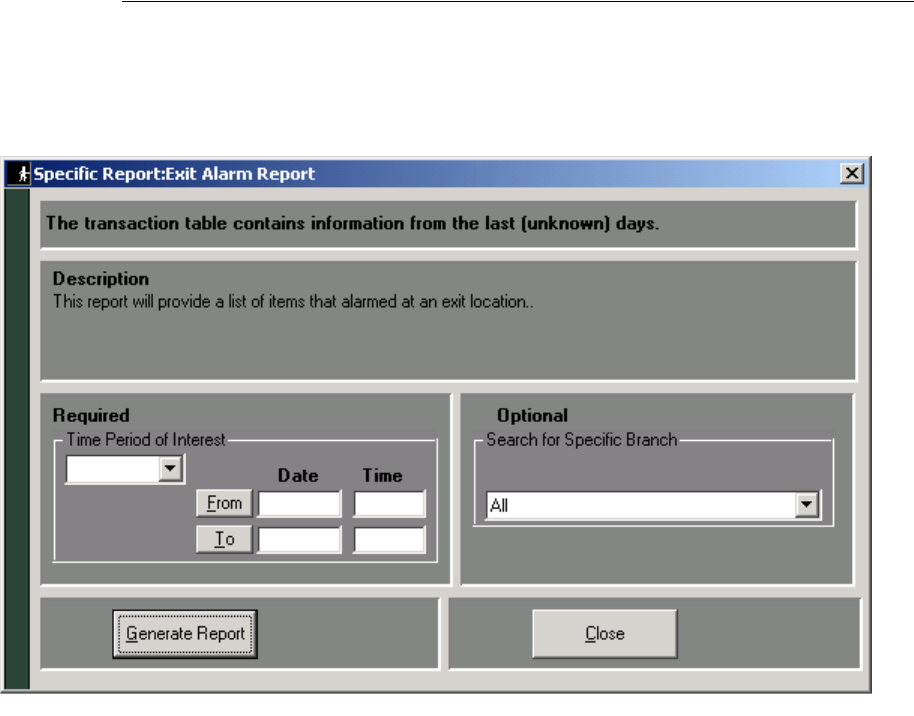
Application Server: Generating Reports 2-21
Exit Alarm Report
This report lists items that caused an alarm at specified exits.
To generate an Exit Alarm Report:
1In the Intelligent Library System Control window, select Reports > Exit Alarm, or
click on the Exit Alarm Report button. The Exit Alarm Report window displays:
Figure 2.25
Exit Alarm Report window
2In the Specific Report: Exit Alarm Report window, enter the time period for which to
run the report. See “Specifying a Time Period for Any Report” on page 2-12 for details
on the different ways to enter time criteria.
3If desired, restrict the report to a specific branch by selecting that branch in the Branch
drop-down list box. If selected, you will have the ability to save the report for viewing/
printing in ILS Remote Monitor.
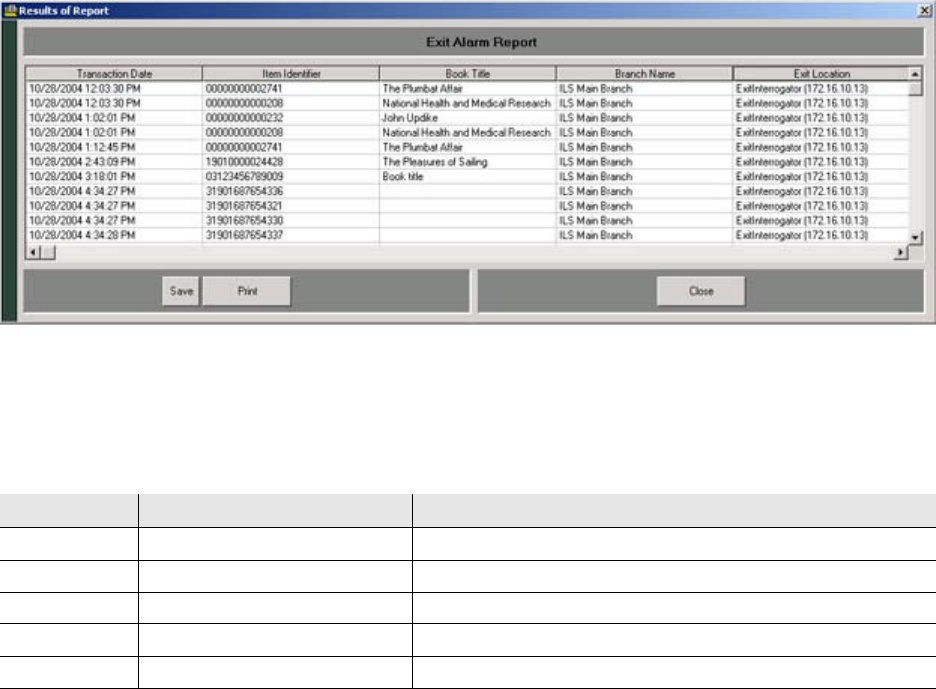
2-22 ILS Open Plus 3.0 Installation Manual
4Click Generate Report. The report displays:
Figure 2.26
Sample Exit Alarm Report
The Generic Report contains the following fields.
Table 2.4
Exit Alarm Report Field Names and Descriptions
Field Name Possible Field Data Data Description
Transaction date Date/Time Date and time of transaction
Item Identifier ID Number The item number in this transaction
Book Title Book title Name of the book.
Branch Name of branch The branch at which the discrepancy occurred.
Exit Location Name of the exit and/or IP Address Name of the exit
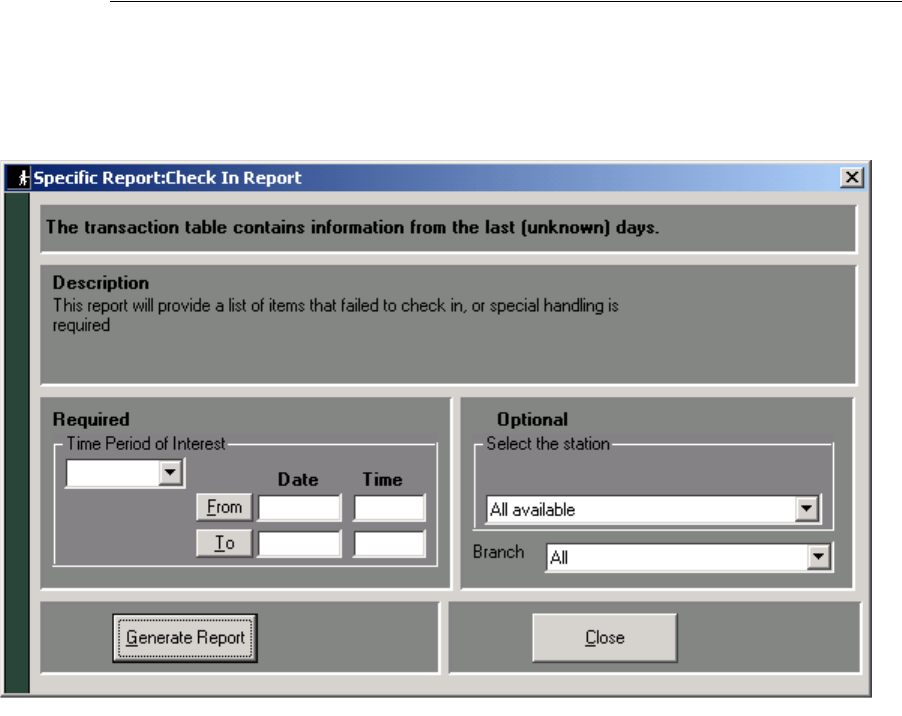
Application Server: Generating Reports 2-23
Check In Report
This report lists items that failed to check-in or that require special handling.
To generate the Check In Report:
1In the Intelligent Library System Control window, select Reports > Check In. The
Check In Report window displays:
Figure 2.27
Check In Report window
2In the Specific Report: Check In Report window, enter the time period for which to
run the report. See “Specifying a Time Period for Any Report” on page 2-12 for details
on the different ways to enter time criteria.
3If desired, select a particular check-in station, or keep the default All available.
4If desired, restrict the report to a specific branch by selecting that branch in the Branch
drop-down list box. If selected, you will have the ability to save the report for viewing/
printing in ILS Remote Monitor.
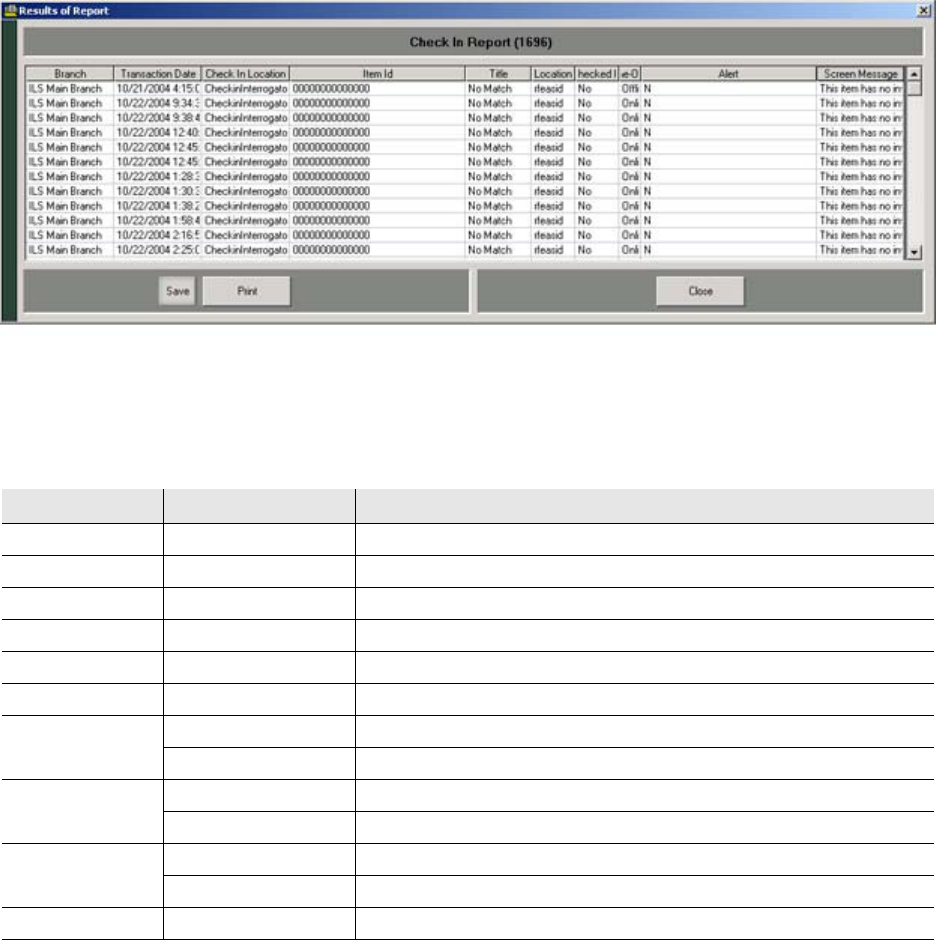
2-24 ILS Open Plus 3.0 Installation Manual
5Click Generate Report. The report displays:
Figure 2.28
Sample Check In Report
The Check In Report contains the following fields.
Table 2.5
Check In Report Field Names and Descriptions
Field Name Possible Field Data Data Description
Branch Name of branch Name of branch at which check-in occurred
Transaction Date Date/Time Date and time of the transaction.
Check-in Location Name of location Location of the check-in station.
Item ID ID Number The item identifier number in this transaction.
Title Item title Title of the item checked-in.
Location Name of location Location of check-in.
Checked-In Y Item was checked in
N Item was not checked-in.
OFFLine-Online OffLine Transaction completed off-line.
OnLine Transaction completed on-line to the LMS.
Alert Y An exit alarm was issued.
N An exit alarm was not issued.
Screen Message Text of Message The specific error message received from the LMS for this transaction.
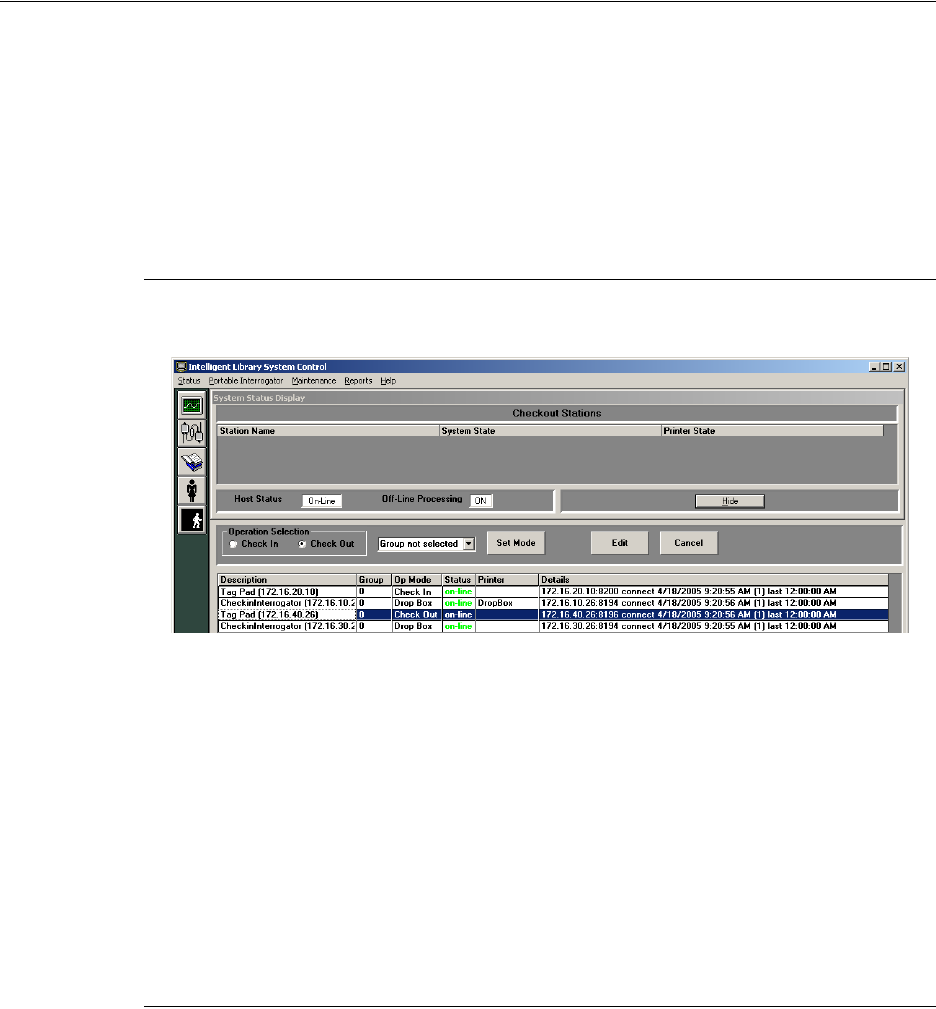
Application Server: Working with the Bridge Interface 2-25
Working with the Bridge Interface
The Bridge Interface allows libraries with non-supported circulation vendors, or no LMS
at all, to use the ILS security and Staff Station reader features. Self-Checkout Stations are
not available when using Bridge mode.
You can change the operation mode of the Staff Station Readers programmed as a tag pad
to either check-in or checkout materials during normal operations. You can also group
individual tag pads together so that you can quickly change a group to either check-in or
checkout personalities.
Changing the Op Mode of a Staff Station Reader
In Bridge mode, you can change the function of the Staff Station Reader to become either
a check-in or checkout device.
Figure 2.29
Bridge Mode
1On the Intelligent Library Controller in the Interrogator Status area, select a Staff
Station Reader. The description should indicate if the device is a Staff Station Reader
(tag pad).
2In the Operation Selection field, select either Check In or Check Out, as desired.
3Click Set Mode. The Staff Station Reader highlighted changes its Op Mode, from
either Check In to Check Out or vice versa, which you verify in the Op Mode column.
4Click Save to save your changes.
5Repeat the procedure to change the personality back.
Creating Staff Station Reader Groups
Staff Station Readers can be grouped together so that you can quickly change the
personality for a group of Staff Station Readers to either check-in or checkout.
1On the Intelligent Library Controller in the Interrogator Status area, select a Staff
Station Reader.
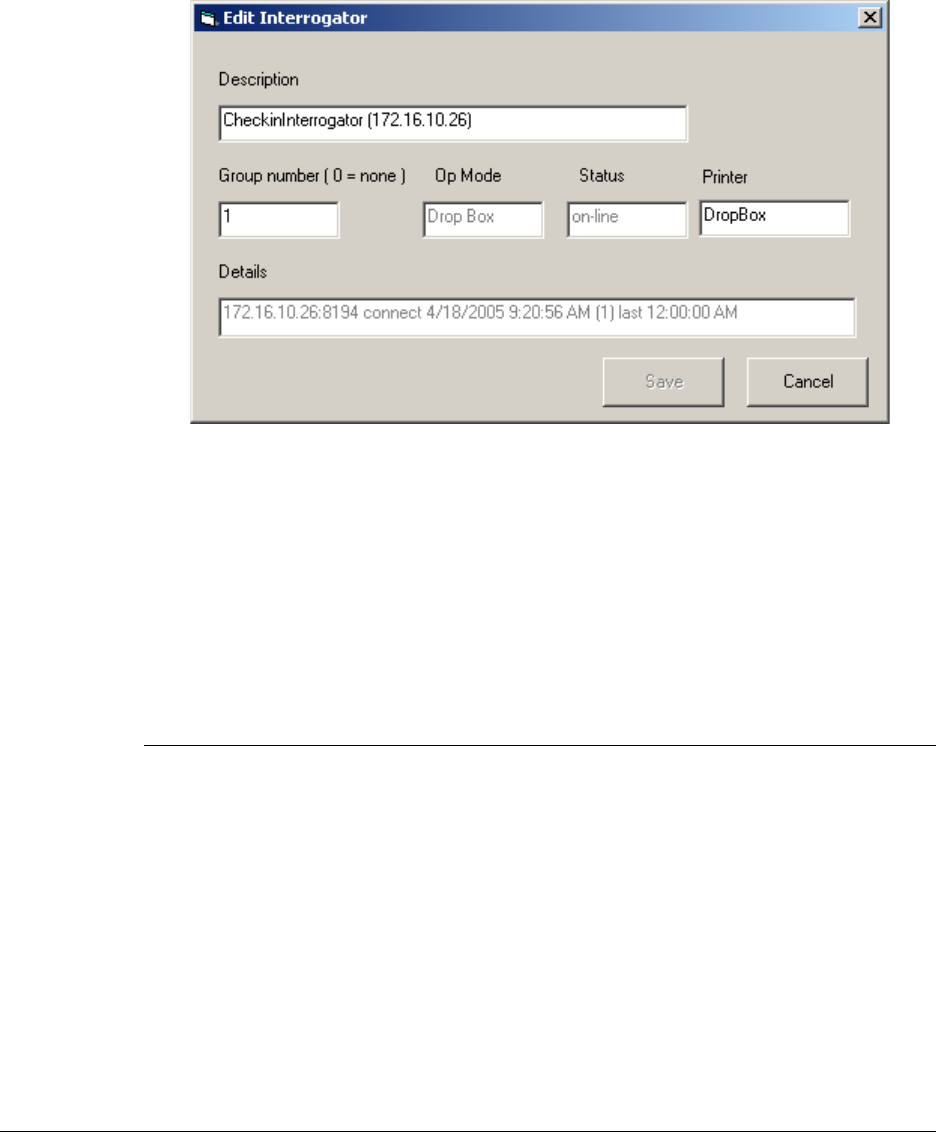
2-26 ILS Open Plus 3.0 Installation Manual
2Click Edit. The Edit Interrogator window displays.
Figure 2.30
Edit Interrogator Window
3Type a Group number in the Group number dialog box.
4Click Save.
5Close the window using the top right-hand corner X.
6Click Save on the main window to save your changes.
7Repeat step 2 through step 6 for each Staff Station Reader you wish to assign to a
group. You can create multiple groups.
Changing the Op Mode of Multiple Staff Station Readers
Once you have assigned multiple Staff Station Readers to a group number (accomplished
at “Creating Staff Station Reader Groups”), you can now alter the check-in or checkout
personality of a group with one operation.
1On the Intelligent Library Controller in the Operation Selection area, select the
function desired, either Check In or Check Out.
2From the drop-down menu next to Operation Selection, select the Group number
desired, for example all Staff Station Readers in Group 1.
3Click Set Mode. All the Staff Station Readers in Group 1 change to reflect the new
check-in or checkout personality selected.
4Click Save to save your changes.
Maintenance
See “Intelligent Library Controller System Maintenance” on page 13-1 for information on
maintaining the Application Server.
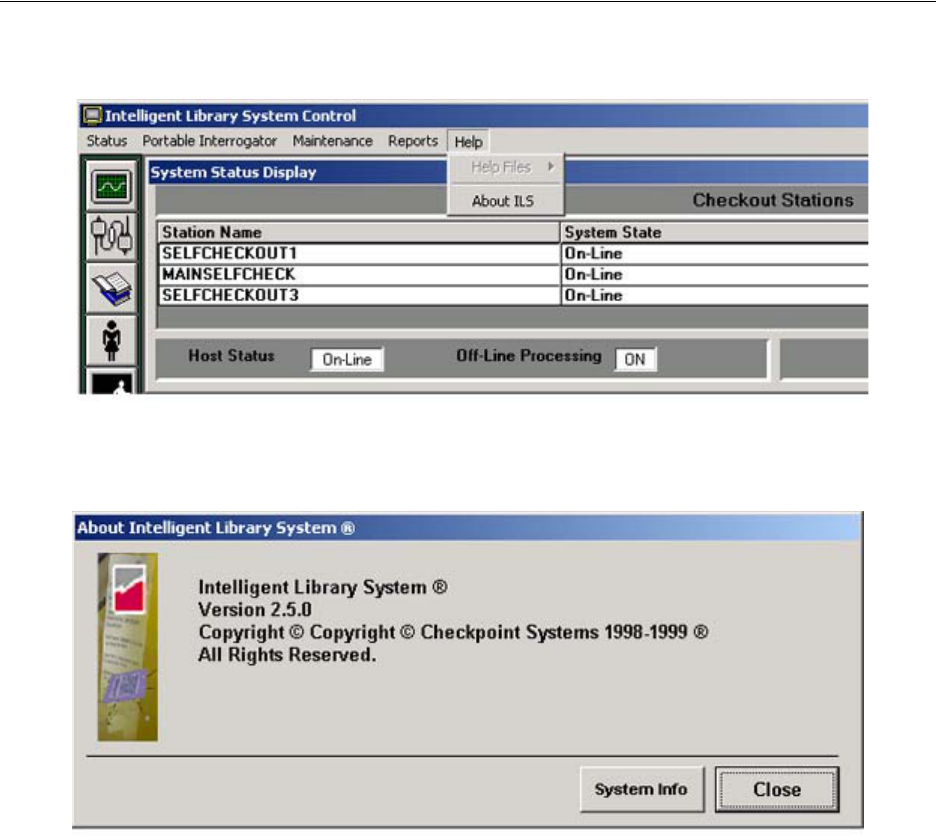
Application Server: Display System Information 2-27
Display System Information
To display copyright and version information about ILS:
1In the Intelligent Library System Control window, select Help > About ILS.
Figure 2.31
Help About Navigation
2Click System Info to see a detailed listing of all components and their versions.
Figure 2.32
Help About ILS window
2-28 ILS Open Plus 3.0 Installation Manual
Notes

Patron Self-Checkout Station: Overview 3-1
CHAPTER
C
HAPTER
0
P
ATRON
S
ELF
-C
HECKOUT
S
TATION
The Self-Checkout Station enables library patrons to check out library materials without
the assistance of library staff. The Self-Checkout Station guides patrons smoothly through
the checkout process with step-by-step instructions to assist in checking out materials
properly. The process is quick, efficient, and (if available) delivers a printed receipt listing
the checked out materials and their due dates.
The Self-Checkout Station delivers data, item identification and its checkout status, to the
Library Management System, which processes the information and updates the library
records. The processing occurs almost instantaneously, allowing a speedy and efficient
checkout.
Note: The Self-Checkout Station is the same as the CheckStation II.
Overview
There are three steps to checking out library material:
•“Presenting a Patron ID Card, Step 1” - Identify yourself with your library card
•“Scanning Items for Checkout, Step 2” - Check out materials
•“Finishing Checkout, Step 3” - Finish and collect your receipt (if available)
The windows on the Self-Checkout Station reflect this order, showing Step 1, Step 2, and
Step 3, identifying the checkout process.
The following pages details the process a patron uses to check out library material.
Note: The sample windows shown in this chapter may differ slightly than the windows shown on your
library’s Self-Checkout Station. Your library may have a different Self-Checkout Station model,
operating environment, welcome logo, or other windows.
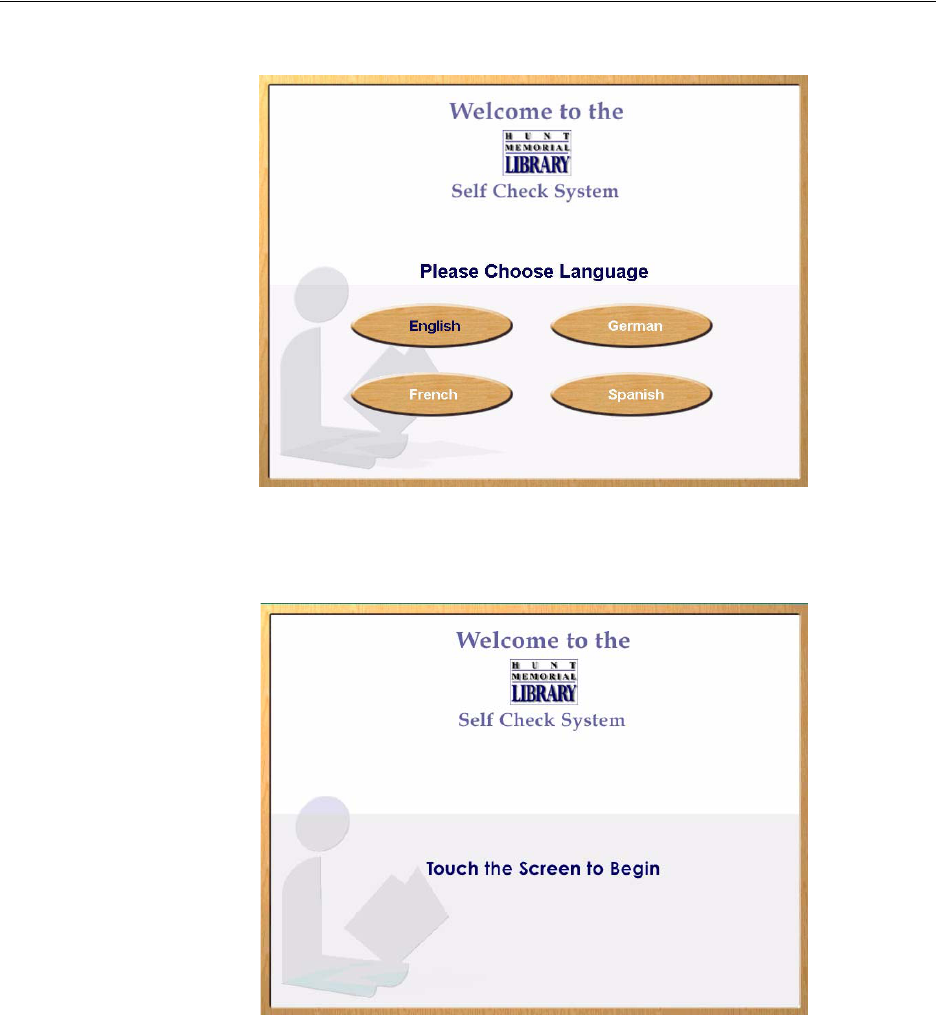
3-2 ILS Open Plus 3.0 Installation Manual
Beginning a Self-Checkout Station Session
If the Self-Checkout Station is configured to use multiple languages, the first window
shown is the ILS multiple language welcome window.
Figure 3.1
ILS Multiple Language Welcome window
If configured to use a single language, the first window shown is the ILS single language
welcome window.
Figure 3.2
ILS Single Language Welcome window
1Touch the screen or select a language to begin the checkout process.
•Some libraries support multiple institutions. If so, you are presented with a multiple
institution selection window in which you select the correct institution.
2After you have removed your finger, the image changes to the Patron Identification
window.
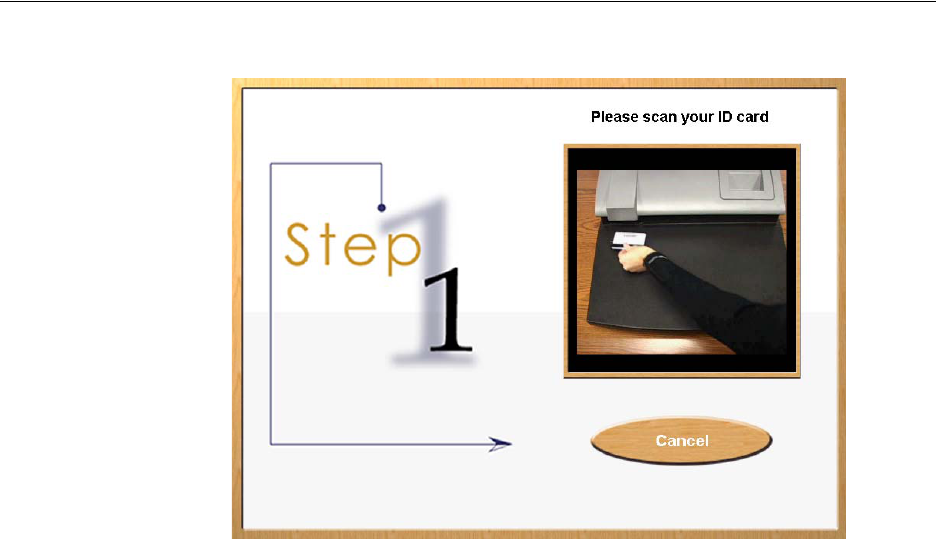
Patron Self-Checkout Station: Presenting a Patron ID Card, Step 1 3-3
Presenting a Patron ID Card, Step 1
Have your patron ID card ready and follow the instructions shown on the window, seen
here.
Figure 3.3
Patron Identification window
1On the right side of the window, you are given visual instructions on how to present
your patron ID card for authorization. Your ID card may be different than the type of
ID card illustrated in the sample Patron Identification window; if so, simply follow the
visual instructions on the Patron Identification window specific to your institution.
2If you have been authorized to check out items, the Item Entry window is displayed.
3If your site uses the optional CheckPASS feature that allows library patrons to pay
library fees at a Self-Checkout Station, and if you owe fees to the library, you are
prohibited from checking out library material until the fee is paid. See “CheckPASS”
on page 11-1 for details.
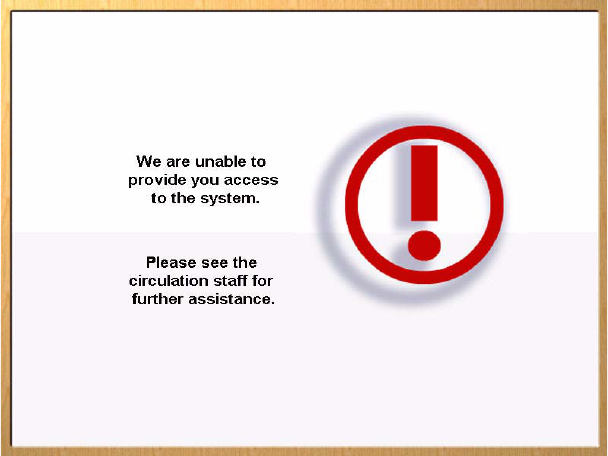
3-4 ILS Open Plus 3.0 Installation Manual
4If you have not been authorized, the Patron Identification Failure window appears.
Figure 3.4
Patron Identification Failure window
Contact the librarian desk for further assistance. After a short period the Welcome window
is displayed again allowing normal checkout procedure.
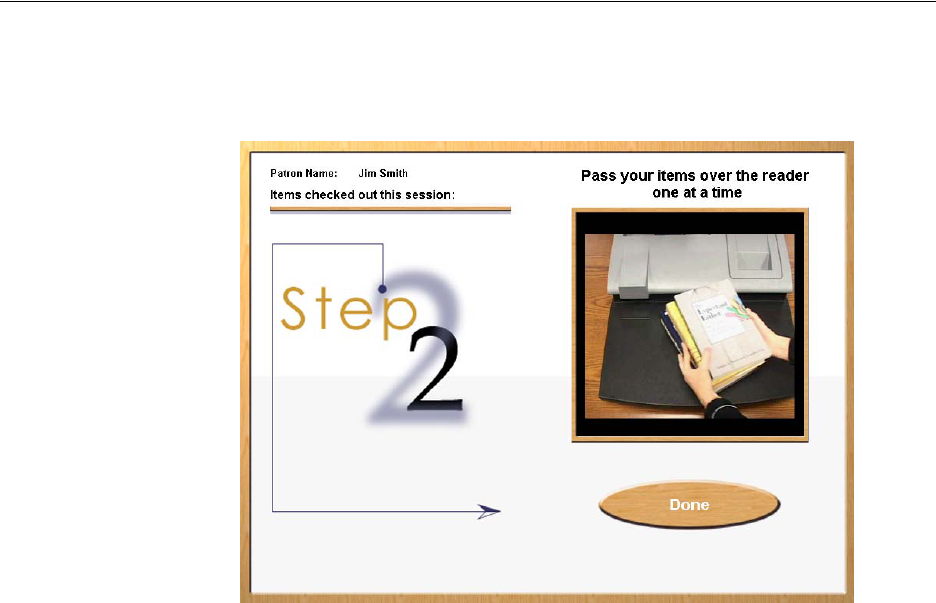
Patron Self-Checkout Station: Scanning Items for Checkout, Step 2 3-5
Scanning Items for Checkout, Step 2
Once authorized for checkout, the window advances and instructions appear on how to
check out each item. On the left side of the window, the patron’s name displays at the top.
Once you have checked out items, a list of those items displays as shown in the Items
Identification window - Item List shown below.
Figure 3.5
Item Identification window - Begin
1Take one (or more) of the items you wish to check out and slowly pass it over the
surface area of the item identification pad. You do not need to slide it on the pad in
order for the item to be identified. Simply move the item over the pad in a smooth
fashion, about 4 inches (10 cm) above the pad area.
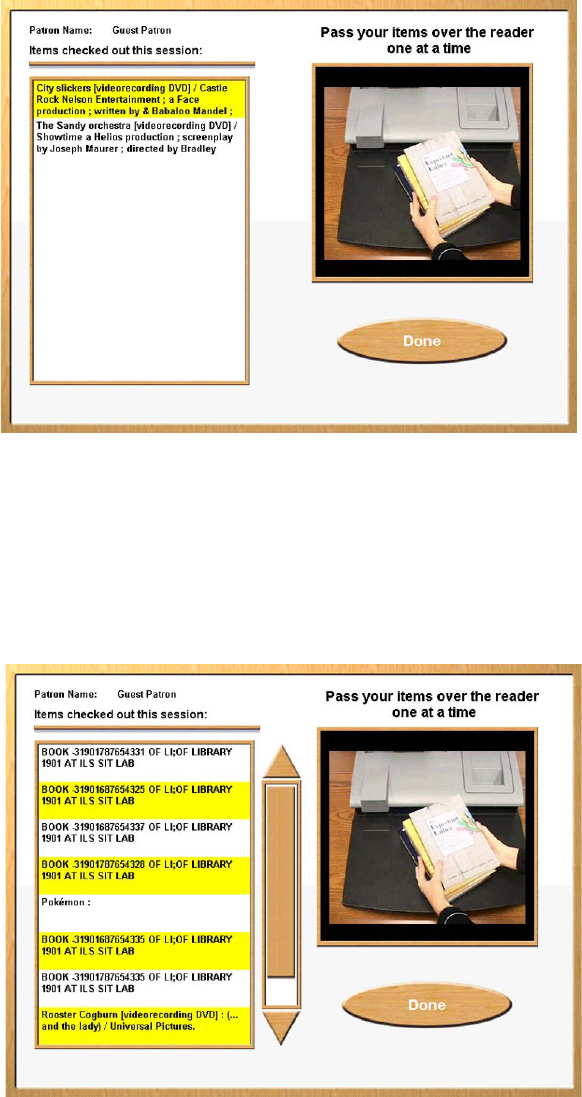
3-6 ILS Open Plus 3.0 Installation Manual
2Repeat the above step for each item you want to check out. As you pass the item over
the pad, the system identifies each item and lists it on the left side of the window. Some
institutions may provide additional information along with the item name.
Figure 3.6
Items Identification window - Item List
At anytime in the checkout process you may touch Done to complete your checkout
session. The Done button is on the right bottom of the window.
If you have checked out more items than can display on the window, the list
automatically scrolls to show the most recent items at the top of the list. To see items
that have already scrolled off the bottom of the list, touch the Down Arrow. Press the
Up Arrow to see the most recent items checked out.
Figure 3.7
Items Identification window - Scroll
3Press Done to end your session.
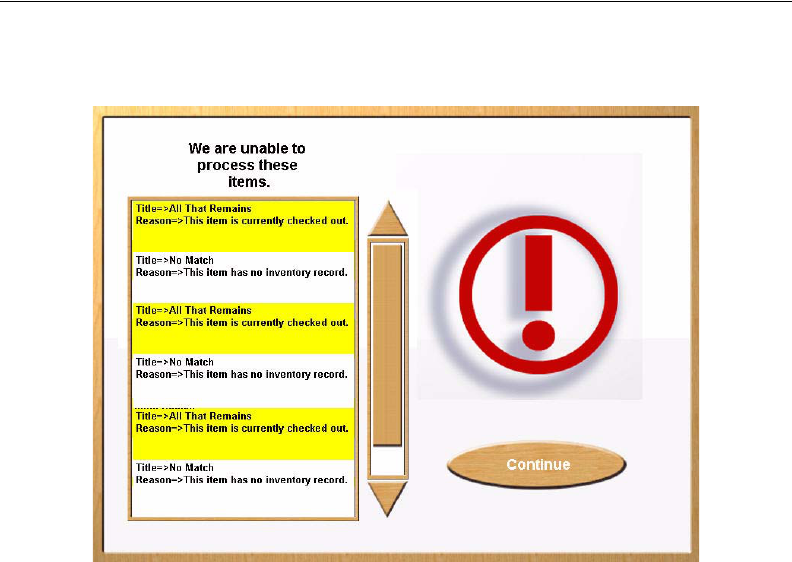
Patron Self-Checkout Station: Scanning Items for Checkout, Step 2 3-7
Viewing Items that Could Not be Checked Out
If any item you tried to check out is not accepted, a message appears indicating the system
was unable to process the item. Listed are the title (if available) of the item and the reason
for denied access. If the title is not available, No Match appears next to Title.
Figure 3.8
Item Identification window - Failure
If numerous items have been rejected so that all cannot be fully displayed on the left, a
scroll bar appears to the right of the list. To see items that have already scrolled off the
bottom of the list, touch the Down Arrow. Press the Up Arrow to see the most recent
items.
Contact your librarian for assistance with items that were not successfully checked out.
You may continue with the check out of additional items by returning to the Item
Identification window.
Press Continue to continue your session.
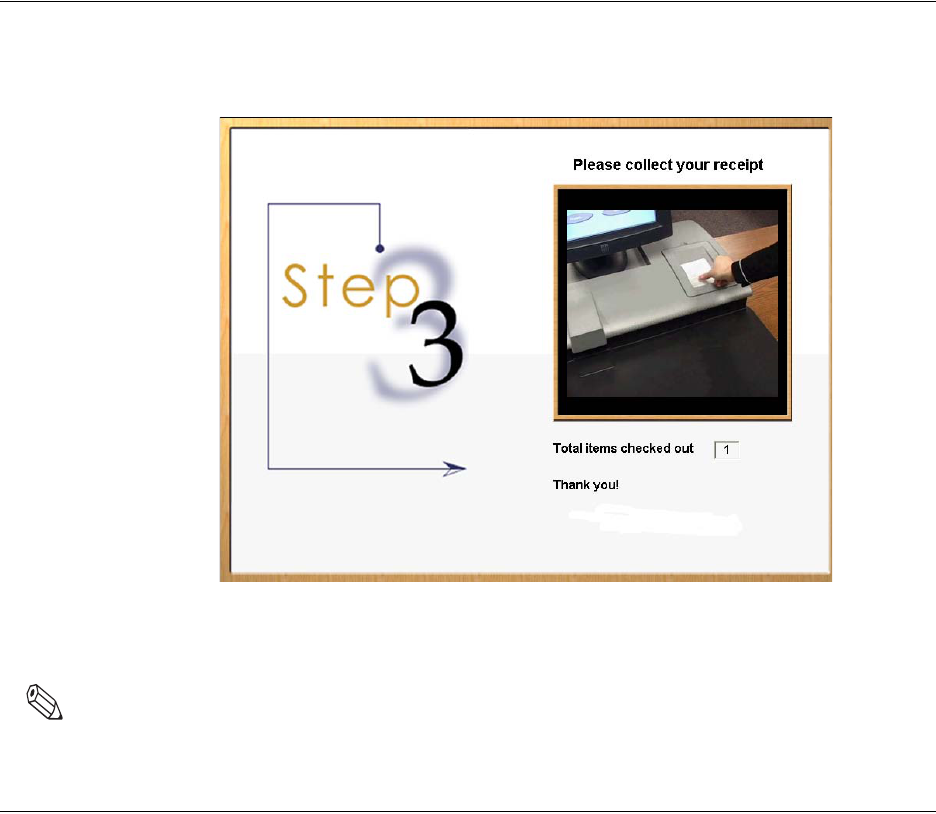
3-8 ILS Open Plus 3.0 Installation Manual
Finishing Checkout, Step 3
The Step 3 window displays when you have finished checking out all your items and
touched Done. The window instructs you to collect your printed receipt and shows you the
total number of items checked out.
Figure 3.9
End Session window
Collect the printed receipt from the receipt dispenser. Your receipt lists the items you have
checked out as well as the return due date for each item.
Note: Some institutions may not provide a printed receipt.
Loading Roll Paper
When the paper runs low or out, follow these directions for replacing the roll paper for the
Self-Checkout Station’s printer.
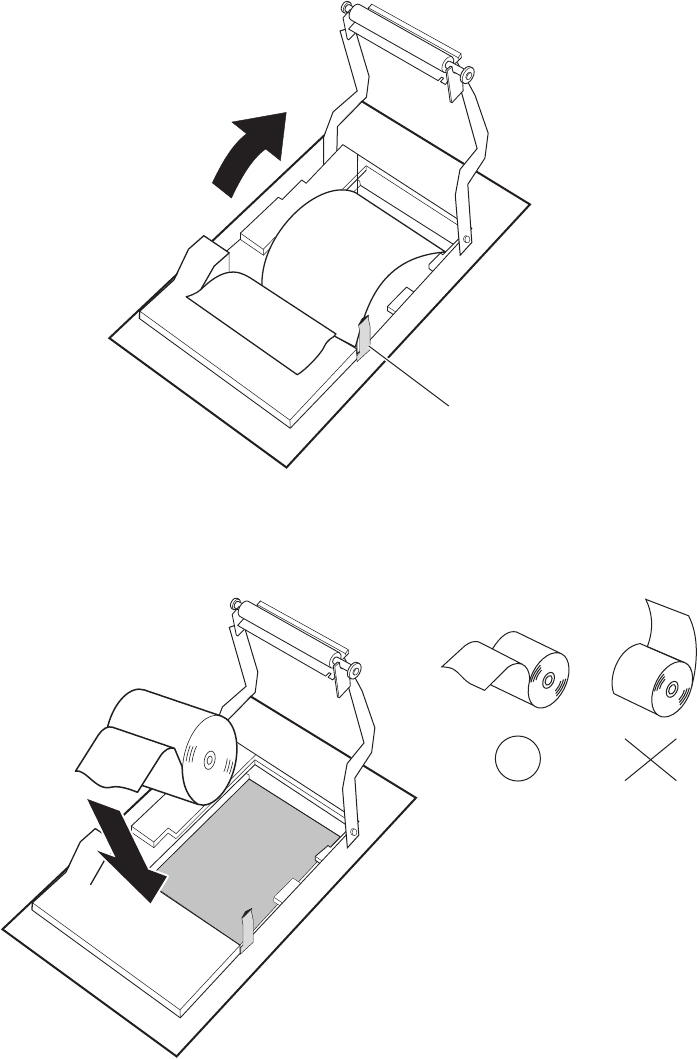
Patron Self-Checkout Station: Loading Roll Paper 3-9
1Remove the printer cover on the Self-Checkout Station.
Figure 3.10
Paper Roll Release
2Press the paper roll release lever to the front of the unit and swing the paper guide up
and away from the printer.
Figure 3.11
Insert Paper
3Remove the empty roll and lower in the new roll, with the paper facing the correct
direction.
Paper Roll
Release Lever
Insert paper in
this direction. Do not insert paper
in this direction.
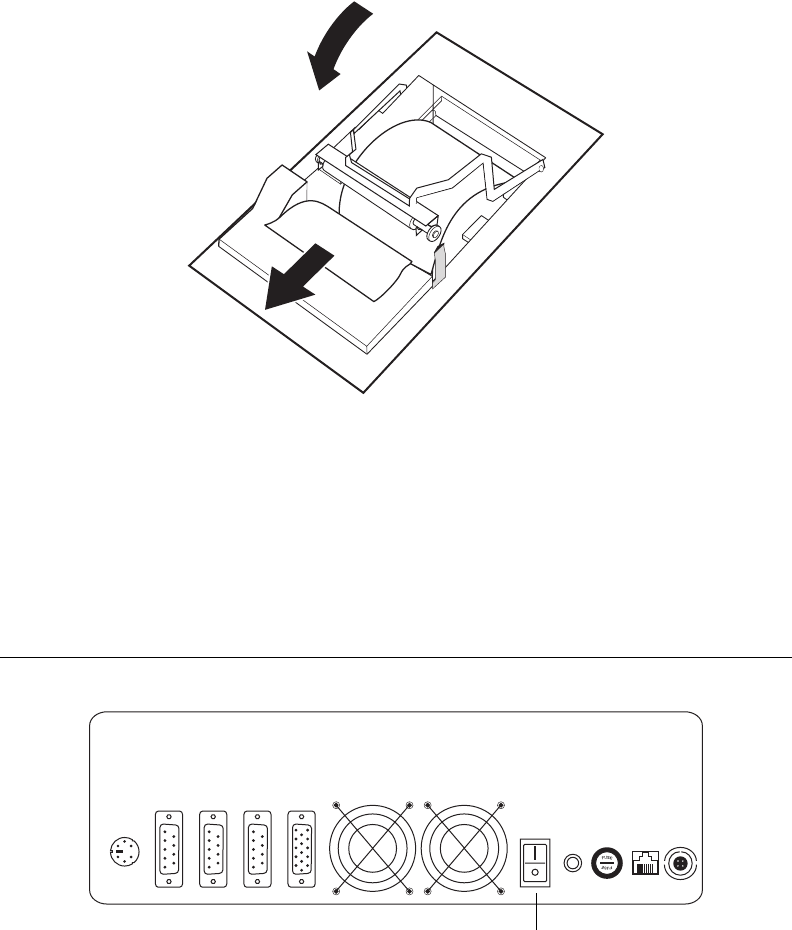
3-10 ILS Open Plus 3.0 Installation Manual
4Pull the paper out a bit, as seen below in Figure 3.12, “Lower the Paper Guide.”
Figure 3.12
Lower the Paper Guide
5Rotate the paper guide back down until you position the guide in between the main roll
and the paper fed underneath the paper guide.
6Once the paper guide clicks into place, the paper cutter should activate and partially cut
the paper. If not, then reseat the paper guide again. If the cutter still fails to activate,
reboot the Self-Checkout Station and try again.
Powering On the Self-Checkout Station
The following procedure powers on a Self-Checkout Station:
Figure 3.13
Turning On the Self-Checkout Station
1On the back panel of the Self-Checkout Station, flip on the power switch.
2The Self-Checkout Station starts, logs in, and launches the CheckPC program
automatically.
Power On/Off Switch
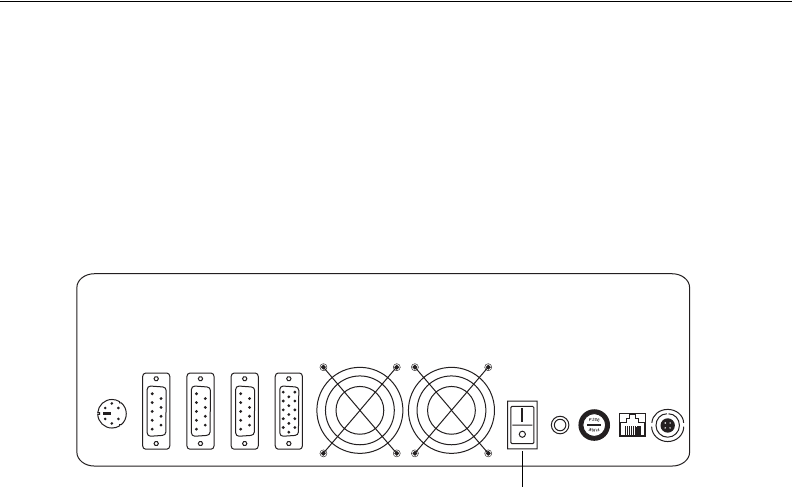
Patron Self-Checkout Station: Loading Roll Paper 3-11
Powering Off the Self-Checkout Station
The following procedure shuts down a Self-Checkout Station using CheckVIEW:
1Launch CheckVIEW on the library staff’s computer by clicking Start > Programs >
Checkpoint Systems > CheckVIEW Monitor from the library staff’s computer.
2Access the specific Self-Checkout Station by selecting View from the menu and then
select one of the Display (1-4) options for the desired Self-Checkout Station.
3On the keyboard, press CTRL + SHIFT + DEL.
4Click Shut down. The Self-Checkout Station enters a shut down sequence until it
states that Self-Checkout Station can be turned off.
Figure 3.14
Turning Off the Self-Checkout Station
5Go to the Self-Checkout Station and turn off the power switch.
Power On/Off Switch
3-12 ILS Open Plus 3.0 Installation Manual
Notes
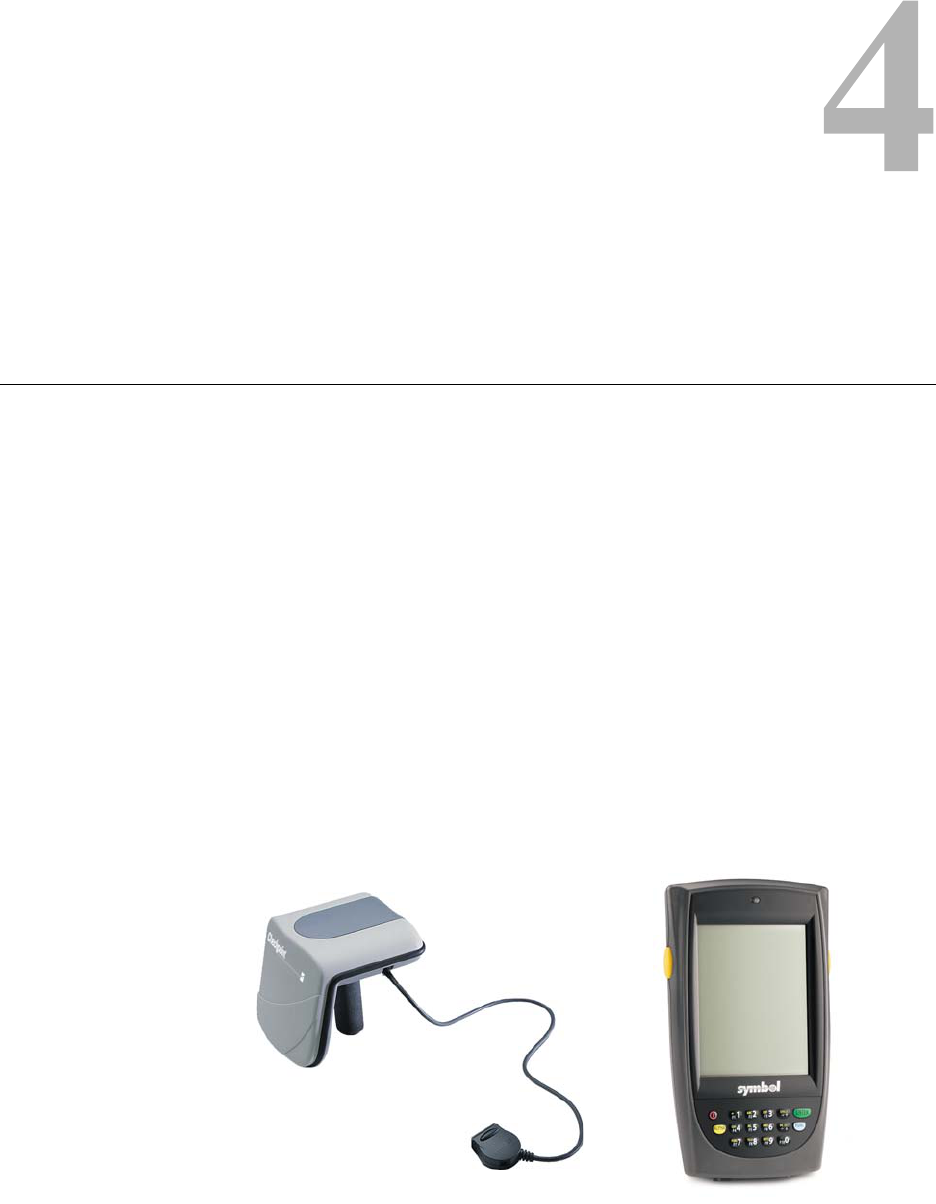
Portable Inventory Reader: Overview 4-1
CHAPTER
C
HAPTER
0
P
ORTABLE
I
NVENTORY
R
EADER
Overview
The Portable Inventory Reader is an easy-to-use wireless long range reader that changes
how library staff take inventory. The Portable Inventory Reader combines convenience
with versatility, using a lightweight, handheld portable data terminal connected to an
extendable inventory wand. This makes it easy to read items in hard-to-reach areas, and,
because of the sophisticated antenna design and electronics, the Portable Inventory Reader
becomes a very long-range reader. This is very useful for taking inventory or trying to
locate materials that have not been shelved properly.
The Portable Inventory Reader consists of two units:
• An inventory wand
• A portable data terminal
The handheld inventory wand, using a built-in antenna to scan for circulation circuits,
connects to a Portable Data Terminal (PDT), which stores the information retrieved from
and accessed by the wand. The PDT enables data to be uploaded or downloaded from the
Intelligent Library Controller, providing both inventory and searching capability.
The Portable Inventory Reader enables a fast, efficient and accurate method for taking
inventory of library materials.
Figure 4.1
Portable Inventory Reader
Inventory Wand
Portable Data Terminal
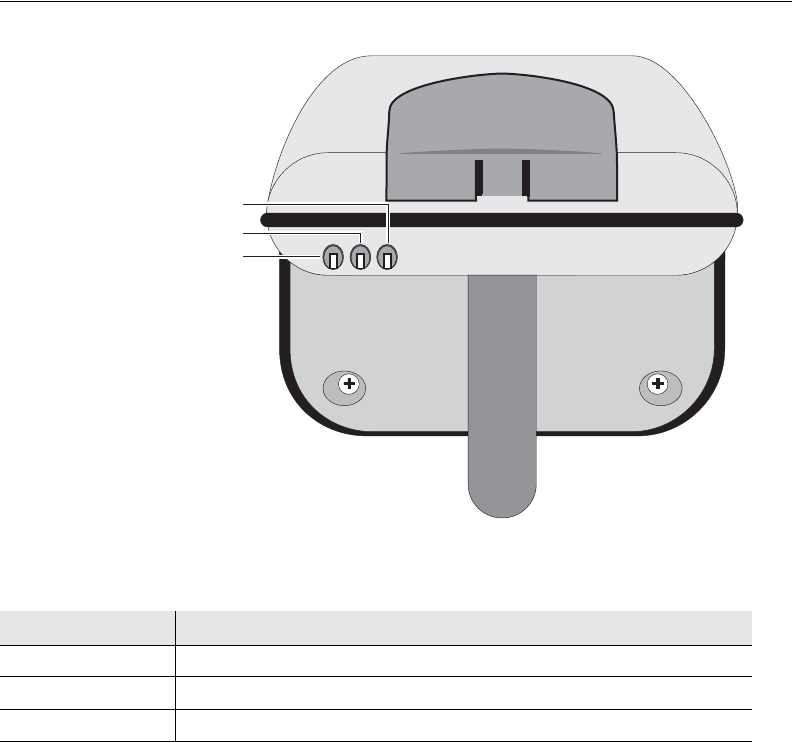
4-2 ILS Open Plus 3.0 Installation Manual
Inventory Wand LED Indicators
The inventory wand uses three LED lights:
Figure 4.2
Wand LED Indicators
Table 4.1
Wand LED Indicators
LED Description
Green The power is on
Red Circulation circuit is being read
Yellow Low battery condition
Green
Red
Yellow
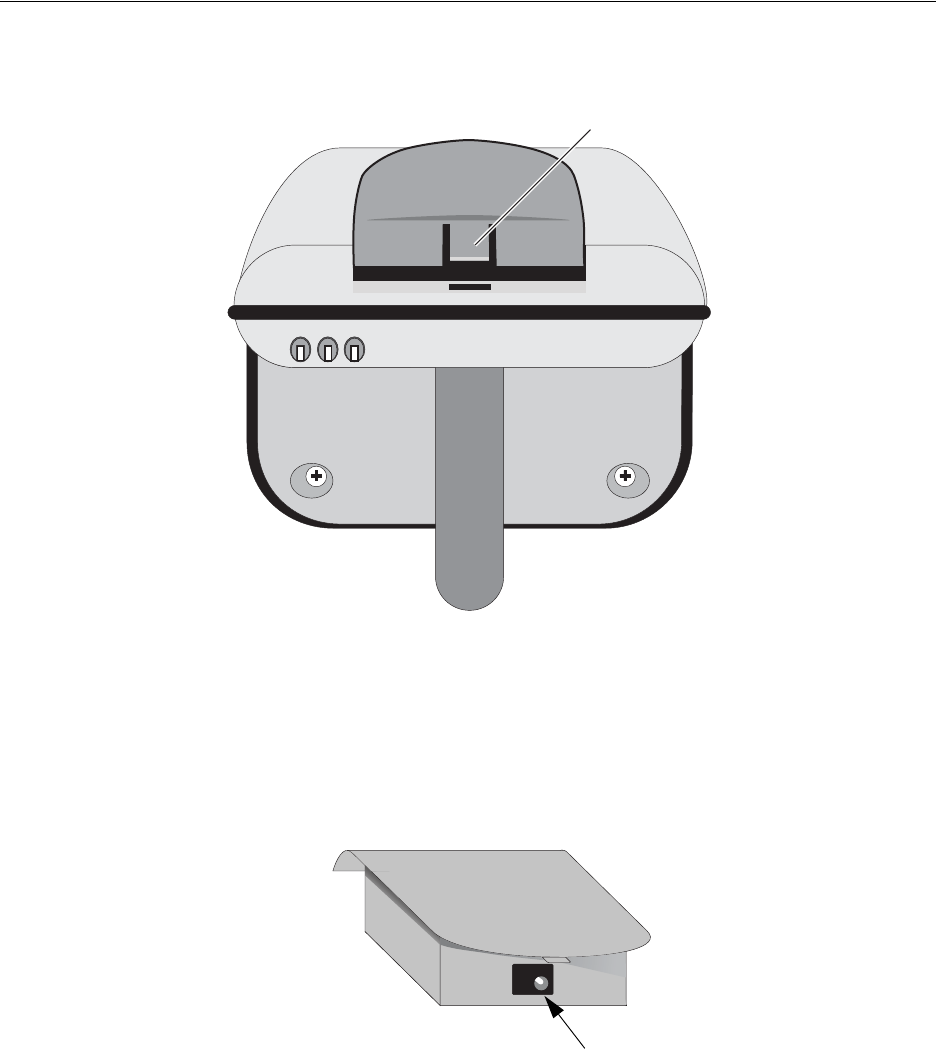
Portable Inventory Reader: Charging the Inventory Wand Battery 4-3
Charging the Inventory Wand Battery
Prior to using the inventory wand for any significant inventory collection or inventory
search session, ensure that its battery is fully charged to guarantee that the entire collection
is inventoried all at once.
Figure 4.3
Extracting Inventory Wand battery
To extract the battery from the inventory wand:
1Rotate the inventory wand so that the antenna is facing away from you as shown in
“Extracting Inventory Wand battery”.
2Press the tab in the middle of the battery and lift it carefully upwards.
3Once disconnected, rotate the battery until you see the power connection jack.
Figure 4.4
Inventory Wand power plug connection
4Using the cable from the battery charger, connect the battery to the battery charger and
plug the adapter into an outlet to begin charging. The estimated charging time is 4 to 6
hours.
Press here and lift
the battery upwards
Connect power
plug here
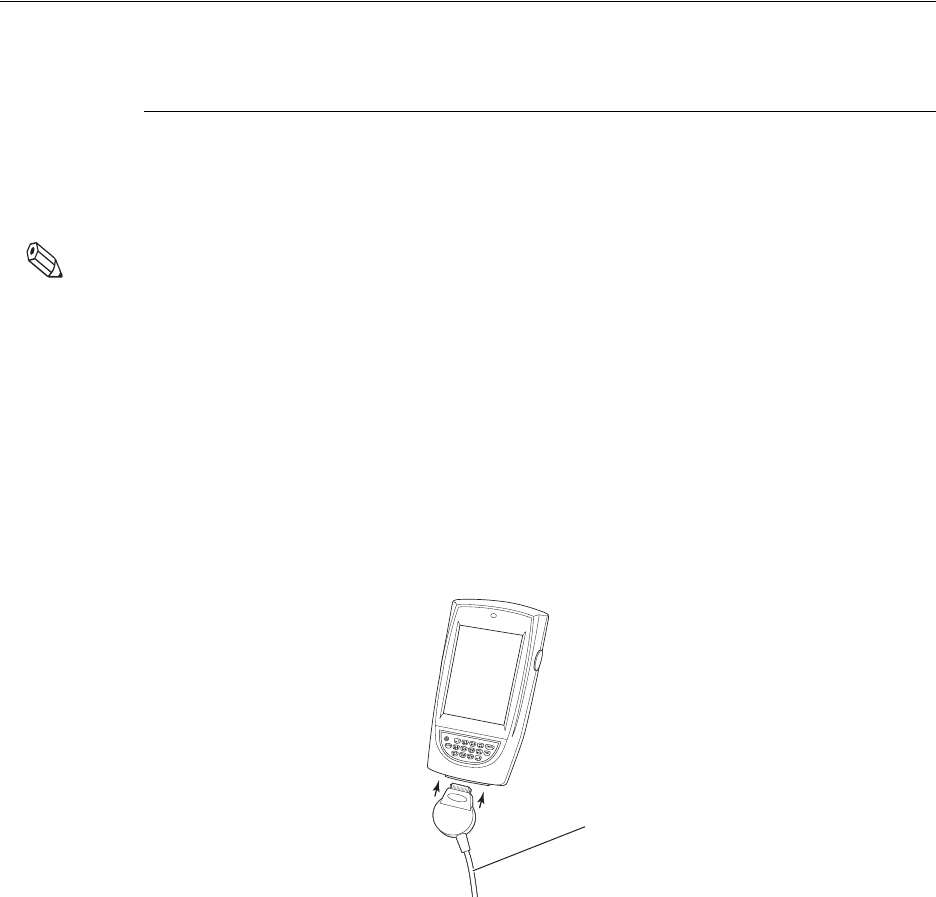
4-4 ILS Open Plus 3.0 Installation Manual
There is an LED indicator on the battery charger that indicates when the battery is
completely charged.
5When charging completes, disconnect the power plug. Insert the front of the battery
(with the tab) first into the wand’s battery receptacle, then rotate the back of battery
down until it clicks into place.
Maintaining the Portable Data Terminal
This section details how to charge and turn on and off the portable data terminal.
Charging the Portable Data Terminal
Before using your terminal for the first time, charge the battery fully using the CRD 2800
cradle or synchronization cable. Your terminal is equipped with a memory backup battery
that automatically charges from the main lithium-ion battery. This backup battery retains
data in memory when the terminal's battery is removed, and takes several hours to charge
when you first use your terminal.
Note: If you remove your lithium-ion battery before the backup battery is fully charged, data may be lost.
For this reason DO NOT remove the battery within the first ten hours of use.
When battery voltage is low, a warning message displays indicating the battery needs to
be charged.
There are two methods to charging the PDT:
1Using the Serial Charging Cable
2Using the Universal Cable Cup
Using the Serial Charging Cable to charge the battery
1Insert the cable into the bottom of the terminal.
Figure 4.5
Insert Synchronization Cable
*
.
Serial Charging
Cable
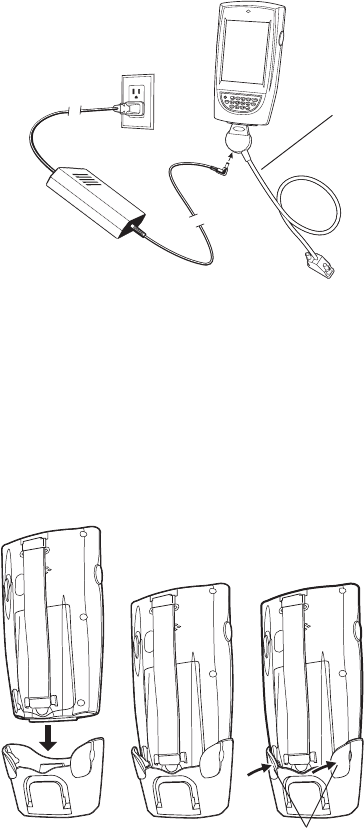
Portable Inventory Reader: Maintaining the Portable Data Terminal 4-5
2Plug the power cable into a wall outlet and plug the other end into the battery charging
receptacle on the side of the synchronization cable.
Figure 4.6
Battery charging with serial charging cable
Using the Universal Cable Cup to charge the battery
To charge the battery using the Universal Cable Cup:
1On the cable cup, ensure the locking tabs are in the open position (up).
2Insert the PDT into the cable cup.
3Press down on the two locking tabs.
Figure 4.7
Insert PDT into cable cup
4Lightly pull on the cable cup to ensure that it is securely attached to the terminal.
*
.
Serial Charging
Cable
Locking Tabs
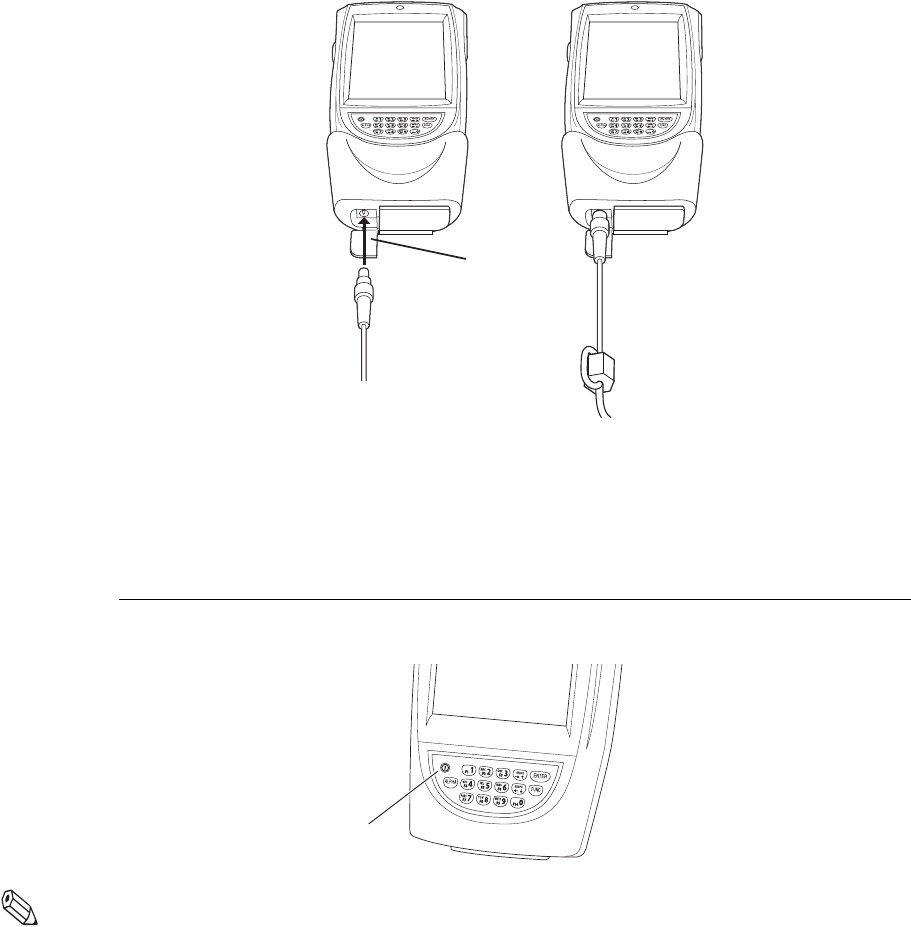
4-6 ILS Open Plus 3.0 Installation Manual
5Open the rubber cap covering the power port.
Figure 4.8
Connecting power cable
6Plug the power connector into the power port. The battery is fully charged after
approximately 2 1/2 hours.
Powering On and Off the Portable Data Terminal
1To turn on the PDT, press the red power button on the lower left-hand side of the
terminal to turn on the unit.
Figure 4.9
Powering On the Portable Data Terminal
Note: When not using the Portable Data Terminal within a set amount of time, the device enters a Power
Save mode, meaning the device powers down. To turn it back on press the red power button. You
are returned to the last window presented prior to shut off.
2To turn off the unit, press and hold the power button until the screen turns grey, then
press the power again.
Rubber Cap
*
.
Power Button
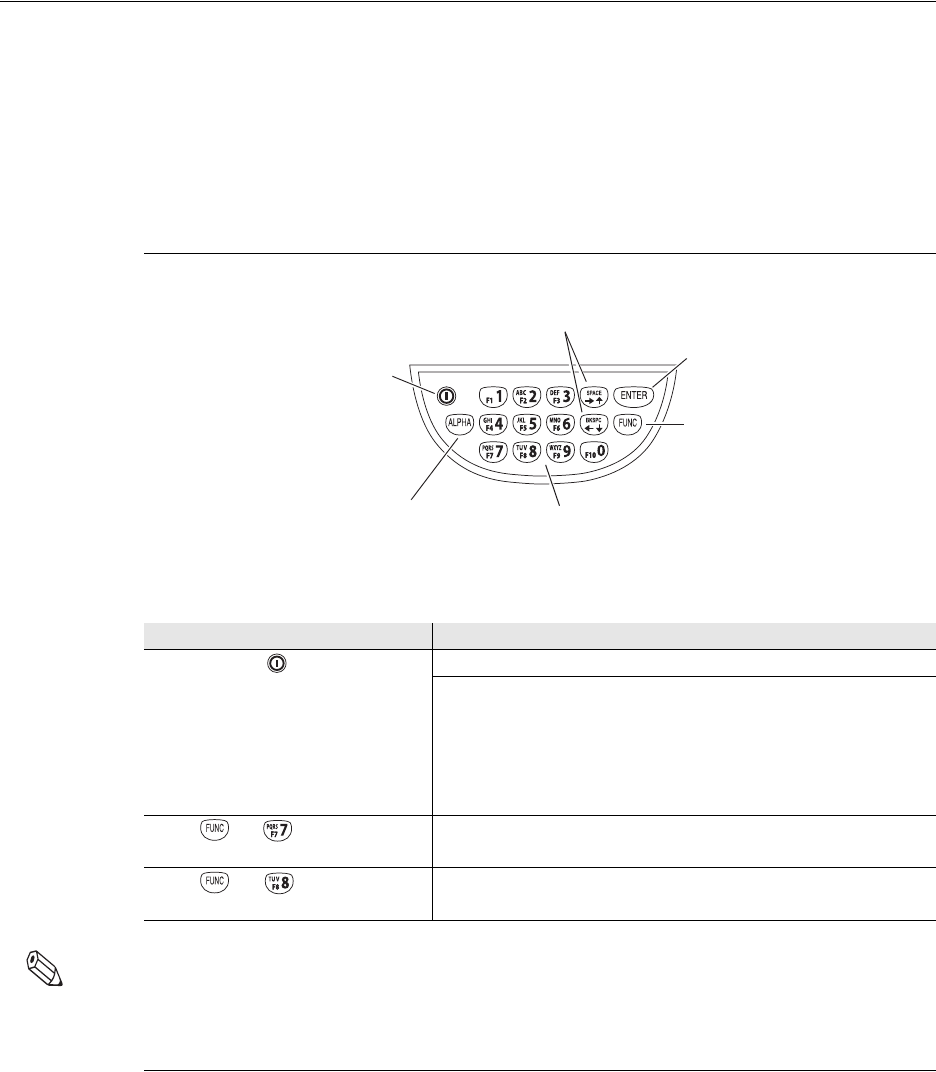
Portable Inventory Reader: Using the Portable Data Terminal 4-7
Using the Portable Data Terminal
In this chapter the word tap is used instead of click because the stylus supplied is used to
tap the touch screen. There are no double-clicks on the Portable Data Terminal unit as all
actions are accomplished by a single tap. The stylus is stored in a silo on the back of the
Portable Data Terminal.
Please refer to the Symbol Portable Data Terminal Series Quick Reference Guide for
more information regarding use of this device.
Turning On/Off Backlight
Use the key combinations below to adjust the backlight.
Figure 4.10
Backlight On/Off
The backlight turns off after a configurable amount of time.
Note: You can alter the setting in Start > Settings > System > Backlight.
Checking the Status of the Batteries
It may become necessary to check the status of the Portable Data Terminal’s battery
power. Use the following procedure:
1Tap the Start icon in the upper left hand corner of the window.
2Tap the Settings menu item.
Table 4.1
Remote User Manager Access Privileges
Keys Description
Press and hold Turns the display backlight and keypad backlight on and off.
When both backlights (display and keypad) are off, the backlights
turn on in the following order when the button is held:
• First the display backlight turns on, continue to hold, then the
keypad backlight turns on.
• When either backlight is on, the backlights turn off when the
power button is pressed and held.
Press + Decrease display backlight (decrease brightness).
Press + Increase display backlight (increase brightness).
*
.
Function Key
Alphanumeric Keys
Scroll Keys
Power Button
Alpha Key
Enter Key
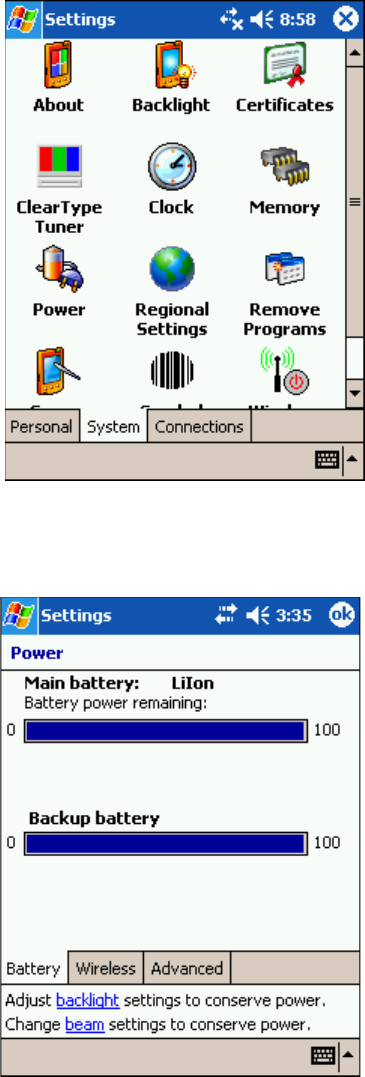
4-8 ILS Open Plus 3.0 Installation Manual
3Tap the System tab at the bottom of the Settings Panel window.
Figure 4.11
Settings Window
4Tap the Power icon. The Battery Status window displays. This window shows you the
power status of both the main and the backup batteries.
Figure 4.12
Battery Status
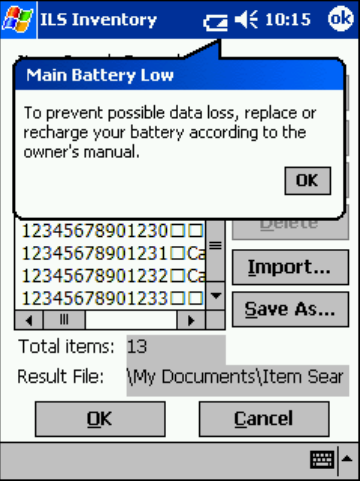
Portable Inventory Reader: Using the Portable Data Terminal 4-9
A warning displays if either battery is low.
Figure 4.13
Low Battery Warning
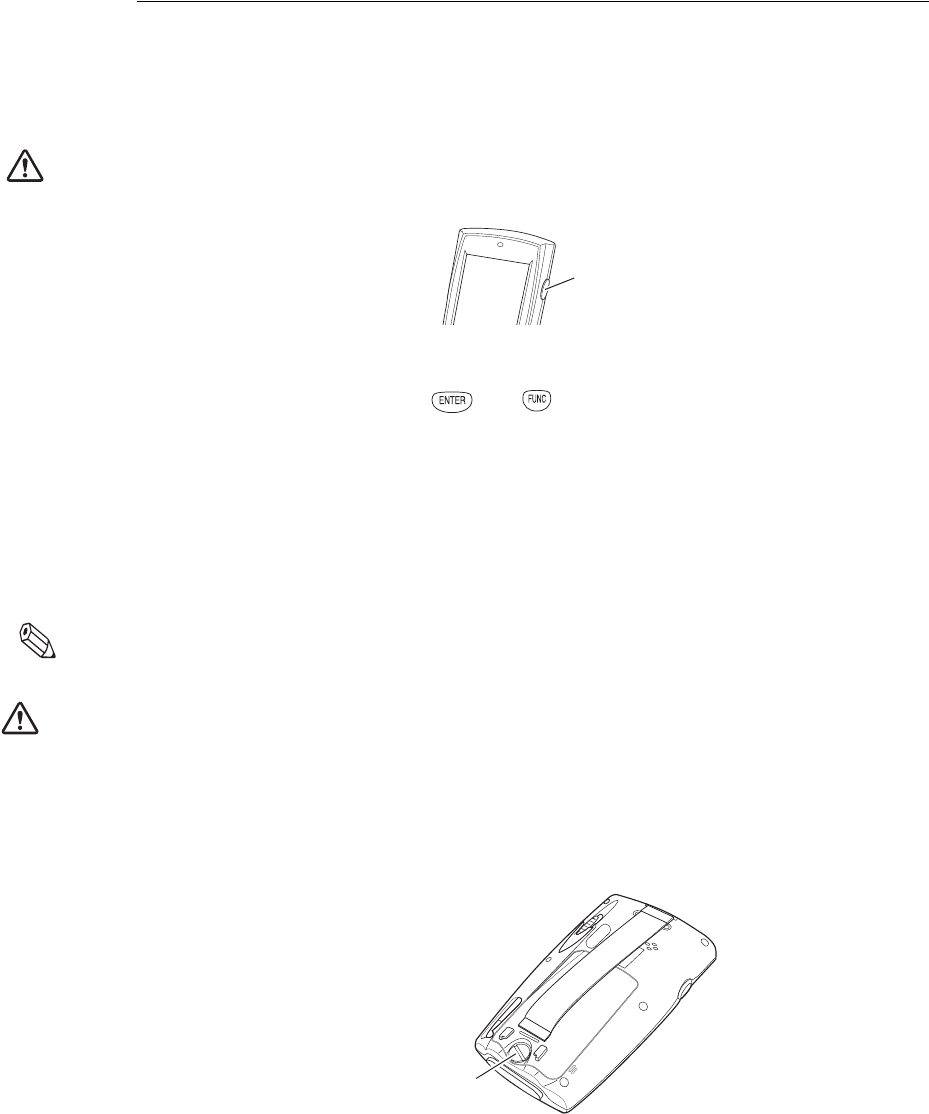
4-10 ILS Open Plus 3.0 Installation Manual
Performing a Reset
If your PDT stops responding to input from buttons or the screen, reset it by performing a
soft or hard reset. Only perform a hard reset if a soft reset fails to clear the problem.
Performing a Soft Reset
A soft reset restarts the terminal and saves all stored records and entries.
Caution Files that remain open during a warm boot may not be retained. DO NOT perform a soft reset if the
terminal is suspended. Press the power button to wake the terminal.
Figure 4.14
Soft reset buttons
To perform a soft reset, press and keys while holding down either the left or
right scan trigger and then releasing the keys.
The unit resets, during which the display shows a startup screen.
Performing a Hard Reset
A hard reset restarts your Portable Data Terminal terminal and erases all stored records
and entries, including any extra programs installed in the Main Memory such as the ILS
Inventory program. Therefore, never perform a hard reset unless a soft reset does not solve
your problem.
Note: You can restore any data previously synchronized with your computer during the next ActiveSync
operation.
Caution: With a hard reset, the current date and time, formats, preferences, and other settings are restored to
their factory default settings.
To perform a hard reset:
1Remove the hand strap above the locking screw by sliding the end of the strap towards
the bottom of the unit.
Figure 4.15
Locking screw
Right Scan
Trigger
Locking Screw
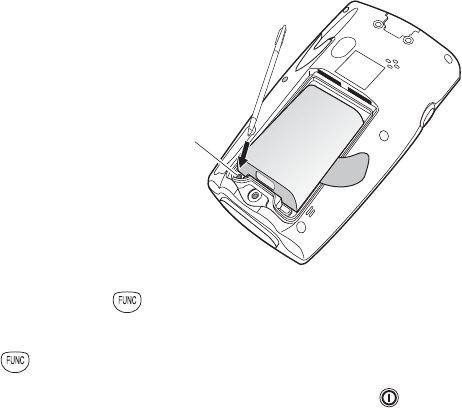
Portable Inventory Reader: Using the Portable Data Terminal 4-11
2Turn the locking screw counterclockwise until the cover releases from the terminal and
lift the battery door away from the terminal.
3While holding down the button, use the tip of the stylus (or similar object without
a sharp tip) to gently press the Reset button.
4Release the button.
5Replace the battery cover and hand strap and press the button. As the terminal
initializes its unique Flash File system, the Symbol splash screen displays for about a
minute.
6Follow the prompts when Aligning the Screen appears to perform an initial setup of
the terminal.
Reset Button
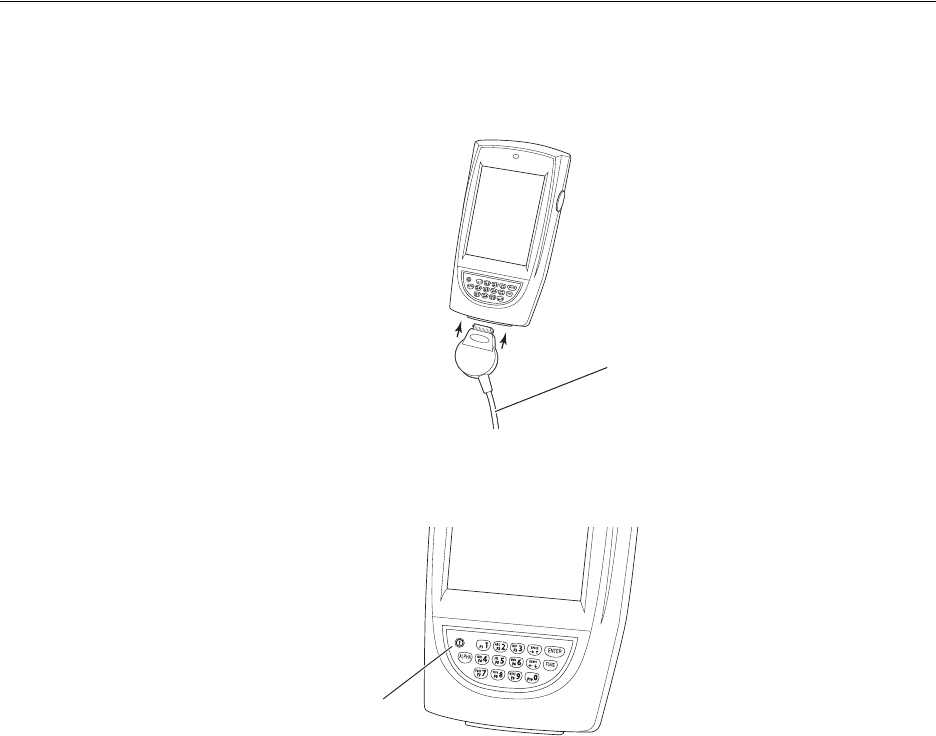
4-12 ILS Open Plus 3.0 Installation Manual
Collecting Inventory Data
Now that the Portable Data Terminal has been initialized, you are ready to begin
collecting inventory information.
1Connect the synchronization cable from the inventory wand to the Portable Data
Terminal.
Figure 4.16
Attaching Synchronization Cable to Portable Data Terminal
2Turn on the Portable Data Terminal by pressing the red button in the lower-left hand
corner of the device.
Figure 4.17
Powering On the Portable Data Terminal
Synchronization
Cable
*
.
*
.
Power Button
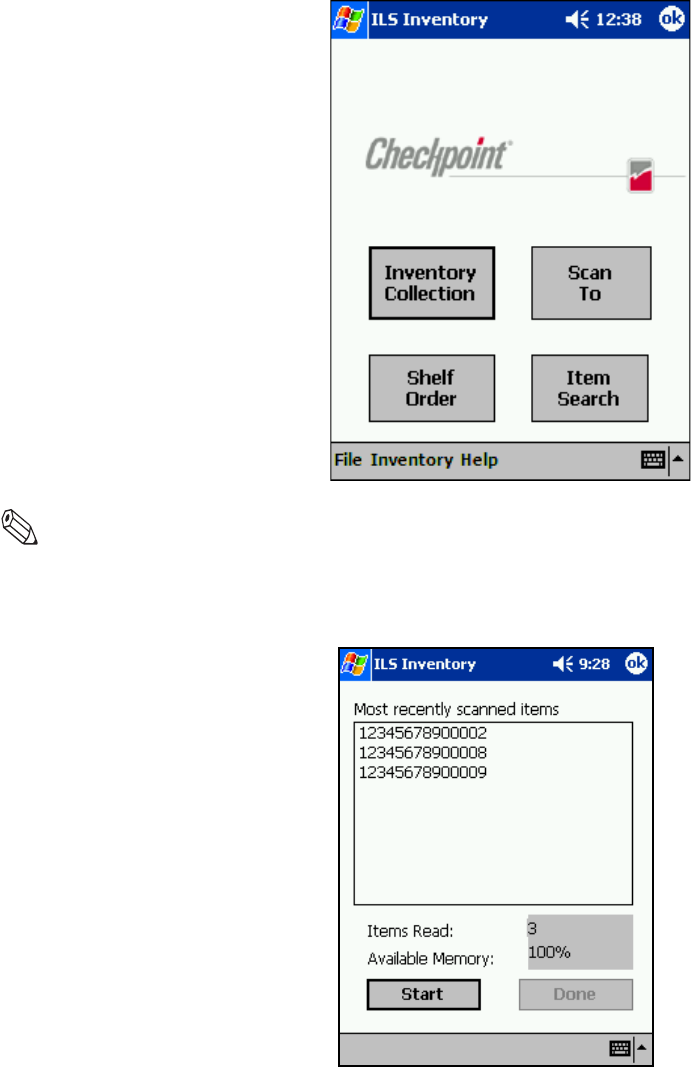
Portable Inventory Reader: Collecting Inventory Data 4-13
Once you have powered on the Portable Data Terminal, you are presented with the ILS
Inventory main menu window.
Figure 4.18
ILS Inventory Main window
Note: If you do not see the main ILS Inventory window, tap the Start button in the upper-left hand corner of
the screen. Tap on the ILS Inventory menu item in the start menu to launch the program.
3Tap Inventory Collection located in the center of the screen.
Figure 4.19
Inventory Collection
4Tap Start located in the bottom-left hand corner of the screen.
5If a previous inventory collection file was not transferred to the ILS Server, you will be
asked if you want to add (append) to the file.
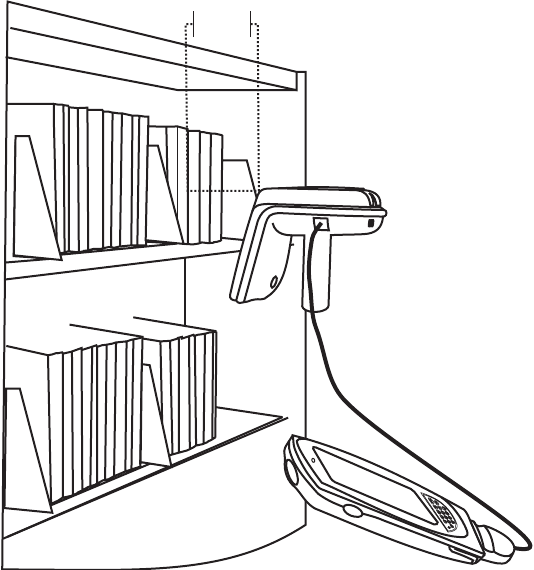
4-14 ILS Open Plus 3.0 Installation Manual
•Selecting Yes continues the previous inventory collection and new items are added
to the file.
•If you select No, you are asked to confirm that you do not wish to keep the existing
data. Tap OK if sure and a new inventory file is created. Tap Cancel to append to
the file (as if you had selected Yes).
•If you want to transfer the previous file after selecting Yes, you can immediately tap
Done to initiate a file transfer.
6Begin scanning for items.
Figure 4.20
Scanning Books
Hold the wand in your hand about three inches (7 cm) from the material you wish to
scan. Notice that the red light on the wand blinks, indicating that the wand is detecting
circulation circuits. The wand detects Circulation Circuits up to a distance of 8 inches
(20 cm); therefore, it is important to keep the wand focused on the intended inventory
items to avoid unwanted data from being collected.
3-8 in
7-20cm
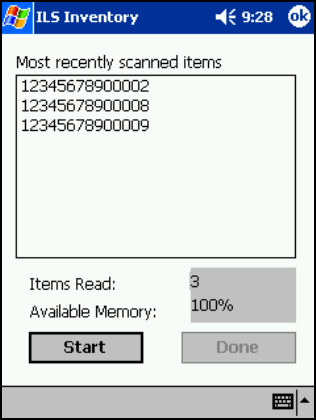
Portable Inventory Reader: Collecting Inventory Data 4-15
Alternatively, you can use the barcode scanner of the PDT to scan for barcodes. Press
either the left or right scan trigger button to activate the barcode scanner, which beams
from the front of the PDT.
Figure 4.21
Inventory Collection In Progress
Once you begin scanning, the following information displays in the ILS Inventory
screen:
•Most recently scanned items
The bar code number for that circuit displays on the Portable Data Terminal in the
Most Recently Scanned Items field.
•Items Read
Field displays the total number of inventory tags read over time.
•Available Memory
Field displays the percentage of memory still available.
7Once completed scanning, tap Done. See “Transferring Inventory Data” on page 4-16
for instructions on data transfer.
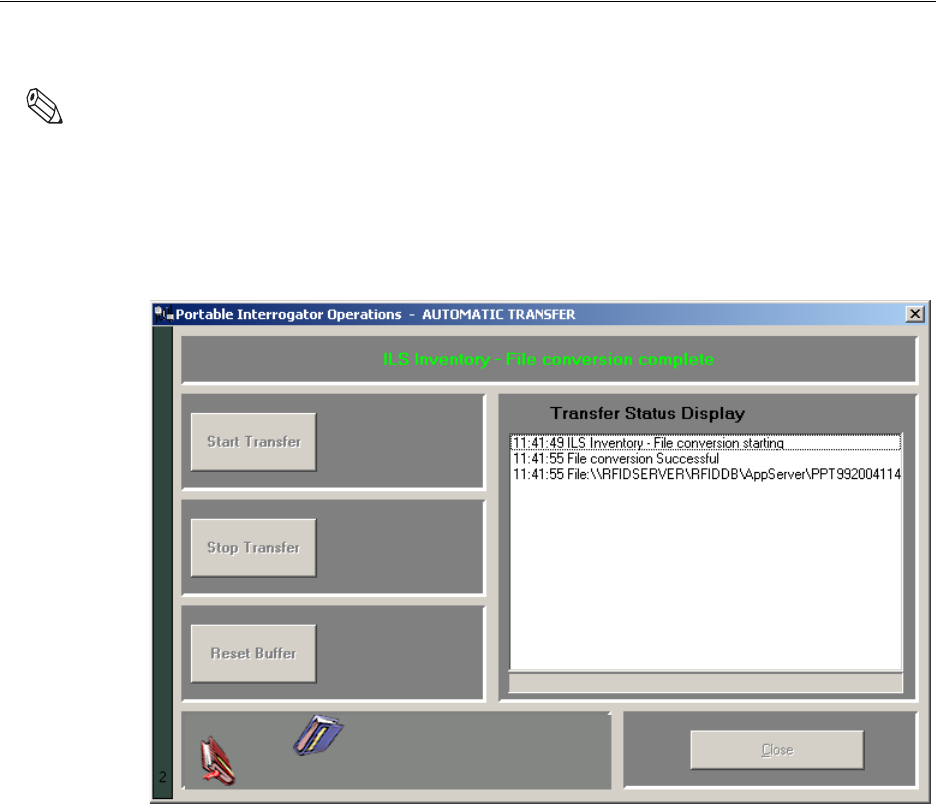
4-16 ILS Open Plus 3.0 Installation Manual
Transferring Inventory Data
Once you complete scanning inventory, follow these instructions to transfer the data.
1After you have finished collecting inventory by tapping Done, a dialog window
displays asking if you want to transfer the data collected. Tap OK to do so.
Note: If you wish to continue the inventory collection after you have pressed Done, press Cancel to
prevent file transfer and re-enter inventory collection mode.
2Unplug the cable from the bottom of the Portable Data Terminal.
3Dock the Portable Data Terminal into the cradle. A Transferring window displays on
the Portable Data Terminal while data is transferring to the Intelligent Library
Controller.
Figure 4.22
Portable Interrogator Operations
4Once the transfer is completed, the Intelligent Library Controller displays the Portable
Inventory Reader Operations window. The inventory you transferred is converted by
the Intelligent Library Controller to a text file containing the list of barcodes. The file
name and location is displayed in the Transfer Status Display window. When the
process is finished, click Close on the Portable Interrogator Operations window.
The Intelligent Library Controller then converts the information to the inventory file
format used by the LMS and copies it to a directory from which the LMS can copy it
(using FTP).
5The Portable Data Terminal displays Transfer Complete. Tap OK to return to the ILS
Inventory Main window.
You may begin another inventory collection by selecting Start. Or, exit to the main
window by clicking OK found at the top-right of the screen.
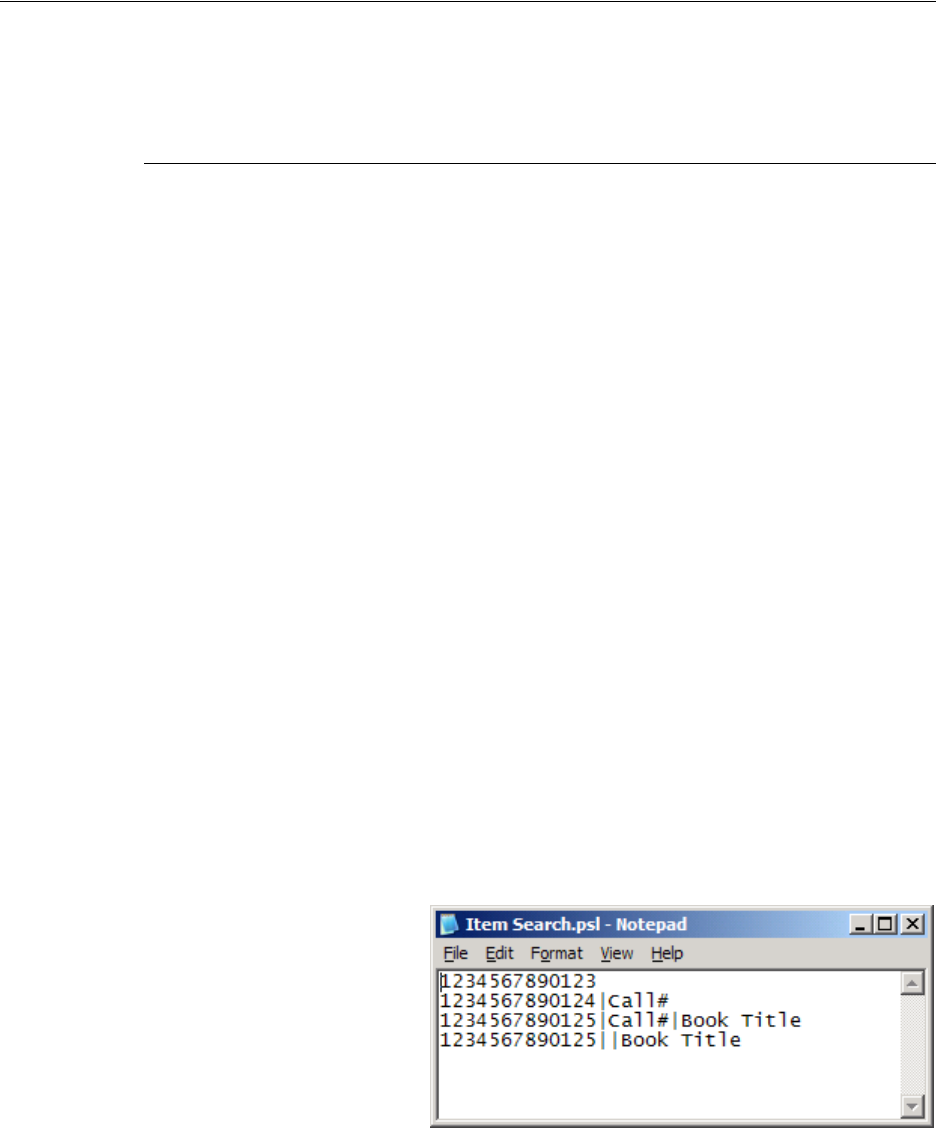
Portable Inventory Reader: Searching the Inventory 4-17
Searching the Inventory
Use this function to search for missing or desired materials. Library material must have a
circulation circuit attached to it for this function to succeed. Also, it is helpful if scanning
for more than one item that you prepare an Item Search List file before searching.
Preparing an Item Search List File
An Item Search List file contains the barcodes you wish to find. The file uses the .psl file
extension and can be created:
• By formatting a report from the circulation system
• By formatting an Inventory Search or Shelf Order Search file conducted with the
Portable Reader
• Using a text editor (like Notepad) to manually enter item information
Create the file in the following manner:
1Gather your barcode data of missing items. If you have conducted an Inventory Search,
you can use this file by changing the extension to “.psl” and following the formatting
identified in step 2.
If you are producing a report from your circulation system, ensure that it follows the
parameters explained in the step 2.
2Enter the data by typing or copying and pasting the data into a simple text editor, like
Notepad, shown in the figure below: “Sample PSL File”.
•The barcode numbers must be in a single row, with a return at the end of each line.
•If you wish the call number and book title to appear associated with that barcode,
you must separate the information with a pipe symbol “|”.
•You can also have just a call number or just a book title appear as well with the
associated barcode. If you want just a Book Title to appear with that barcode, you
must include two pipes sequentially to account for the empty call title column.
If your data resides in a more complex spreadsheet program like Microsoft Excel®, it is
not recommended that you copy the data from Excel and paste it into your text editor as
the correct pipe symbol is not used to separate data. However, you can manually alter
the file if you choose to paste the data from a spreadsheet.
Figure 4.23
Sample PSL File
3Once the data is entered, save with a descriptive name and close the file. Note the
location where you saved the file.
Barcode only
Barcode with Call #
Barcode with Call # and Book Title
Barcode with only Book Title

4-18 ILS Open Plus 3.0 Installation Manual
4Navigate to the location of your file and change the extension of the file to PSL. For
example, “Item Search.txt” becomes “Item Search.psl”.
Figure 4.24
PSL File Name Change
The next section informs you how to transfer this file to the Portable Data Terminal using
the docking station.
Transferring the Search List File
To transfer a search list file (or files) from the Intelligent Library Controller to your
Portable Data Terminal
1Place the search file (for example, Item Search.psl) in the synchronization directory for
your Portable Data Terminal. There should be a shortcut to this directory on the
desktop of the Intelligent Library Controller.
2Once the file is in the correct location, dock the Portable Data Terminal and the file(s)
is automatically transferred.
3Once the file(s) has been transferred remove the Portable Data Terminal from its
cradle.
4If ILS Inventory is not running on your Portable Data Terminal, launch the program by
tapping the Start button in the upper-left hand corner of the screen, then tap ILS
Inventory.
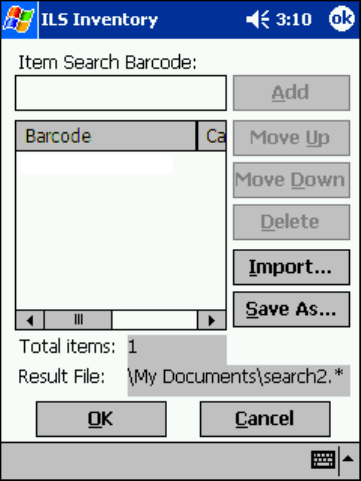
Portable Inventory Reader: Searching the Inventory 4-19
Importing the Search List File
To import the search list file:
1From the main screen of ILS Inventory, tap Item Search. The Item Search window
displays.
Figure 4.25
Search List File
2Follow either instruction for importing barcodes:
aIf you are searching for a single barcode, you can input the number directly into the
Item Search Barcode field. Tap Add when finished and the barcode number appears
below.
The name of the search result file is stated in the Result File field (for example,
“search2.*” in the example above) unless you use the Save As to enter a different
name. See “Saving Custom Search Files” on page 4-34 for details.
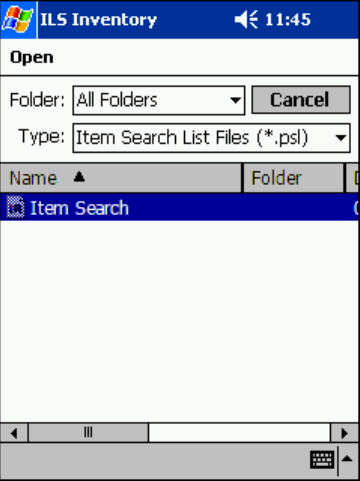
4-20 ILS Open Plus 3.0 Installation Manual
bIf you have created a search file, tap Import. The Import window displays.
Figure 4.26
Search File Import
cEnsure that Item Search List Files (*.psl) is selected as the type, using the down
arrow at right to select the type of file displayed. Your search file appears below in
the Name field (the example shows “Item Search” already highlighted).
dTap the file name (for example, you would tap Item Search, shown above), and the
file imports automatically. If the import is successful, you are returned to the Item
Search window. If unsuccessful, double-check that the format of the file is a plain
text file that uses the extension *.psl. See “Preparing an Item Search List File” on
page 4-17 for more details about preparing the file.

Portable Inventory Reader: Searching the Inventory 4-21
3In the Item Search window, the Barcodes field displays the barcodes that will be used
in searching for items.
Figure 4.27
Item Search Input
If you need to move or delete a particular barcode, highlight it and select the
appropriate action at right.
4Tap OK. You see the ILS Inventory window.
Figure 4.28
Inventory Search
5Tap Start to begin your inventory search.
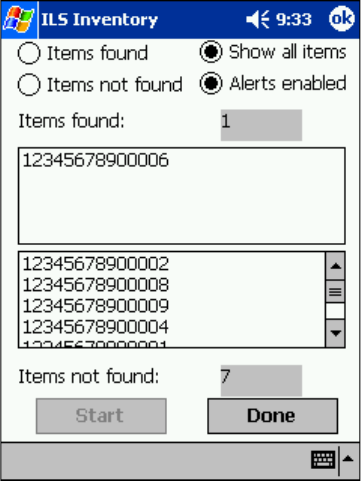
4-22 ILS Open Plus 3.0 Installation Manual
Scanning for Inventory
There are several ways to view information on the Search Mode window.
•View 1 - Items Found
Indicates all of the barcodes that were found.
•View 2 - Items Not Found
Indicates all of the barcodes that the system has not yet found.
•View 3 - Show All Items
Shows both the Items Found and the Items Not Yet Found. This is the default
selection.
•Alerts Enabled
When the Alerts enabled is selected, an alert displays and sound occurs for each
item found. The search mechanism stops temporarily, allowing you to locate the
item found on the shelf. To disable this feature, tap it.
1Tap a different view at any time to change.
2Use the inventory wand to scan for barcodes, sweeping back and forth. See “Scanning
Books” on page 4-14 for a details.
Notice that the barcode display field(s) reflects changes in the status of the search
items, depending on the search option you chose. Items found (the field above) are
listed as you find them. Items not found (the field below) are removed from the list as
you find them.
Figure 4.29
Item Search window
Notice that the red light on the wand flickers when it finds circulation circuits. It is
important to keep the wand focused on the intended inventory items to avoid unwanted
data from being collected.
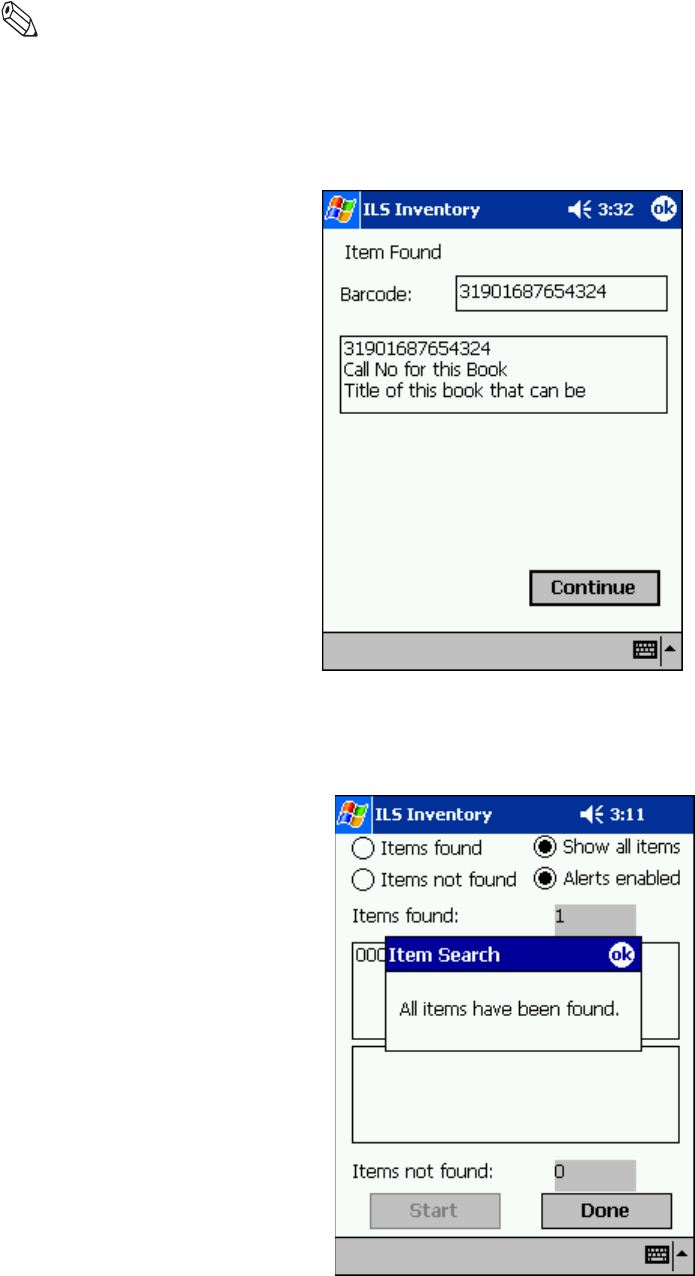
Portable Inventory Reader: Searching the Inventory 4-23
Note: While the red light may flash when the scanner detects any tag, a barcode only displays in the Items
found list if it matches an item present in your Search Items list.
3When a barcode is found; the barcode, shelf location, and title of the item (if all
configured in your search file) display. Retrieve the item, if necessary, and tap
Continue to resume the search.
Figure 4.30
Item Found Alert
4When finished, tap Done at the bottom of the screen. If all of the items are found, an
alert window notifies you.
Figure 4.31
All Items Found
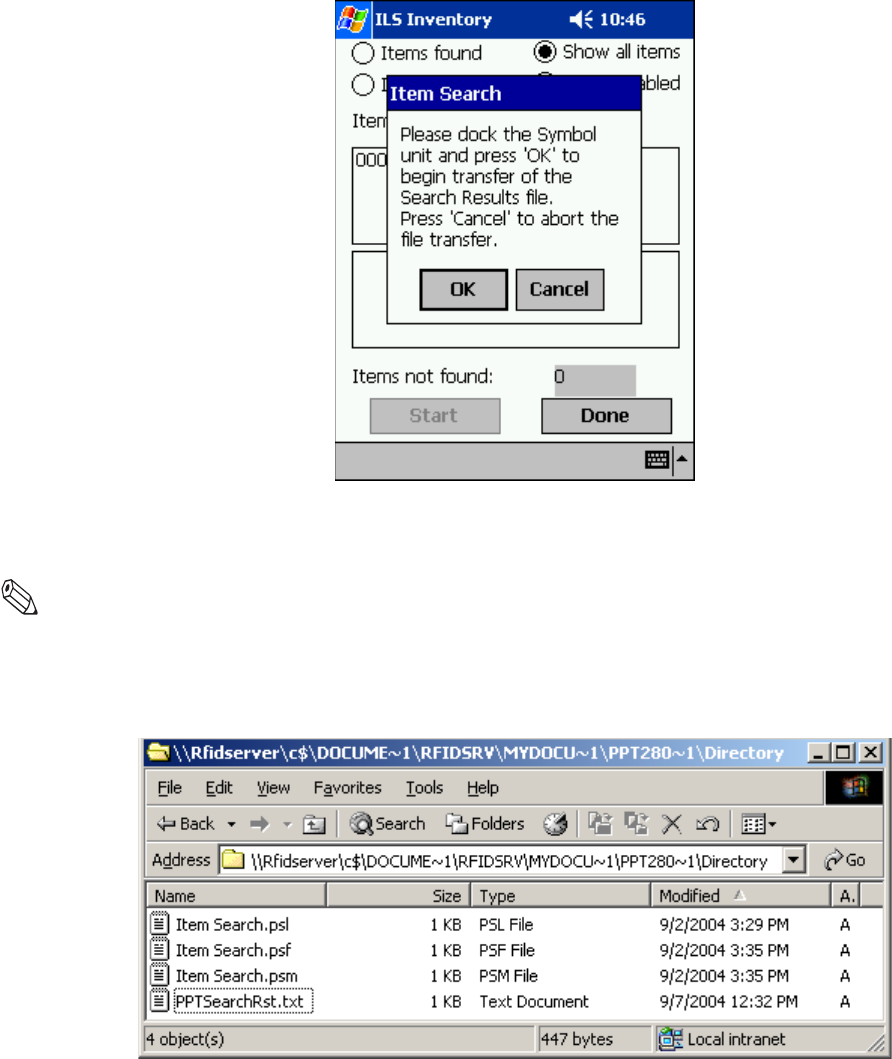
4-24 ILS Open Plus 3.0 Installation Manual
5Tap OK to continue and the Item Search result files are generated.
A dialog box displays asking you to dock the Portable Data Terminal to transfer the
Search Results file.
Figure 4.32
Portable Data Terminal Docking
6Tap OK and place the Portable Data Terminal into the docking station to begin the
transfer.
Note: In Wireless mode the file transfer is automatic. If you would like to abort the file transfer, tap Cancel.
You are returned to the Item Search window.
The Search Results files are transferred to the configured directory on the Intelligent
Library Controller. Refer to “Transferring Inventory Data” on page 4-16 for details.
Figure 4.33
Sample search results directory
The “PPTSearchRst.txt” file lists all of the barcodes searched. If a barcode was found,
the date and time of the search are listed. If the barcode was not found, the date and
time are not listed.

Portable Inventory Reader: Conducting Shelf Order Search 4-25
Two additional files are also created to list the items found and the items not found.
•The Items Found file uses the file extension *.psf.
•The Items Not Found file uses the file extension *.psm.
These files may be used to perform another search, or may be processed as results of
the search on the circulation system.
Every time you upload the results of an Item Search, the search results file
“PPTSearchRst.txt” is overwritten with the new data automatically. Thus, if you wish
to retain the previous data, save the file elsewhere before synchronizing.
Conducting Shelf Order Search
Use Shelf Order Search to verify the contents of a shelf against a shelf order list generated
by the Library Management System. Items scanned are compared to the shelf order list to
determine if they are in order, not in the list, or not found. This enables verification and
sorting of the shelf contents.
Selecting or Creating a Shelf Order Search File
A Shelf Order Search file is identified by a *.pso file extension and is transferred from the
Intelligent Library Controller to the Portable Data Terminal. To select or create a Shelf
Order file:
1Create the file by running a Shelf Order report on the circulation system or by creating
a Shelf Order file manually.
2See “Preparing an Item Search List File” on page 4-17 for details on how to format the
file, as you configure the file using the exact same methodology as in preparing a
Search List file, only you use the “.pso” extension when saving the file.
Transferring the Shelf Order File
To transfer a Shelf Order file:
1To transfer a shelf order file (or files) from the Intelligent Library Controller to your
Portable Data Terminal, place the file (for example, Shelf Order.pso) in the
synchronization directory for your Portable Data Terminal. There should be a shortcut
to this directory on the desktop of the Intelligent Library Controller.
2Once the file is in the correct location, dock the Portable Data Terminal and the file is
automatically transferred.
3Once the file(s) has been transferred, remove the Portable Data Terminal from its
cradle.
4If ILS Inventory is not running on your Portable Data Terminal, launch the program by
tapping the Start button in the upper-left hand corner of the screen, then tap ILS
Inventory.
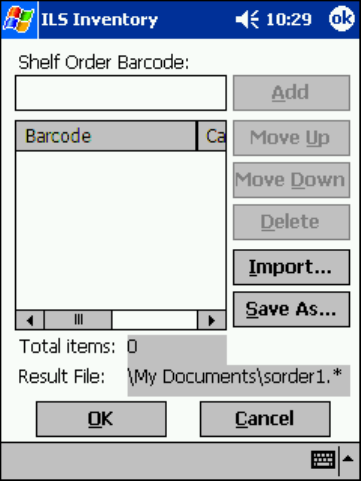
4-26 ILS Open Plus 3.0 Installation Manual
Importing Shelf Order File
To import a Shelf Order file:
1From the main screen of ILS Inventory, tap Shelf Order. The Shelf Order window
displays.
Figure 4.34
Shelf Order Window
2Follow either instruction for importing a shelf order list:
aIf you are checking a single barcode, you can input the number directly into the
Shelf Order Barcode field. Tap Add when finished and the barcode number appears
below.
The name of the search result file is stated in the Result File field (for example,
“sorder1.*” in the example above) unless you use the Save As to enter a different
name. See “Saving Custom Search Files” on page 4-34 for details.
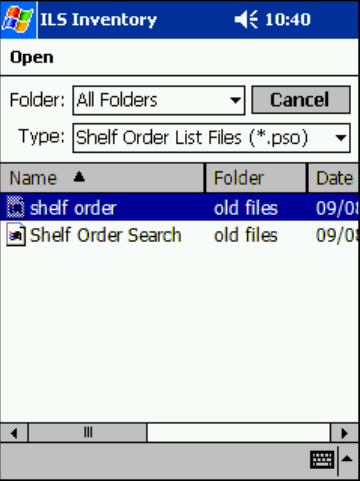
Portable Inventory Reader: Conducting Shelf Order Search 4-27
bIf you have created a shelf order search file, tap Import. The Import window
displays.
Figure 4.35
Search File Import
cEnsure that Shelf Order List Files (*.pso) is selected as the type, using the down
arrow at right to select the type of file displayed. Your search file appears below in
the Name field (the example shows “shelf order” already highlighted).
dTap the file name (for example, you would tap shelf order, shown above), and the
file imports automatically. If the import is successful, you are returned to the Shelf
Order Barcode window. If unsuccessful, double-check that the format of the file is a
plain text file that uses the extension *.pso. See “Preparing an Item Search List
File” on page 4-17 for more details about preparing the file.

4-28 ILS Open Plus 3.0 Installation Manual
3In the Shelf Order Barcode window, the Barcodes field displays the barcodes that are
used in searching for items.
Figure 4.36
Item Search Input
If you need to move or delete a particular barcode, highlight it and select the
appropriate action at right.
4Tap OK. You are taken to the ILS Inventory window.
Figure 4.37
Shelf Order Start
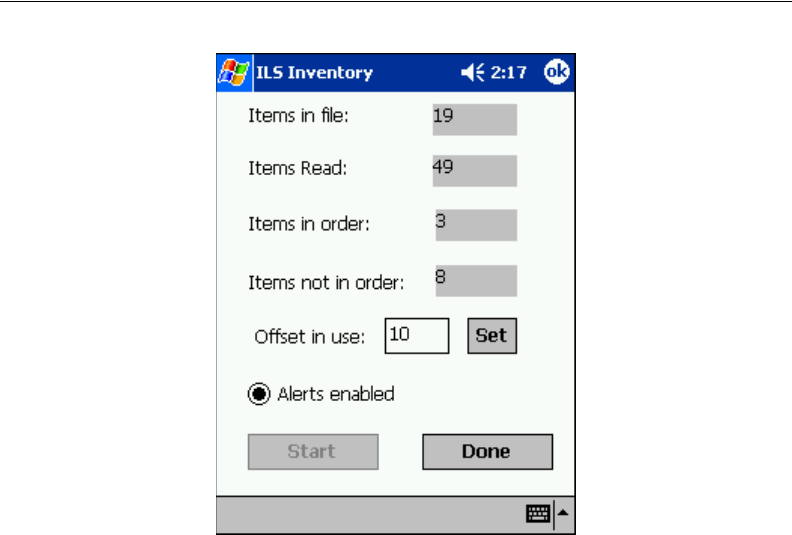
Portable Inventory Reader: Conducting Shelf Order Search 4-29
Shelf Order Search Window
The Shelf Order Search window displays the following information:
Figure 4.38
Shelf Order Searching
• Items in file
The original count of the items read from the Shelf Order file.
•Items Read
The number of items read during the search.
•Items in order
The number of items that were read in shelf order.
• Items not in order
The number of items that were read that are not in shelf order.
• Offset in use
Adjust the offset by changing the number and tapping Set.
This indicates the current setting used to determine how many barcodes can be
separated (or offset) before they are considered out of shelf order. So in the example
above, a barcode would be considered out of order if found separated by 10 barcodes.
An offset is needed because the wand can read items in a random order within its read
range, allowing for adjustment when items of different thickness are being scanned.
For example, poetry books are usually slim while reference books are much thicker,
thus allowing more or less books within the read range of the inventory wand.
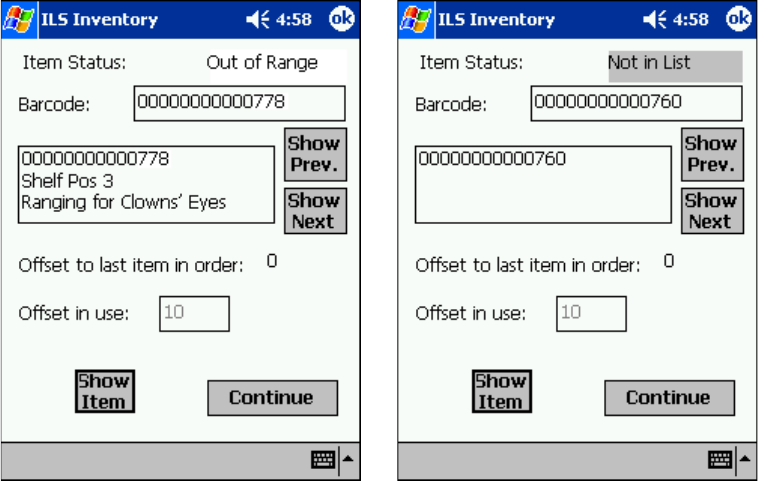
4-30 ILS Open Plus 3.0 Installation Manual
• Alerts Enabled
When checked, an alert displays and a sound occurs for items of interest. Tap this
button to disable alerts. Alerts occur for the following reasons:
See “Shelf Order Alert” on page 4-30 for more details.
5Tap Start to begin your inventory search. You must scan items at the starting shelf
location in the list. The Offset in use and the Alerts enabled settings may be changed at
any time during the search.
6When finished, tap Done. If all of the items shelf order list are found, an alert window
notifies you. Tap OK to continue. See “Shelf Order Results” on page 4-31 for details
on what to do next.
Shelf Order Alert
When a Shelf Order Alert displays for an item that:
• Is not in the list, the barcode displays. The Item Status field indicates Not in List.
• Is not in shelf order, the barcode, shelf location, and title displays. The Item Status field
indicates Out of Range.
Figure 4.39
Shelf Order Alert - Out of Range/Not in List
•Show Prev
Displays the previous item read. You can tap this button to display the last item in
order to assist in locating the item on the shelf.
Out of range • The item read was found in the Shelf Order list, but was not located close
enough to the last item in the shelf order.
Not in list • The item read was not found in the Shelf Order list.
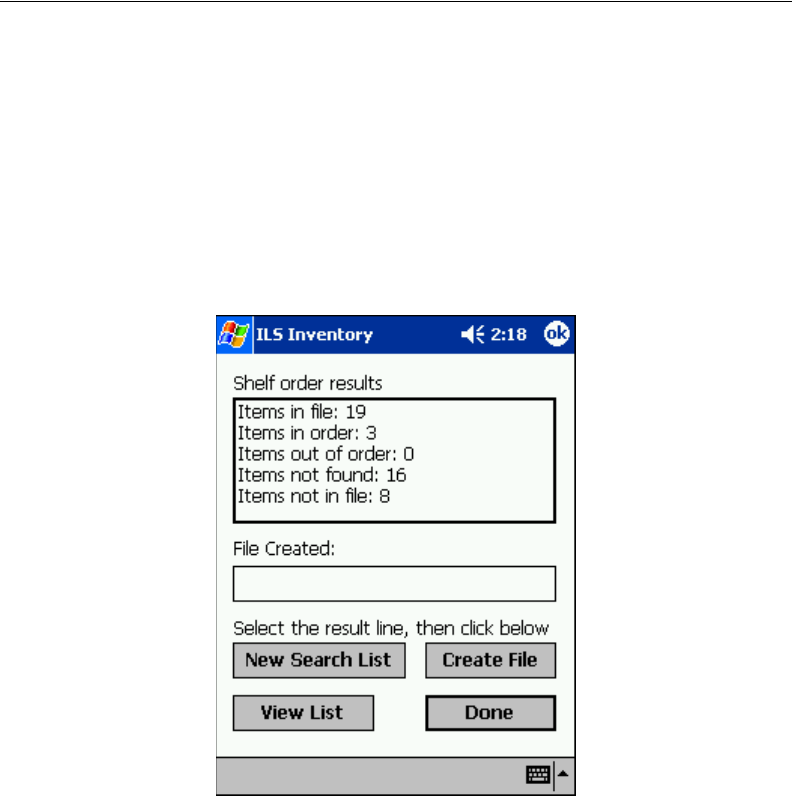
Portable Inventory Reader: Conducting Shelf Order Search 4-31
•If Not in List, this item should probably be removed from the shelf, since it is not in
the shelf order list.
•If Out of Range, this item should be repositioned on the shelf in the correct order.
• Show Next
Displays the next item read.
•Show Item
Returns the display to the item that is not in the list.
Tap Continue when you are ready to resume the scan. Be sure to start at the position you
were in when the alert occurred.
“Offset in use” and “Alert enable” settings may be changed once the search is resumed.
Shelf Order Results
When the shelf order search is completed, the Shelf Order Results window is displayed.
The Shelf order results window shows the counters from the completed search.
From the results you can:
• Create a new search list
• Create files of various types from each of the items with results
• View the results of each items
Notice that there is no prompt to perform file transfer at this point because you need to
specify the type of file you wish to transfer. Once the file has been created, you would then
dock the Portable Data Terminal to copy the file to the Application Server.
Figure 4.40
Shelf Order Results
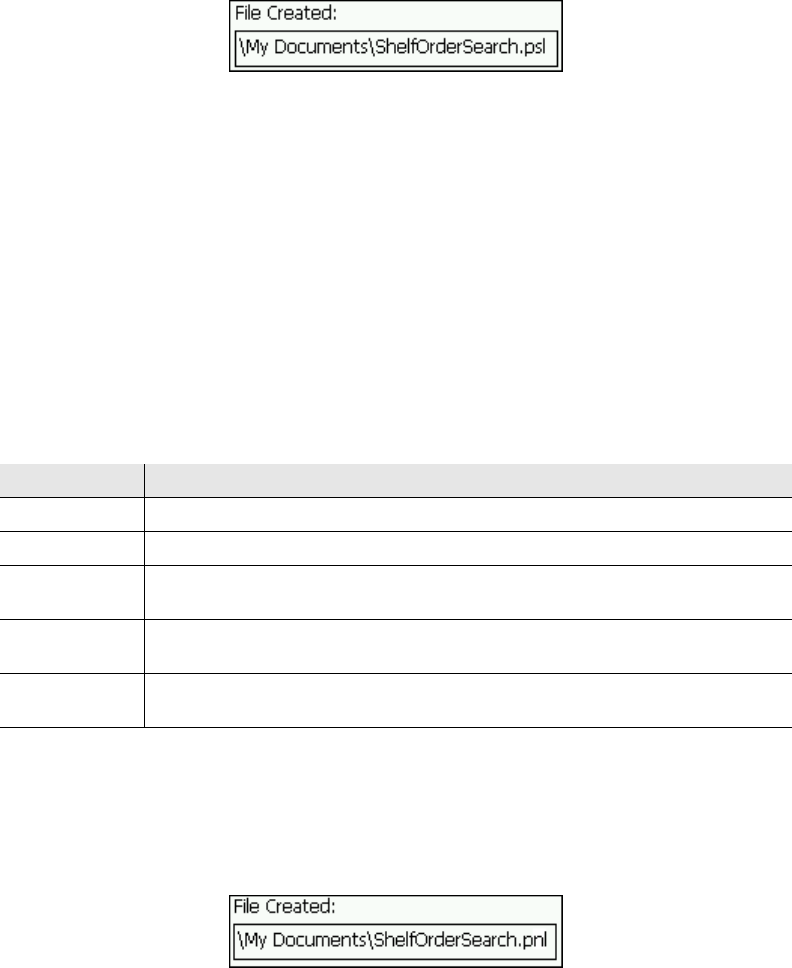
4-32 ILS Open Plus 3.0 Installation Manual
Creating a New Search List
1Tap on the item of interest in the Shelf order results field. For example, “Items not in
file.” Items in file does not generate a file.
2Tap New Search List.
3If a result is present, the File Created field automatically populates with the file name
of the Shelf Order Search file and the correct extension “.psl”. For example, if the
“Items not in file” line is selected, a new search could be performed to locate the items
that do not belong on the shelf:
Figure 4.41
PSL file
The next time you dock the Portable Data Terminal, the file created is uploaded to the
Intelligent Library Controller.
4Tap Done.
5You may now import this file to scan for the barcode(s) into Item Search. See
“Preparing an Item Search List File” on page 4-17 for more details.
Creating a File from Shelf Order Results
This creates a new Search Order Result file, based on which counter is selected in the
Shelf order results window. The file extension used determines the type of file, explained
below:
1Tap on the item of interest in the Shelf order results field. For example, “Items not in
file.” Items in file does not generate a file.
2Tap Create File and the file is created. The File Created field automatically populates
with the file name of the Shelf Order Search file and the correct extension. For
example, if the “Items not in file” line is selected, the extension of “.pnl” is used:
Figure 4.42
PNL file
Table 4.2
Search Order Results
Item Description
Items in file The original count of the items in the Shelf Order file. (no file is created.)
Items in order The number of items that were read in shelf order. (.pio)
Items out of
order The number of items that were read that are not in shelf order. (.poo)
Items not
found The number of items in the Shelf Order file that were not found. (.pmi)
Items not in
file The number of items read that were not in the Shelf Order file. (.pnl)
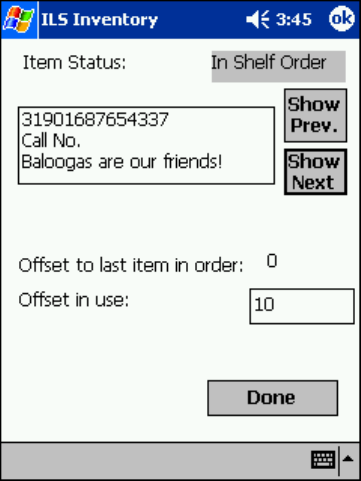
Portable Inventory Reader: Conducting Shelf Order Search 4-33
3You may now import this file to scan for the barcode(s) into Item Search. See
“Preparing an Item Search List File” on page 4-17 for more details.
Viewing Shelf Order Results
View List displays the results of a Shelf Order scan. Each item read is displayed in order,
with the appropriate status information.
Figure 4.43
Shelf Order View List window
1Tap on the item of interest. For example, “Items in order.” The View List window
appears.
2Tap View List.
3Tap Show Prev. and Show Next to step through the list.
4Tap Done when finished. You are returned to the Shelf Order window.
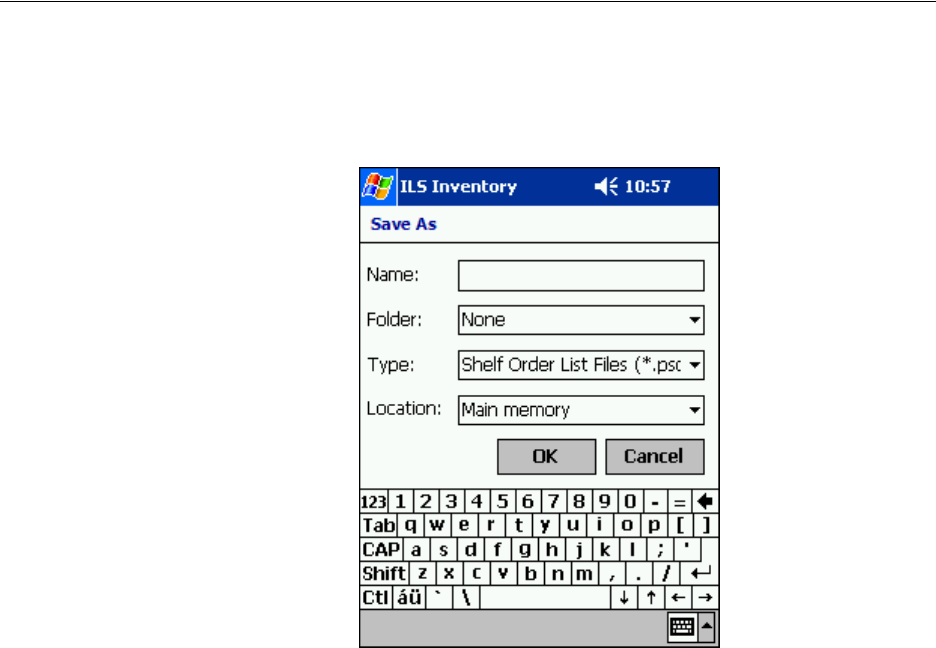
4-34 ILS Open Plus 3.0 Installation Manual
Saving Custom Search Files
When you create customized search files on the Portable Data Terminal, either types of
Item Searches or types of Shelf Order Searches, you can save the customized lists with a
file name you input. The same directions apply for all types of search files.
1From either the Item Search or Shelf Order main windows, tap Save As. The Save As
window displays.
Figure 4.44
Sample File Save As Window
2Enter a descriptive name into the Name field.
3Select a folder, if desired, to save the file. Your synchronization folder is the default
folder (None) already selected.
4Select the Type of file you wish to create.
5You do not need to alter the location from Main Memory.
6Tap OK to save the file.
To retrieve your file:
1Tap Start > File Explorer.
2Navigate to My Documents to find your file. Or, dock the Portable Data Terminal to
upload your file to the Application Server.

ILS Remote Monitor: 5-1
CHAPTER
C
HAPTER
0
ILS R
EMOTE
M
ONITOR
This chapter describes the ILS Remote Monitor utility and provides information on how
to:
• Install web site certificates on the clients (page 5-2)
• Set up and manage user accounts and permissions (page 5-5)
• Start up ILS Remote Monitor (page 5-8)
•Single server, multi-branch environment
•Peer-to-peer environment
• Change branch views (page 5-9)
• View the status of different branches (page 5-10)
• View and print reports (page 5-11)
• Upload Portable Inventory Reader inventory files (page 5-12)
ILS Remote Monitor is an optional utility that allows library staff operating in a single
server, multi-branch or peer-to-peer environment to view the status of other branches on
the network from any computer on that network. In addition, library staff can:
• Monitor exit alarms
• Identify problematic Patron Self-Checkout Stations
• Print pre-run reports
• Transfer files from a remote location to the Application Server
After ILS Remote Monitor is installed and configured on the Application Server, any
computer on the local network can use ILS Remote Monitor to access Intelligent Library
Controller information.
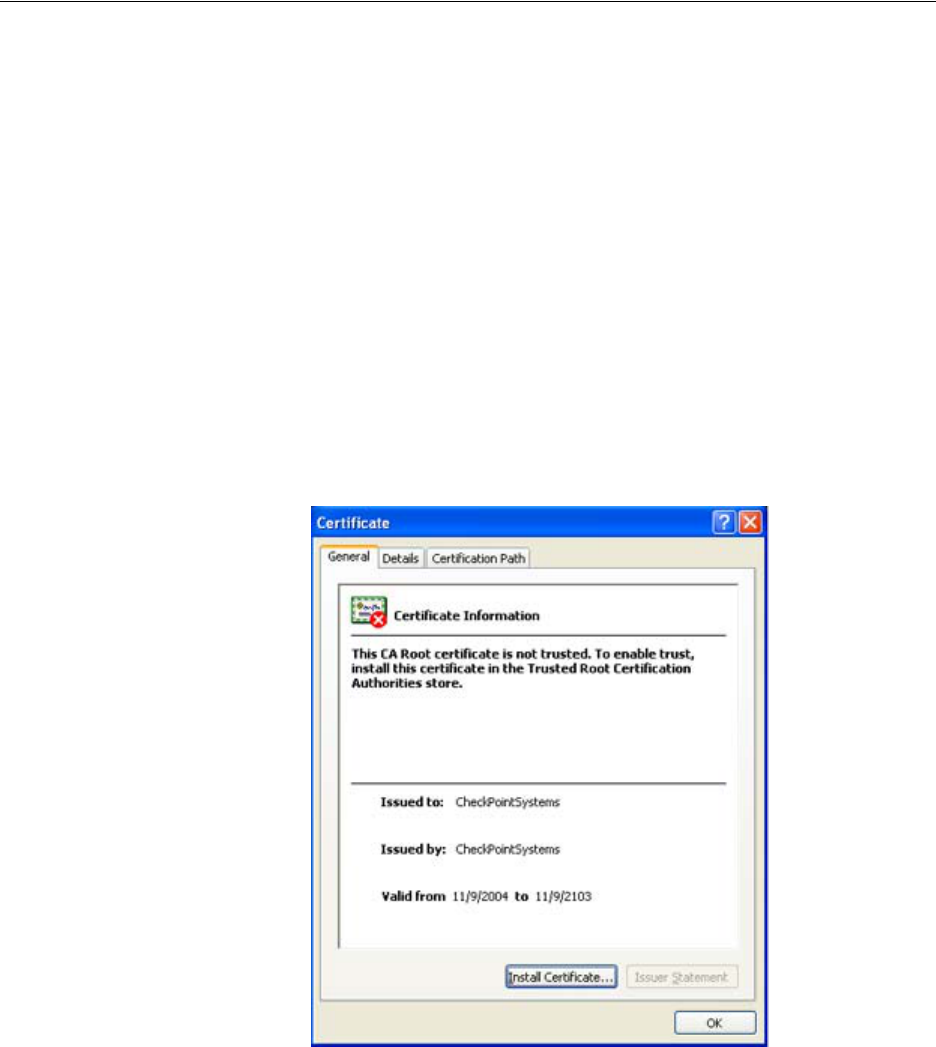
5-2 ILS 2.5 User Guide
Installing Web Site Certificate on a Client Computer
To establish a secure channel between the client computer and the Application Server, you
must install web site certificates on both the server and the client. You must renew the
server certificate yearly; you must install the client certificate only once, on each computer
on which you want to use ILS Remote Monitor.
Checkpoint Field Service personnel install the server certificates for you. You install the
client certificates.
You must install the certificate.cer client certificate onto each computer on which you
want to use ILS Remote Monitor. This establishes a secure channel between the client
computer and the Application Server.
To install the client certificate:
1Log on as a user with administrative rights to the client’s computer.
2Copy the checkpoint.cer file from the Application Server at e:\rfid\utilities\
Checkpoint Systems\Intelligent Library Remote Monitor\ to the client computer’s
desktop.
3Navigate to the desktop checkpoint.cer and double-click the file. The Certificate
window displays.
Figure 5.1
Certificate window
4Click Install Certificate (Figure 5.1). The Certificate Import Wizard displays.
5Click Next.
6In the Certificate Store window, select Automatically select the certificate store
based on the type of certificate. Click Next.
7When the certificate installation is completed, click Finish.
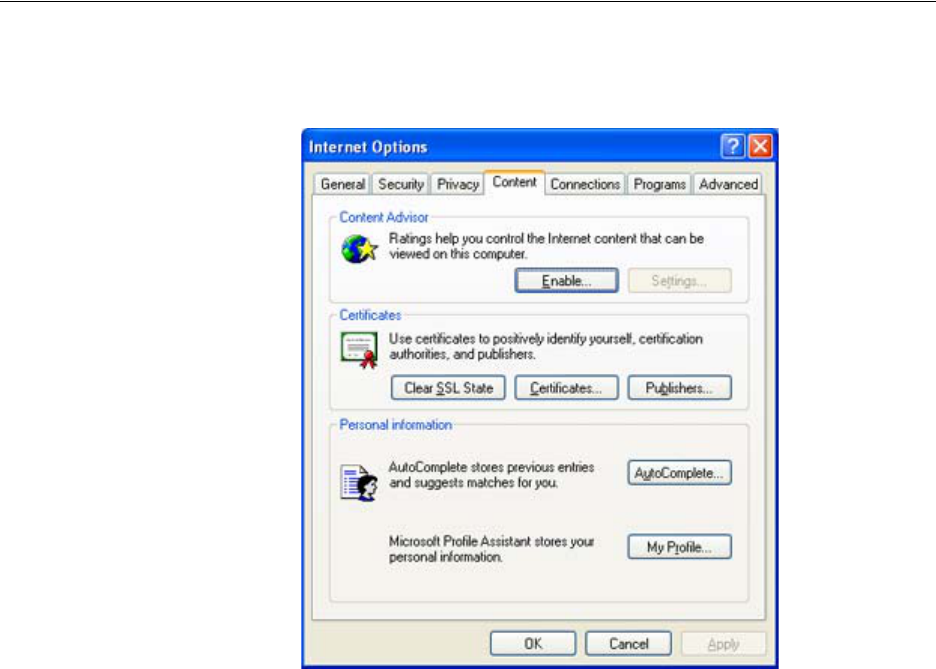
ILS Remote Monitor: Verifying Successful Certificate Installation 5-3
8Click Yes to add the certificate to the Root Store.
9Click OK to close all windows.
10 Repeat steps 1 through 8 on each client computer on which you want to use ILS
Remote Monitor.
Verifying Successful Certificate Installation
Use the following procedure to check that the certificate is correctly installed:
1Open a browser window.
2Select Tools > Internet Options....
Figure 5.2
Internet Options window
3Select the Content tab (Figure 5.2).
4Click Publishers....
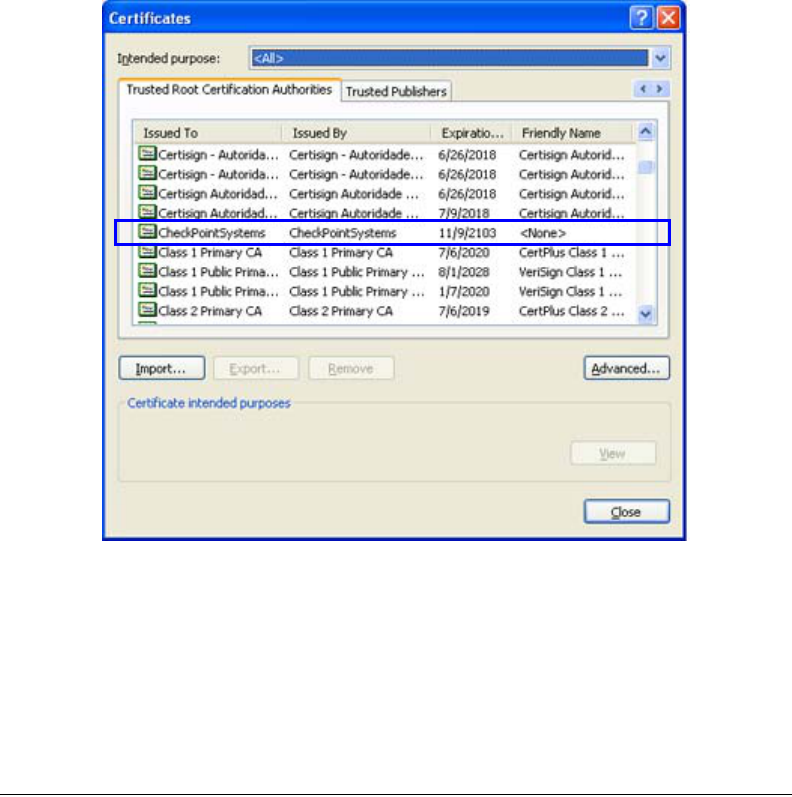
5-4 ILS 2.5 User Guide
The Certificates window displays:
Figure 5.3
Certificates window
5Select the Trusted Root Certification Authorities tab (Figure 5.3). Ensure that
CheckPointSystems is included in the list.
6If not, see “Installing Web Site Certificate on a Client Computer” on page 5-2.
7Close all windows.
Setting Hyperlink on Client’s Computer
This procedure indicates how to create a bookmark hyperlink on a client’s computer, so
that the user can easily access ILS Remote Monitor.
1On the client’s computer, launch Internet Explorer.
2In the URL bar, type https://<machine name of server>/ils/ and press Enter. For
example, https://rfidserver/ils/.
3Once the home page of ILS Remote Monitor loads, click Favorites > Add to
Favorites....
4Click OK to accept the default Name. The bookmark is now saved and accessible with
the Favorites menu.
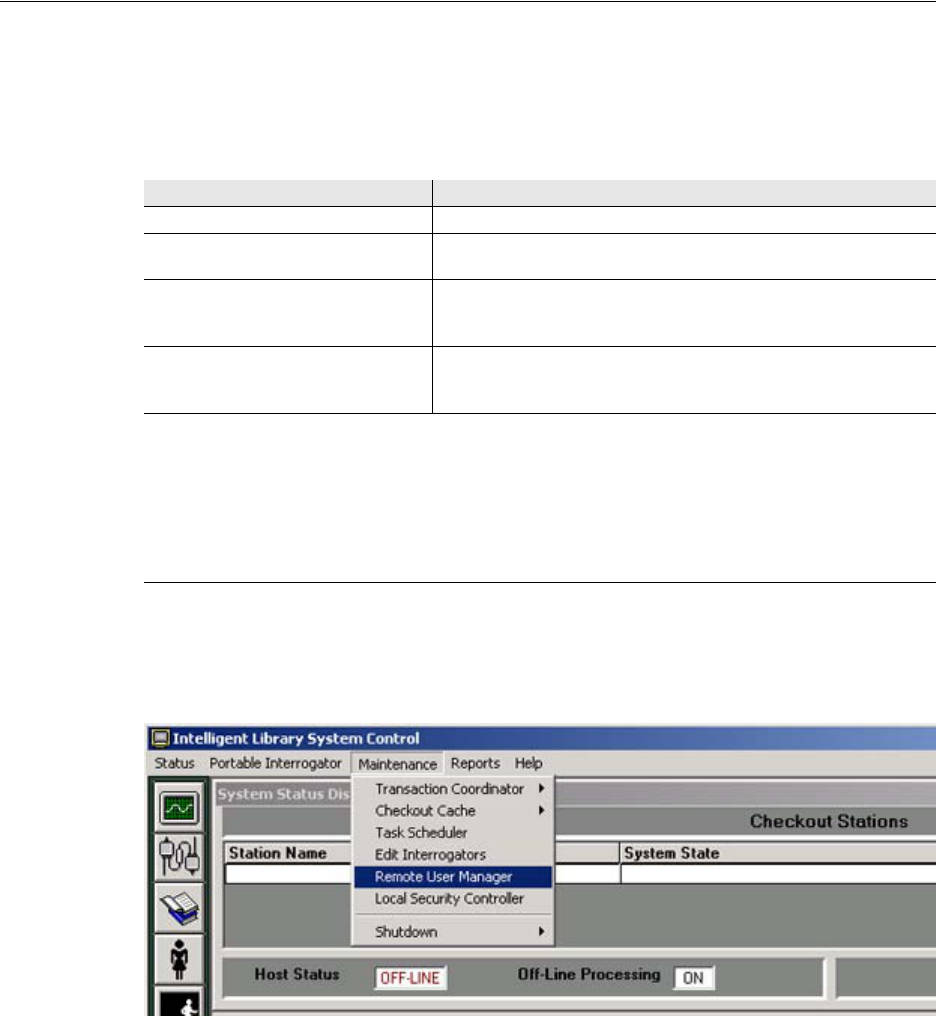
ILS Remote Monitor: Setting Up and Managing User Accounts 5-5
Setting Up and Managing User Accounts
The Remote User Manager utility lets you create and manage accounts that provide
access to the ILS Remote Monitor. The utility also lets you unlock accounts that have been
disabled as a result of incorrect username-password combinations.
Table 5.1 lists the access privileges you can assign to each user:
Users assigned the Remote Console access privilege see only the features they are
empowered to use. Users assigned Remote Report, Administrator, or Customer Service
access privileges see all ILS Remote Monitor features.
Adding a User Account
Take the following steps to add a user account to provide access to the ILS Remote
Monitor:
1In the Intelligent Library System Control window, select Maintenance > Remote
User Manager (Figure 5.4).
Figure 5.4
Select Remote User Manager
2Log on as ILSRemote, password remote123.
3Click Add (Figure 5.5).
4Type a user name and password.
Table 5.1
Remote User Manager Access Privileges
Access Privilege Description
Remote Console View status of any or all branches.
Remote Report Access all ILS Remote Monitor functions: view status, view and
print reports, upload inventory files.
Administrator Access all ILS Remote Monitor functions: view status, view and
print reports, upload inventory files. Access Application Server
operations.
Customer Service Access all ILS Remote Monitor functions: view status, view and
print reports, upload inventory files. Access Application Server
operations.
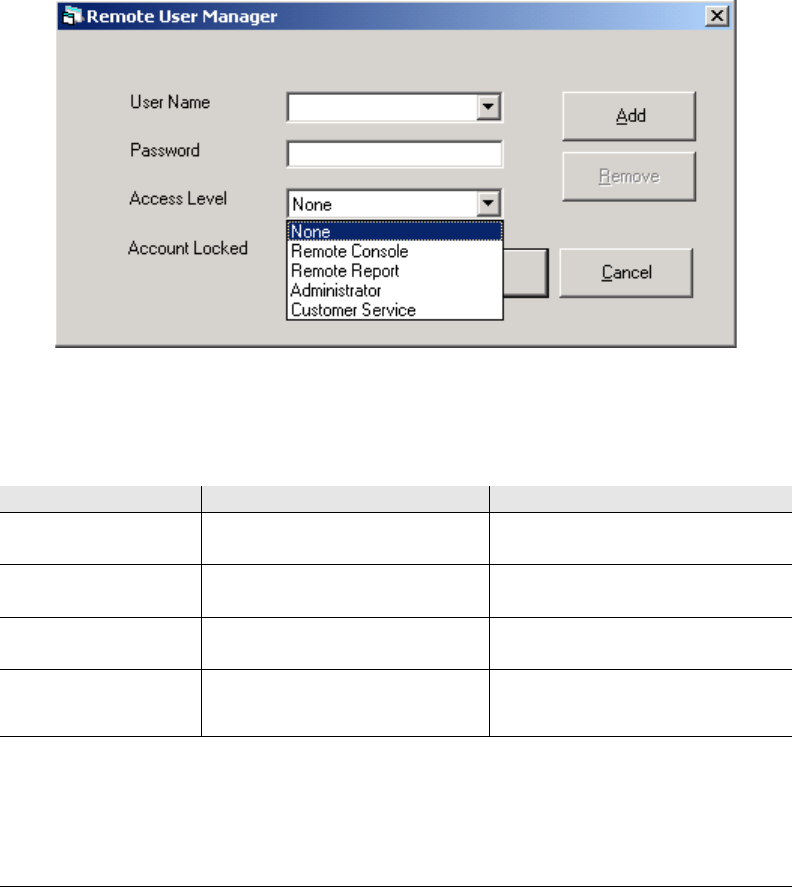
5-6 ILS 2.5 User Guide
Figure 5.5
Remote User Manager Access Levels
Select the Access Level privilege for the user (Figure 5.5).
Use only the first two selections for this setting.
5Click Save.
Modifying a User Account
Take the following steps to modify an existing ILS Remote Monitor account:
1In the Intelligent Library System Control window, select Maintenance > Remote
User Manager.
2Log on as Customer Service, user name of ils and password of maint.
3Select the user name to be modified.
4Make the necessary changes.
5Click Save.
Table 5.2
Access Level
Access Level Permission description Login
Remote Console View-only, cannot upload files, view
reports User: ILSRemote
Password: remote123
Remote Report Full Control, can upload files User: ILSReport
Password: report123
Administrator (Library
IT) Full Control, can upload files User: ils
Password: maint
Customer Service
(Checkpoint Field
Service)
Full Control, can upload files User: xxxxx
Password: xxxxx
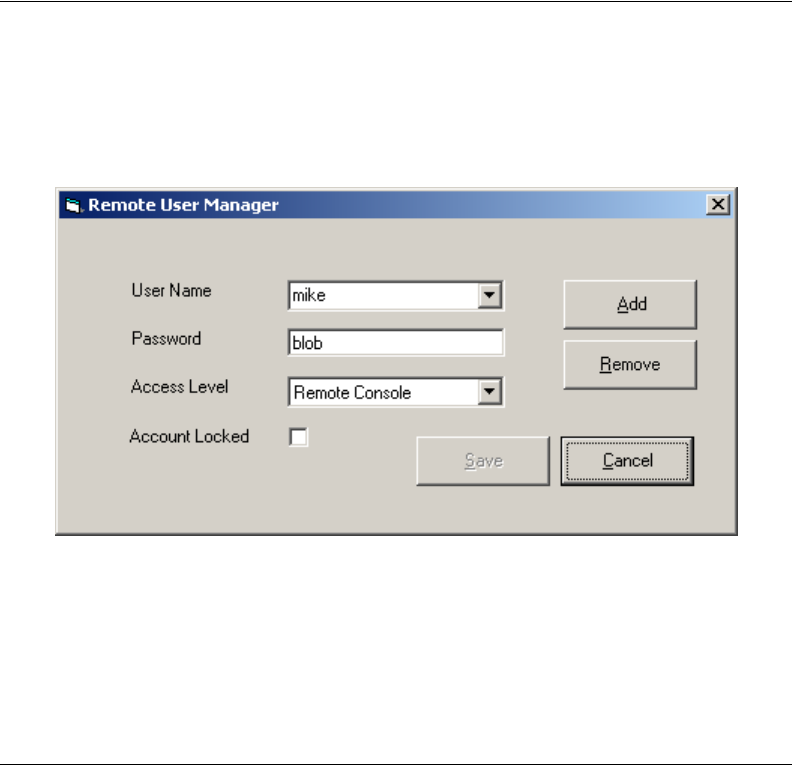
ILS Remote Monitor: Setting Up and Managing User Accounts 5-7
Removing a User Account
Perform the following steps to delete an existing ILS Remote Monitor account:
1In the Intelligent Library System Control window, select Maintenance > Remote
User Manager.
2Log on as Customer Service, user name of ils and password of maint.
Figure 5.6
Remove User Account
3Select the user name to be deleted (Figure 5.6).
4Click Remove.
5At the prompt, click Yes.
Unlocking a Locked Account
If an ILS Remote Monitor user enters an incorrect user name and password combination
three times, that user is prevented from logging on again until the account is unlocked in
the Remote User Manager.
Take the following steps to unlock a disabled user account:
1In the Intelligent Library System Control window, select Maintenance > Remote
User Manager.
2Log on as Customer Service, user name of ils and password of maint.
3Select the user name.
4Deselect the Account Locked check box.
5Click Save.
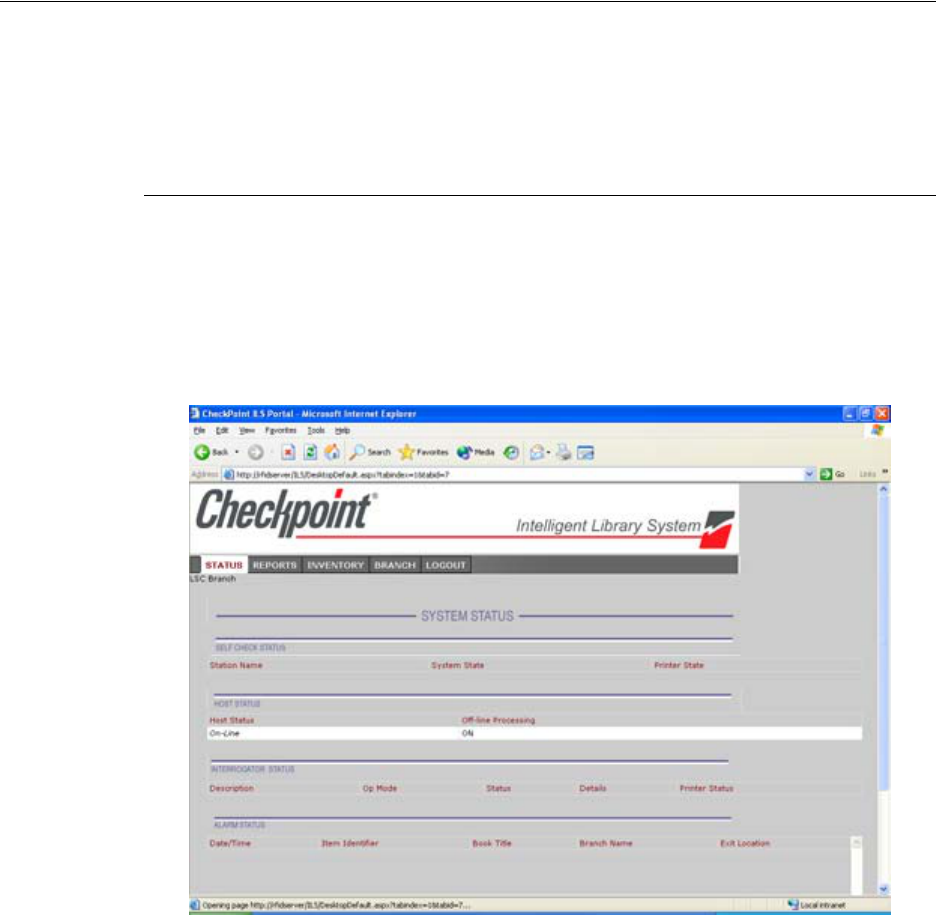
5-8 ILS 2.5 User Guide
Using ILS Remote Monitor
With the exception of starting up ILS Remote Monitor, the utility functions the same way
in both single server, multi-branch and peer-to-peer environments. To start up ILS Remote
Monitor, follow the instructions appropriate to your site’s environment.
Launching ILS Remote Monitor in a Single Server,
Multi-Branch Environment
To launch ILS Remote Monitor in a single server, multi-branch environment:
1Open a browser window.
2Type http://<machine name of server>/ils in the address bar and press Enter.
Optionally, use the saved bookmark in your Favorites menu.
3Enter your ILS Remote Monitor user name and password. The ILS Remote Monitor
utility displays (Figure 5.7).
Figure 5.7
ILS Remote Monitor main window
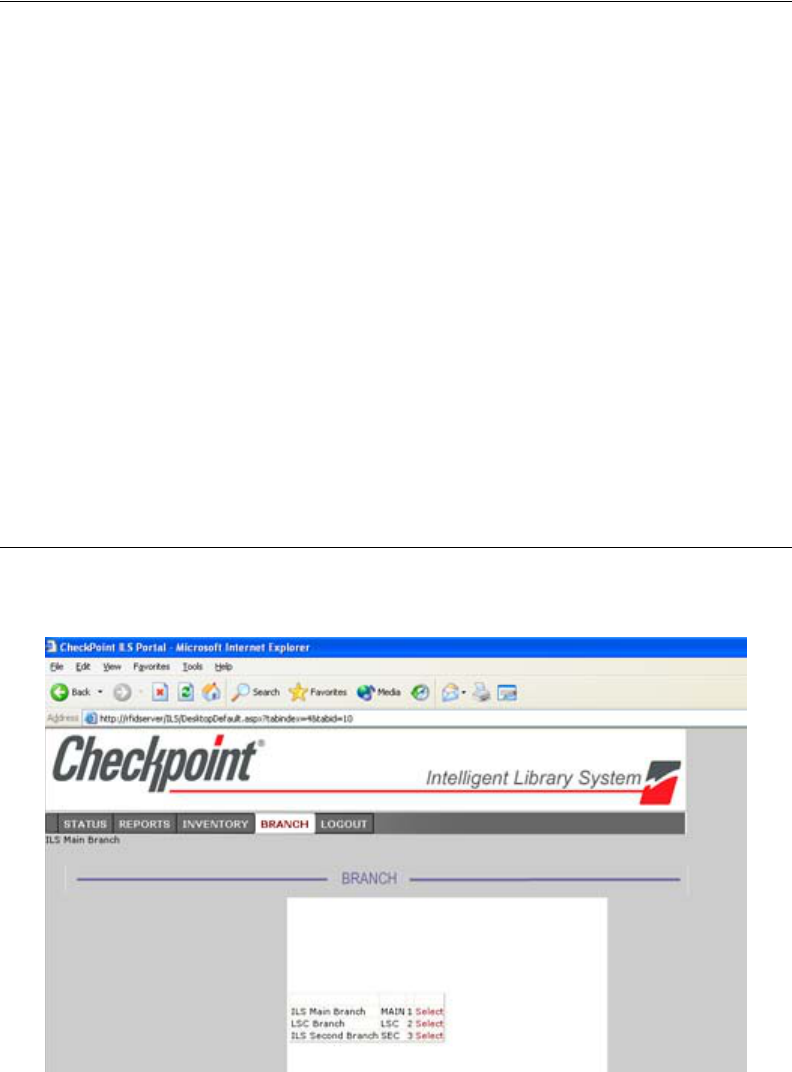
ILS Remote Monitor: Using ILS Remote Monitor 5-9
Using ILS Remote Monitor in a Peer-to-Peer Environment
ILS Remote Monitor enables you to determine the status of different servers in a
peer-to-peer environment. Depending upon the URL you enter, you can different view
peer servers in your network.
•To view information for your own branch, enter your branch’s server name of the
peer server in the browser’s address bar (example: https://rfidpeer1/ils).
•To view information for the other branches in the peer-to-peer environment, enter
the server name of the peer servers in the browser window’s address bar (example:
https://rfidpeer2/ils).
1Open a browser window.
2To see information for your local branch, type https://<machine name of server>/ils
in the address field, where machine name is the name of your Peer server. To see
information for another branch in the peer-to-peer environment, substitute that
branch’s peer server name in the address bar. For example: https://rfidpeer1/ils/.
3Press Enter.
4Enter your ILS Remote Monitor user name and password. The ILS Remote Monitor
utility displays (Figure 5.7).
Changing Branch Views
To view information for a different branch:
1Click the Branch tab.
Figure 5.8
Select Branch
2Click Select beside the branch whose information you want to view (Figure 5.8).
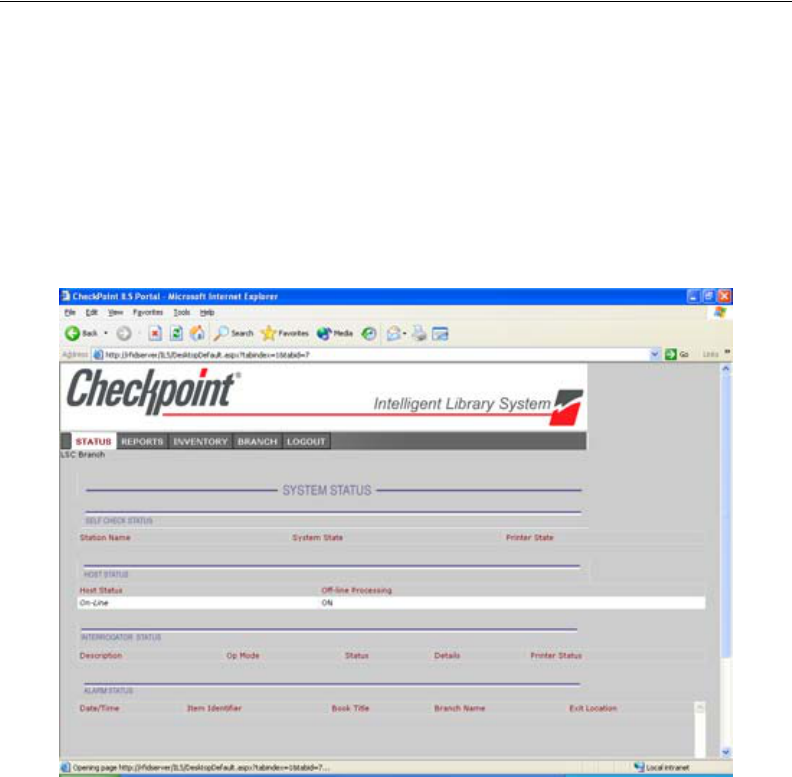
5-10 ILS 2.5 User Guide
Viewing Status
The Status page lists the information of the currently selected Branch and all the
components connected to the server. The following components’s health (status) can be
monitored:
• Self-Checkout Stations
• Library Management System connection
• Interrogators
•Alarms
To view the status of a branch, click on the Status tab.
This is the default view. To change to a different branch, see “Changing Branch
Views” on page 5-9.
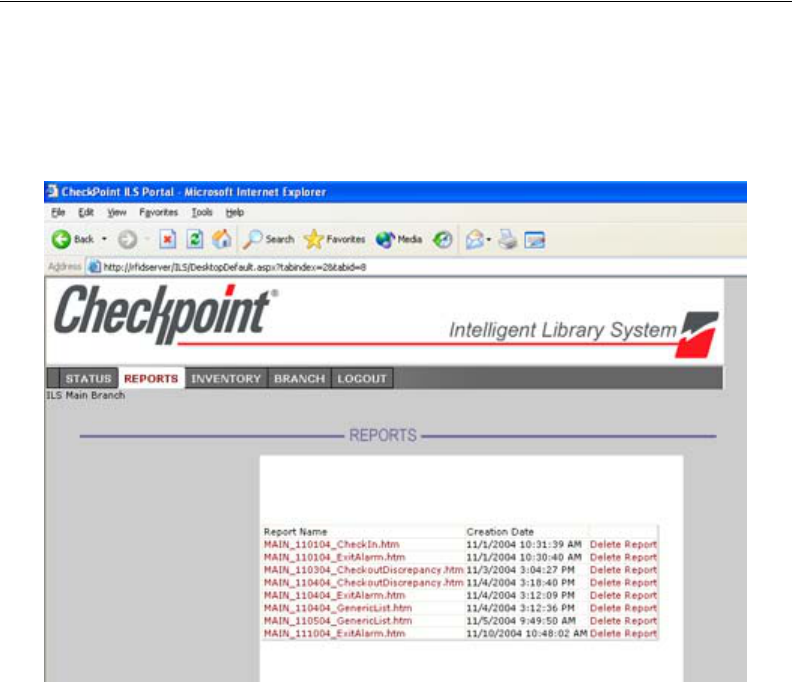
ILS Remote Monitor: Using ILS Remote Monitor 5-11
Viewing and Printing Reports
Reports cannot be generated by using ILS Remote Monitor to log in to the Application
Server. You can only generate reports from the Application Server, and then once
generated, view those reports with ILS Remote Monitor.
To view pre-run reports for a selected branch:
1Click the Reports tab.
Figure 5.9
View Reports
2To view the report, click the desired report name (Figure 5.9). When viewing a report,
you can return to the list of reports by clicking the Reports tab.
3To print a report, use the browser’s Print feature. To see all the data, print reports in
Landscape orientation. (In Internet Explorer, select File > Page Setup... and select
Landscape orientation.)
4To delete a report, click Delete Report beside the report name.
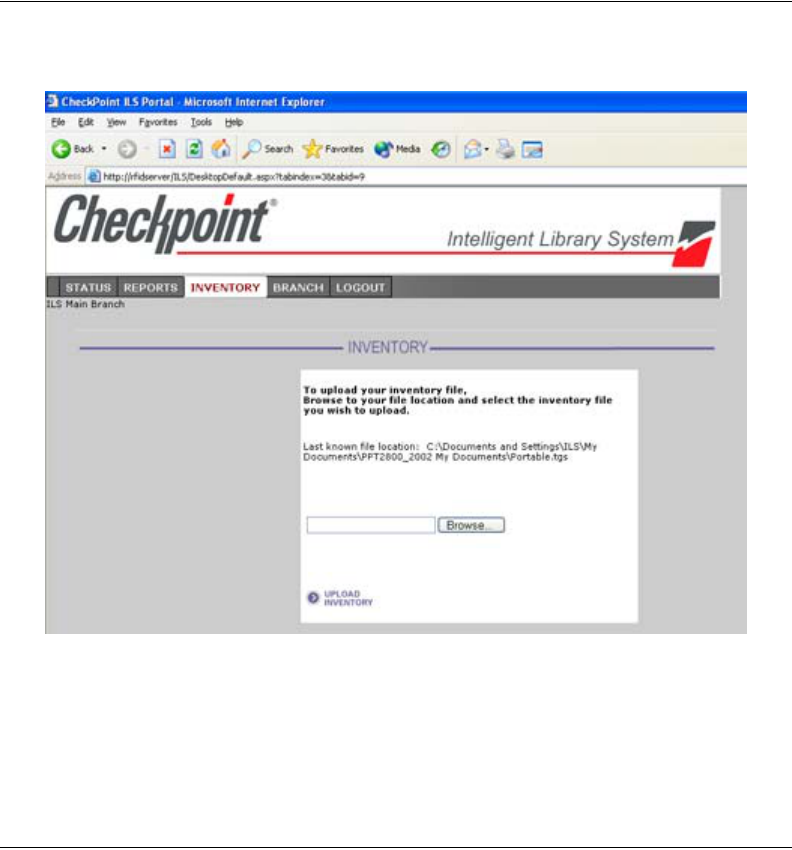
5-12 ILS 2.5 User Guide
Uploading Portable Inventory Reader inventory files
To upload a Portable Inventory Reader inventory file to the Application Server:
1Click the Inventory tab.
Figure 5.10
Upload Inventory
2Enter the inventory file name, or click Browse to navigate to the inventory file (Figure
5.10).
3Click Upload Inventory.
Logging out
To log out of ILS Remote Monitor:
1Click the Logout tab. You will be logged out and have to log back in to use the utility.
2See “Using ILS Remote Monitor” on page 5-8 for instructions on logging in to ILS
Remote Monitor.

Exception Ticket Printer: Introduction 6-1
CHAPTER
C
HAPTER
0
E
XCEPTION
T
ICKET
P
RINTER
This chapter explains the function of the exception ticket printer, and provides instructions
for using the printer. This feature is optional; your site may not use the exception ticket
printer.
The chapter covers the following topics:
• Introduction (page 6-1)
• Printer layout (page 6-2)
• Using the exception ticket printer (page 6-3)
• Setting the printer’s cut type (page 6-4)
• Inserting paper (page 6-5)
• Running a Self-Test on the exception ticket printer (page 6-6)
• Installing the cover (page 6-6)
• Error codes (page 6-7)
• Troubleshooting (page 6-8)
• Removing jammed paper (page 6-8)
• Cleaning the print head (page 6-9)
• Printer specifications (page 6-9)
Introduction
The exception ticket printer is usually located near the library’s book drop, and its sole
function is to print a receipt when incoming library material has been placed “on hold” by
the Library Management System. This receipt can then be placed in the library material by
library staff, to ensure that the material is directed to the appropriate location, instead of
being returned to circulation.
One exception ticket printer can service multiple interrogators. This means that a receipt
might print at the exception ticket printer near Drop Box A for a book that is returned at
Drop Box B. As a result, you may have to search more than one drop box to find the
library material that matches the receipt.
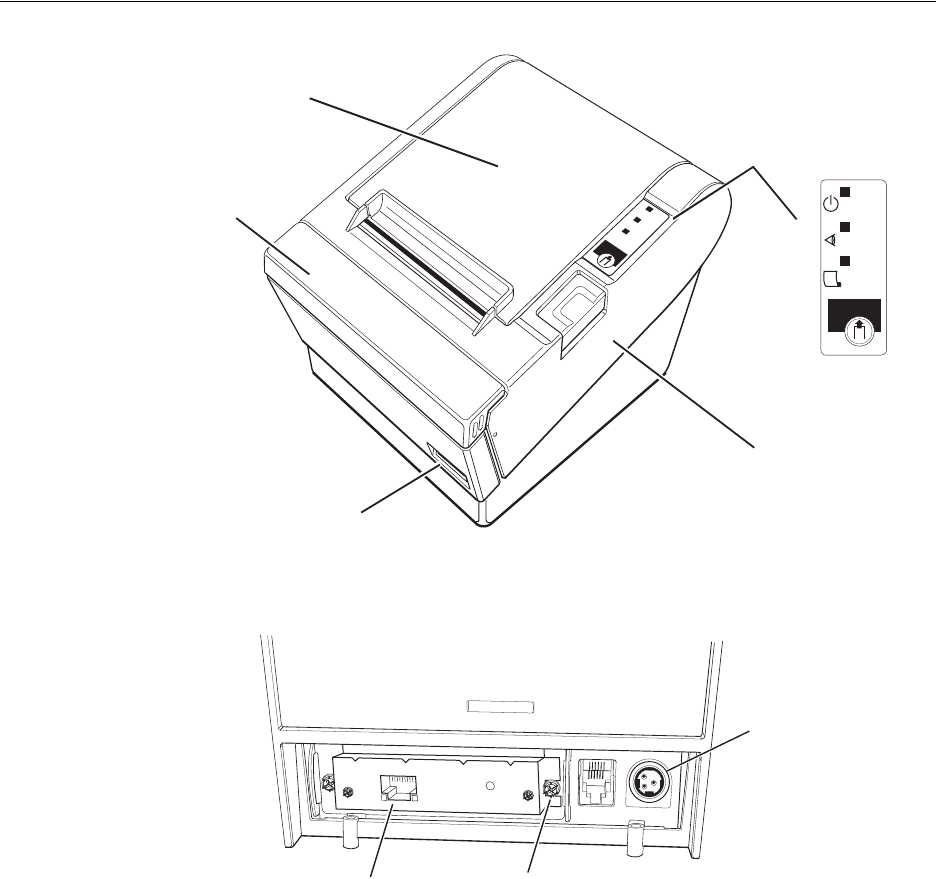
6-2 ILS Open Plus 3.0 Installation Manual
Printer Layout
Figure 6.1 and Figure 6.2 show the layout of the printer and its back panel.
Figure 6.1
Top of Printer
Figure 6.2
Printer Back Panel
ERROR
POWER
PAPER
OUT
FEED
ERROR
POWER
PAPER
OUT
FEED
Printer Cover
Cutter Cover
Cover Open Button
Control Panel LED
On/Off Switch
DK
DC24V
FG
FG
10/100BASE-TX
Power Supply
Connection
Ground ScrewEthernet
Connection

Exception Ticket Printer: Using the Exception Ticket Printer 6-3
Control Panel
Using the Exception Ticket Printer
If the Library Management System has placed a “hold” on a particular book (or other
piece of library material), the check-in of that material triggers the exception ticket printer
to print a receipt.
1Periodically check the exception ticket printer for receipts.
2Retrieve the receipts and place them in the designated library materials that have been
recently checked in. If an exception ticket printer is servicing multiple interrogators,
you may have to search more than one drop box to find the library material that
matches the receipt.
3Follow your site’s procedures for handling “on hold” materials.
Power LED: The POWER light is on when the printer is on.
Error LED: Indicates an error.
Paper Out LED: On indicates a paper near end or out. Flashing indicates standby.
Feed button: This button feeds paper or starts a self-test.
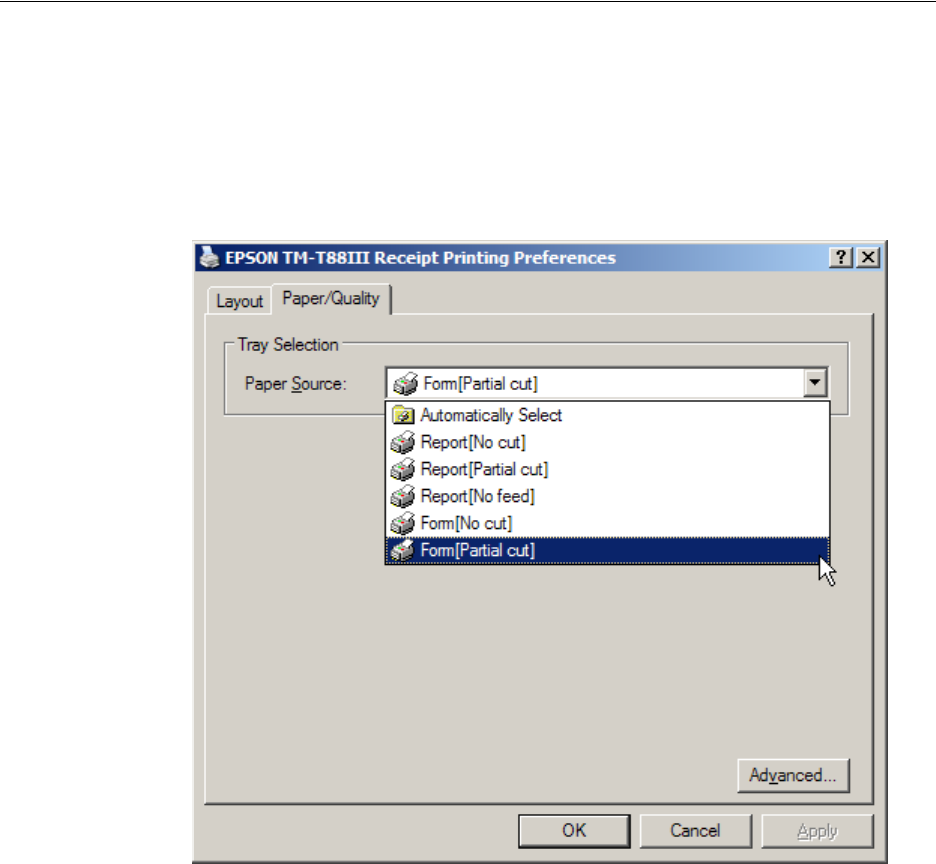
6-4 ILS Open Plus 3.0 Installation Manual
Setting the Printer’s Cut Type
Checkpoint Systems recommends that you set up the printer to do a partial cut of the
paper. This produces a string of receipts, which can be easily separated, rather than
individual receipts, which might fall and be lost.
1On the computer you used to set up the printer, click Start > Settings > Printers and
right-mouse click the Epson printer.
2Select Printing Preferences.
3Select the Paper/Quality tab.
Figure 6.3
Partial Cut Select
4From the Paper Source drop-down menu, select Form[Partial cut]. This sets the
printer to only partially cut the receipt.
5Click OK to save your selection and close the window.
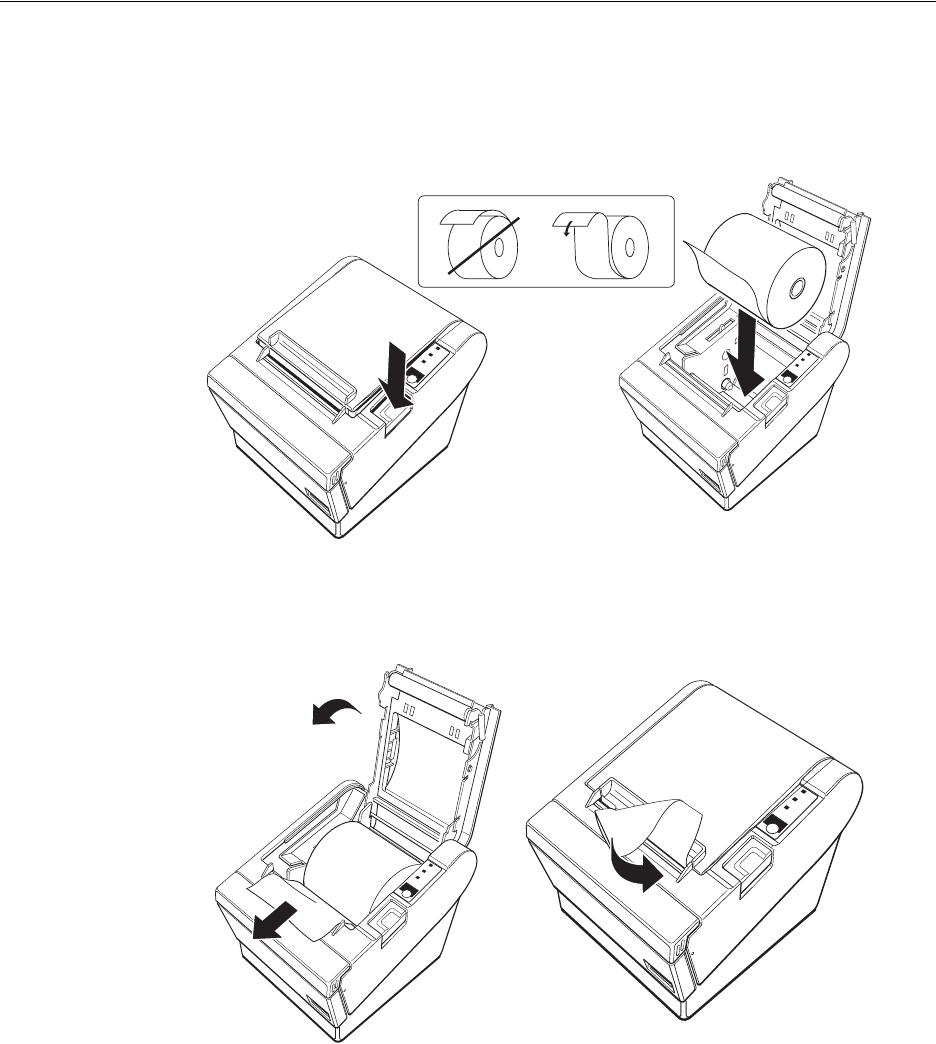
Exception Ticket Printer: Inserting Paper 6-5
Inserting Paper
Take the following steps to add paper to the exception ticket printer:
1Be sure that the printer is not receiving data. Press the Cover Open button to open the
cover.
2If present, remove any used paper roll core. Insert the paper roll in the correct direction,
as shown in Figure 6.4.
Figure 6.4
Insert Paper
3Pull out a small amount of paper, as shown in Figure 6.5. Then close the cover and tear
off the extra paper by pulling it toward the front of the printer.
Figure 6.5
Tear Paper
ERROR
POWER
PAPER
OUT
FEED
FEED
ERROR
POWER
PAPER
OUT
FEEDFEED
Cover Open
ERROR
POWER
PAPER
OUT
FEEDFEED
ERROR
POWER
PAPER
OUT
FEEDFEED
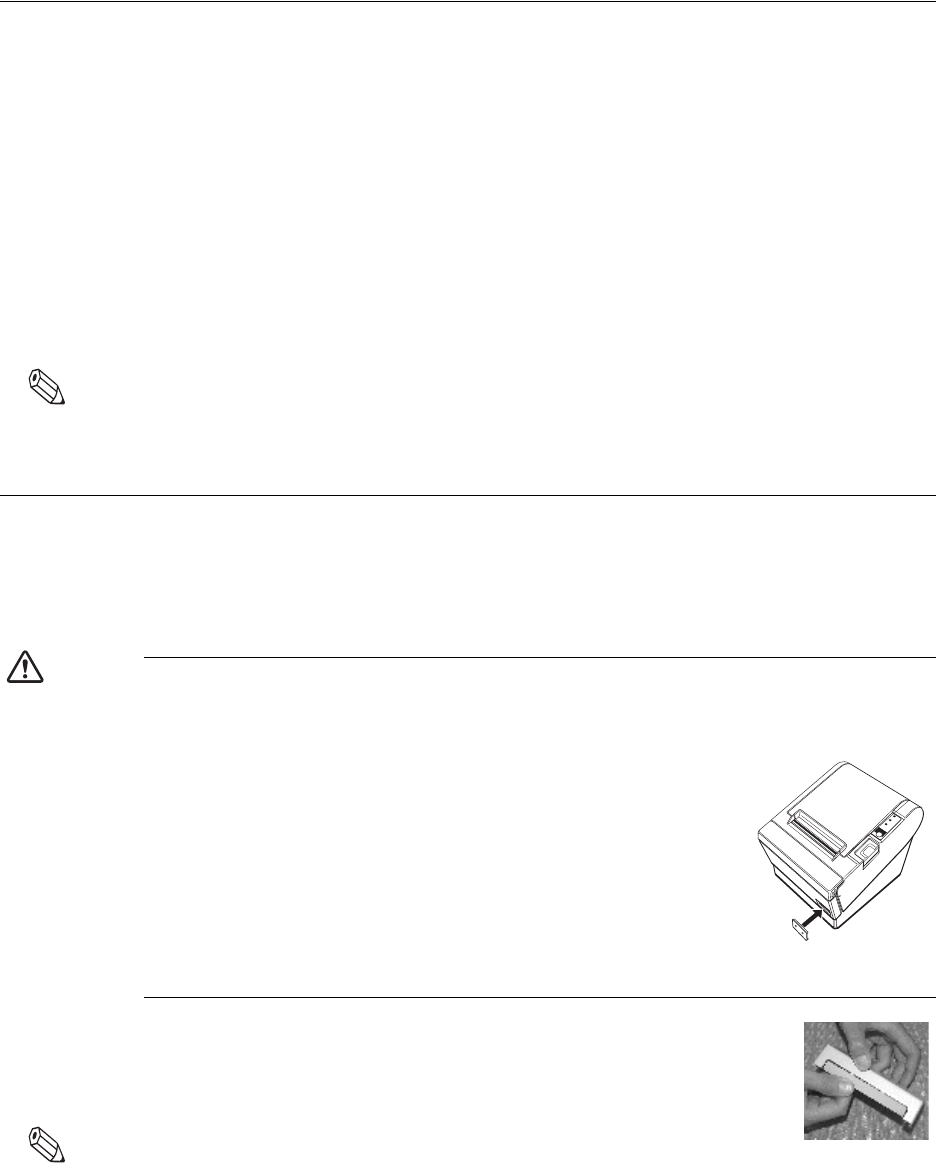
6-6 ILS Open Plus 3.0 Installation Manual
Running a Self-Test
Follow these steps to run a self-test on the paper roll:
1Be sure that the printer is off and that the printer cover is closed properly.
2Hold down the Feed button and turn on the printer using the switch on the front of the
printer. This may take some time, so continue holding the Feed button until it prints.
3The self-test prints the printer settings and then prints the following:
If you want to continue SELF-TEST printing,
Please press the PAPER FEED button.
Cuts the paper, and pauses. (The Power Out light flashes.)
4Press the Feed button to continue printing. The printer prints a pattern using the
built-in character set.
5The self-test automatically ends and cuts the paper after printing “
*** completed ***
.”
The printer is ready to receive data as soon as it completes the self-test.
Note: To pause the self-test manually, press the Feed button. Press Feed again to continue the self-test.
Installing the Cover
There are two covers that can be used to protect the printer from unnecessary interaction: a
power switch cover and a connector cover. Using these covers are optional, depending
upon the needs of the library.
Installing a Power Switch Cover
Warning If an accident occurs with the power switch cover attached, unplug the power cord immediately.
Continued use may cause fire or shock.
The enclosed power switch cover ensures that the power switch is
not pressed accidentally. To use this cover:
1Insert the lower end of the cover into the slot around the switch.
2Rotate the cover upwards until it snaps into place.
3To remove the cover, use a flat bladed screwdriver to lever the
cover off.
Installing a Connector Cover
The connector cover protects your cables. To attach it:
1First, connect all the cables. The connector cover has three possible
cable exits: on the right, left, and back. Remove the tab for the exit
you want to use by breaking it off with your fingers.
Note: Once you remove a tab, you cannot replace it.
2After removing the tab, also remove any protruding plastic, so that the edge is smooth
and does not damage the cables.
ERROR
POWER
PAPER
OUT
FEED
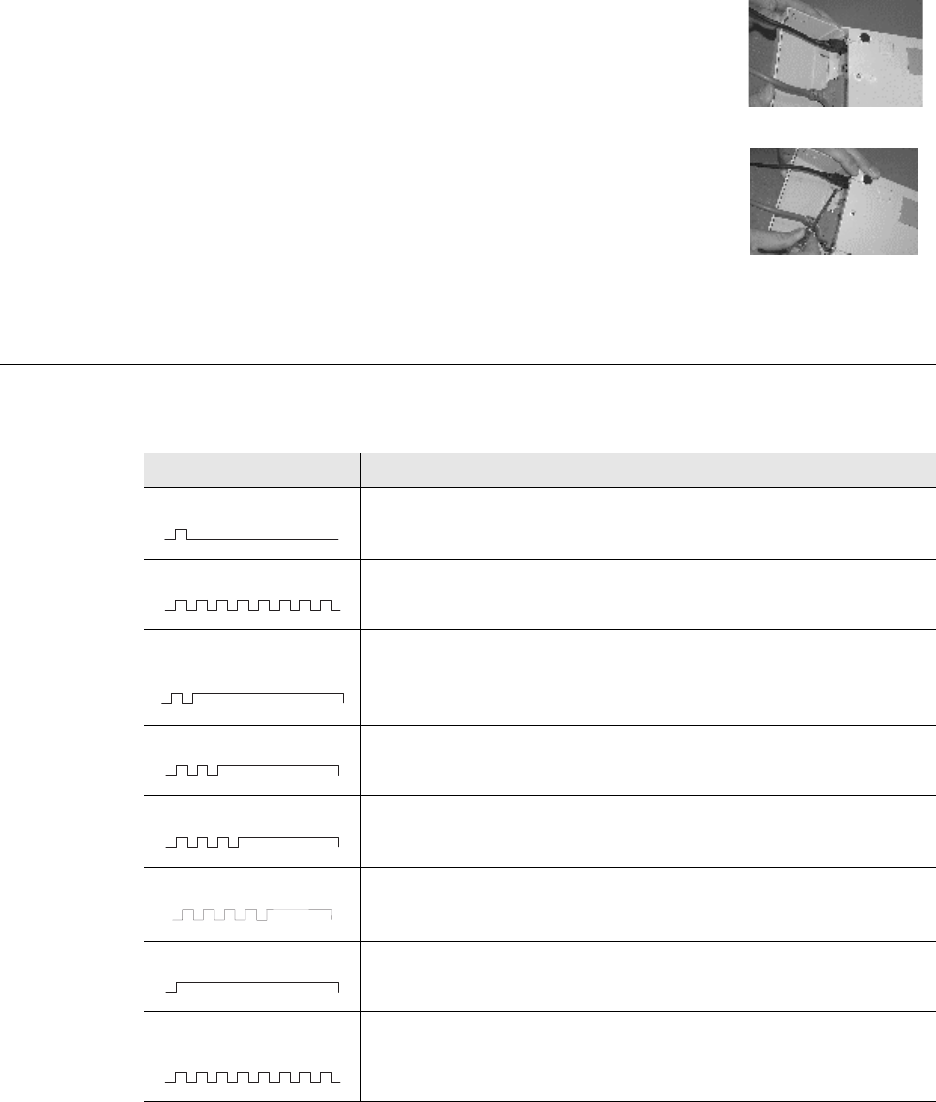
Exception Ticket Printer: Error Codes 6-7
3Position the two hooks on the connector cover so that they
hook the printer case.
4Rotate the connector cover into the printer until it clicks into
place.
To remove the connector cover:
1Turn the printer over, insert a flathead screwdriver under one
hook, and pry up the hook while lifting the connector cover.
See the illustration on the right below.
2Repeat this step for the other side and remove the cover.
Error Codes
The Control Panel LED displays the following patterns when certain error conditions are
met.
Attaching cover
Removing cover
LED Pattern Solution
Autocutter error Check for paper jam in the autocutter. If problem continues, contact
Checkpoint field service.
Cover open error Close cover.
Memory or gate array
error Contact Checkpoint field service.
High voltage error Replace power supply unit. If problem continues, contact Checkpoint field
service.
Low voltage error Replace power supply unit. If problem continues, contact Checkpoint field
service.
CPU execution error Contact Checkpoint field service.
Internal circuit error Contact Checkpoint field service.
High head
temperature error If you exceed the printer duty cycle, the head overheats. When it cools, the
error clears. If this error occurs and you have not been printing for very long,
check that the ambient temperature is within “Specifications” on page 6-9.
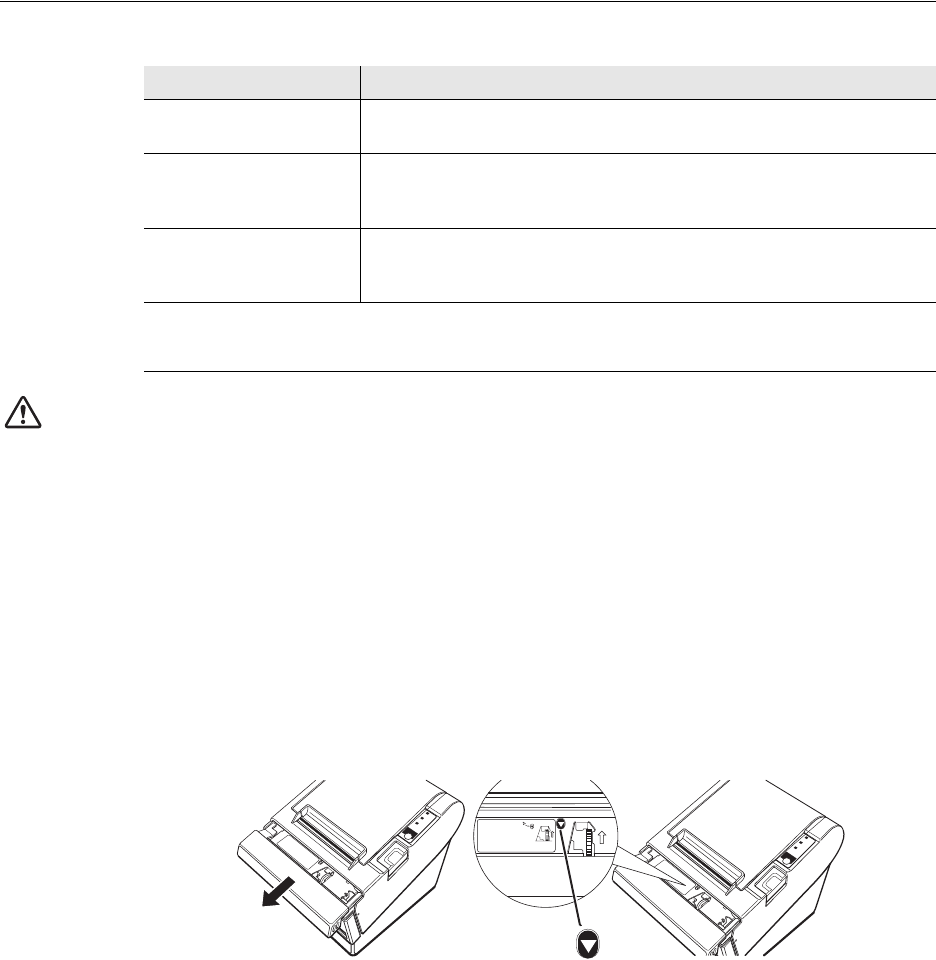
6-8 ILS Open Plus 3.0 Installation Manual
Troubleshooting
The following table lists solutions to issues that might arise.
Removing Jammed Paper
Caution Do not touch the print head because it can be very hot after printing.
Take the following steps to remove jammed paper from the printer:
1Turn the printer off and press the Cover Open button.
2Remove jammed paper, reinstall the roll, and close the cover.
Removing an Autocutter Jam
Follow these steps to remove paper jammed in the autocutter:
1If paper is caught in the cutter and you cannot open the printer cover, open the cutter
cover as shown on the left in Figure 6.6.
2Turn the knob until you see a triangle in the opening, as shown on the right in Figure
6.6. This returns the cutter blade to the normal position. There is a label near the cutter
to assist you.
Figure 6.6
Removing an Autocutter Jam
3Close the cutter cover.
4Open the printer cover and remove the jammed paper.
Condition Solution
No lights on the
control panel Check the power supply cable connections and the power outlet.
ERROR light on (not
flashing) with no
printing
• If PAPER OUT is on, the paper roll is not installed or is near the end.
• If PAPER OUT is off, the printer cover is not closed properly.
ERROR light flashing
with no printing (and
no paper jam)
Printing stops if the head overheats and resumes when it cools. Turn the
printer off, and after 10 seconds, back on.
ERROR
POWER
PAPER
OUT
FEED
ERROR
POWER
PAPER
OUT
FEED
FEED
ADJUSTMENT:
TURN KNOB
TURN KNOB
UNTIL YOU SEE
UNTIL YOU SEE
TRIANGLE IN OPENING
TRIANGLE IN OPENING
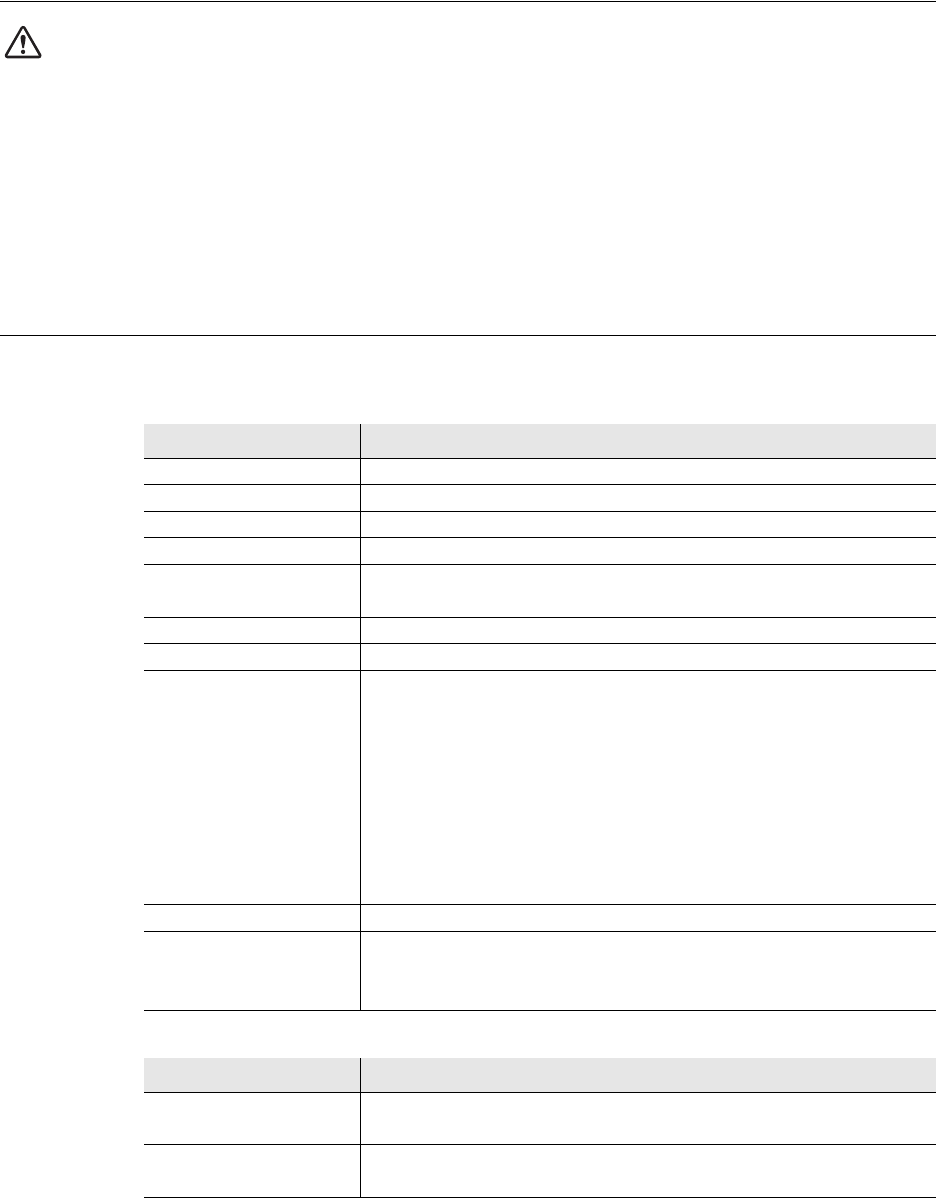
Exception Ticket Printer: Cleaning the Print Head 6-9
Cleaning the Print Head
Caution After printing, the print head can be very hot. Be careful not to touch it, and to let it cool before you
clean it. Do not damage the print head by touching it with your fingers or any hard object.
Take the following steps to clean the print head:
1Turn off the printer, open the paper roll cover, and clean the thermal elements of the
print head with a cotton swab moistened with an alcohol solvent (ethanol, methanol, or
IPA).
2Checkpoint Systems recommends that you clean the thermal head periodically
(generally every 3 months) to maintain receipt print quality.
Specifications
The following lists specifications regarding printing specifications.
Table 6.1
Printing Specifications
Item Description
Printing Methods Thermal line printing
Dot density 180 dpi × 180 dpi (dpi = dots per inch {25.4 mm})
Print width 2.83" {72 mm}, 512 dot positions
Characters per line Font A: 42; font B: 56 (default)
Character structure Font A: 12 × 24 (including 2-dot spacing)
Font B: 9 × 17 (including 2-dot spacing)
Character spacing 0.01" {0.28 mm} = 2 dots, default
Print direction Unidirectional with friction feed
Print speed High-speed mode
• 5.9"/sec. {150 mm/sec.} maximum
• 47.2 lps maximum at 1/8" feed
• 35.5 lps maximum at 1/6" feed (at 24 V, 82.4°F {28°C}, density level 1)
Low-power-consumption mode
• Approximately 16.5 lps at 1/6" feed
• Approximately 2.76"/s {70 mm/s}
Ladder bar code
• 1.7"/s {42 mm/s}
Paper-feed speed 5.9"/s {150 mm/s} continuous feeding
Character sets • alphanumeric: 95 characters
• international: 37 characters
• extended graphics: 128 characters × 8 pages (including a space page)
Table 6.2
Environmental Conditions
Item Description
Temperature range • Operating 41 to 113°F {5 to 45°C}
• Storage 14 to 122°F {–10 to 50°C}
Humidity range • Operating 10 to 90% RH
• Storage 10 to 90% RH
6-10 ILS Open Plus 3.0 Installation Manual
Notes

CheckVIEW: 7-1
CHAPTER
C
HAPTER
0
C
HECK
VIEW
This chapter describes the CheckVIEW utility and provides instructions for:
• Using CheckVIEW (page 7-3)
• Reinstalling missing files (page 7-6)
• Uninstalling CheckVIEW (page 7-6)
• Using CheckVIEW to shut down a monitored Self-Checkout Station (page 7-6)
• Troubleshooting information (“CheckVIEW Troubleshooting” on page 12-9).
The CheckVIEW utility enables library staff to remotely view up to four different
Self-Checkout Station at one time. From any computer on the library’s network, staff
members are able to see exactly what the patrons see as they use the Self-Checkout Station
to checkout materials. This enables library staff to manage issues such as:
• Patrons who are having difficulty using the touch screen
• Stations that may have hardware or system problems
• Viewing the patrons’ checkout list to reconcile any discrepancies concerning
availability
Staff members use their mouse and keyboard to assist patrons by assuming control of a
specific Self-Checkout Station window to step a patron through a check out procedure.
There are two modes a library staff member can use to aid a patron, Monitor mode and
Host mode. Monitor mode allows the staff member to watch up to four Self-Checkout
Stations. Once a problem is identified, Host mode enables you to interact directly with a
particular Self-Checkout Station and guide the patron.
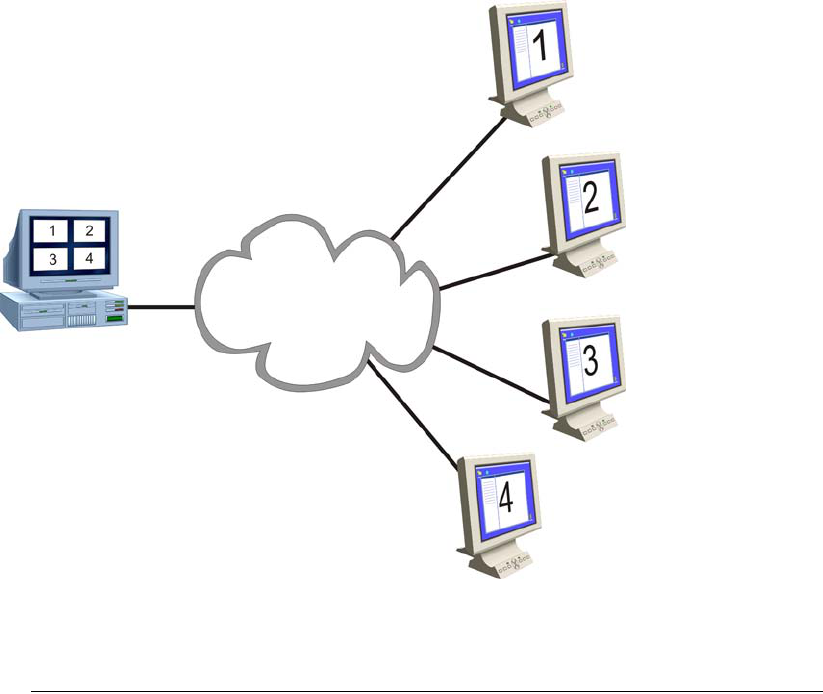
7-2 ILS Open Plus 3.0 Installation Manual
The VNC server application must be installed on every Self-Checkout Station that is to be
monitored by the library staff’s computer. TCP/IP network connectivity to the
Self-Checkout Stations is required for monitoring Self-Checkout Stations.
Figure 7.1
CheckVIEW Network Diagram
Staff Computer Requirements
The following are the minimum requirements for using CheckVIEW:
• Windows 2000 or XP
• 800 MHz Pentium III or equivalent processor
• 256 MB RAM
• 17 Inch Monitor
• Screen resolution of 1024x768
• Network Requirement of 100 MB Ethernet
Intranet
(High Speed LAN)
Computer running
VNC Viewer in Monitor
mode
Self-Checkout Station
running CheckVIEW
Self-Checkout Station
running CheckVIEW
Self-Checkout Station
running CheckVIEW
Self-Checkout Station
running CheckVIEW
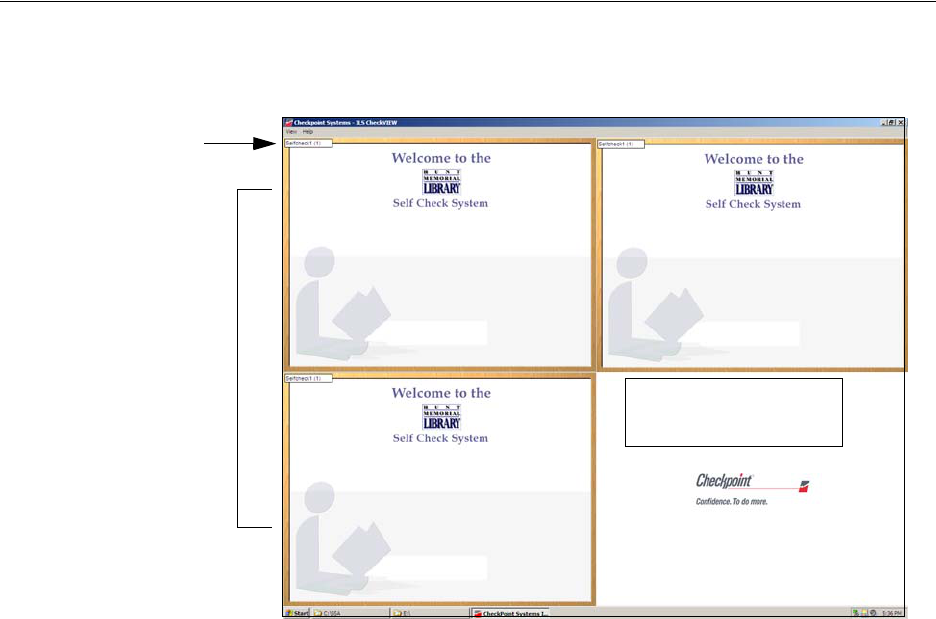
CheckVIEW: Using CheckVIEW in Monitor Mode 7-3
Using CheckVIEW in Monitor Mode
To launch the CheckVIEW application, select Start > Programs > Checkpoint
Systems > CheckVIEW Monitor from the library staff’s computer. The default main
page appears in Monitor mode with up to four Self-Checkout Stations displayed.
Figure 7.2
Monitor mode from CheckVIEW
You can easily determine the status of up to four Self-Checkout Stations by looking at the
CheckVIEW window. See below for instructions on how to assist a Self-Checkout Station.
Monitoring mode showing
three active Self-Checkout
displays.
This area is empty. A fourth
Self-Checkout appears here
when active.
Name of
Self-Checkout
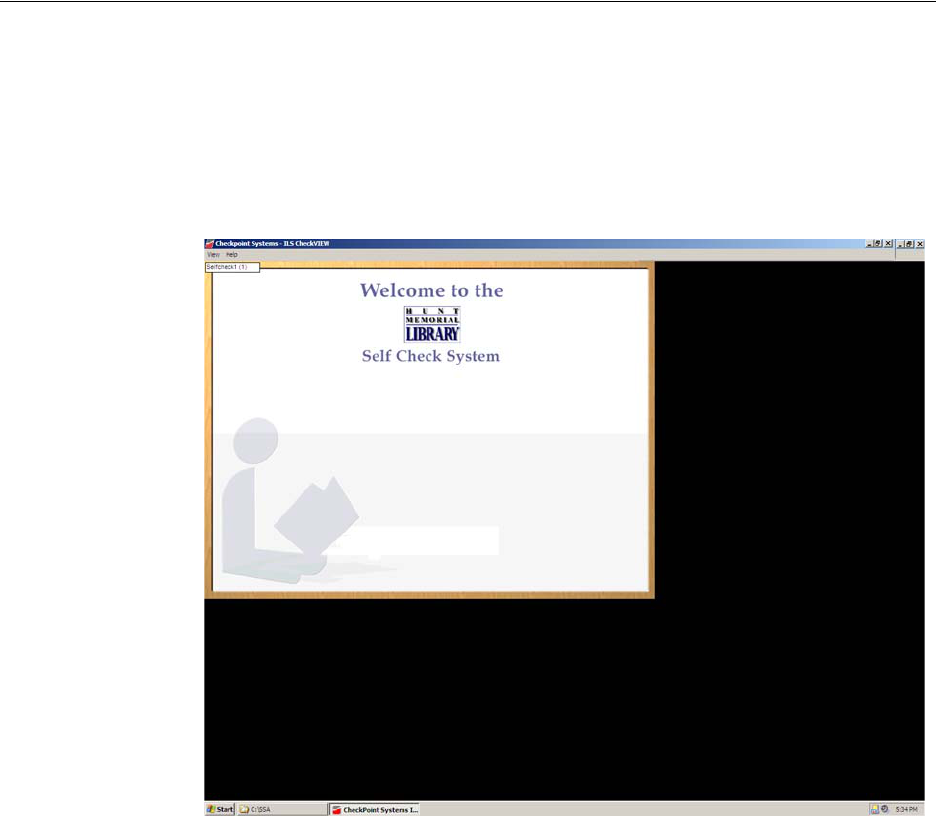
7-4 ILS Open Plus 3.0 Installation Manual
Using CheckVIEW in Host Mode
To gain access to a specific Self-Checkout Station to assist a patron:
1Select View from the menu.
2Select one of the Display (1-4) options. You can also press Ctrl+1-4 using your
keyboard to access a Self-Checkout Station.
Access to the window is shared between the staff member and the patron. The
Self-Checkout Station window reacts to the most recent command by either the patron
or the staff member.
Figure 7.3
Assist mode as seen from CheckVIEW
3Assist the patron as necessary with your keyboard and mouse.
4To return CheckVIEW to Monitor mode, select View > All or press Ctrl+A.
5To close the application, click the X in the upper right hand corner of the window or
select View > Close.
Adding/Removing Self-Checkout Stations to CheckVIEW
A settings.xml file is configured to add or remove the Self-Checkout Stations.
1Launch Windows Explorer and navigate to C:\Program Files\Checkpoint
Systems\CheckVIEW Monitor\.
2Open the Settings.xml file with Notepad.
aRight-mouse click Settings.xml.
bSelect Open With... and choose Notepad from the list of programs.
Assist mode. The
CheckVIEW computer is
actively involved with the
Self-Checkout Station.
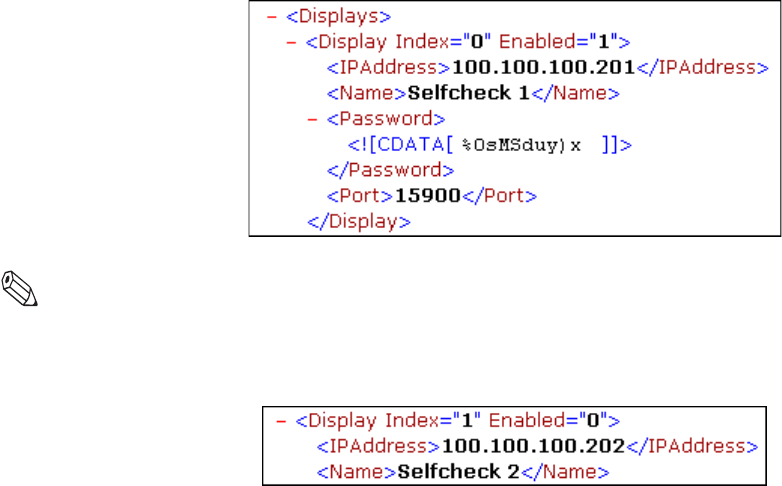
CheckVIEW: Using CheckVIEW in Host Mode 7-5
3To add a Self-Checkout Station so that it displays in CheckVIEW, enter 1 where it
states Enabled, next to Display Index. See Figure 7.4, “Self-Checkout Station
Monitoring Enabled.”
Figure 7.4
Self-Checkout Station Monitoring Enabled
Note: Enable only those Self-Checkout Station you are going to actively view, otherwise the monitoring
system slows down.
4To remove a Self-Checkout Station from CheckVIEW, type a 0.
Figure 7.5
Self-Checkout Station Monitoring Disabled
5Save your changes and close the Settings.xml file.
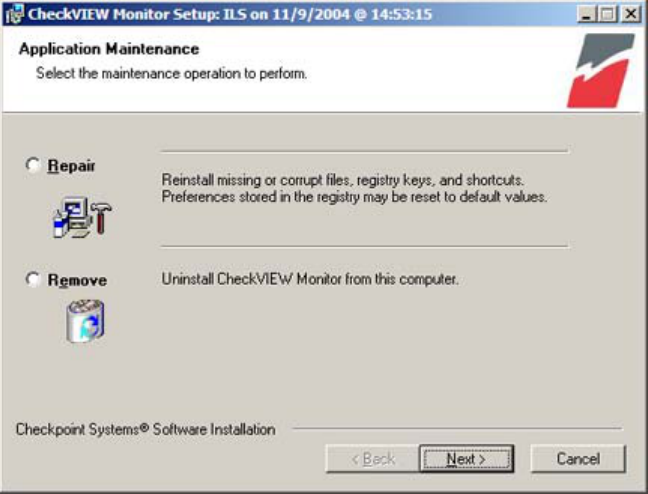
7-6 ILS Open Plus 3.0 Installation Manual
Reinstalling Missing Files
Use the Repair function to reinstall missing or corrupt files, registry keys, and shortcuts.
1Insert the CheckVIEW CD-ROM into the computer’s CD-ROM drive. If
CheckVIEW is already installed, the Application Maintenance window displays.
Figure 7.6
Application Maintenance window
2Click the Repair option button. Click Next.
Uninstalling CheckVIEW
Use the Remove function to uninstall CheckVIEW.
1Insert the CheckVIEW CD-ROM into the computer’s CD-ROM drive. If
CheckVIEW is already installed, the Application Maintenance window displays
(Figure 7.6).
2Click the Remove option button. Click Next>.
Using CheckVIEW to Shut Down a Self-Checkout Station
The following procedure shuts down a Self-Checkout Station using CheckVIEW:
1Launch CheckVIEW on the library staff’s computer by clicking Start > Programs >
Checkpoint Systems > CheckVIEW Monitor from the library staff’s computer.
2Access the specific Self-Checkout Station by selecting View and then select one of the
Display (1-4) options for the desired Self-Checkout Station.
3On the keyboard, press CTRL + SHIFT + DEL.
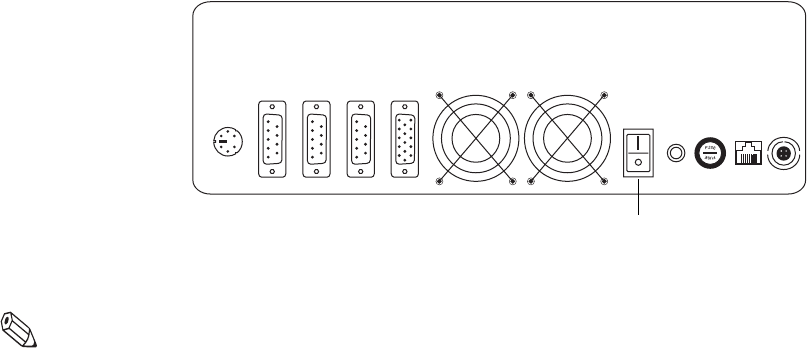
CheckVIEW: Using CheckVIEW in Host Mode 7-7
4Click Shut down. The Self-Checkout Station enters a shut down sequence until it
states that Self-Checkout Station can be turned off.
Figure 7.7
Self-Checkout Station On/Off Switch
5Go to the Self-Checkout Station and turn off the power switch.
Note: See “Powering On the Self-Checkout Station” on page 3-10 for instructions about how to turn on the
Self-Checkout Station.
Power On/Off Switch
7-8 ILS Open Plus 3.0 Installation Manual
Notes
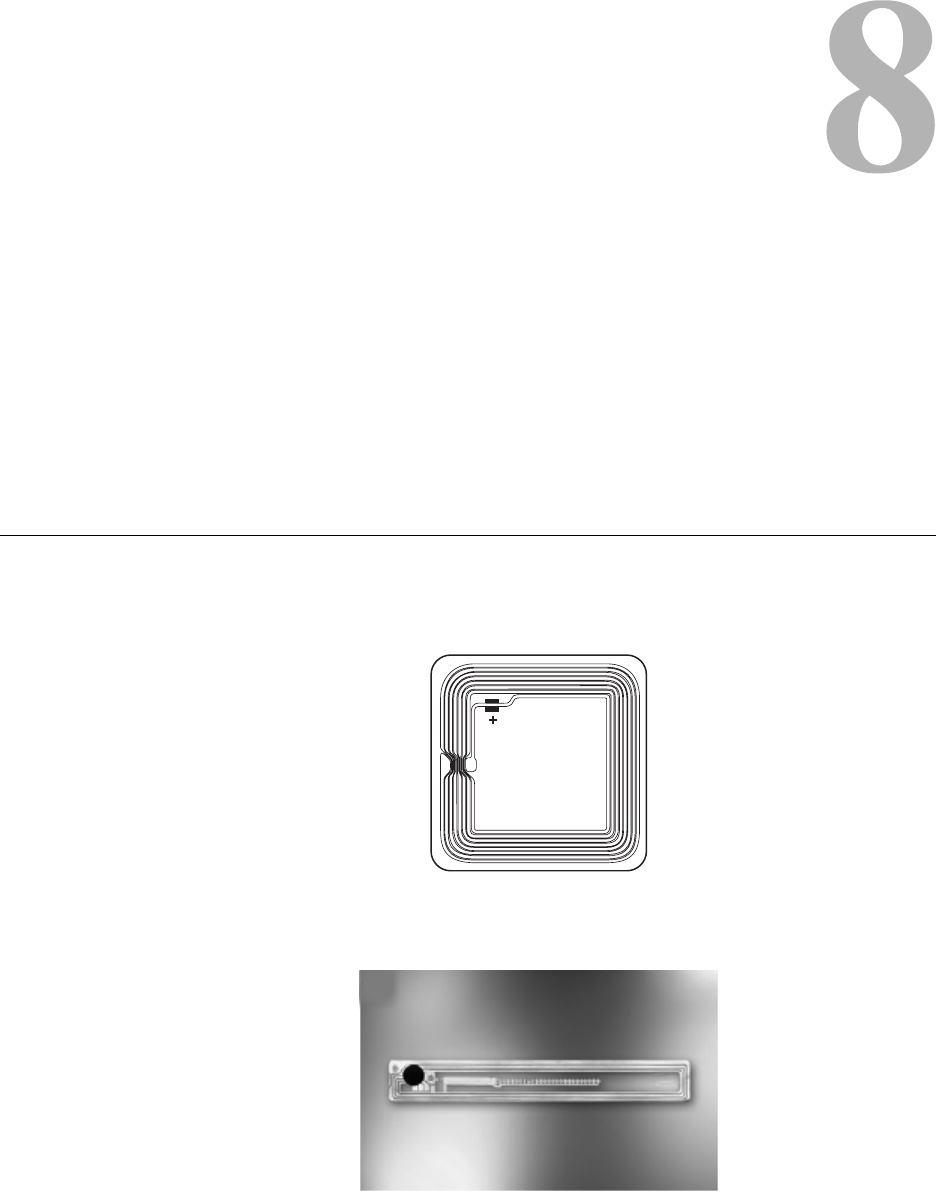
Affixing Tags: Types of tags 8-1
CHAPTER
C
HAPTER
0
A
FFIXING
T
AGS
This chapter describes the different types of RFID tags and provides instructions for
placing the appropriate circuit on books, CDs, audio material, and kit material.
For information on the Tag Programming Station, see “Using Tag Programming Station”
on page 9-1.
Types of tags
Checkpoint Systems provides three types of tag. Choose the appropriate circuit for each
type of media.
Standard tag: Can be used on books, CDs, DVDs, audio material, and tagging kits.
Figure 8.1
Standard tag
Video Tag: Can be used on video cassettes.
Figure 8.2
Video tag

8-2 ILS Open Plus 3.0 Installation Manual
•CD-DVD Content tag: Can be used on CDs and DVDs (aka hub tag).
Figure 8.3
CD-DVD Content tag
Applying Tags to Books
The following procedure outlines a method for staggering the placement of tags in treating
printed materials. This procedure is recommended to obtain the highest level of
performance with ILS Open Plus products.
The procedure requires materials to be treated in shelf order, which maintains tag
staggering for the materials when placed on the shelves. Tag staggering helps to ensure
that the materials can be reliably scanned during inventory operations and increases the
number of items that can be processed by staff station readers, patron self-checkout
stations, and security gates.
The diagram below shows the pattern layout on a single book. In practice, only one tag is
placed in a book, but each treatment of a book is a progression of the pattern, which
repeats.
In some cases, the book height will not support the placement of a tag at positions 2 or 3.
In this scenario, the next logical placement in the progression of the pattern is used. For
example, if the height of the printed material only allows 2 positions, then repeat the 2
position pattern until the next printed material allows all positions.
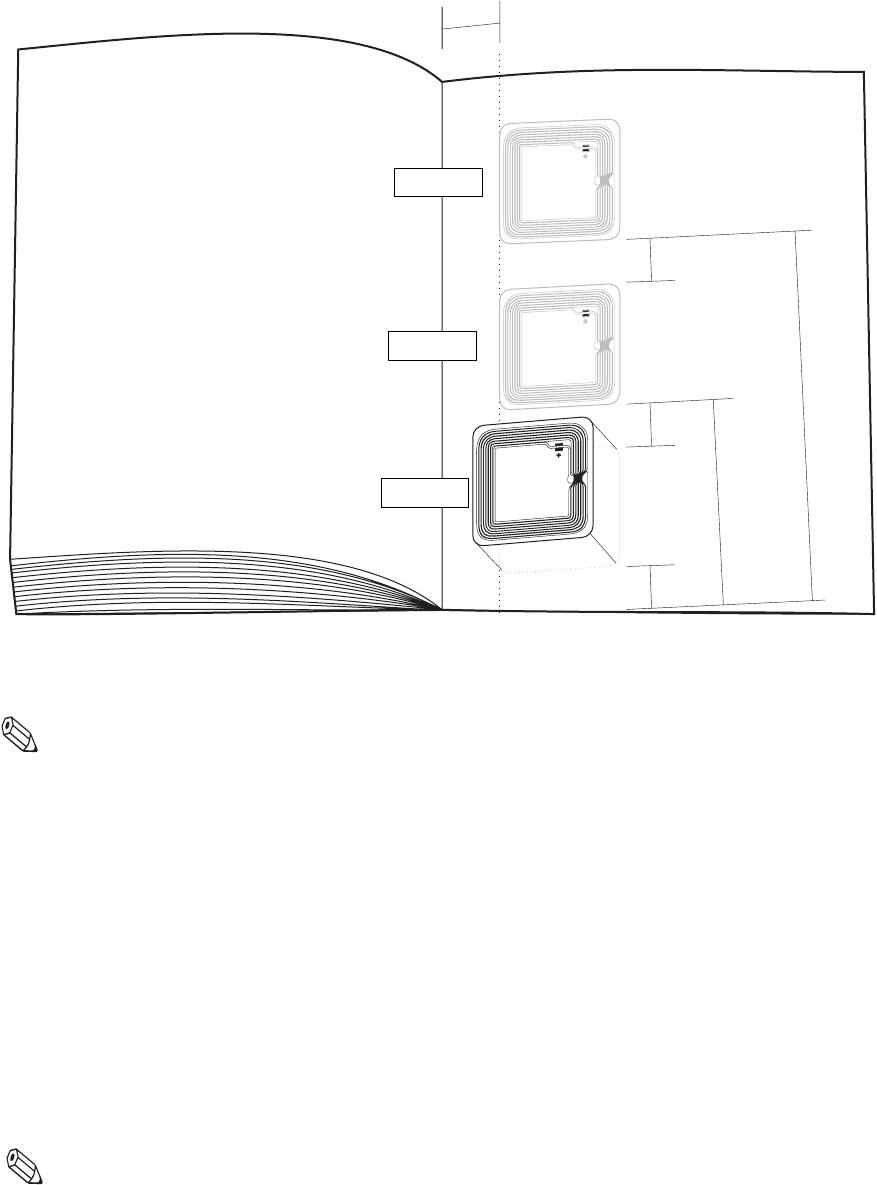
Affixing Tags: Applying Tags to Books 8-3
Use only Standard tags on books.
Figure 8.4
Book Tagging Procedure
1Open printed material to the inside back cover.
2Peel the backing from the tag.
Note: Metallic covers interfere with reading of the circuit. If the book has a metallic cover, photocopy or
replace the cover. Or cut a 3” x 3” (7.6 cm x 7.6 cm) section from the back of the cover and place the
tag in this section.
3Place the tag in position 1; the lower inside corner of the printed material, leaving
1.2cm (½”) clearance from the spine of the material and 1.9cm (3/4”) from the bottom
of the material, as seen in the tag placement diagram above.
4In the next printed material, place the tag in position 2. This is 1.2cm (½”) above the
top of the tag in the first printed material at position 1, as shown in the tag placement
diagram. The total distance from the bottom of the printed material to position 2 is
8.2cm (3 1/4”).
5In the next printed material, place the tag at position 3. This is 1.2cm (½”) above the
top of the tag at position 2, as shown in the tag placement diagram. The total distance
from the bottom of the printed material to position 3 is 14.6cm (5 3/4”).
6This completes the treatment pattern, which is now repeated successively for all
subsequent materials.
Note Do not place the tag over an EAS tag.
1.2 cm
(1/2”)
1.2 cm (1/2”)
1.2 cm
(1/2”)
1.9 cm
(3/4”)
8.2 cm
(3 1/4”)
14.6 cm
(5 3/4”)
Position 1
Position 2
Position 3
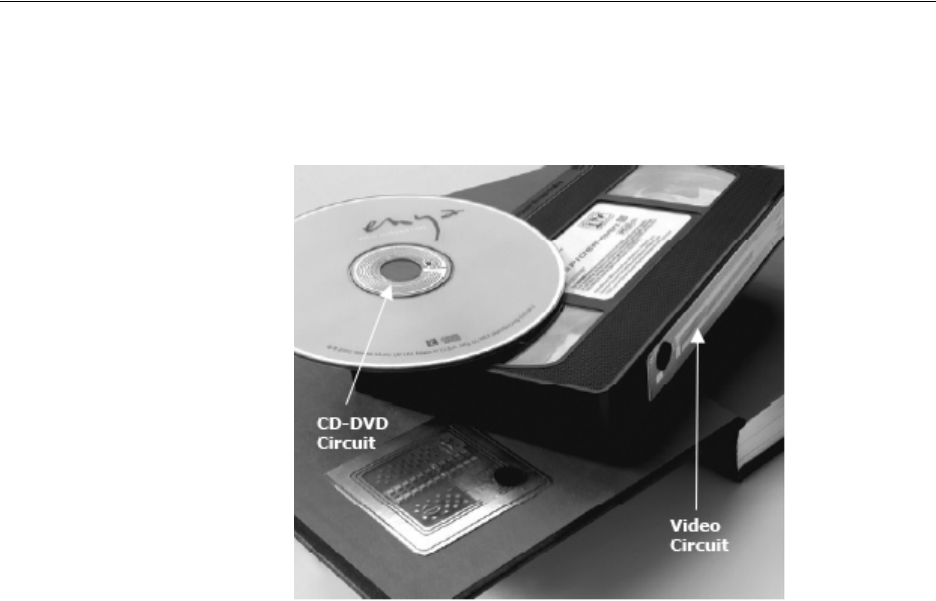
8-4 ILS Open Plus 3.0 Installation Manual
Applying Tags to Video Cassettes
Use only Video tags on video cassettes.
To place tags on video cassettes:
1Place the tag on the spine of the cassette, on the same side as the title label.
2Place the cover label over the tag. You can print a barcode as part of the cover label.
Figure 8.5
Sample Placement of tags on a CD and a Video Cassette
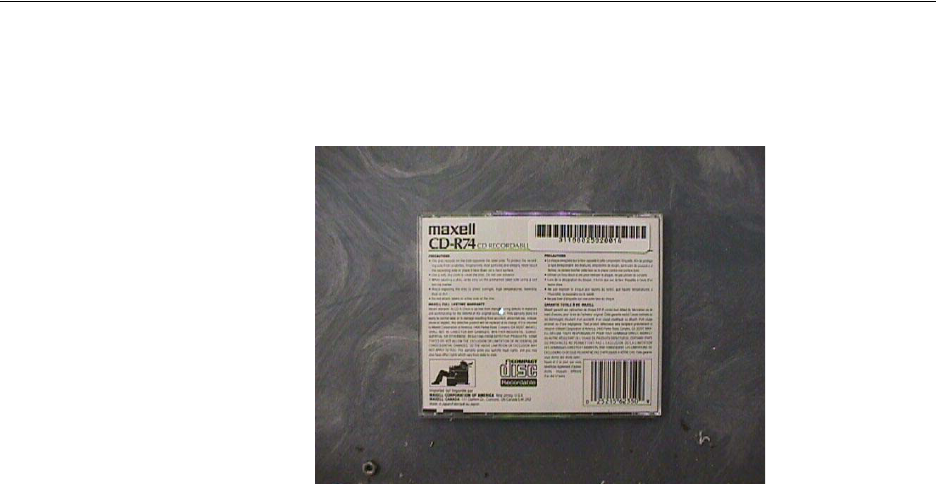
Affixing Tags: Applying tags to CDs and DVDs 8-5
Applying tags to CDs and DVDs
You can use either CD-DVD Content tags or Standard tags on CDs and DVDs.
To place barcode labels on CDs
Place the second, peelable barcode label on the back of the CD case. See Figure 8.7.
Figure 8.6
Sample placement of a barcode label on a CD
To place tags on Jewel Case CD cases
This procedure only applies to jewel cases.
1Disassemble the CD, and place the tag with the printed barcode cover label in the upper
or lower left corner, near the spine.
2Reassemble the CD.
3Place the second, peelable barcode label on the back of the CD case. See Figure 8.7.
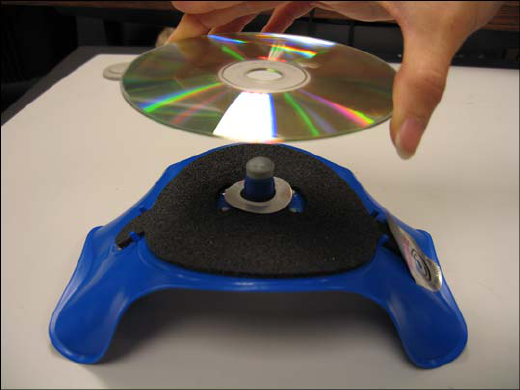
8-6 ILS Open Plus 3.0 Installation Manual
To place content tags on CDs and DVDs
This procedure explains how to correctly place the content circuits (aka hub tags) on CDs
or DVDs. For precise placement on the center of the disc, use the CD/DVD labeling
applicator (the blue arched tool).
1Move the applicator to a smooth surface, such as a tabletop, so that it slides easily.
2Peel the backing off of the content circuit.
3Place it upside down (adhesive side up) on the applicator.
Figure 8.7
Sample placement of a barcode label on a CD
4Place the disc upside down (label-side down) on top of the content circuit and press
firmly down until the applicator bends flat.
5Remove the disc and press down around the entire content circuit with your finger until
it lies smoothly on the disc.
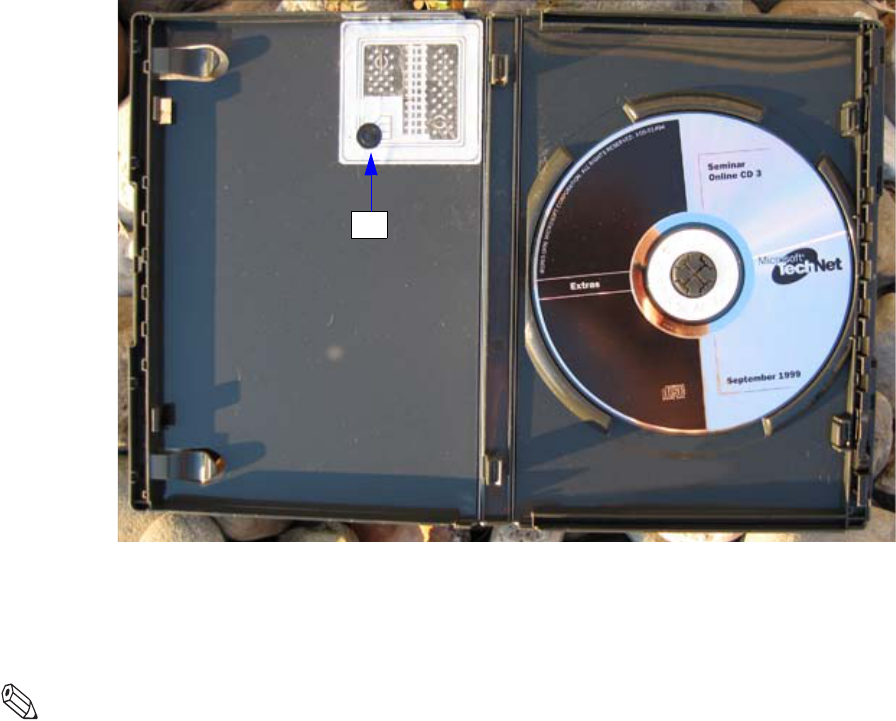
Affixing Tags: Applying tags to CDs and DVDs 8-7
To place tags on DiscMate DVD cases
This procedure only applies to DVD cases. To place standard 2" x 2" tags on DiscMate
DVD (single or double) cases:
1If necessary, unlock the case.
2Open the DVD case.
3Peel the backing from the tag.
Figure 8.8
Sample Placement of Label on a CD/DVD Case
4On the inside the front of the case, place the tag into the very top right corner, as close
to the spine and top of the case as possible. Make sure that the dot is farther away from
the spine and top of the case, as seen above.
5If desired, affix a library cover-label sticker over the tag.
Note When re-inserting DVD covers, do not use original artwork that is made of cardboard weight stock.
The thicker cover may not allow the DiscMate case to slide through the DiscMate opening properly,
due to the material’s thickness. Original artwork should be scanned or copied onto regular (20 lb.)
paper stock before putting under the dust jacket.
Dot
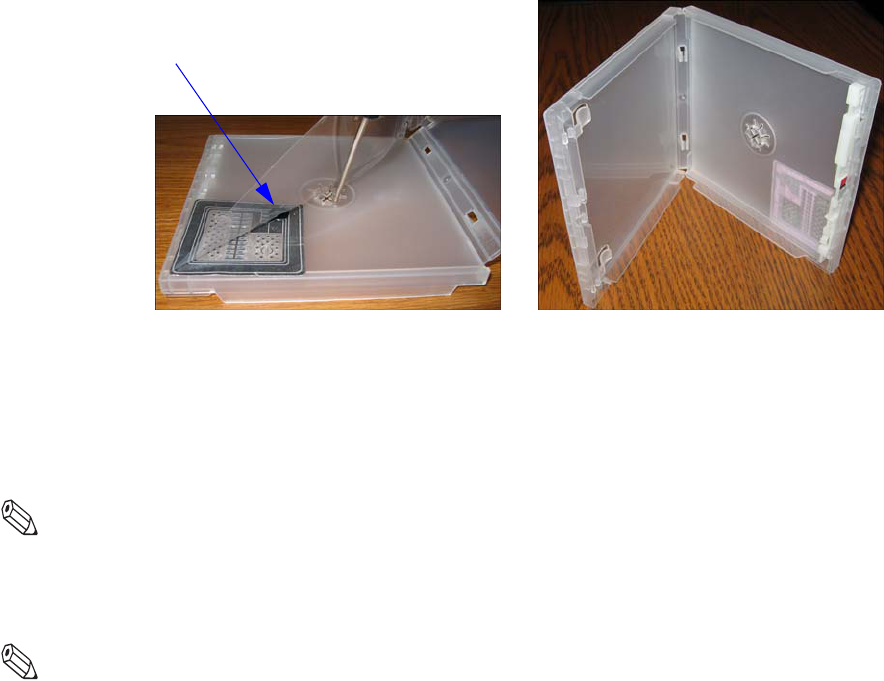
8-8 ILS Open Plus 3.0 Installation Manual
To place tags on DiscMate CD cases:
To place standard 2” x 2” tags on DiscMate CD (single or double) cases:
1If necessary, unlock the case.
2Open and flip the CD case over so that backside of it faces upward. In this position, the
CD retaining hub is facing downwards.
3Remove the CD from the case’s retaining hub.
4Peel the backing off of the tag.
Figure 8.9
Placement of tag on a CD Case
5Lift the clear plastic film away from CD case and slide the tag underneath, into the very
bottom corner, as close to the edges as possible. Position the dot on the circuit so that it
points to the center of the case, as seen above.
6If desired, affix a library cover-label sticker over the tag.
Note 1 When re-inserting CD covers, do not use original artwork that is made of cardboard weight stock.
The thicker cover may not allow the DiscMate case to slide through the DiscMate opening properly,
due to the material’s thickness. Original artwork should be scanned or copied onto regular (20 lb.)
paper stock before putting under the dust jacket. It is okay if part of the RFID circuit extends to the
center hub of the case.
Note 2 A cover-label is available that covers both sides of the tag. The cover-label may be printed to give it
the appearance of a property sticker. Please contact your account representative for more
information on this product.
Dot
Circuit placed under clear film Circuit on the outside with case in up position
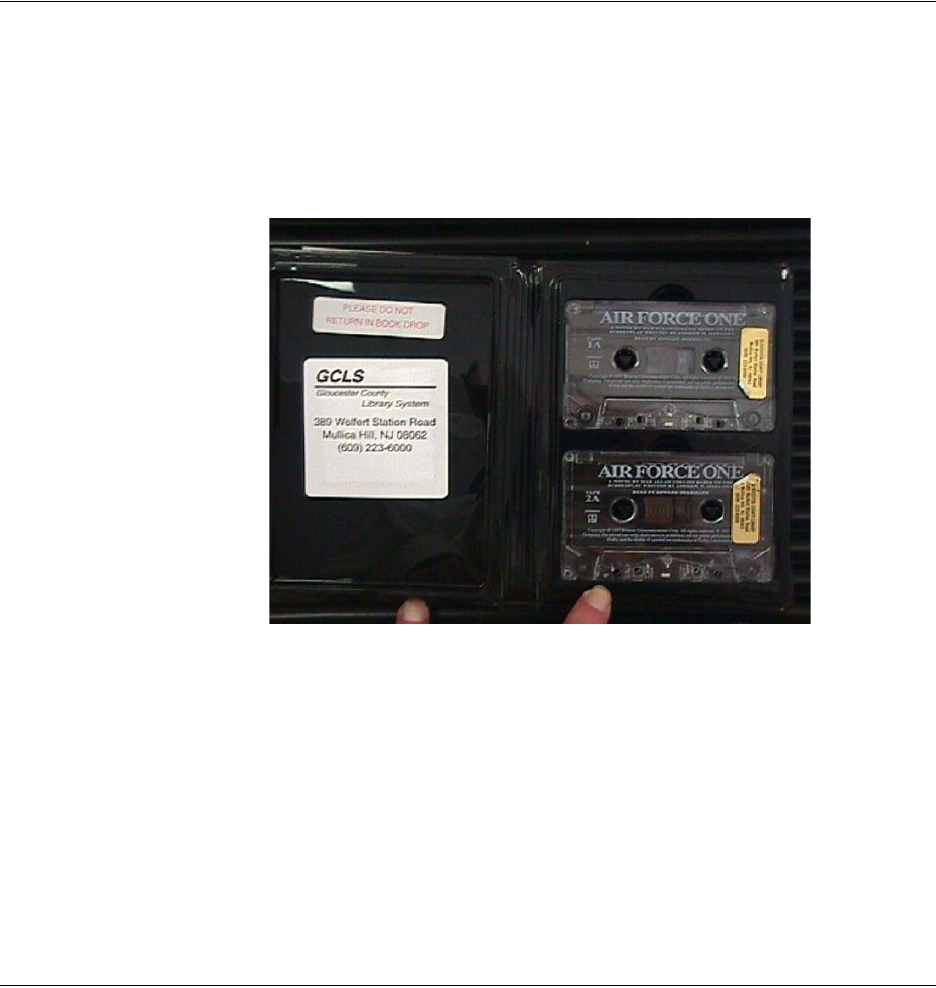
Affixing Tags: Applying Tags to Audio Material 8-9
Applying Tags to Audio Material
Use only Standard tags on audio material.
To place tags on Audio Cases with Tapes on only one inside
section:
1Place the tag on the inside front cover, centered horizontally and vertically.
2Place the cover label over the tag. You can print a barcode as part of the cover label.
Figure 8.10
Sample Placement of tag and Label on Audio Material
To place tags on Audio Cases with Tapes on both inside
sections:
1Remove the card stock from the outside sleeve of the front cover.
2Place the tag in the sleeve, against the box, and replace the card stock so it covers the
tag.
3If the card stock is metallic, photocopy the card stock, and replace the metallic card
stock with the photocopy.
Applying Tags to Kits
Use only Standard tags on kit material.
1Place the tag on the outside of the bag, or on the most valuable library material in the
kit.
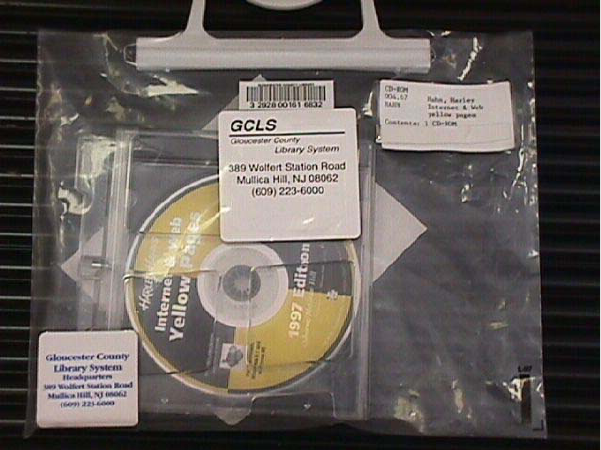
8-10 ILS Open Plus 3.0 Installation Manual
2Place the cover label over the tag. You can print a barcode as part of the cover label.
Figure 8.11
Sample Placement of Tag and Label on Kit Material
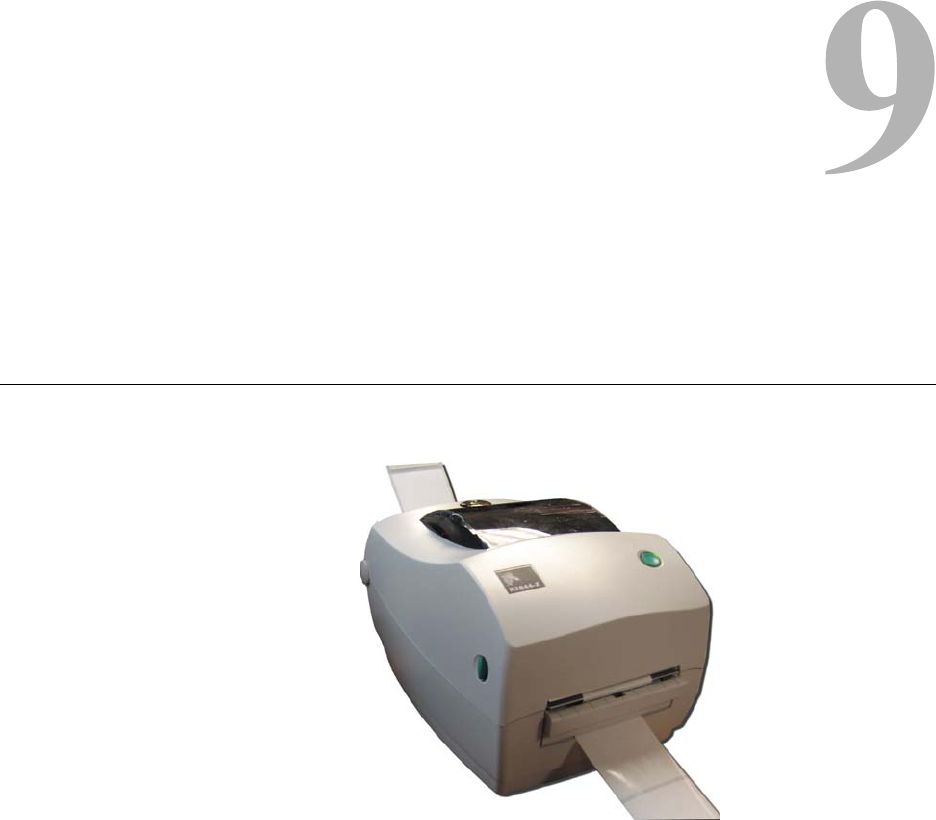
Using Tag Programming Station: Overview 9-1
CHAPTER
C
HAPTER
0
U
SING
T
AG
P
ROGRAMMING
S
TATION
Overview
The following procedure explains how to use Tag Programming Station (printer
programmer) and the associated Tag Programming Application.
Figure 9.1
Tag Programming Station
The Tag Programming Station programs all ISO-compliant tags for the library. The Tag
Programming Station prints out a library label (tag) with the RFID chip already built into
it, simplifying the library material tagging process. Once printed, library personnel peel
the backing off of the tag and attaches it to the material in the approved location. See the
Tagging Procedures document for details.
Libraries use the Tag Programming Station to program tags with the item identifier from
the barcode when converting a retrospective library collection. Tags are also programmed
when new materials are added to the collection.
When adding a new item to the collection and programming the tag, the library can also
print a barcode label on the tag. In many cases, libraries support the use of barcodes in
addition to the RFID inventory tags, primarily for compatibility with other branch libraries
still using barcodes.
The equipment and files you need for this are:

9-2 ILS Open Plus 3.0 Installation Manual
• Tag Programming Station
• Tag Programming Application
• Programming Station Computer with monitor, keyboard, and mouse
• Barcode scanner
• USB to Serial Converter (2 qty) or a Serial Port Board
• Eventually, an active network connection from the TPS computer to the Application
Server
How it works
ISO-ready tags are programmed (encoded) with the item identifier used by the LMS using
the Tag Programming Station. In an RFID-only environment, this would be all that a
library would do to convert their restrospective collection for using RFID tags.
For those libraries that will continue to support barcodes as well as RFID (mainly for
support with branches that have not been converted yet), the library can also print a
barcode on the label at the same time when programming a tag, linking the same item
identifier used by the barcode and the tag.
The high-level process by which tags are programmed is as follows:
1Decide if you are programming new or existing materials:
•If programming new materials, the program creates a new item identifier.
•If using existing barcodes, you will scan the barcode for the item identifier to be
programmed to the tag.
2The Tag Programming Station prints and programs the tag with the item identifier.
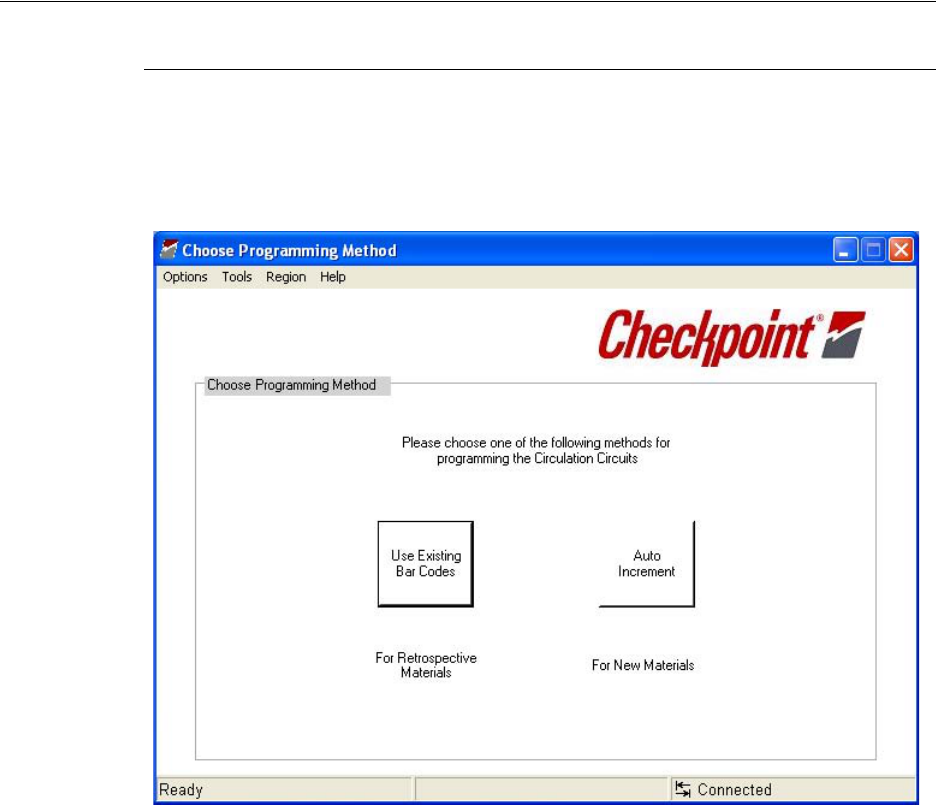
Using Tag Programming Station: Programming Procedure 9-3
Programming Procedure
New Material
Use this procedure to program tags for new material using Auto-Increment mode for use
within the ILS system.
1On the Tag Programming Station computer, click Start > All Programs >
Checkpoint Systems > ISO Tag Programming Station. The initial Tag
Programming Application displays.
Figure 9.2
TPS Initial Choice
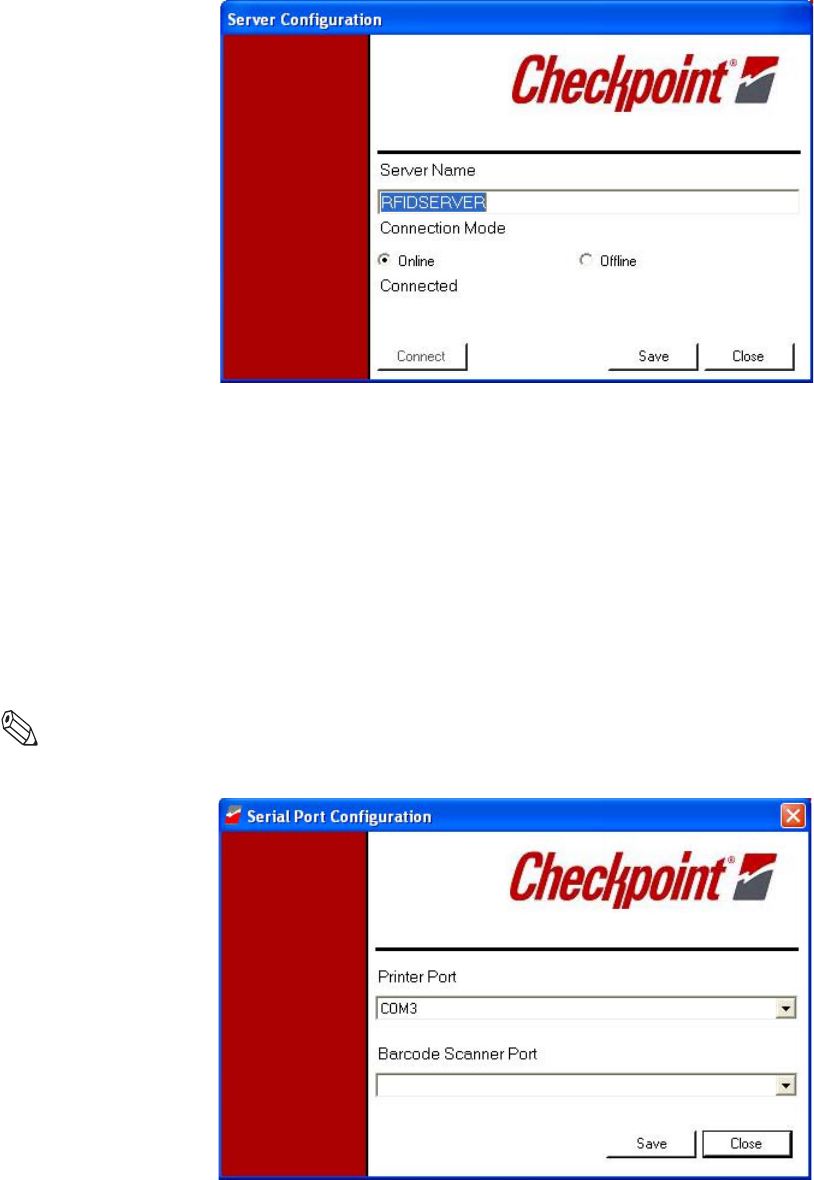
9-4 ILS Open Plus 3.0 Installation Manual
2Click Auto Increment. The Server Configuration window displays:
Figure 9.3
Server Configuration window
3Type the name of the Application Server to which you will eventually upload the tag
information; most likely it is RFIDSERVER.
4Select the Connection Mode you will use.
•If you are connecting to Application Server, select Online. Click Connect if you
select this option to verify you have a live connection to the Application Server. A
Connected should appear.
•If you are not connecting to Application Server, select Offline. You can connect at
a later date to upload the programmed tag information.
5Click Save, to save your choice, then Close. The Serial Port Configuration window
displays.
Note: If a format file has never been created, the Label Format Selection window appears. Contact your
Checkpoint service personnel for assistance in this instance.
Figure 9.4
Port Selection window
Using Tag Programming Station: Programming Procedure 9-5
6Select the COM port used for the Printer Port and click Save and Close.
7
9-6 ILS Open Plus 3.0 Installation Manual
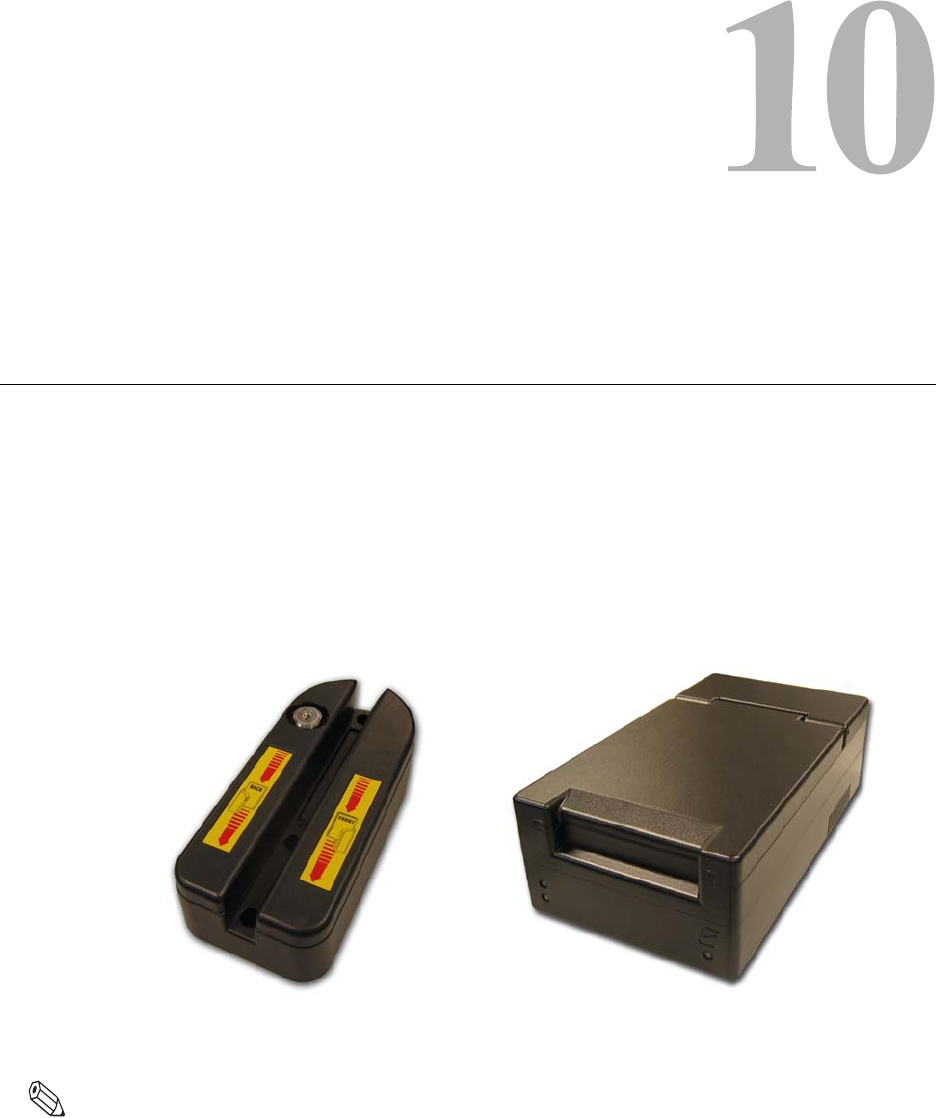
Using DiscMate: Overview 10-1
CHAPTER
C
HAPTER
0
U
SING
D
ISC
M
ATE
Overview
DiscMate is an easy-to-use protection security solution for libraries’ electronic media.
The DiscMate solution consists of two units:
• The Standard Unlocking Station
• The Intelligent Unlocking Station
The Standard Unlocking Station is a manual unit used by the library staff to check-in or
checkout CD/DVD media. The Intelligent Unlocking Station is an automated unlocking
unit that library patrons use at the Self-Checkout Station to checkout CD/DVD media
without staff assistance.
Figure 10.1
DiscMate Products
Note: The Intelligent Unlocking Station meets North American regulatory approvals. The European
regulatory approvals are not applicable at this time.
Standard Unlocking Station Intelligent Unlocking Station
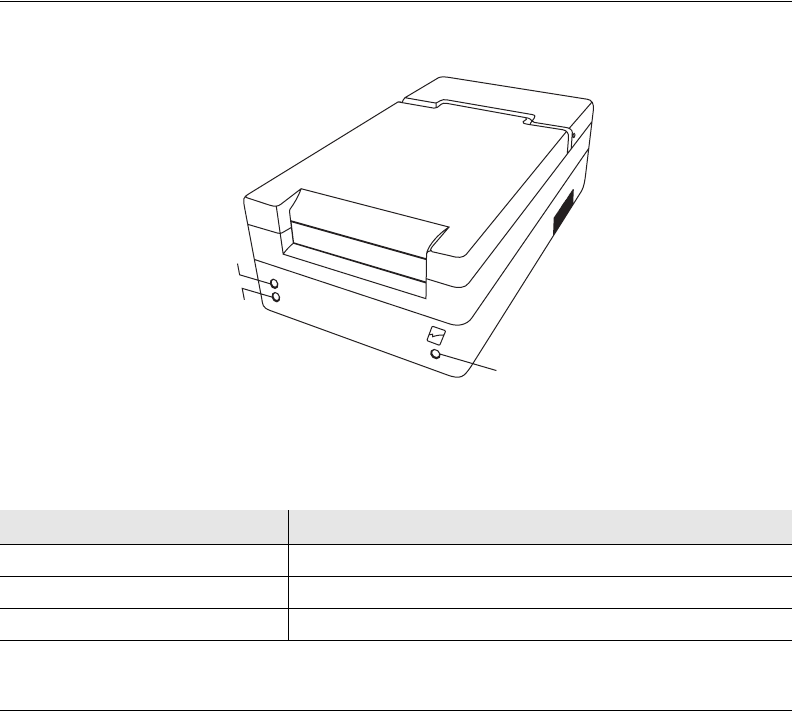
10-2 ILS Open Plus 3.0 Installation Manual
LEDs on the Intelligent Unlocking Station
The Intelligent Unlocking Station uses three LEDs to communicate information about the
activity of the unlocking process.
Figure 10.2
Intelligent Unlocking Station LEDs
The LEDs are explained below:
Using the Standard Unlocking Station
The Standard Unlocking Station consists of a black base with a key at one side. The key
allows you to secure the station so that it cannot be used to unlock cases without
authorization.
1If necessary, insert the key and turn to lower the locking bar.
2Insert the long edge of the case with locked symbol (red rectangle) down into the slot
and swipe evenly across.
3Check the case to ensure that the red rectangle does not appear. If not, rotate the case
around and swipe again. Your case is now unlocked.
Table 10.1
CD/DVD Report Detail
LED Name Description
Success Illuminates when the case is successfully unlocked.
Arm Illuminates when the case has been successfully inserted.
Power Illuminates when power has been turned on.
Arm
Power
Success
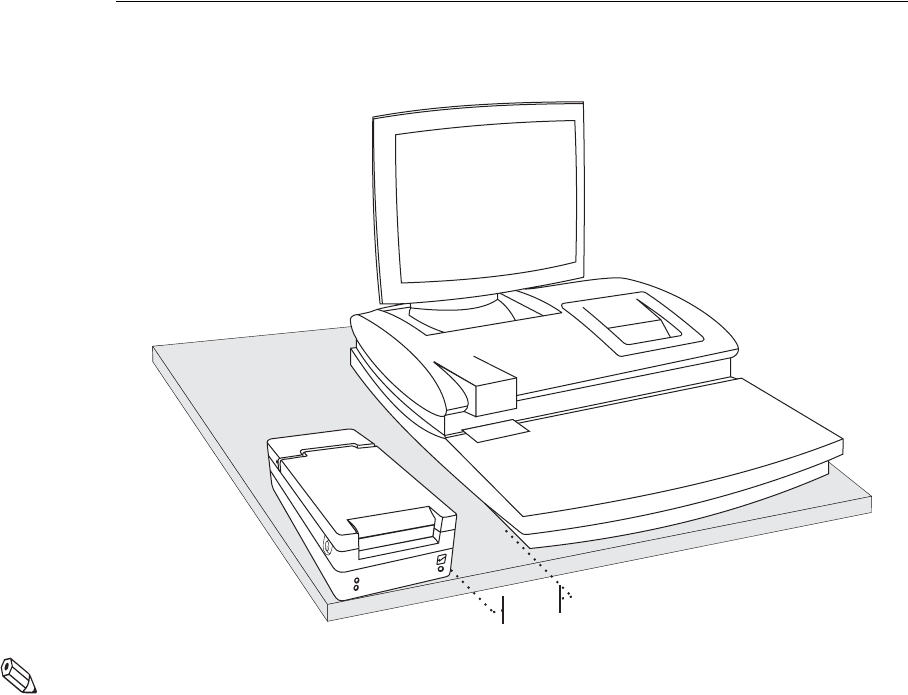
Using DiscMate: Overview 10-3
Using the Intelligent Unlocking Station
The Intelligent Unlocking Station consists of a black base with LEDs and a slot at the front
where you insert the case. The Intelligent Unlocking Station sits next to a Self-Checkout
Station and performs the unlocking automatically.
Figure 10.3
Self-Checkout Station with the Intelligent Unlocking Station
Note: Do not place your electronic materials near the Intelligent Unlocking Station during the checkout
process. The Intelligent Unlocking Station may read your materials before you are ready. Place your
CD/DVDs on a table away from the Intelligent Unlocking Station before checking them out.
1Follow the prompts on the Self-Checkout Station monitor to checkout materials.
2When instructed, insert the case into the slot. You must insert the top of the case with
the locked symbol (red rectangle) on the right hand side of the case. See “Intelligent
Unlocking Station Case Insertion Diagram” on page 10-4 for more details.
3Push the case all the way until it stops. The bottom light at left, the arming light,
illuminates, indicating you have correctly inserted the case.
4The Intelligent Unlocking Station accepts the case, unlocks it, and returns it. The top
left light illuminates, indicating a successful unlocking procedure has occurred.
5Once the case stops moving, remove the case from the Intelligent Unlocking Station.
Your case is now unlocked.
3”
7.5 cm
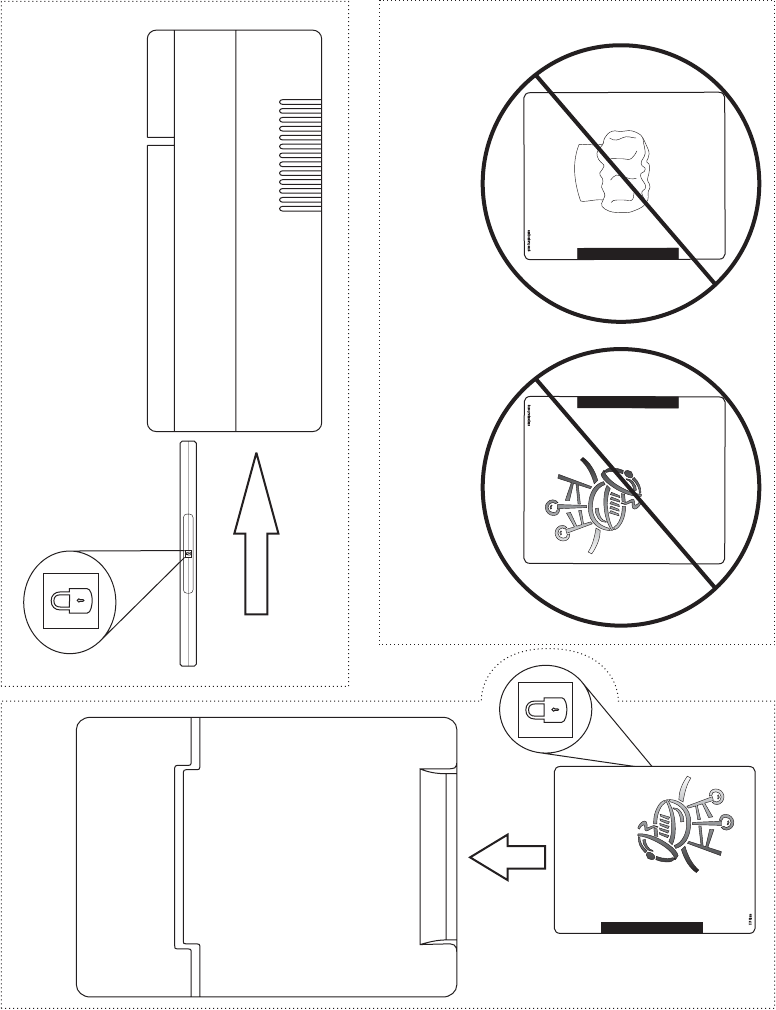
10-4 ILS Open Plus 3.0 Installation Manual
Intelligent Unlocking Station Case Insertion Diagram
The following diagram illustrates the correct orientation for case insertion into the
Intelligent Unlocking Station.
Figure 10.4
Case Insertion Diagram
Top View
Backwards With back cover towards you
Incorrect Insertion Methods
Sample Title
Sample Title
Back Cover
Right Side View

Using DiscMate: Linking Procedure 10-5
Linking Procedure
The DiscMate solution uses circulation circuits (RFID tags) to track electronic media
within the Intelligent Library System Open Plus. Two tags can be used to maintain content
validation: a security tag and a content tag. The security tag (sometimes known as the case
tag) is the larger tag on the inside of the case that is read by the exit gates. The content tag
(sometimes known as the hub tag) attaches directly to the disc around the inner ring of the
disc, which in this procedure, is linked to the security tag.
The linking procedure performs a dual purpose: to link the security and content tags
together and to enter the security ID number into a database. The procedure creates a
relationship between the contents of the case and the case itself, producing a single
security ID number (Linked Set) that is utilized by the LMS. That security ID is stored in a
database that verifies the check-in/checkout status of the electronic media upon checkout,
and if applicable, whether the case requires unlocking.
The DiscMate solution is a flexible in handling the different implementation scenarios
used by libraries. For example, one library might decide they will use barcodes on a case
and a content tag on a CD/DVD. Another library might decide that they require the
security tag and content tag on jewel and locking cases. The different situations are
configured within the Circuit Linking Utility.
Configuring Hardware to Link Media
To run the Circuit Linking Utility, you need:
• Circulation Circuit Programmer computer
• 2 Barcode scanners
• Barcode scanner user manual
• Staff Station Reader configured as a tag pad
• Circuit Linking Utility program
• Gender changer, DB25 male to DB25 male adapter
• DB25 female to DB9 female adapter
• Keyboard Wedge cable, with one male and one female connector
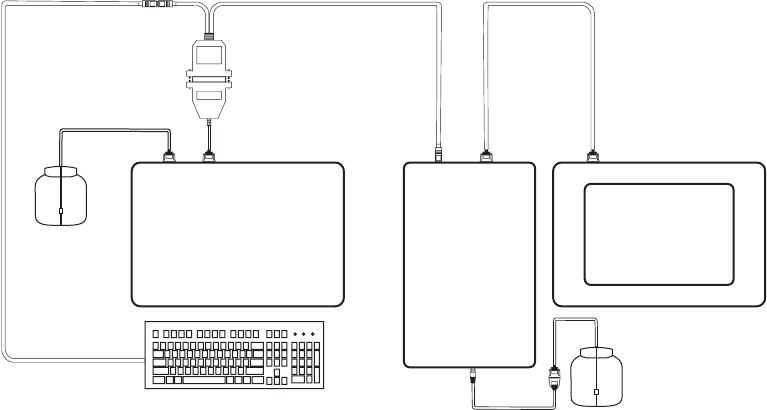
10-6 ILS Open Plus 3.0 Installation Manual
Circuit Linking Hardware Diagram
The following is a top down view of how the hardware is connected together. Ensure that
all items are attached in this configuration before proceeding.
Figure 10.5
Circuit linking hardware diagram
Tag Pad
Barcode
Scanner
Keyboard Wedge
DB25 Male to DB9 Female
Serial Connector
Computer
COM4 COM3
Circulation
Circuit
Programmer
Barcode
Scanner
Serial to
USB
Connector
Serial Cable
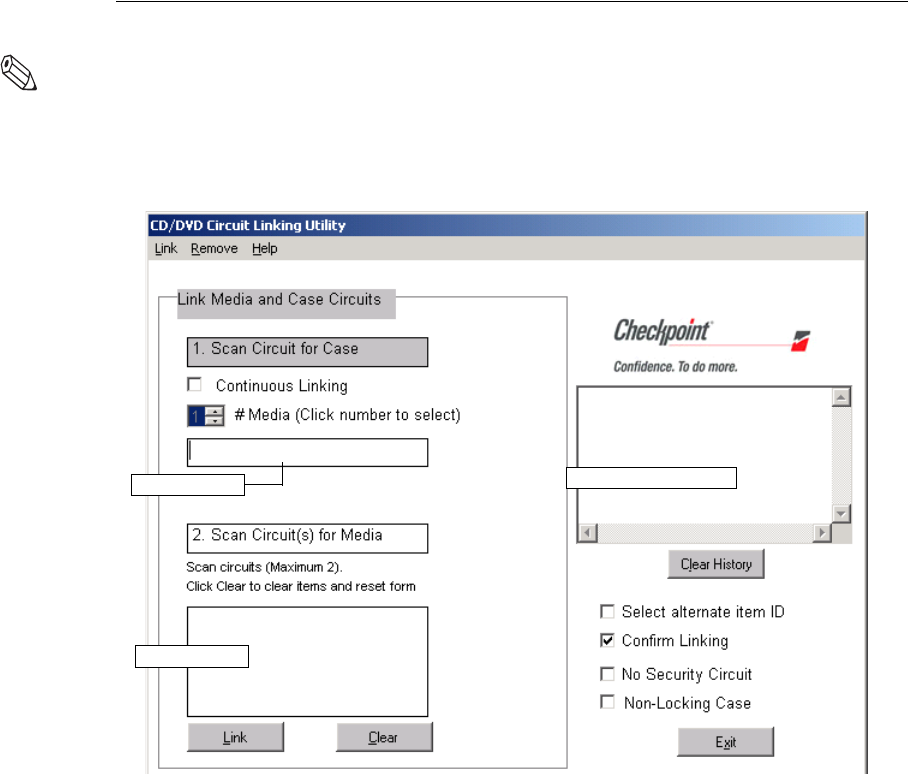
Using DiscMate: Linking Procedure 10-7
Linking Electronic Media with Confirmation
Use this procedure to prepare individual CD/DVD media for use within the ILS system.
Each time you link, a confirmation message appears.
Note: For linking to successfully occur, the title of the material must be entered into the circulation
database prior to linking.
1On the computer, click Start > All Programs > Circuit Linking Utility. The Circuit
Linking Utility appears.
Figure 10.6
Circuit Linking Window with Confirmation
2Select the parameters for the media you are linking:
•if using a Content ID as an item identifier, click Select alternate item ID and then
select either/both Use as item ID.
•ensure Confirm Linking is selected
•select No Security Circuit if you are linking a barcode and not an RFID tag
•select if using a Non-Locking Case (such as a jewel case)
3If linking (RFID) security and content tags:
aWave the case with the front label down over the tag pad with the disc(s) inside.
The case tag and content tags are automatically sorted into the appropriate fields.
4If linking a barcode (non-RFID) and content tags:
aScan the barcode on the case. The case’s barcode number appears. This is the
number to which the contents of the case will be linked.
Security ID
Content ID
History of Linked Items
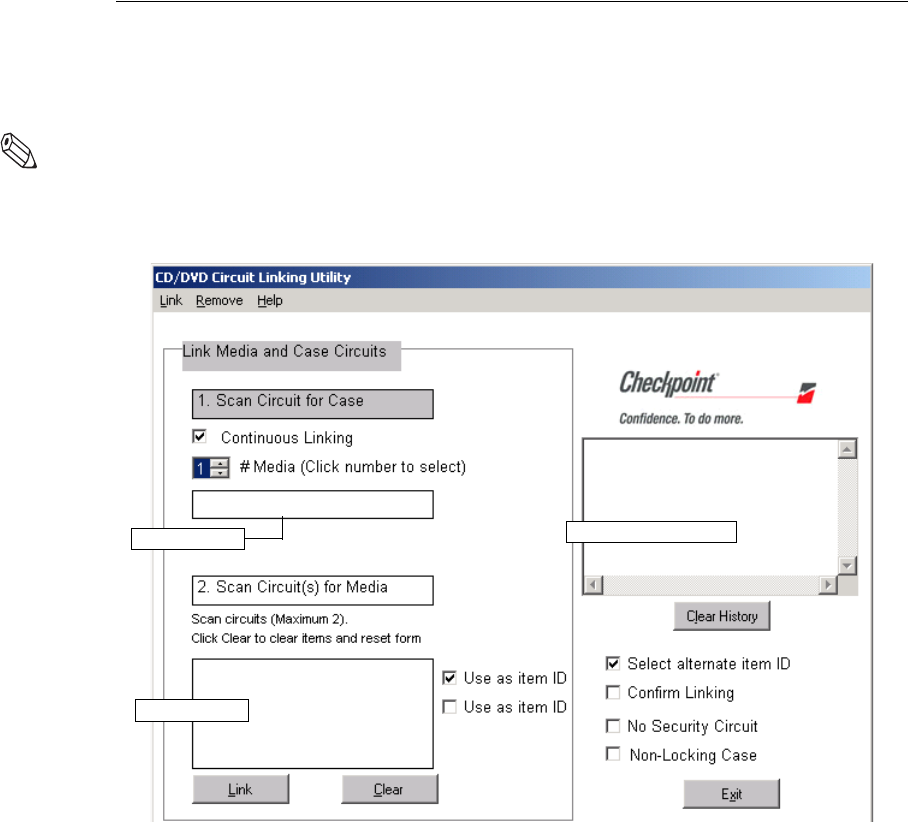
10-8 ILS Open Plus 3.0 Installation Manual
bWave each disc over the tag pad; or if the disc(s) are inside the case, wave the
entire case (front label up) over the tag pad. Hold the CD/DVD case from the
bottom, face down when you wave the case over the tag pad.
5Click Link. If the green checkmark appears, your material is now linked and ready to
use. Retry the operation if a red X appears.
Linking Electronic Media Continuously
Use this procedure to prepare CD/DVD media for use within the ILS system. When
continuously linking, no confirmation message appears, allowing you to link more
quickly. Only link similar sets of media at one time to continuously link. For example, if
linking cases with 2 DVDs each inside, select that parameter and link all of those at one
time.
Note: For linking to successfully occur, the title of the material must be entered into the circulation
database prior to linking.
1On the linking computer, click Start > All Programs > Circuit Linking Utility.
Figure 10.7
Circuit Linking Continuously with Content ID as Item Identifier
Security ID
Content ID
History of Linked Items

Using DiscMate: Linking Procedure 10-9
2Select the parameters for the media you are linking:
•ensure Continuous Linking is selected
•if using a Content ID as an item identifier, click Select alternate item ID and then
select either/both Use as item ID.
•select No Security Circuit if you are linking a barcode and not an RFID tag
•select if using a Non-Locking Case (such as a jewel case)
3Select the # of media (discs) inside the case by clicking the up and down arrows and
then clicking the number within the dialog box.
4If linking (RFID) security and content tags:
aWave the case with the front label down over the tag pad with the disc(s) inside.
The security tag and content tags are automatically sorted into the appropriate
fields. Hold the CD/DVD case from the bottom, face down when you wave the case
over the tag pad.
Note: If the tag pad reads the content tags first, repeated beeps will be heard. Just ignore the beeps and
try again. If the Item ID in the Security ID box is invalid, click Clear and try linking again.
5If linking a barcode (non-RFID) and content tags:
aScan the barcode on the case. The case’s barcode number appears. This is the
number to which the contents of the case will be linked.
bWave each disc over the tag pad; or if the disc(s) are inside the case, wave the
entire case (front label up) over the tag pad.
6If the green checkmark appears, your material is now automatically linked and ready to
use. Retry the operation if a red X appears. Repeat the process as many times as
necessary for the number of media and type of case selected.
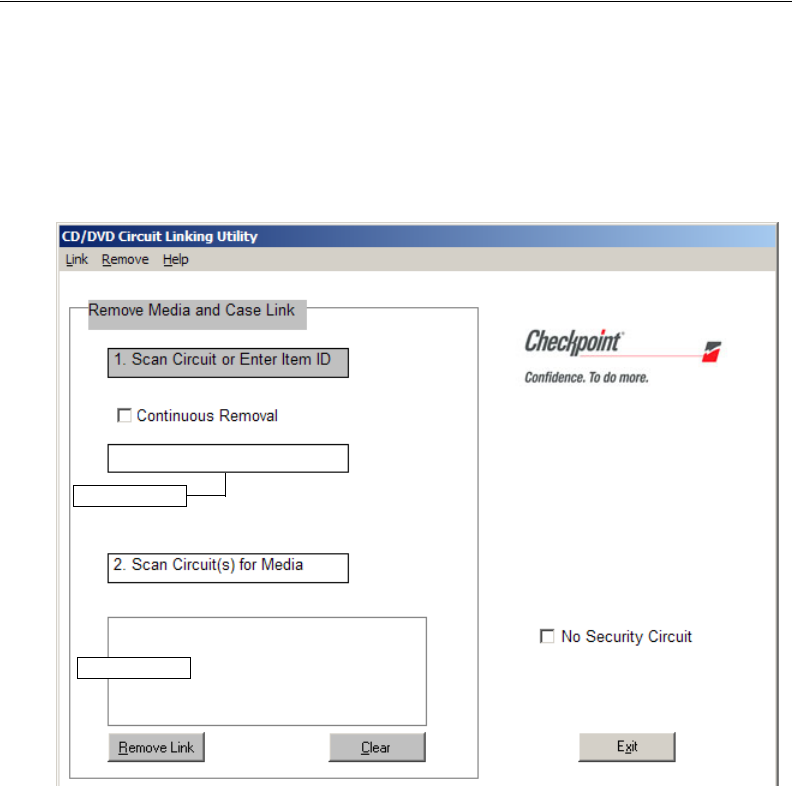
10-10 ILS Open Plus 3.0 Installation Manual
Removing Linked Media
You can remove electronic media from circulation with the Remove Media and Case Link
window. This can be useful when material is incorrectly linked; for example, if a
Beethoven disc becomes accidentally linked to a Schubert case, or if you remove the
media from circulation.
1On the linking computer, click Start > All Programs > Circuit Linking Utility.
2Click Remove at the top menu bar. The Remove Media and Case Link window
appears.
Figure 10.8
CD/DVD Circuit Removing Window
3Select the parameters for the media you are linking:
•select Continuous Removal if removing multiple cases
•select No Security Circuit if you are removing a linked barcode
4If removing security and content tags:
aWave the case with the front label down over the tag pad with the disc(s) inside.
The security tag and content tags are automatically sorted into the appropriate
fields.
5If removing a barcode and content tags:
aEnsure No Security Circuit is selected and scan the barcode on the case. The case’s
barcode number appears.
6Click Remove, or if continuously removing, the material is automatically removed.
Repeat the process as many times as necessary. If the green checkmark appears, your
media are now removed. If a red X appears, the program cannot find the set in the
database.
Security ID
Content ID
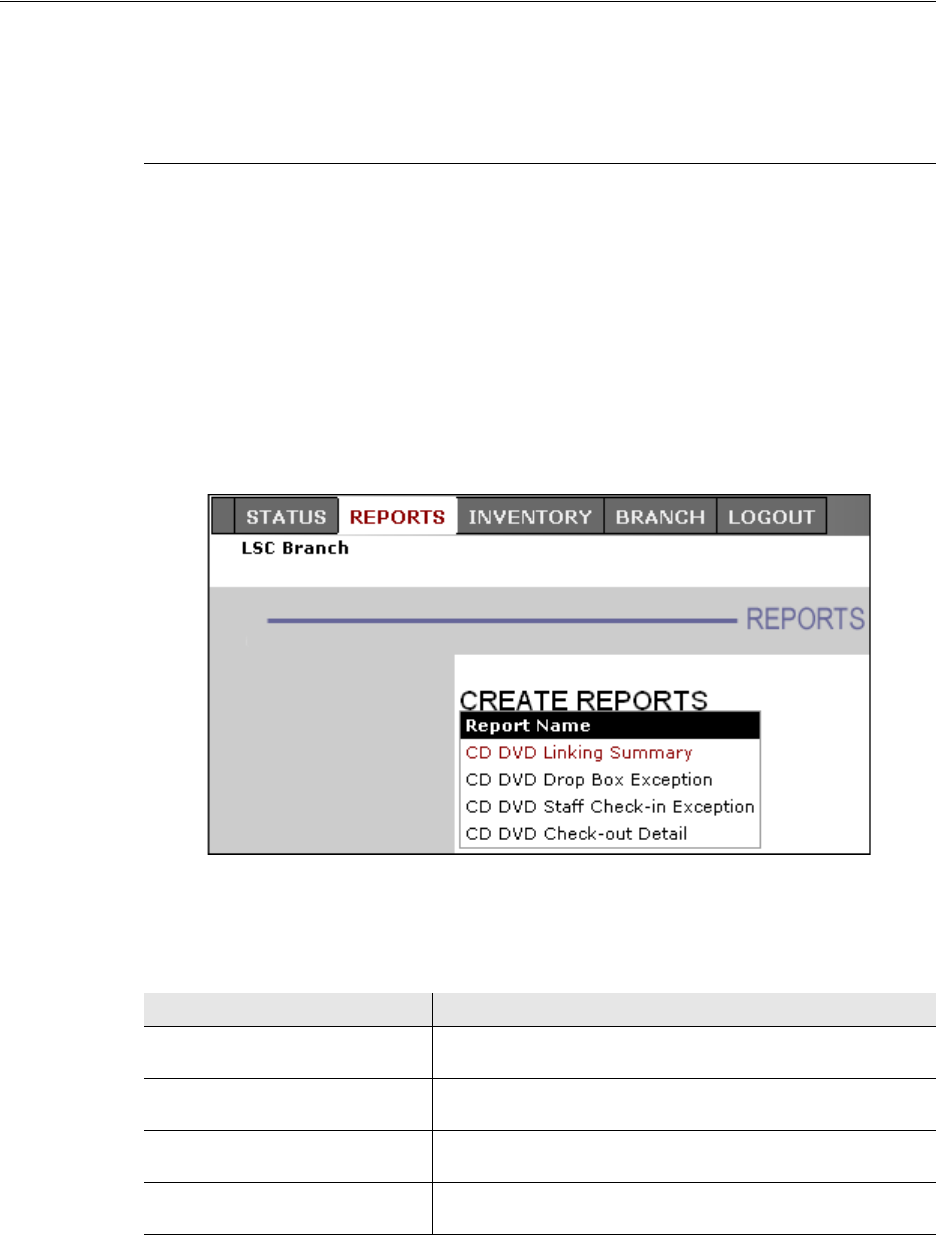
Using DiscMate: DVD Linking Reports 10-11
DVD Linking Reports
The Circuit Linking Utility generates information that can be compiled into reports. These
reports are viewed and printed from ILS Remote Monitor. For general usage instructions
on ILS Remote Monitor, reference the relevant chapter within the ILS User Guide.
Accessing and Printing Linking Reports
To launch ILS Remote Monitor in a single server, multi-branch environment:
1Open a browser window.
2Type http://<machine name of server>/ils in the address bar and press Enter.
Optionally, use the saved bookmark in your Favorites menu.
3Type your ILS Remote Monitor user name of ilsreport and the password report123.
The ILS Remote Monitor utility displays.
4From the top menu, click Branch and click Select of the branch where the Circuit
Linking Utility resides. The branch location is programmed when installed. If the
branch name is incorrectly installed, then you will not be able to run reports.
5From the top menu, click Reports. The Report window displays.
Figure 10.9
CD/DVD Report Selection
The report types are explained below:
Table 10.1
CD/DVD Report Detail
Column Header Description
CD DVD Linking Summary Presents the details of what items were linked for CD/DVD
material.
CD DVD Drop Box Exception Lists anomalies that occurred at the drop box for CD/DVD
material.
CD DVD Staff Check-in Exception Lists anomalies that occurred during check-in at the Staff Station
Reader for CD/DVD material.
CD DVD Check-out Detail Lists anomalies that occurred during checkout at the Staff Station
Reader for CD/DVD material.
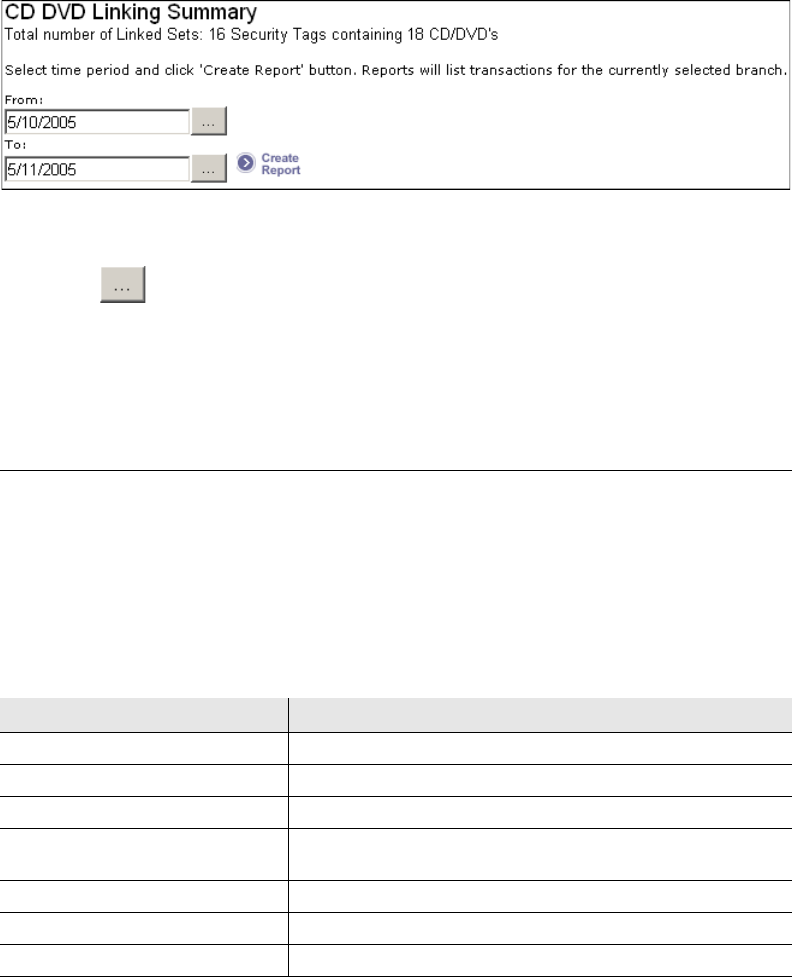
10-12 ILS Open Plus 3.0 Installation Manual
6Click the type of report desired. The window displays the options for defining the
report.
Figure 10.10
Defining Report Parameters
7Type the dates you wish for which you wish to view activity, or use the calendar
buttons and select the date required.
8Click Create Report once your dates are entered.
9To print the report, click File > Print.
10 Select Landscape orientation and click OK.
Type of Reports
Listed here are descriptions of the available reports for the Intelligent Unlocking Station.
See “Accessing and Printing Linking Reports” on page 10-11 for details on how to access
and view reports.
Linking Summary Report
This report identifies exceptions generated from a Circuit Linking session.
Table 10.1
CD/DVD Linking Summary Detail
Column Header Description
ContentTagID The item number of the contents of the case.
SecurityTagID The item number of the case.
Link DateTime The day and time the item was linked.
Case The type of case that was selected when linked, Locking or Non-
Locking.
Title The title of the item.
LinkAuthor The name of the computer at which the linking occurred.
LinkStation The branch location of the computer at which the linking occurred.
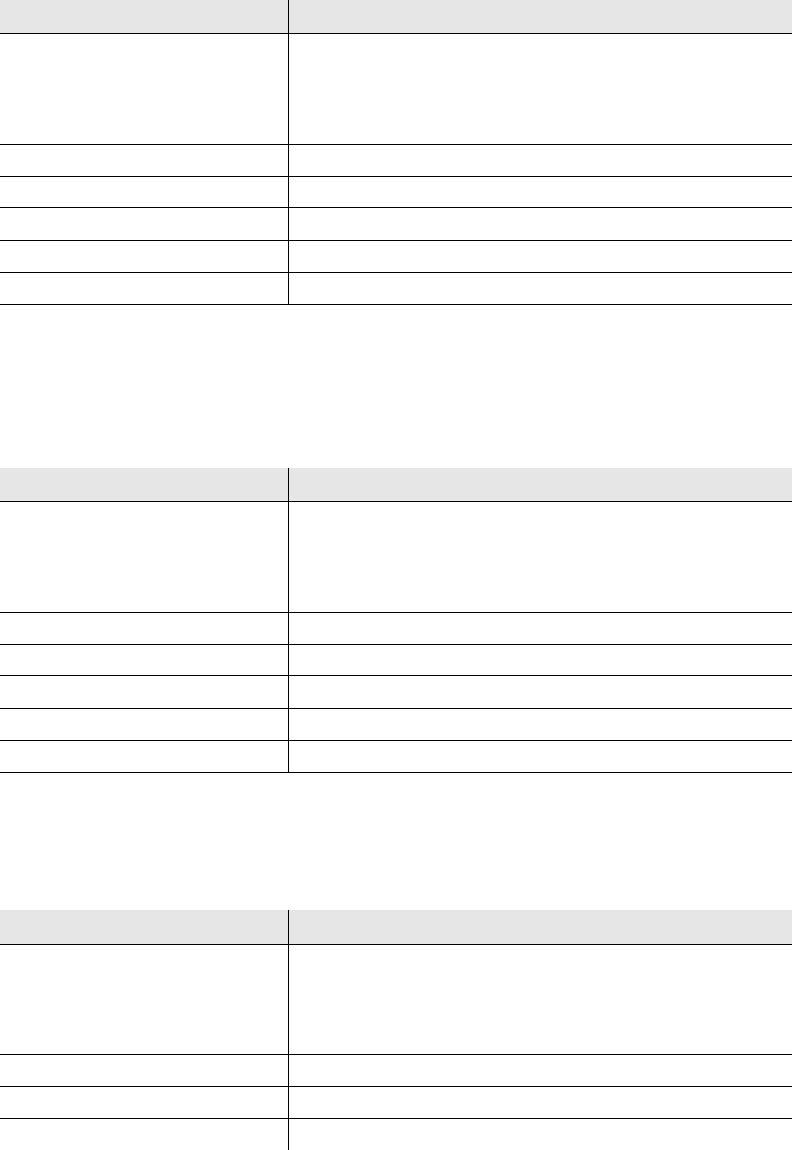
Using DiscMate: DVD Linking Reports 10-13
Check-out Detail Report
This report identifies exceptions generated from Self-Checkout Station sessions where an
Intelligent Unlocking Station is attached.
Staff Check-In Exception Report
This report identifies exceptions generated from Staff Station Reader sessions where an
Intelligent Unlocking Station is attached.
Drop Box Exception Report
This report identifies exceptions generated from Drop Box sessions.
Table 10.2
CD/DVD Check-out Detail Report
Column Header Description
StationType The type of device at which the exception occurred.
1. Drop Box
2. Staff Station
3. Self-Checkout Station
StationID The name of the station.
ExceptionType The name of the exception.
Tag The item identifier of the exception.
ExceptionDT The date and time when the exception occurred.
LibBranch The branch at which the exception occurred.
Table 10.3
CD/DVD Staff Check-In Exception Report
Column Header Description
StationType The type of device at which the exception occurred.
1. Drop Box
2. Staff Station
3. Self-Checkout Station
StationID The name of the station.
ExceptionType The name of the exception.
Tag The item identifier of the exception.
ExceptionDT The date and time when the exception occurred.
LibBranch The branch at which the exception occurred.
Table 10.4
CD/DVD Drop Box Exception Report
Column Header Description
StationType The type of device at which the exception occurred.
1. Drop Box
2. Staff Station
3. Self-Checkout Station
StationID The name of the station.
ExceptionType The name of the exception.
Tag The item identifier of the exception.

10-14 ILS Open Plus 3.0 Installation Manual
ExceptionDT The date and time when the exception occurred.
LibBranch The branch at which the exception occurred.
Table 10.4
CD/DVD Drop Box Exception Report
Column Header Description

CheckPASS: 11-1
CHAPTER
C
HAPTER
0
C
HECK
PASS
This chapter describes the CheckPASS utility and explains how to use it.
CheckPASS is an optional feature that allows library patrons to pay library fees at a
Self-Checkout Station, without staff assistance. Outside of the ILS product, patrons use a
self-service unit to add cash to their account balances. Within the ILS product, patrons are
reminded of outstanding library fees when they attempt to check out materials. They can
then pay with the touch of a button at the Self-Checkout Station. Patrons save time, and
library staff is freed to perform other tasks.
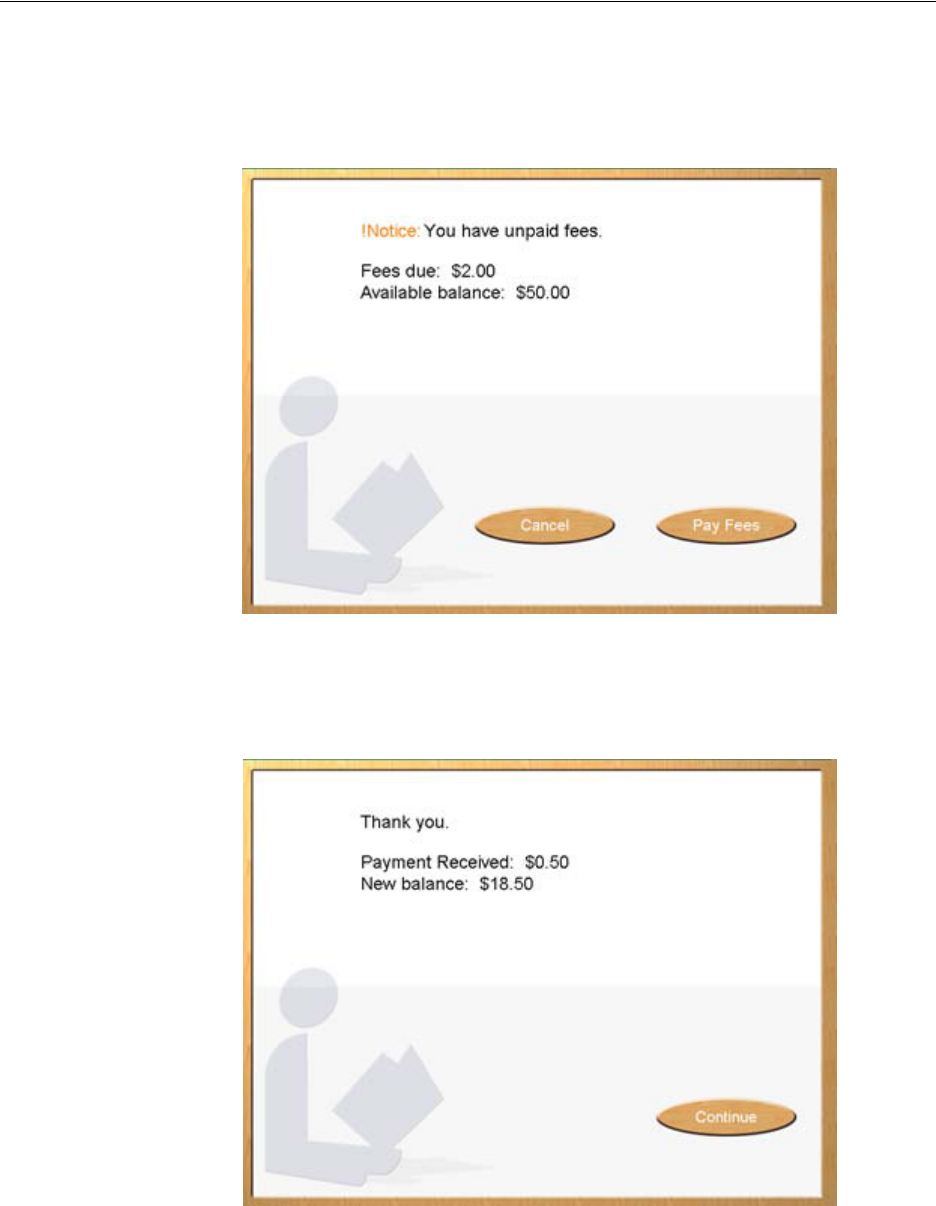
11-2 ILS 2.5 User Guide
Using CheckPASS
If you have outstanding library fees, ILS displays the amount owed and prevents you from
checking out material until the fee is paid. Take the following steps to pay the outstanding
fee:
1Scan your Patron Card. If ILS determines that you have outstanding fees, it displays
the message shown in Figure 11.1.
Figure 11.1
Outstanding fee message
2Touch Pay Fees to pay the fee. Touch Cancel to cancel the transaction. If you pay the
fee, a confirmation message displays, showing your new account balance (Figure
11.2).
Figure 11.2
Payment confirmation message
11-4 ILS 2.5 User Guide
Notes

Troubleshooting Guide: Contact Technical Support 12-1
CHAPTER
C
HAPTER
0
T
ROUBLESHOOTING
G
UIDE
This chapter describes procedures you can follow to try to correct problems that may arise
with various ILS components. Problems and possible solutions are grouped by
component, in the following sections:
• Patron Self-Checkout Station (page 12-1)
• Application Server (page 12-4)
• Exit Interrogator (page 12-5)
• Staff Station Reader (page 12-6)
• CheckVIEW (page 12-9)
In addition, this chapter describes how to restart the Patron Self-Checkout stations
(page 12-8), the Intelligent Library Controller software (page 12-8), and the Application
Server itself (page 12-8).
If these instructions do not produce the desired results, contact Technical Support at
800-257-5540, ext. 4100.
Contact Technical Support
Before calling technical support, note the date and time that the problem occurred, and list
steps you have taken to try to correct the problem.
Contact Checkpoint Technical Support at 800-257-5540 ext. 4100.
Self-Checkout Station Scenarios
Problem
Valid Patron ID Not Recognized
When using the Barcode Scanner to scan a Patron ID, the Self-Checkout Station does not
recognize the Patron ID...
Solution
1Verify that the Self-Checkout Station is displaying the Patron Entry screen (video
depicts a Patron ID being scanned). If so, be sure you are using the same reader
depicted in the video.
12-2 ILS Open Plus 3.0 Installation Manual
2Clean the Barcode Scanner lens.
3Scan the Patron ID card again. The Barcode scanner beeps when it successfully reads a
barcode. If it does not beep, restart the Self-Checkout Station (see “Restarting the
Self-Checkout Station” on page 12-8).
4If the problem persists after restarting the Self-Checkout Station, the scanner may be
damaged or may require service or replacement. Contact Technical Support (see
“Contact Technical Support” on page 12-1).
Problem
Nothing Happens After an Item is Scanned
You scan an item and nothing happens...
Solution
1If the video demonstrating an item checkout stops, the system is processing your
request. Wait a few moments.
2If the video demonstration continues without pausing after the item is scanned, the
Self-Checkout Station did not register the item. Try scanning a different item.
3If the video stops for more than 1 minute, follow the instructions for “Restarting the
Self-Checkout Station” on page 12-8.
4If the problem persists after restarting the Self-Checkout station, contact Technical
Support. See “Contact Technical Support” on page 12-1.
Problem
Graphics Display Incorrectly or Not at All
The graphics (pictures or video) are not displaying or are displaying incorrectly...
Solution
1Network connection could have been lost while the Self-Checkout Station was starting.
Check all network connections to the Self-Checkout Station and Application Server.
2If the connections are secure, restart the Self-Checkout Station. See “Restarting the
Self-Checkout Station” on page 12-8.
3If the problem persists after restarting the Self-Checkout Station, contact Technical
Support. See “Contact Technical Support” on page 12-1.
Problem
Printer Does Not Print
The printer does not print a receipt, or the Self-Checkout Station printer status reports an
error...
Solution
1Check that all receipts have been removed from the printer. Several receipts may be
waiting to print. Remove each one, until all the receipts are printed.
2Check that there is paper in the printer. To replace paper in the printer, see “Load Paper
into Patron Self-Checkout Station Printer” on page 13-13.
Troubleshooting Guide: Self-Checkout Station Scenarios 12-3
3If there is paper jammed in the printer, remove it, and reload the paper. See “Load
Paper into Patron Self-Checkout Station Printer” on page 13-13 for instructions.
4If the problem persists after following these steps, contact Technical Support. See
“Contact Technical Support” on page 12-1.
Problem
Printer Status of Unknown
The printer is working correctly, but the Self-Checkout Station status screen indicates a
Printer Status of Unknown...
Solution
This problem is sometimes caused by rebooting the Self-Checkout Station when print jobs
are in the printer queue. You must attach a keyboard to the Self-Checkout Station to fix
this problem.
1Power off the Self-Checkout Station.
2Attach a keyboard to the Self-Checkout Station, and then power it back on. Hold down
one of the shift keys on the keyboard during the network logon display, to prevent the
Self-Checkout Station program from starting.
3Select Start > Settings > Printers.
4Select File > Open.
5Select the print jobs that are on hold, and delete them.
6Close the windows you have opened, then select Start > Shutdown to shut down the
Self-Checkout Station.
7Turn off the Power to the Self-Checkout Station, and remove the keyboard.
8Turn on the power to the Self-Checkout Station.
9If the problem persists after following these steps, contact Technical Support. See
“Contact Technical Support” on page 12-1.
Problem
Touch Screen Does Not Respond
The Touch Screen does not respond...
Solution
1Check that the cable on the back of the monitor, which is plugged into the connection
marked Touch Interface, is securely plugged in.
2If all the connections are secure, the Touch Screen may be operating properly but the
Self-Checkout Station is not currently accepting input, or you are not touching a hot
spot that accepts input.
aBe sure that the Touch Screen monitor is powered on.
bRestart the Self-Checkout Station. See “Restarting the Self-Checkout Station” on
page 12-8.
3If the problem persists after following these steps, contact Technical Support. See
“Contact Technical Support” on page 12-1.

12-4 ILS Open Plus 3.0 Installation Manual
Problem
Self-Checkout Station Fails to Start
The Self-Checkout Station fails to start during power up, and the screen displays an error
condition...
Solution
1Allow the scandisk program to run until it finishes.
2Check all network connections on the Self-Checkout Station and the Application
Server. If they appear to be secure, restart all of the Self-Checkout Stations. See
“Restarting the Self-Checkout Station” on page 12-8 for instructions.
Note If the Application Server is shut down or loses power, all Self-Checkout Stations must be shutdown
and restarted. See “Restarting the Complete System” on page 12-8 for details.
3If the problem persists after following these steps, contact Technical Support. See
“Contact Technical Support” on page 12-1.
Application Server Scenarios
Problem
Self-Checkout Station Not Displaying
One or more Self-Checkout Station(s) is not displaying in the System Status Display...
Solution
1Make sure the Self-Checkout Station is running. If it is not running, the error message,
“We are currently unable to provide access to the system” displays. If this message
displays, the problem involves the connection between the Self-Checkout Station and
the Application Server. Make sure the network is connected and configured properly.
2If the Self-Checkout Station is running and behaving normally, but it is missing from
the System Status display, restart the entire system. See “Restarting the Complete
System” on page 12-8 for instructions.
3If the problem persists after following these steps, contact Technical Support. See
“Contact Technical Support” on page 12-1.
Problem
Trouble Printing a Report
You cannot print a report...
Solution
1Try to print a test page. Select Start > Settings > Printers. Right-click on the printer
and select Properties. Click Print Test Page.
2If you cannot print a test page, consult Windows Help.
3If the test page prints successfully, contact Technical Support. See “Contact Technical
Support” on page 12-1.

Troubleshooting Guide: Exit Interrogator Scenarios 12-5
Problem
Error Message Displays when Running a Report
You receive an error message when running a report...
Solution
The printer might have run out of paper, or there may be a problem with the configuration
database. Contact Technical Support. See “Contact Technical Support” on page 12-1.
Problem
Exit Alarms Do Not Occur
Exit Alarms do not occur when they should...
Solution
1Power down and restart each Exit Interrogator.
2Wait several minutes, then trigger an exit alarm. If no alarm occurs, restart the entire
system. See “Restarting the Complete System” on page 12-8 for instructions.
3If the problem persists after following these steps, contact Technical Support. See
“Contact Technical Support” on page 12-1.
Problem
Host Status Incorrectly Reports Offline
Host Status displays as Offline, when it is online...
Solution
The Host (LMS) Status indicator is accurate only when a Self-Checkout Station is running
and properly connected to the Application Server. If no Self-Checkout Stations are
connected, the Host Status field cannot be updated.
1Make sure that at least one Self-Checkout Station is running.
2Check all network connections between the Self-Checkout Stations and the
Application Server. If they appear to be secure, restart the Self-Checkout Stations. See
“Restarting the Self-Checkout Station” on page 12-8.
3Check that the Library Management System (LMS) is running. Restart the LMS, if
necessary.
4If the problem persists after following these steps, contact Technical Support. See
“Contact Technical Support” on page 12-1.
Exit Interrogator Scenarios
Problem
Exit Alarms Do Not Occur
Exit Alarms do not occur when they should...
Solution
1Power down and restart each Exit Interrogator.
2Wait several minutes, then trigger an exit alarm. If no alarm occurs, restart the entire
system. See “Restarting the Complete System” on page 12-8 for instructions.

12-6 ILS Open Plus 3.0 Installation Manual
3If the problem persists after following these steps, contact Technical Support. See
“Contact Technical Support” on page 12-1.
Problem
No Sound Occurs for an Exit Alarm
No Exit Alarm sounds, but an Exit Alarm displays on the Intelligent Library Controller...
Solution
1Power down and restart each Exit Interrogator.
2Wait several minutes, then trigger an exit alarm. If no alarm occurs, restart the entire
system. See “Restarting the Complete System” on page 12-8.
3If the problem persists after following these steps, contact Technical Support. See
“Contact Technical Support” on page 12-1.
Problem
Incorrect Exit Alarm
Exit Alarm occurs, even though the item is properly checked out...
Solution
1If your site allows off-line processing, the item may have been checked out while the
LMS was offline. If you have not synchronized the Checkout Cache since the LMS
returned to online status, do so now. See “Synchronizing the Checkout Cache” on
page 2-8 for instructions.
2If the item was recently checked out using a circulation desk Staff Station Reader, turn
off the Staff Station Reader used, then turn it back on.
•If the problem persists, restart the ILS Controller application. See “Restarting the
Intelligent Library Controller program” on page 12-8.
3If the patron used a Self-Checkout Station, go to a Library Management System
terminal, and verify that the item was checked out.
aIf the LMS does not have a record of the checkout, check the item out now.
bIf the LMS verifies that the item was checked out, contact Technical Support. See
“Contact Technical Support” on page 12-1.
4If the problem persists after following these steps, contact Technical Support. See
“Contact Technical Support” on page 12-1.
Staff Station Reader Scenarios
Problem
Valid Circuit Not Recognized
The Staff Station Reader does not recognize a valid item Circulation Circuit...
Solution
1Check to make sure the Staff Station Reader is running.
aCheck to make sure the power cord is connected to the Staff Station Reader and
plugged into a power source, and that all the remaining cable connections are
Troubleshooting Guide: Staff Station Reader Scenarios 12-7
secure. Refer to the connection diagram, “System Connection Diagram” on
page 12-11.
bYou should feel air moving through the air vents located on the side of the Staff
Station Reader.
2Scan the item again. Check the LED on the back of the Staff Station Reader. The LED
blinks green when the Staff Station Reader successfully reads an item ID.
aIf the LED blinks green, but the Staff Station still does not recognize the item ID,
restart the Intelligent Library Controller software. See “Restarting the Intelligent
Library Controller program” on page 12-8.
bIf the LED does not blink green, power off the Staff Station Reader, then power it
back on. Wait approximately 30 seconds while the software initializes.
3Scan the item again.
4If the item ID still is not recognized, contact Technical Support. See“Contact Technical
Support” on page 12-1.
Problem
Scanned Item Does Not Display on Monitor
Item scanned with Barcode Reader or Staff Station Reader does not display on the
monitor...
Solution
1If the item was scanned with the Barcode Reader, check the following:
aIf the Barcode Reader has a separate power cord, check that it is connected to the
Barcode Reader and plugged into a power source.
bCheck that all cable connections are secure. The Barcode Reader should be
connected to Com Port 4.
cReader should beep when reading a barcode, and you should see the reader’s light
on the barcode stripes.
2If the item was scanned with the Staff Station Reader, check the following:
aCheck that the power cord is connected to the Staff Station Reader and plugged into
a power source.
bCheck that all cable connections are secure. The Staff Station Reader should be
connected to the Keyboard Wedge, which is then connected to Com Port 3.
3Scan the item again.
4If the problem persists:
aDisconnect the power to the Barcode Reader.
bDisconnect the power to the Staff Station Reader.
cReconnect the power to the Barcode Reader.
dReconnect the power to the Staff Station Reader.
5Scan the item again.
6If the item ID still does not display, contact Technical Support. See “Contact Technical
Support” on page 12-1.

12-8 ILS Open Plus 3.0 Installation Manual
Recovery Procedures
You were directed to this section from another Troubleshooting scenario. Follow the steps
outlined in the section to which you were directed, then return to the Troubleshooting
scenario from which you came.
Restarting the Self-Checkout Station
1Disconnect power to the Self-Checkout Station using the power switch at the rear of
the case.
2Wait approximately 10 seconds, then reconnect power to the Self-Checkout Station.
3Allow the scandisk program to run until it finishes. This could take several minutes.
4All necessary applications will start automatically.
5Return to the Troubleshooting scenario from which you came.
Restarting the Complete System
1Power off the Self-Checkout Station using the power switch at the rear of the case.
2Shut down the Intelligent Library Controller software by selecting its Shutdown icon
on the Windows Task Bar. Click Shutdown.
3If error messages display, close them by clicking Abort, OK, or Cancel.
4Click Start > Shutdown to shut down the Application Server.
5After the Application Server reboots, power on the Self-Checkout Stations. All other
necessary applications start automatically.
6Return to the Troubleshooting scenario from which you came.
Restarting the Intelligent Library Controller program
1At least one Self-Checkout Station must be running.
2Shutdown the Intelligent Library Controller software by selecting its icon on the
Windows Task Bar. Click Shutdown.
3If error messages display, close them by clicking Abort, OK, or Cancel.
4The Intelligent Library Controller software will be launched automatically.
5If the program does not start within one minute, start the Intelligent Library Controller
software by selecting Start > Programs > RFID.
6Return to the Troubleshooting scenario from which you came.
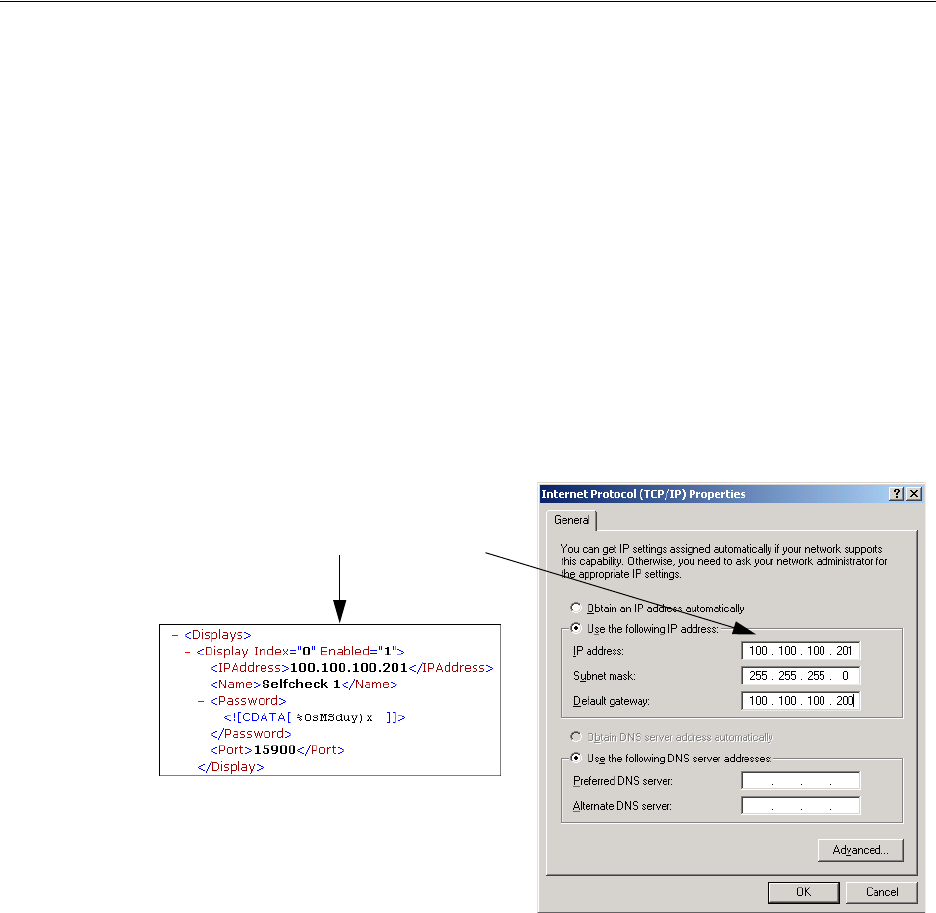
Troubleshooting Guide: CheckVIEW Troubleshooting 12-9
CheckVIEW Troubleshooting
If you encounter issues in using the CheckVIEW software, refer to the following solutions
for possible answers.
Problem I have installed the CheckVIEW software, but I still cannot connect to the
Self-Checkout Station.
Solution 1 - IP Address used on Staff computer
Ensure that the IP Address assigned in the Settings.xml file matches the IP Address used
by the Self-Checkout Station.
1Launch Windows Explorer and navigate to C:\Program Files\Checkpoint Systems\
CheckVIEW Monitor\.
2Open the Settings.xml file with Notepad.
aRight-mouse click Settings.xml.
bSelect Open With... and choose Notepad from the list of programs.
3Search for the IP address of Self-Checkout Station being used. Ensure that the IP
address used matches the IP address of the Self-Checkout Station.
Figure 12.1
Sample TCP/IP Settings
4Close the Settings.xml file to save your changes.
Solution 2 - Correct default settings on Self-Checkout Station
You can also ensure that the Default Settings on the Self-Checkout Station are correct.
Access the VNC Server Settings, as seen in Figure 12.2, by:
1Either attach a keyboard or access the Self-Checkout Station using PcAnywhere.
IP Addresses should match
Sample Settings.XML of CheckVIEW for
Self-Checkout Station 1
Sample TCP/IP Properties of a computer
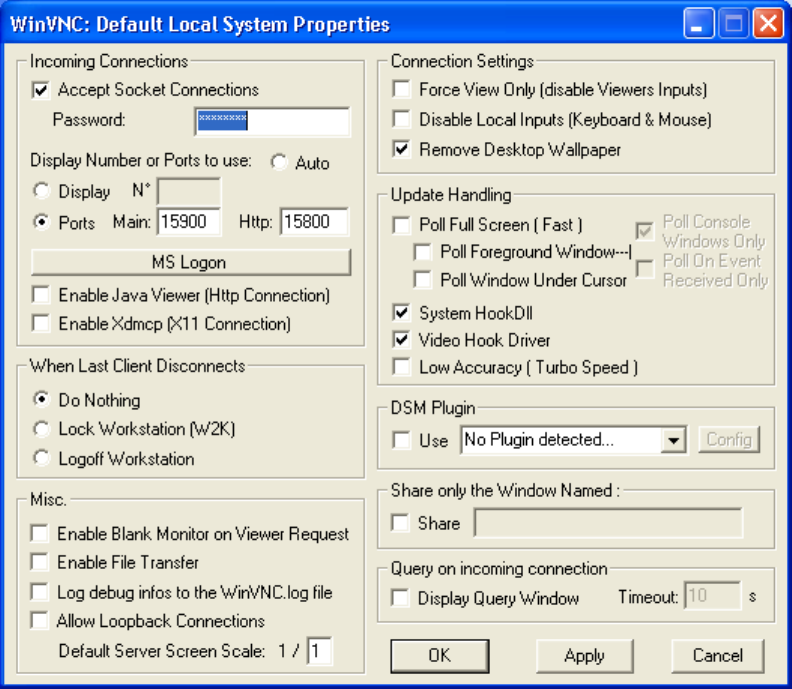
12-10 ILS Open Plus 3.0 Installation Manual
Click Start > All Programs > UltraVNC > Ultr@VNC Server > Show Default
Settings. The Default Local System Properties window displays.
Figure 12.2
VNC Server Settings
2Verify that:
•Accept Socket Connections is checked
•Password is checkpt
•Display Number is 10000
•Auto is deselected
•Enable Java Viewer is deselected
3Click OK to save and close the window.
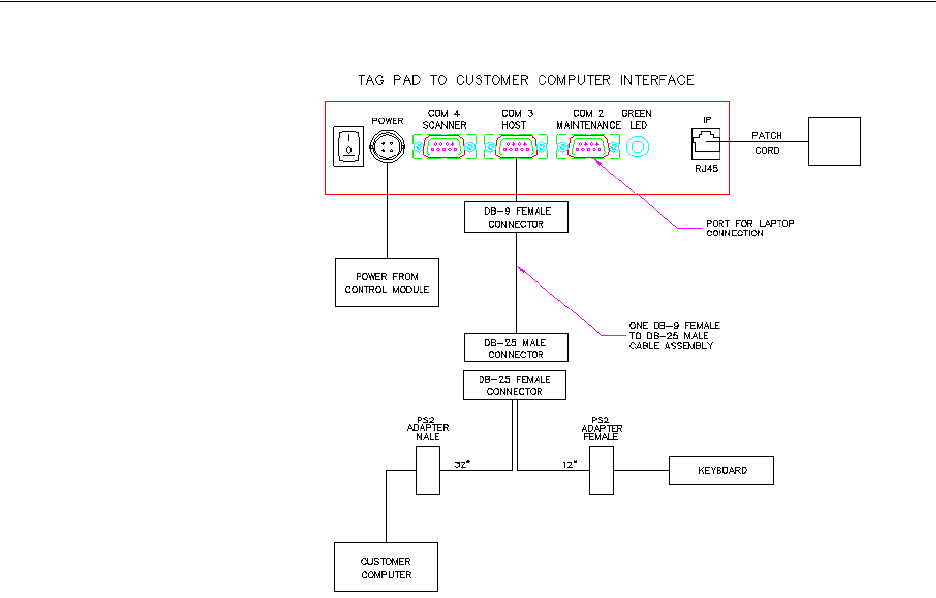
Troubleshooting Guide: System Connection Diagram 12-11
System Connection Diagram
Figure 12.3
System Connection Diagram
12-12 ILS Open Plus 3.0 Installation Manual
Notes

System Maintenance: Intelligent Library Controller System Maintenance 13-1
CHAPTER
C
HAPTER
0
S
YSTEM
M
AINTENANCE
This chapter describes how to perform system maintenance tasks for the Intelligent
Library Controller and other components of the ILS. It also provides safety information
and system specifications.
Intelligent Library Controller System Maintenance
Intelligent Library Controller maintenance tasks include:
• Maintaining the transaction database (page 13-2)
•Synchronizing offline transactions (page 13-3)
•Backing up the transaction database (page 13-4)
•Purging the transaction database (page 13-5)
•Compacting the transaction database (page 13-7)
•Rebooting the Application Server (page 13-8)
The transaction database tasks listed above must be performed as a group, and in a
certain order. The purge and compact tasks must be performed only during
non-circulation hours.
• Shutting down the Patron Self-Checkout stations (page 13-9)
• Shutting down the Intelligent Library Controller software (page 13-10)
• Backing up the Application Server (page 13-11)
• Loading paper into the Patron Self-Checkout Station printer (page 13-13)

13-2 ILS Open Plus 3.0 Installation Manual
Transaction Database Maintenance
The transaction database size cannot exceed 1 GB. If 1 GB maximum limit is reached, no
new data will be written to the database, the application server will log errors
continuously, and database behavior becomes unpredictable. In fact, if the transaction
database is allowed to reach a size of 500 MB, system performance suffers. To avoid this
constraint, you can purge the transaction database. However, there are a number of
preliminary and subsequent steps included in the task of purging the transaction database,
including:
1Synchronize offline transactions, if this feature is enabled. Offline processing allows
you to continue check-in and checkout tasks, even if the Library Management System
(LMS) is offline. You perform this task first so that offline transactions are included in
the transaction database. See “Synchronize Offline Transactions” on page 13-3.
2Make a copy of the transaction database, so that you have an archive of the
transactions, in case the purge process fails or is interrupted. See “Backup Transaction
Database” on page 13-4.
3Purge the transaction database. You use the Purge function to mark transaction
database records for deletion. This function does not remove rows from the database,
so physical disk space is still allocated and used. Perform this function only during
non-circulation hours. See “Purge the Transaction Database” on page 13-5.
4Compact the transaction database. To physically remove the deleted records and
reduce the size of the database, you must compact the database. Perform this function
only during non-circulation hours. See “Compact the Transaction Database” on
page 13-7.
5Checkpoint Systems recommends that you then reboot the Intelligent Library
Controller. See “Reboot the Application Server” on page 13-8.
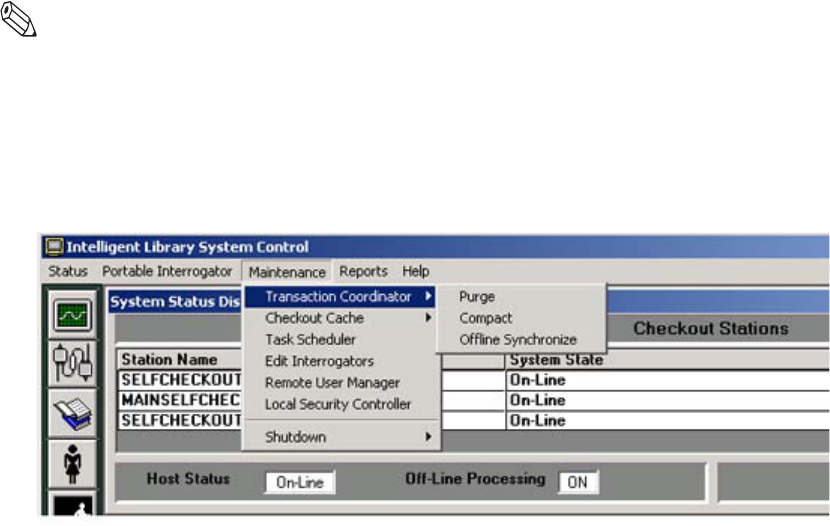
System Maintenance: Intelligent Library Controller System Maintenance 13-3
Synchronize Offline Transactions
If offline processing is enabled at your site, it allows you to continue check-in and
checkout tasks when the LMS is offline. You use the Offline Synchronize function to
move offline transactions into the transaction database when the LMS comes back online.
Note You must synchronize offline transactions each time the LMS goes offline and then comes back
online.
To synchronize offline transactions:
1In the Intelligent Library System Control window, select Maintenance > Transaction
Coordinator > Offline Synchronize. (If the Offline Synchronize option is grayed out,
skip to “Backup Transaction Database” on page 13-4.)
Figure 13.1
Transaction Coordinator Offline Synchronization Navigation
2Run a Checkout Discrepancy Report (See “Checkout Discrepancy Report” on
page 2-14) and a Patron Discrepancy Report (See “Patron Discrepancy Report” on
page 2-15). Resolve any discrepancies through the Library Management System. They
cannot be resolved using the Intelligent Library System Open Plus.
3Go to the next step, “Backup Transaction Database”, which follows this section.
13-4 ILS Open Plus 3.0 Installation Manual
Backup Transaction Database
Before purging the transaction database, make a copy of it, so that you have an archive of
the transactions, in case the purge process fails or is interrupted.
Before performing this task, you should have synchronized offline transactions (if
offline processing is enabled at your site). See “Synchronize Offline Transactions” on
page 13-3.
The location of the Transaction database varies depending on the directory chosen for
installation of the ILS software. The base directory for the ILS software is usually
C:\RFID. The Transaction database file is always located at
RFID\Applications\DB\TransCoord\transaction.mdb.
To create a backup copy of the transaction database:
1Right-click Start and select Explore to open Windows Explorer.
2Navigate to the RFID\Applications\DB\TransCoord\ directory.
3Right-click transaction.mdb and select Copy.
4Navigate to the folder where you want to store the backup copy.
5Right-click the white space within that folder's file listing and select Paste.
6After the file is pasted into the directory, rename the backup file. Highlight the file
name and press F2.
7Type the new name of the backup file. Be sure to retain the .mdb extension. Press
Enter.
8Go to the next step, “Purge the Transaction Database”, which follows this section.
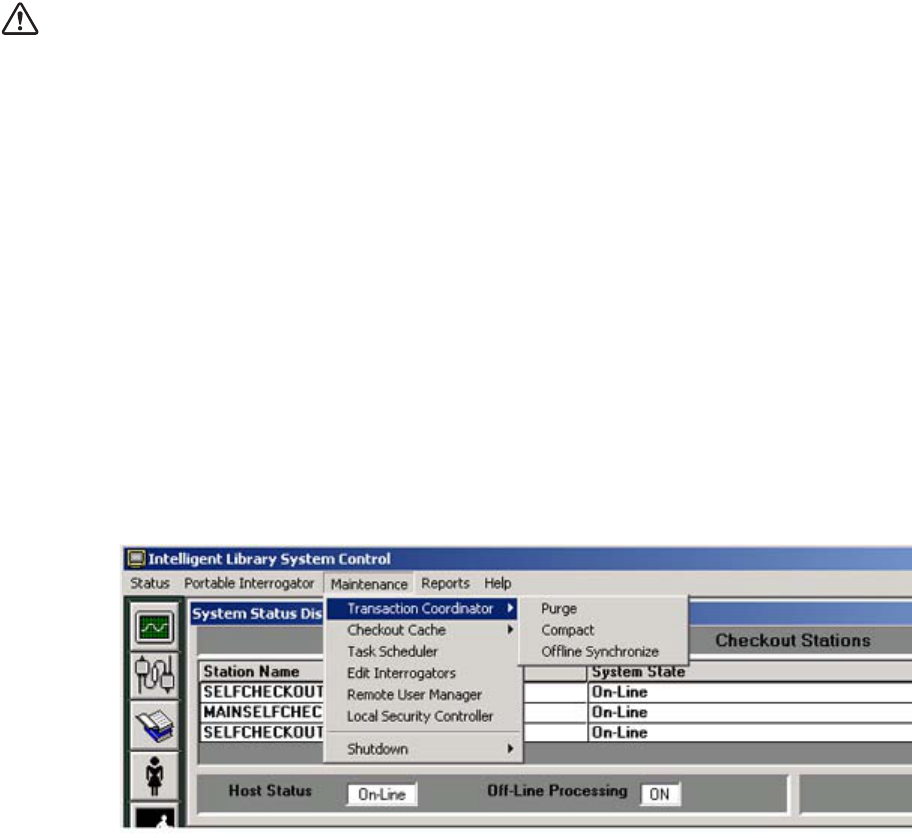
System Maintenance: Intelligent Library Controller System Maintenance 13-5
Purge the Transaction Database
Warning The Purge and Compact functions can cause unpredictable behavior or cause the system to go
offline if used inappropriately. Only qualified system administrators should use these functions.
Perform these functions only during non-circulation hours.
To determine how often to purge the transaction database, Checkpoint Systems
recommends monitoring the size of the transaction database daily (or weekly) for several
days (or weeks) and using the data gathered to estimate how often to purge the transaction
database.
Purging and compacting the transaction database functions should be performed as a unit.
After purging the transaction database, always compact the transaction database.
Before performing this task, you should have performed the following tasks:
1Synchronize offline transactions, if offline processing is enabled at your site
(“Synchronize Offline Transactions” on page 13-3)
2Backup the transaction database (“Backup Transaction Database” on page 13-4)
To purge the transaction database:
1In the Intelligent Library System Control window, select Maintenance > Transaction
Coordinator > Purge.
Figure 13.2
Purge Navigation
2Enter the ILS user name and password in the ILS Login window. The default user
name is ils, and the default password is maint. Click OK.
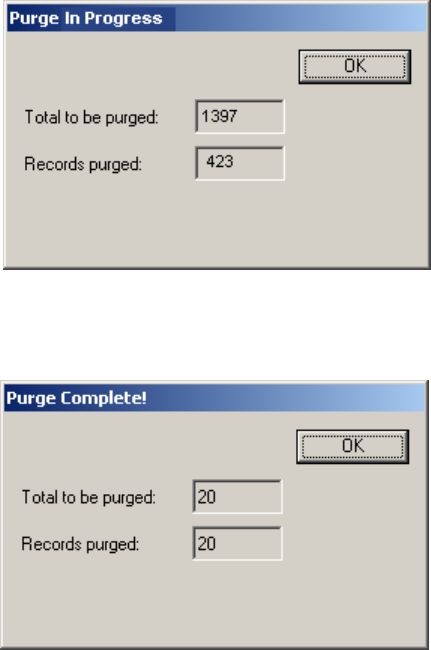
13-6 ILS Open Plus 3.0 Installation Manual
3During the purge operation, a progress indicator displays to show you how much of the
purge has been completed and how much remains.
Figure 13.3
Purge Progress Indicator display
When the purge is finished, the End Purge message box displays.
Figure 13.4
End Purge message box
4Go to the next step, “Compact the Transaction Database”, which follows this section.
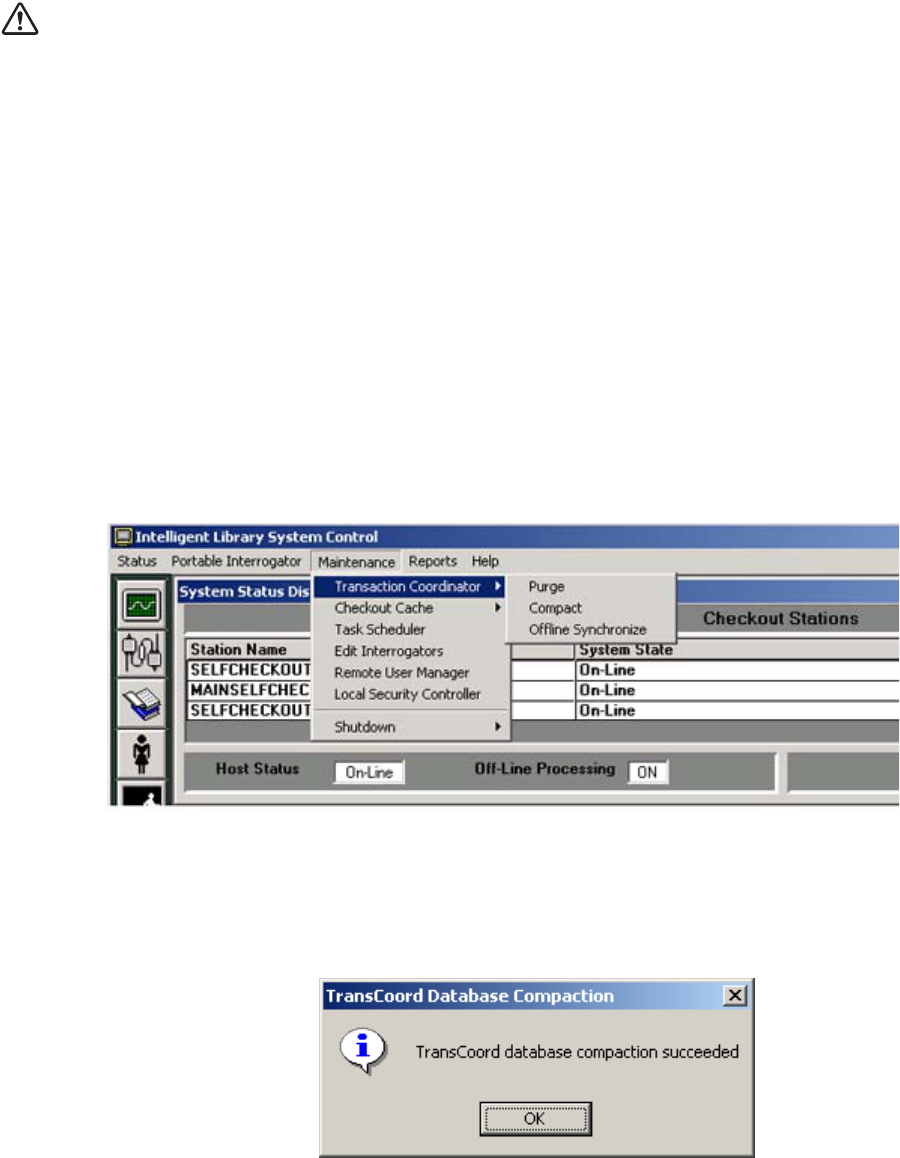
System Maintenance: Intelligent Library Controller System Maintenance 13-7
Compact the Transaction Database
Warning The Purge and Compact functions can cause unpredictable behavior or cause the system to go
offline if used inappropriately. Only qualified system administrators should use these functions.
Perform these functions only during non-circulation hours.
To physically remove the deleted records and reduce the size of the transaction database,
you must compact it.
Purging and compacting the transaction database functions should be performed as a unit.
After purging the transaction database, always compact the transaction database.
Before performing this task, you should have performed the following tasks:
1Synchronize offline transactions, if offline processing is enabled at your site
(“Synchronize Offline Transactions” on page 13-3)
2Backup the transaction database (“Backup Transaction Database” on page 13-4)
3Purge the transaction database (“Purge the Transaction Database” on page 13-5)
To compact the transaction database:
1In the Intelligent Library System Control window, select Maintenance > Transaction
Coordinator > Compact.
Figure 13.5
Compact Navigation
2Enter the ILS user name and password in the ILS Login window. The default user
name is ils, and the default password is maint. Click OK.
3When the compact function is finished, a message box displays.
Figure 13.6
End Compact message box
4Go to the next step, “Reboot the Application Server”, which follows this section.
13-8 ILS Open Plus 3.0 Installation Manual
Reboot the Application Server
After purging and compacting the transaction database, Checkpoint Systems recommends
that you reboot the Application Server.
Before performing this task, you should have performed the following tasks:
1Synchronize offline transactions, if offline processing is enabled at your site
(“Synchronize Offline Transactions” on page 13-3)
2Backup the transaction database (“Backup Transaction Database” on page 13-4)
3Purge the transaction database (“Purge the Transaction Database” on page 13-5)
4Compact the transaction database (“Compact the Transaction Database” on page 13-7)
To reboot the Application Server:
1Shut down all Patron Self-Checkout stations. See “Shutdown Patron Self-Checkout
Stations” on page 13-9.
2Shut down the Intelligent Library Controller software. See “Shutdown the Intelligent
Library Controller Software” on page 13-10.
3Click Start > Shutdown to shut down the Application Server.
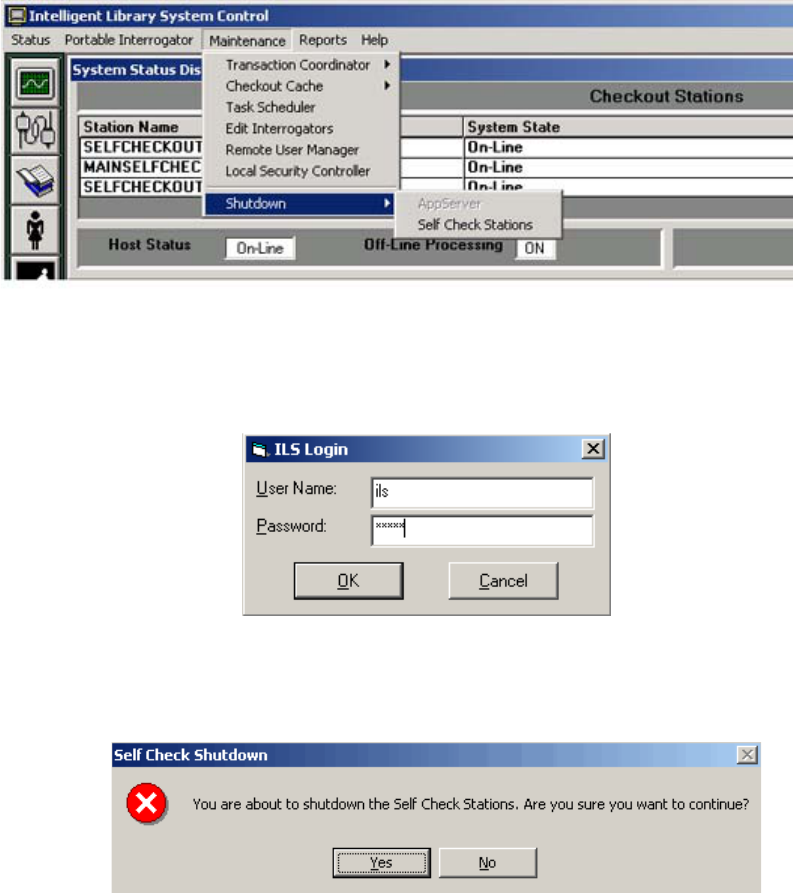
System Maintenance: Intelligent Library Controller System Maintenance 13-9
Shutdown Patron Self-Checkout Stations
Before rebooting the Intelligent Library Controller, you must shut down the Patron Self-
Checkout Stations. To shut down the Patron Self-Checkout Stations:
1In the Intelligent Library System Control window, select Maintenance > Shutdown >
Self Check Stations.
Figure 13.7
Shutdown Patron Self-Checkout Station
2Enter the ILS user name and password in the ILS Login window. The default user
name is ils, and the default password is maint. Click OK.
Figure 13.8
ILS Login window
3In the Self Check Shutdown window, click Yes to perform the shutdown. Click No to
cancel the shutdown of the Self-Checkout Station.
Figure 13.9
Self Check Shutdown window
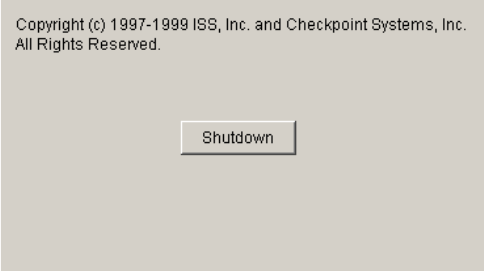
13-10 ILS Open Plus 3.0 Installation Manual
Shutdown the Intelligent Library Controller Software
To shut down the Intelligent Library Controller software:
1Be sure that all Patron Self-Checkout Stations are shut down. See “Shutdown Patron
Self-Checkout Stations” on page 13-9.
2In the Intelligent Library System Control window, select Maintenance > Shutdown >
AppServer.
3Click Shutdown.
Figure 13.10
Shutdown Button
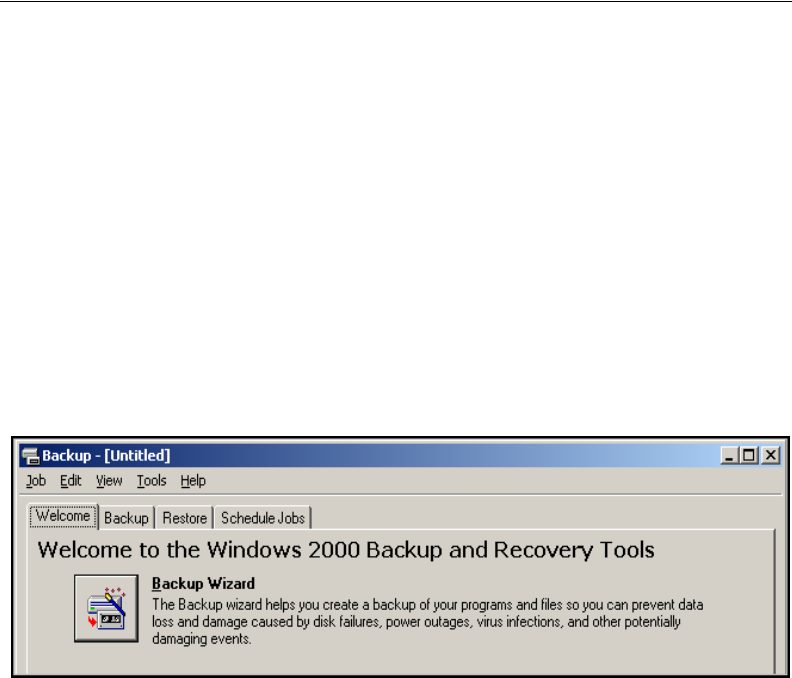
System Maintenance: Intelligent Library Controller System Maintenance 13-11
Backup the Application Server
This section describes how to back up all files on the Application Server and how to
restore them, as needed. Before you can perform the backup, you must exit the Intelligent
Library Controller application.
Checkpoint Systems recommends that you do not use the Application Server’s hard drive
as your backup medium.
Backup
1Shut down the Patron Self-Checkout stations. See “Shutdown Patron Self-Checkout
Stations” on page 13-9.
2Exit the Intelligent Library Controller application.
3To launch the Windows backup utility, select Start > Programs >Accessories >
System Tools > Backup.
4Click on the Backup tab. (If you would rather use the Backup Wizard to perform the
backup, click the Backup Wizard button and follow its directions.)
Figure 13.11
Backup window
5Select the drives and/or directories that you want to back up.
aThe directory required to restore the Intelligent Library System Open Plus is
E:\RFID.
bSelect any other applications used at your site to communicate between the LMS
and the ILS.
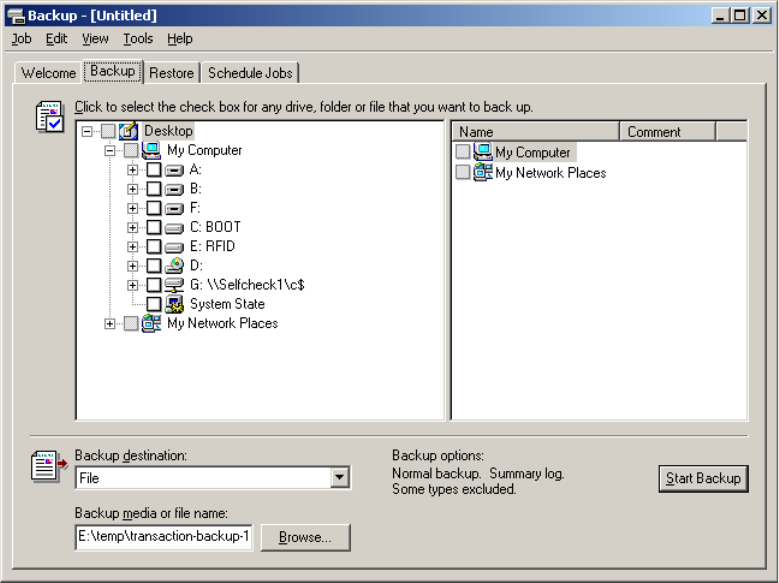
13-12 ILS Open Plus 3.0 Installation Manual
6Click Start Backup. Respond to prompts as they appear. See the MicroSoft Windows
Help for detailed instructions for using the Backup Utility.
Figure 13.12
Backup tab
Restore
Restoring files from a backup tape can take a long time.
1Follow steps 1 through 3 from the Backup instructions.
2To restore individual files from a backup set on a tape, select the Tapes window, then
load the catalog of the backup set from which you want to restore certain files.
If the catalog of backup files is not visible, you may have to create a new one. See the
Microsoft Windows Help for instructions.
3Select all the files you want to restore using the appropriate method:
aTo select contiguous files, click the first filename, hold down SHIFT, and click the
last contiguous filename.
bTo select non-contiguous files, click a filename, hold down CTRL, and click each
filename.
cOn the Select menu, click Check. A check mark displays in the check box for each
selected file.
4On the Operations menu, click Restore.
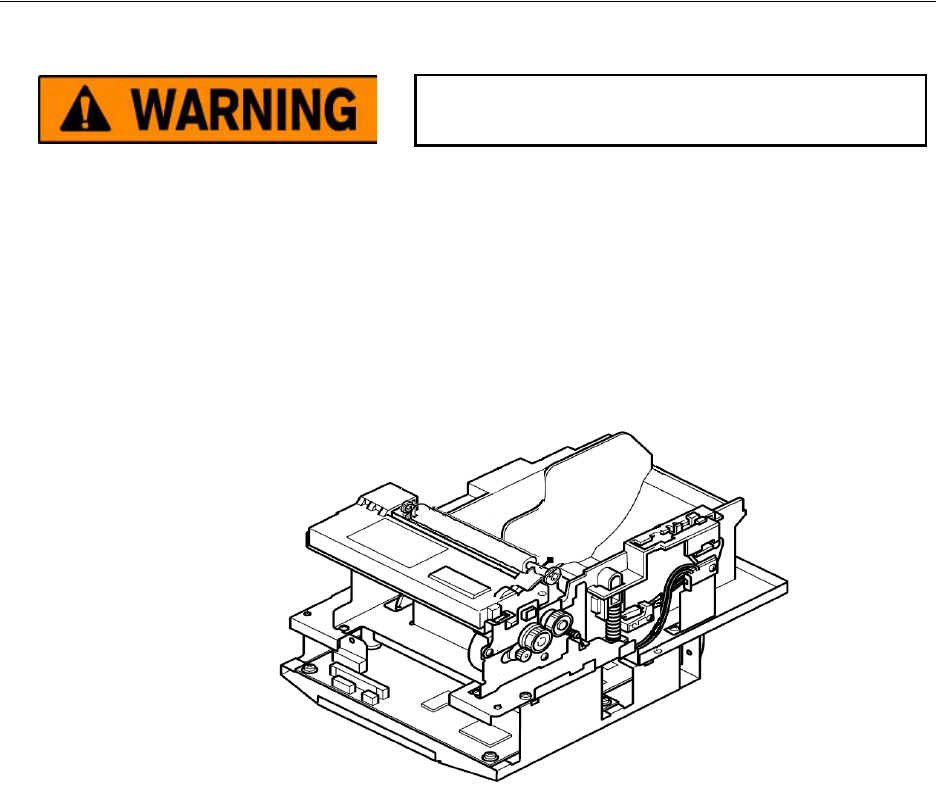
System Maintenance: Load Paper into Patron Self-Checkout Station Printer 13-13
Load Paper into Patron Self-Checkout Station Printer
Do not touch the cutter blade *
There is a sharp cutter blade inside the paper outlet slot. Do not put your
hand in the paper outlet slot when changing paper or while printing is in
progress.
Use the following procedure to reload the paper in the Self-Checkout Station.
1Lift to remove the printer access cover from the top of Self-Checkout Station chassis.
You will see the printer unit (shown below) through the opening.
Figure 13.13
Self-Checkout Station Printer
2Pull the bar release lever (top right) towards you to release the paper roller bar
assembly.
3Lift the paper roller bar assembly all the way up until it rests back in the open position.
4Remove the used paper roll core from the printer and discard it.
5Remove the tab on the new paper roll.
Protect Yourself From Injury
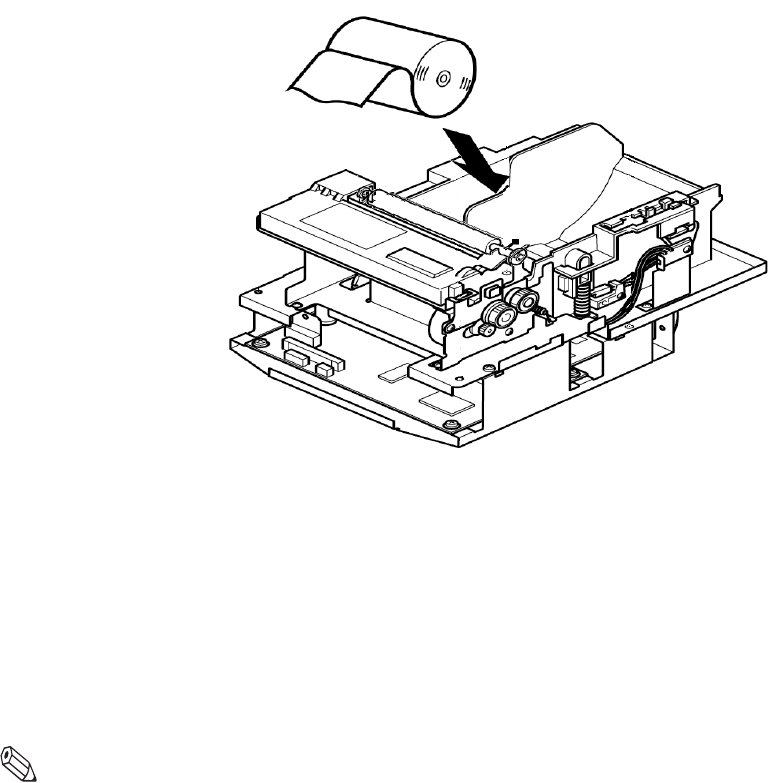
13-14 ILS Open Plus 3.0 Installation Manual
6Set the new paper roll into the printer, and pull on the leading edge of the paper from
the bottom toward you (as shown below)
Figure 13.14
Self-Checkout Station Printer - New Roll Installation
7Make sure there is enough excess paper so that approximately 1/8” of paper is coming
through when you close the paper roller bar assembly.
8Close the paper roller bar assembly by pushing it down until it snaps closed securely.
9As soon as you close the paper roller bar assembly, the paper will automatically feed
and cut off the end of the paper.
10 Remove and discard the excess piece of paper that was cut off in the previous step.
11 Replace the printer access cover, and push down to secure it to the unit with the hook
and loop fasteners.
Note The paper will feed through the small slit opening in the printer access cover during self checkout
transactions.
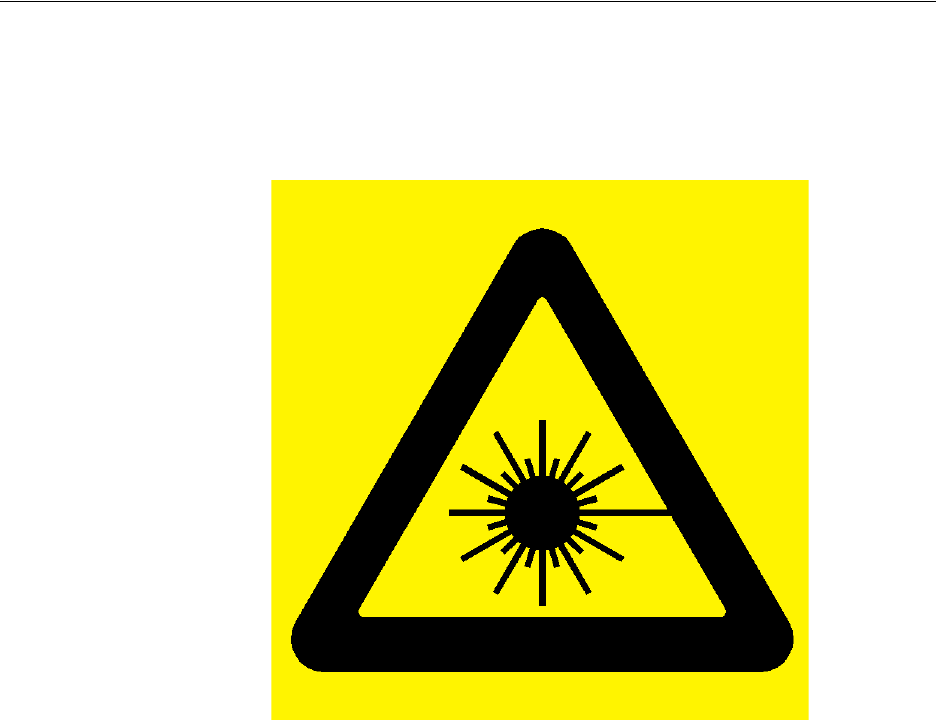
System Maintenance: Safety Warnings 13-15
Safety Warnings
Barcode Scanner:
LASAR RADIATION
RISK TO EYES - DO NOT STARE INTO BEAM
CLASS 2 LASER PRODUCT
Figure 13.15
Laser Radiation Icon
See the Metrologic Instruments IS 4110 and IS4120 ScanQuest® Laser Scan Engine
Installation and User’s Guide on other Safety instructions, warnings and technical
specifications.

13-16 ILS Open Plus 3.0 Installation Manual
Specifications
Mechanical
Dimensions: 29" L x 20.75" W x 6.25" H
(736.60 mm x 527.05 mm x 158.75 mm)
Weight: 26 lbs. (9.7 kg)
Materials: Acrylic / PVC alloy
Monitor: See the Planar PT1503NT User’s Manual.
Electrical
Emissions: FCC Part 15, RSS 210, ETSI 300 330 Compliant
Immunity: ETSI 301489 Compliant
RF Transmit Frequency: 13.56 MHz
Demodulation type: AM
Read range: Up to 10" with a 2.1" x 2.1" Circulation Circuit®
Console Power Requirements: 24 VDC, 50-60 Hz, 1.6 A
Safety: Requires dedicated circuit to prevent power surges and spikes from damaging the
system. Requires power strip with power and modern surge protection. UL/cUL 60950-1
compliant.
Interfaces
Diagnostics: RS-232
Host: IEEE 802.3, 10 Base-T Ethernet, NE 2000 Compatible Read range
Peripherals
Monitor: Touch Screen 15" flat screen - standard
Printer: Star Micronics TSP 600 Series (643C)
Patron Card Reader (standard): Metrologic IS 4120
Power Supply: 90-264 VAC, 47 - 63 Hz IEC input, 24 VDC @ 4A output, UL Listed
Environmental
Operating temperature: 32 degrees F to 104 degrees F (0 degrees C to 40 degrees C)
Storage Temperature: -22 degrees to 140 degrees F (-30 degrees C to 60 degrees C)
Storage/operating humidity: 5% to 95%, non-condensing
Tag Compatibility: RFID Based Circulation Circuit
